
- Classic EBC Trek
- EBC + Gokyo Trek
- Jiri to EBC
- 3 Passes Trek to EBC
- Island Peak and EBC
- Acclimatisation
- Packing List
- Get a Trek Quote

Best Time To Trek To Everest Base Camp
The Everest Base Camp Trek runs through the Khumbu region of Nepal, typically starting at Lukla and ended up at the Everest Base Camp.
While the higher sections of the region are known for extremely cold and adverse weather conditions, there are times throughout the year where the weather stabilises and tends to be very mild, making it great for trekking.
It is important to understand the weather patterns of the region when planning your trek to ensure you get the most out of your time spent in the area.
A few considerations must be taken into account when deciding on the best time to trek to Everest Base Camp.
Broadly these are the weather conditions, busyness of the routes and the availability of guided tours.
This article provides an overview of the seasons in Khumbu region of Nepal and how they affect the Everest Base Camp Trek so that you can better decide on when to visit the area and take on one of the world’s most iconic treks.
[adinserter block=”2″]
EBC Trek Weather
Peak season.
Contrary to what you might think, the best time to trek to Everest Base Camp is not during the height of Summer. Rather, large window periods on either side of summer provide the best conditions for the trek.
February – May
The spring months are probably the most popular in the region as a whole. You might be caught in the occasional snow showers if you catch the end of the winter season, but the weather should be largely stable and dry – perfect for trekking and high altitude climbing.
The ideal weather comes at a price as the routes during this time will be at their busiest. Most Everest summits occur during these months so you will likely come across many climbers, summiteers and their support crews!
The region is also the most vibrant at this time of the year, with many of the routes flanked by flowering rhododendrons.
September – October
Clear days are characteristic of this popular trekking period. Although colder days (and colder nights) are to be expected, this is a small price to pay for the wonderful vistas and perfect views of the regions peaks. The odd snowstorm has been known to hit the region during this time so be sure to pack correctly !
An added bonus of trekking during this time is the option to choose some other, less well-known routes in the area that still offer amazing views but without the hustle and bustle of the more popular routes. The Gokyo Lakes Trek to the Everest Base Camp is a perfect example.

November – January
The region during this period can best be described as being very cold but still able to be trekked. The days will be shorter and there is a lot more snow, thus routes that involve crossing big passes like the three passes trek are usually closed.
The weather will be fairly stable and dry, meaning it is entirely possible to trek the classic roite to Everest Base Camp in these months.
Expect temperatures as cold as -30°C at night higher up the route so be sure to bring the correct gear .
If the cold doesn’t bother you and you want to avoid the crowds, trekking at this time may be just right for you. Why not even consider a Christmas Everest Base Camp Trek as a festive alternative to the more typical Christmas activities?
June – August
Rain, rain and more rain. The monsoon season is in full swing during this time of year as the warm, moisture laden water from the Indian Ocean causes rapid downpours. The routes tend to be very empty with only high-altitude die-hards braving the rains.
Slippery trails, leeches and the lack of mountain views seems to be sufficient in off-putting most trekkers from visiting.
There are a few areas, called rain-shadows, that provide good trekking conditions even during the monsoon months. The Annapurna Circuit is a good example of one of these rain protected areas.
[adinserter block=”3″]
Stay away from the monsoon months of June through August. The trail conditions are not the safest, the trek will be wet and unenjoyable and you won’t even be able to get any great pictures of the beautiful mountain peaks.
Aim to trek in the peak months of February through May and September through October as you are guaranteed stable and mild weather. The classic route will be busy but this will do little to detract from the natural beauty of the area.
If you really want to avoid the crowds and are prepared to invest in some proper cold-weather gear , trekking during the winter months may be for you.
Keep in mind that many tour operators will not offer guided tours during the off-peak months and that many of the usual routes will be closed. Be sure to check before booking your flights!
For a live weather forecast of Nepal, click here .
Tags: EBC trek weather, Best time to trek to Everest Base Camp, Everest Base Camp when to trek, Everest Base Camp weather
Mark Whitman
Hi, I'm Mark! Welcome to EBC Trek Guide - the Web's No.1 Trekking Guide to Everest Base Camp. I have trekked all over Nepal, but the Everest region remains my favourite. I hope you find all the answers you are looking for on this site. If you have any questions don't hesitate to drop a comment below! Happy Trekking!
Leave a Reply
Your email address will not be published. Required fields are marked
hi!! I am currently booked to trek to EBC March 15-30. I am a little concerned about the cold temps and am considering going mid to end of April or into first 2 weeks of MAy. What is your favorite 2 weeks and what are the temps like??
Hi Kim, that is a tough one to answer. April and May do tend to have more stable weather that is slightly warmer than March, but there is not a huge difference in temperatures. Lower down the trail you will find the temperatures are quite warm during the day, but cold at night and in the early mornings. As you get higher up the daytime temperatures drop and you will need to layer up. Nighttime temperatures are also cooler. You will notice the biggest differences between March / April vs April / May in temperatures at night. But as I said this won’t be significant. The real difference is in terms of number of trekkers on the path. There will be many more people on the trail from April through to the end of May as the Everest climbing season kicks off around the beginning of the 2nd week of April. March will be quieter, with fewer trekkers on the trail and quieter / less busy teahouses. If you are looking to experience the EBC with fewer people around I would say go for March. If you want to experience the hustle and bustle of the Everest climbing season and see some activity at EBC, then mid April through to mid May is the time to go. Hope this helps!
We will be there on the 14-28, taking the basic same route to Lobuche, then climbing it. Three years ago I was there during these dates and here is what you can expect. Warm during the day in KTM, Lukla and Phakding. Once you start the climb to Namche, you will notice a difference. When you in sunlight, you will feel warm and remove layers. Once in the shadow of a mountain, you will be putting the layers back on. My advise is layers and you’ll need a good down coat for the higher altitudes. Also, bring you favorite spices and a solar pack charger for your batteries. Enjoy! You will love it!
Hi Mark We are planning on a trip upto Tengboche (most of hiking will be from Lukla with stops over Phakding and Namche) during the first half of June (1-14). This is the only time we could due to other commitments. I know this is probably the shoulder period of the monsoon or pre-monsoon, but i was curious how bad the visibility and trail crowd could be in this period. Thanks for your input
Hi Neelam, in terms of weather it could be a little hit and miss. The likelihood of rain and poor visibility is higher than in April or May, but you may get a great week! In terms of crowds the trail will be a lot quieter than April / May. All the best!
Thanks, Mark.
I’m planning to go for EBC and chances upon your site. You seem to be very ecperienced. Appreciate if you can help me please.. I know you mentioned best time in an article but which will be the warmest month to go for. I’m just concerned about cold weather.. i have low blood pressure and my extremities get numb and tingly even with proper gloves on in europe’s winter right now. So, just want to check the temperature ranges.. it’s all relative and dressing well (layering) but numbers might help me decide! 🙂 or maybe i should do Annapurna!! Any input/tips will be great help!
Many thanks, Payal
Hi Payal, appreciate your concern about temperatures. It’s a difficult thing to advice you on as the temperature fluctuates so much as one ascends in altitude. The warmer months are however – April-May or September-October. If I was pushed to give you a month I would say September, just after the monsoon season. Hope this helps.
Thanks so much!
My husband and I are hoping to trek to EBC this December. While doing some research, I stumbled across your incredibly informative site! I’m wondering if it is difficult to find guided treks during this month, because it is off-season and colder than many people might find comfortable. We like the idea of a less crowded trip, and since my husband is a photographer, the clearer views during the dry winter months are very appealing to him. Aside from the climate, what else should off-season trekkers consider?
Hi Kimberley, thanks for getting in touch. You shouldn’t have a problem finding guided trips. A good number of people trek over the winter season, some try to time there visit to EBC with Christmas! Many teahouses in other regions of Nepal close during the winter season, but in the Everest region most stay open. So nothing to worry about in terms of accomodation. Apart from that, make sure to take a warm four season sleeping bag, and lots of warm layers. It can get really cold at night and in the early hours of the morning. Hope you have a great trip!
Great stuff.Please keep it up!
Hi Mark Heading off on the EBC trek in early September 2019. I’m a bit concerned about the flight from Kathmandu to Lukla and back being delayed due to bad weather, looking at the whole trip at about 17 days door to door, do you feel this is sufficient time as some of the guys I’m with have limited holiday allowance. Regards Mick
Hi Mick, 17 days if you take the classic / standard route is more than enough time. If you decide to do a variation route, like the Gokyo Lakes trek, then you will be pushed for time. Hope this helps!
Hi Mark, My girlfriend and I are planning to visit EBC and originally had planned to go in late october-November. We are now considering April. What month do you suggest is the best do to in terms of views? We are okay with the hustle and bustle. Thank-you,
Hi Laura, April is a great month for the trek and visibility is usually excellent. April / May coincides with the climbing season so there is a lot of activity on the trail, in the teahouses and on the surrounding peaks.
Hi Mark, thanks fot yhe information. I am still not able to make my mind, as to whether to go for the trek to EBC on Dec 22nd this year or not. I am might afraid of cold. I cant tolerate it. I want to go but never stayed in sub zero temperatures. Also i am not well equipped with cold weather clothing and gear. Kindly advise.
Hi Mark, thanks for the great advice on your website. We are planning on EBC trek Oct/Nov 2019. Apart from the cold weather is it safe to trek so late in the season. We’d love to experience snow but not to the extreme. We’re looking for a camera to hopefully capture some amazing shots of our adventure. Any tips on what type of camera we should buy? something capable of taking good movies. Many thanks
Hi Julie, this article has a great synopsis on outdoor cameras, albeit for Antarctica instead of EBC: https://www.antarcticaguide.com/antarctica-photography-10-essential-tips/
I did around Annapurna many years ago and have wanted to return to Nepal to do the three pass loop with my adult son. I am interested in an April trip, without sherpas or guide, as this worked well before. Are there plenty of tea houses, so we needn’t carry tents or cooking stuff? And how much does a helicopter flight run back to Luckla at the end of the trek? Thank you.
Hi Robin, yes, there are plenty of tea houses, so no need to carry tents / cooking gear etc. Just make sure you plan your route well so that you can make it to the best villages / tea houses each day. Helicopter flights vary, we took one from Dingboche to Lukla about 4 years ago and it costs $1000 I think.
Thanking you very for the ample infos i received from you! i will follow the advises when ready to adventure up the high slopes! Cheers
Erwin Walther
Hello Mark,
I am scheduled to spend 4 days in Bhutan (partial acclimatization?) then start the EBC 3 Passes on Nov.1, 2019 @ 19 days and my 2 main concerns are: Weather temps and Altitude sickness. We are scheduled to do the counter-clockwise route as I hear it has a better acclimatization opportunities. We will have 3 acclimatization days on the trek and am interested in your opinion on the 2 issues. Additionally, would you suggest Diamox for the trek?
Thank you much – Greg
Hey Greg, sounds awesome. Your itinerary sounds good as well. In terms of altitude sickness it is so hard to predict how you will respond to the altitude. It sounds like you have plenty of good acclimatisation built into your itinerary so I would expect you to fair just fine. Counter-clockwise is also the better approach to the three passes. The good thing with the 3 passes trek is it provides loads of opportunity to walk high and sleep low, which is great for acclimatisation. As for weather early November is still a good time to trek. Snow at the higher altitude and on the passes around this time is likely though. Make sure to bring a pair of crampons or yak tracks for additional grip on the passes as they can get icy. Generally the low winter temperatures start to kick in from mid November onwards but by then you should be on the home straight. I hope you have a blast!
Nice useful information!
Based on your article, Now I plan to trek in early Oct (the rainfall chart was quite useful) instead of Jul 2019. But my children (15 and 11 yrs old) want to trek with me. I have 2 questions. 1) Is it safe and fine for children to trek? 2) We plan to trek on our own but may be will hire a porter atleast. Would the restaurants be working in Oct for we do not plan to carry any cooking material or do not have plans to hire a cook. 3) Do we need to make night stay arrangements for the porter? 4) We plan to sleep in our tent (single tent may be). Is it safe everywhere along the trek?
Hi Jaspreet, it is safe for children to trek to EBC but I wouldn’t take a child younger than 10 on the trek. Almost all teahouse will be open in October so you shouldn’t have a shortage of options for food. It is customary to sleep in the teahouses too. Camp sites are available throughout the route too though. Your porter will be able to help you find accomodation and food each day, you won’t need to make arrangements for him.
I’m interested to do EBC trekking in October maybe next year. I’ve been interested in visiting that place for years. At the meantime, I’m still worried on these things listed below:
1. High altitude: I never ascend high altitude mountain before. (I mostly climbed small hills 😐 ). Thus, would the EBC trekking a problem to me? 2. How do I know whether I’m fit enough to do the trekking? I do daily basic workout and have no problem in walking for a far distance even though I don’t walk much daily. My biggest concern in this point is my knee joints as I used to have problem with it (not severe though). 3. Security: Is it safe for me to go there alone like during the whole trekking even in group?
Looking forward to your advice.
Many thanks,
Hi Kanika, Thanks for getting in touch.
To answer your questions:
1. If you take a slow ascent profile with adequate rest acclimatisation days then you should be just fine. See our guide on altitude sickness and acclimatisation: https://ebctrekguide.com/altitude-sickness-everest-base-camp-trek
2. If you are able to hike for 4-6 hours a day back to back for 12 days then you should be fine. Most people with a average fitness level can complete the trek. To help with protecting your knee joint I recommend using trekking poles (see gear recommendations here: https://ebctrekguide.com/everest-base-camp-trek-packing-list ). You can also find out more on training and fitness here: https://ebctrekguide.com/best-training-program-everest-base-camp-trek
3. Yes, Nepal is relatively safe in terms of crime etc. Your biggest safety risks are altitude sickness, airline flights in the country and potentially earthquakes. All, except altitude sickness are relatively rare though.
All the best!
Thank you very much for your fast response. It was really helpful!! I will keep that in mind and will follow it. : )
Can’t wait to see myself there at EBC!! ^__^
Best regards, Kanika
Hi , i’am planning to to trek over everest mountains :- can you suggest me what to bring and what to not? how many days it will take as i’am a working person ? what are the difficulties we will face there? whats the budget ? 6394240711 is my no .if anyone have experience then directly you can tell me . thank you
Hi Sanjay, in terms of what to bring, check out this article: https://ebctrekguide.com/everest-base-camp-trek-packing-list . Generally the EBC trek takes 12 days. Here’s some information on difficulty: https://ebctrekguide.com/best-training-program-everest-base-camp-trek
Little confusion to choose the month (either September or November) for EBC Trek via gokyo ri route. Can you suggest me ?
Hi Manich, both months are possible although I would go for September as snow fall on the Cho La can be high in November, making the passage through challenging. All the best!
Hi. What is the situation on the EBC trek with Covid right now? I am hoping to come from Canada in March/Early April. I know that is 203 months away but I'm concerned about the impact of COVID. Thanks.
Paul Millington
Hi Paul, lots of people are starting to travel to Nepal again. There are still some restrictions and you should check your country’s travel advice. For example, here’s what the UK is advising: https://www.gov.uk/foreign-travel-advice/nepal/entry-requirements . But in general things seems to be much better and travel and trekking has resumed.
Hi Mark, Am 50+ & planning to do solo trek from Jiri to EBC & back in September. Wanted to check with you if I can get a Porter cum Guide from Jiri and do I need to book or can get when I am in Jiri.
Hi Baiju, you should be able to arrange a porter/guide in Jiri without a problem. All the best!
What ages are you not recommending attend this adventure? over 60, over 65, 65 to 70?
Hi Dorothy, people in there 60s and 70s can complete the EBC trek. If you’re in good health and relatively fit I wouldn’t let age be your limiting factor.
We are family of 4 person which includes 2 children of age 17 and 13. Can we complete EBC?
Yes, many families complete EBC each year, some with younger kids.
HI Mark. Hope you doing well
I want to have expedetion for EBC from 30th aug to 12th sep in 2024. Due to you have so experience in this field, I wanna know your suggestion an recommendation for that time.
This is the end of the monsoon season and a good time to go. Hope you have a great trek!
Get a quote from the best local trek operator in Nepal!
Get my recommendations on the Best EBC trek operators
- Tips & Tricks
- Tales from the Trails

The Ultimate Insider’s Guide to Trekking Everest Base Camp
Hiking / Camping / Tour Companies , HIKING and CAMPING TIPS & TRICKS , TRAVEL | 0 comments

At 8,848 meters, 29,029 feet above sea level, Mt. Everest is the tallest mountain in the world, towering over the surrounding peaks in the Himalayas mountain range on the border between Nepal and Tibet.

Even if you’re not a diehard mountaineer, you can still explore this beautiful region of Nepal with a trek to Everest base camp (EBC).
Not only will you get lifelong bragging rights for completing the trek to base camp, but it’s also a beautiful trek in its own right. Amazing vista can be seen passing through the Sagarmatha National Park and the awe-inspiring Himalayas .
Although the trek takes about two weeks, it’s surprisingly accessible and has been completed by many first-time trekkers.
Everest Base Camp: A Brief Overview
Since the first successful summit in 1953 by Sir Edmund Hillary and Sherpa Tenzing Norgay, the imposing peak has attracted decades of adrenaline-seekers wishing to add their name to the list of successful summiteers. A good portion of these climbers never returned .
Despite the intimidating statistics, the sister trek through the picturesque Khumbu Valley to the base camp used by professional mountaineers is an attainable goal for many people.

Located at an altitude of 5,361 meters, 17,590 feet above sea level, you don’t need fancy equipment or mountaineering skills to reach EBC. Certainly, it takes just a positive attitude and a reasonable level of fitness.
There’s a sense of camaraderie and a tangible buzz in the air as the adrenaline of the would-be Everest summiteers infects everybody around them.
The scenery at these altitudes is breathtaking and varied, ranging from rhododendrons and pine fields to rivers; suspension bridges strung with prayer flags; glaciers, lakes, valleys, high mountain passes, and finally, the spectacular Himalayan mountain peaks!
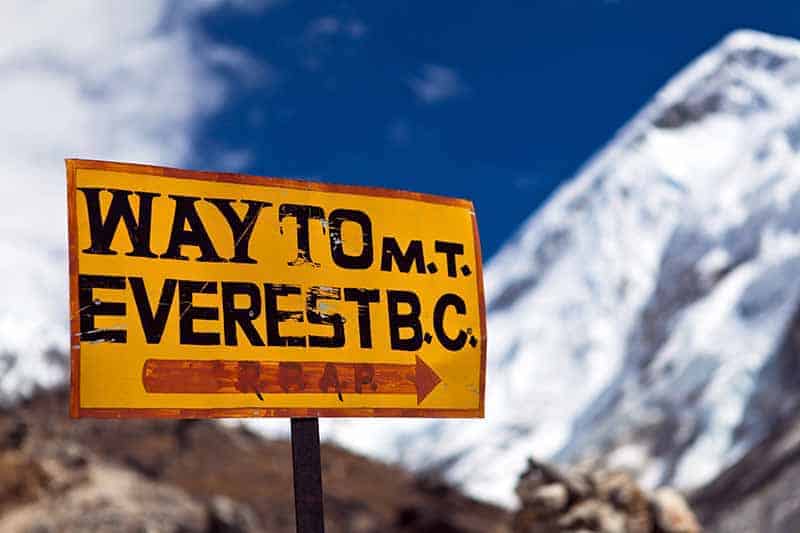
The Sagarmatha National Park is home to rare animal species such as snow leopards and red pandas – though it’s very unlikely you’ll encounter them. You’ll frequently have to step aside (to the uphill side!) as you encounter yaks on the trail.
Whether you choose to follow the traditional EBC route or one of the alternative trails, it’s guaranteed to be an experience you’ll never forget.
In contrast to most multi-day treks where you’d be camping in a tent, trekkers to base camp stay in cozy tea houses. You can find several available in a range of budgets, which function as both hotels and restaurants.
The trek is dotted with Buddhist monasteries and tiny villages almost all the way up. The relaxed pace of the trek allows plenty of time for you to explore the villages and get to know the local Sherpa culture.
Mt. Everest is increasingly covered in garbage left behind by the hordes of people who have set out to conquer its lofty heights. When you go, please respect the environment and do your best to minimize waste.
The most popular time of year to do the Everest base camp trek is between February and May – the pre-monsoon season.
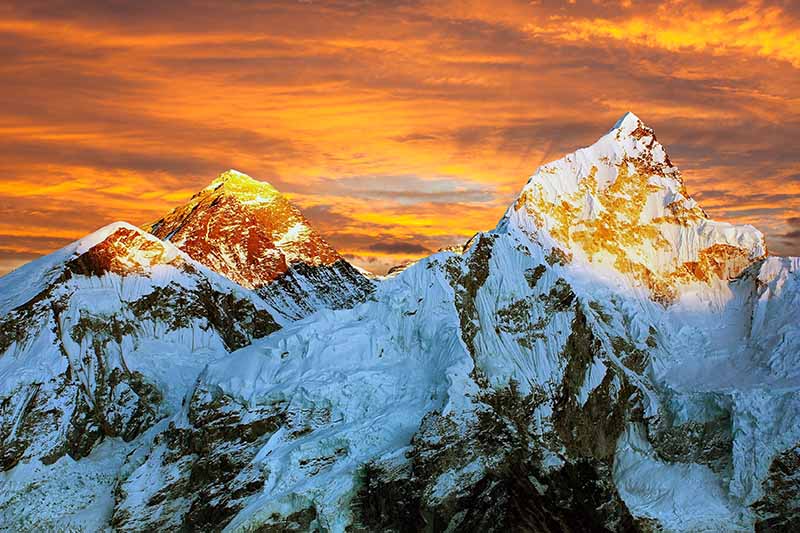
During these spring months, the weather is typically warm and dry and the mountains will be ablaze with colorful rhododendrons.
This is also peak season and while you’re unlikely to have the trails to yourself, you’ll enjoy a buzzing atmosphere at the tea houses on the way. This is also when most Everest climbers make their summit attempts.
The summer months bring the monsoon rains, resulting in slippery trails and a heightened risk of landslides. If that doesn’t deter you, the leeches and foggy weather might! It’s not recommended to attempt the trek in the summer.
It can also be difficult to fly into Lukla during the monsoon. Indeed, this is a good time to pick the Jiri trek over the classic EBC trek.

If you want fewer crowds, try going in September or October, the post-monsoon months, when you have the highest chance of clear skies, although temperatures are slightly colder.
You can even do the trek in the winter but be prepared for sub-zero temperatures most days and lots of snow.
Whenever you go, make sure you pack for unpredictable weather in case a snowstorm takes you by surprise.
Trekkers interested in the local culture might want to plan their trip dates around traditional holidays with celebrations in Kathmandu, such as Holi (February/March) or Indra Jatra (September).
Another thing to consider when planning your trip is flight prices, which can vary considerably. Check flights before booking as this might have a huge impact on when you want to go.
Lastly, be aware that it might be harder to find tour operators who provide treks in off-season months. Also, some of the paths might be closed.
Conversely, if you want a stab at actually sleeping in Everest Base Camp, then late spring is your best option. It will be rare to find tour operators who might be able to wrangle this.
Everest Base Camp Packing list
If this is your first multi-day trek, don’t forget to budget for all the equipment you’ll have to take with you.
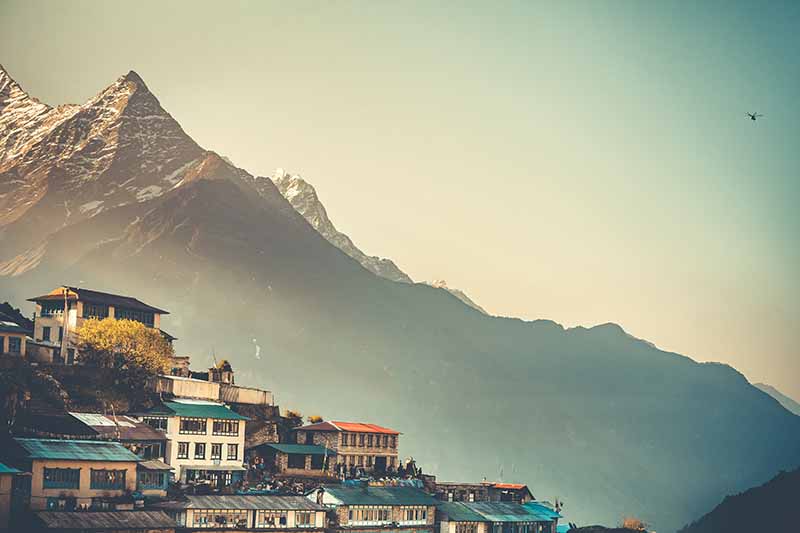
You can choose between renting or buying your gear. Hikers who plan on doing more multi-day treks might want to invest in their own equipment.
If you’re doing a two-week trek, it makes more sense to rent your sleeping bag and down jacket. For trekkers who plan on trekking for a whole month, it makes more financial sense to buy.
The neighborhood of Thamel in Kathmandu offers plenty of options for buying and renting. However, the products on offer may be of questionable quality.
Further on, Namche Bazaar is a last-resort option if you find you’ve forgotten to pack any essentials. If you keep your receipts, then talk it over with the shop when buying. Some shops will buy your gear back from you, at the end of your trek, for a reduced price.
Almost everything available for sale along the trek has been carried up the mountain, either by yaks or people. This means things get more expensive the higher you go.
Packing strategically. This means bringing the items you can’t live without while avoiding overloading your backpack. Whether you hire a porter or decide to go solo, somebody will be lugging your things up the mountain. Indeed,think twice before including unnecessary items like an extra book or five spare shirts!
Aim to pack around 10kg if you’re carrying everything yourself, and 20-25kg if you’re getting help from a porter. Don’t forget that your water adds extra weight. Try packing your bag with full water bottles, to get a more accurate idea of how much you can bring.
This list is aimed at trekkers who will be sleeping in tea houses every night. Be aware that if you don’t book early enough, the tea houses may be sold out in high season.
If you think you might end up having to camp, Then you’ll need more supplies not covered on this list. Such as a winter insulated tent , sleeping pad , etc.
What to Wear
The clothes you pack will depend on which season you’re visiting in. Make sure you have enough clothing to keep warm, especially in the evenings.

Layers are crucial, as temperatures and weather conditions will change drastically between day and night and as you ascend and descend in altitude.
Tea houses often only heat the common areas, and then only in the evenings, so bring warm clothes for lounging around at night.
The higher you get, the less likely you are to have power in your tea house, or only for a few hours as they’re run off solar power .
Base layers: Your base layer should be comfortable and moisture-wicking. Stay away from cotton; go for merino wool or synthetics .
Pack a long-sleeved shirt (avoid short sleeves as you’re more likely to get sunburnt) and long underwear, if only for the cold evenings.
Fleece mid-layer: You’ll probably be putting this on and taking it off with every mountain pass. Indeed, try to find one that will fit easily into your day pack.
Outer layer: Get a down jacket with a good warmth-to-weight ratio, as you’ll be carrying it much of the time.
Waterproof windbreaker and pants.
Hiking pants: Well-insulated trekking pants , or trekking pants that can turn into shorts.
Waterproof hiking boots. We can’t stress enough how important it is to break your hiking boots in properly before your trek.
Don’t forget to bring a pair of comfortable sneakers or sandals for the evenings and for bathroom runs.
Socks: Woollen hiking socks are worth the investment – bring a few pairs that can handle very cold temperatures for the higher altitudes, and look for flat seams and padded spots to reduce blisters.
Sock liners and Vaseline are two other good ways to prevent blisters . You should also bring a pair of warm socks for base camp.
Gaiters: These will be especially useful during the rainier months.
Gloves : Pack a thin pair of “inner” gloves and a very warm pair of outer gloves. There will be at least one or two days where your fingers will freeze otherwise – for example, the day you summit Kala Patthar.
Scarf/balaclava/buff: The trail to EBC gets infamously dusty, provoking the “ Khumbu cough ” that plagues many hikers. A buff or something similar will keep you warm as well as provide you with a layer to breathe through to minimize the amount of dust in your lungs.
Beanie and sun hat , preferably with neck cover, to protect against the sun .
Underwear and sports bras: You’ll probably be reusing these, so get good-quality, non-cotton ones.
Accessories
Drinking water: Most tour operators provide purified water. Avoid bottled water, as this is expensive on top of being an environmental disaster.

We recommend bringing two big reusable water bottles (or a water bladder for drinking on the go). Tablets take a while to work and it’s nice to have one water bottle ready to drink while the other one is getting purified.
You can also fill a bottle with hot water and sleep with it in your sleeping bag if you’re cold during the night. If you’re purifying your own water, bring water purification tablets , LifeStraw , or a Steri-pen. But remember, these need charging, and charging on the trail costs money.
You may wish to add flavor enhancers to your water. Unfortunately, at Gorak Shep the water is very mineralized so you’ll need to buy bottled water.
Showering: Whether or not you shower is up to you. Expect to pay around $5 for a hot shower. Some people rely on wet or backpacking body wipes , especially since wet hair is no fun in negative temperatures!
Sunglasses: The combination of snow and altitude is brutal on your eyes, so invest in good polarized sunglasses with wraparound arms.
Sleeping bag : The teahouses will provide blankets and pillows but you’ll want your own sleeping bag and pillowcase.
Find a mummy sleeping bag rated to -20° C – or colder, depending on the season. Consider bringing a silk liner , especially if you’re renting your sleeping bag.
Toiletries: Sunscreen , SPF chapstick (this is better than lip balm as there’s no need to smear it on with your grubby fingers), quick-drying towel, tissue, baby wipes, period supplies, compressed toilet paper tablets or biodegradable toilet paper (remove cardboard and keep in ziptop bag), hand sanitizer, toothbrush and toothpaste, etc.
Always bring toilet paper with you. Most bathrooms are squat toilets and are located only in villages.
Tip : wet wipes are more expensive than toilet paper on the trail, so if you have to choose, stock up on wet wipes and buy toilet paper when you run out.
Shewee: Ladies, you’ll be glad not to have to pull your pants down in the freezing high-altitude weather. If you need to pee, then I recommend using a portable pee device, like PeeBuddy Reusable Female Urination Device . You stand and use the portable pee funnel, so you don’t need to squat.
If you get your period on the trail and you’re not comfortable with using the DivaCup, another good option is to keep used pads/tampons in a ziptop bag and dispose of them in the next garbage can.
Personal first-aid kit: Bring diarrhea meds, altitude meds, antibiotics, ibuprofen, paracetamol, aspirin, bandaids, blister plasters, tape/trekker’s wool, Vaseline, cough drops (to beat the Khumbu cough), cold medicine, rehydration salts.
Tour operators should provide the rest. Don’t forget to get your travel vaccines before you go.
TSA approved padlock for your luggage.
Backpack: What you pack your gear in will depend on whether you’re using porters. Most porters prefer you to pack your things in a soft-sided duffel bag. Check with the tour operator in case they provide these for you.
If you have a porter, then you’ll only need a daypack for yourself. If you’re not hiring a porter, then bring a collapsible daypack anyway in addition to your backpack. This is so you can leave your big backpack in the tea house during the one-day acclimatization hikes.

Try to get a backpack with straps for hiking poles and zippers to open it from the sides. Not to mention, you won’t have to dig everything out of your bag whenever you want to access something.
Dry bag or plastic cover for your backpack and daypack to prevent water ingress.
Hiking poles : These are a must! All the treks listed here will take you uphill, downhill, uphill and downhill again. Hiking poles will save your knees, and they’ll come in handy on slippery trails during the wet season.
Headlamp or flashlight : You’ll be glad to have this in the evenings after the power goes out, and during early-morning or late-night hikes. Remember to bring extra batteries.
Trekking map: If you’re going independently, a good trekking guidebook is essential – Lonely Planet is highly recommended.
Ziptop bags: These always come in handy for protecting electronics, etc.
Camera or GoPro with memory card and extra batteries.
Money: There are ATMs at select points such as Lukla and Namche Bazaar. But these have low daily withdrawal limits and high commission fees. What’s more, they have been known to take money out of your account without actually dispensing it to you.
Since currency exchange rates on the trail are sky-high, it’s best to bring a stash of local rupees with you. You’ll need rupees to pay for meals, showers, tips, etc.
Wi-Fi: A good option for staying connected is to buy a local sim card. It will give you data to about 4000m altitudes, and sometimes in EBC itself.
You can also check Everest Link for Wi-Fi data packages. The connection is supposedly available in most teahouses along the way, but it can be slow and unreliable so don’t depend on it too much.
Top Tip : Beware of phone updates. These will eat through your Wi-Fi and data limits before you realize what just happened!

Entertainment: EBC treks usually only schedule a few hours of hiking a day, to allow you time to acclimatize. Bring books, a Kindle , cards or other games for the many hours of downtime. Certainly, bring a journal so you can remember this once-in-a-lifetime experience!
Solar charger : Many teahouses offer power points where you can charge your devices for a nominal fee. Also, don’t forget to bring an adapter. It’s a good idea to bring your own solar-powered charger and extra batteries to minimize costs.
Tip : Keep batteries, base layers , and anything else you don’t want freezing in your sleeping bag with you overnight. Keep your phone in flight mode to save power.
Important documents: Bring printouts of your travel insurance information. And make sure one of your travel buddies knows what to do and whom to contact in case of an emergency.
Bring your passport, visas, money, etc. – I always keep these documents in a zip-top bag.
Trekking solo? Bring a safety whistle , compass , pocket knife , & duct tape, especially on the less-crowded trails
High-calorie snacks: These will make a huge difference to your experience. Snacks are exceedingly expensive on the trail, and they provide welcome calories on tough trekking days.
You’ll have to decide how many you want to bring and which ones you want to buy along the trail.
Cloth bags : Many trekkers use these to separate dirty laundry and organize different outfits.
Earplugs: You’ll be glad for these when the tea houses are alive with the sound of Khumbu coughs.
A Note on Trekking Insurance
Be very careful when purchasing travel insurance, because regular policies usually stop covering you once you ascend higher than 3,000m/9,840ft.

At these altitudes, you have a higher chance of getting Acute Mountain Sickness. Also, there’s a pretty good chance you’ll have to be airlifted out to a hospital for injuries . To clarify, injuries like a pulled muscle or twisted ankle at sea level can be more serious at higher altitudes.
Because of these higher costs and risks , insurance companies will charge you a premium for high-altitude trekking insurance.
Luckily, there’s no shortage of insurance companies that offer travel insurance specifically tailored to Everest Base Camp trekkers.
When purchasing a policy, make sure you’re covered for trekking up to altitudes of 6,000m/19,685ft. In addition, ensure it has search and rescue costs, preferably by helicopter.
Don’t forget to check if you’re covered for different travel-related illnesses (and make sure you get your vaccinations before going!).
It’s also nice to have compensation for delayed or canceled flights and repatriation in case of death (hopefully you won’t be needing this one).
Check the clause about lost, stolen or damaged luggage to see if it will cover most of the cost of your hiking gear.

If you’re traveling in winter or shoulder season, then check for trip cancelation insurance. This is to ensure you’re covered if your trek is canceled due to weather.
You’ll likely have other considerations depending on your personal situation. Don’t just take our advice for it – remember to do your research, ask questions and read the fine print of your travel insurance policy before you purchase.
I always keep my travel insurance information handy while on the trek. Additionally, I pass it along to someone else in my group. This is so they know whom to contact in case of an emergency.
Some travel insurance providers require you to confirm with them before ordering a helicopter. Check out this option on getting trekking travel insurance for more information.
How to Avoid Altitude Sickness
Most tour operators organize a relaxed trekking schedule and follow the mantra “climb high, sleep low”. In essence, this is to avoid the risk of altitude sickness.
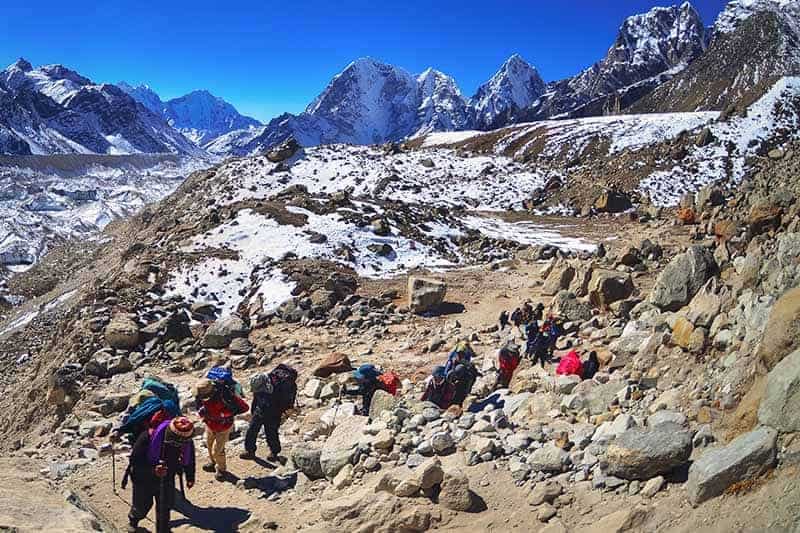
Take it slow – once you finish hiking for the day you’ll have a lot of dead hours in the teahouse. For this reason there’s really no point in racing there.
It’s important to respect the acclimatization days. The acclimatization hikes are designed to help you adjust to tomorrow’s altitude.
Try to drink 3-4 liters of water a day, as dehydration will make the altitude sickness way worse. It also goes without saying that you shouldn’t drink caffeine or alcohol or smoke during your trek.
If you can, then cut out these vices about a week before you start hiking. So that you won’t suffer from withdrawal headaches.
Many people swear by Diamox as a preventative drug against AMS. It’s your choice whether to take this or not. I personally found the tingling fingers and toes to be very off-putting, but it probably helped me acclimatize.
Altitude sickness is unpredictable and doesn’t discriminate based on fitness or age. Listen to your body and descend immediately if you think you have signs of Acute Mountain Sickness.
Check out our article on altitude sickness for a more detailed overview.
Choosing a Tour Operator
Every year there are rumors that the Nepali government will make it compulsory to go with a guide.. But so far, it’s still possible to undertake the trek to EBC on your own.

Unless you’re going in high season, you’ll can drop in at tea houses and get a bed without a reservation.
Independent trekkers can choose whether to hike all by themselves. While others choose between ring a porter, a guide, or a guide and a porter. A guide will speak some English and can help with booking accommodation. However, a porter probably won’t speak English and will only carry your bag.
You can also hire one person who acts as a guide and a porter. Another upside to hiring a guide is that you’ll be providing someone with a job. And in turn, you’ll get to immerse yourself in the Nepali culture.
Alternately, you can opt to join a guided trek with a tour operator. While this is pricier, it’s a good choice for people who have never done such a long, high-altitude trek before.
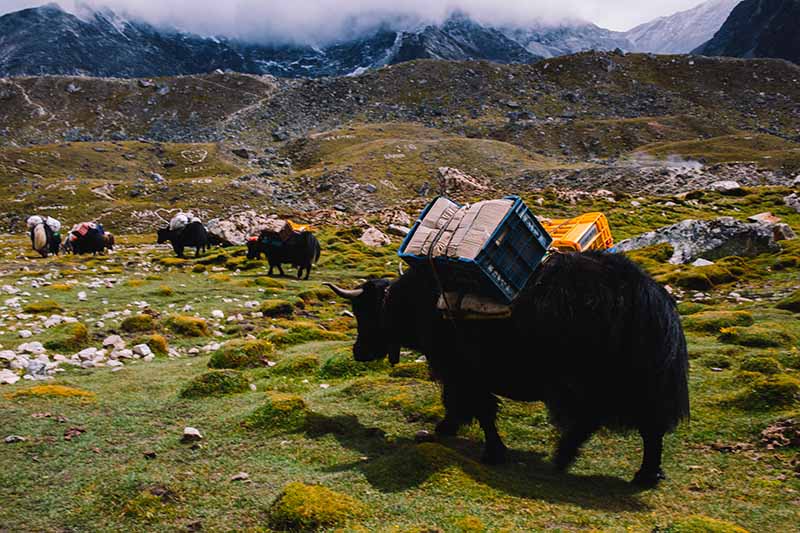
Tour operators typically arrange flights, airport transfers, accommodation, visas and permits, porters and guides. Western tour operators will usually charge more, but provide a more trustworthy service. You can expect to pay about twice as much for a Western tour operator.
Check to see if your tour operator is registered with the Trekking Agencies Association of Nepal (TAAN). TAAN regulates trekking agencies in Nepal to ensure fair treatment of employees, respect for local communities and preservation of the environment.
The Kilimanjaro Porters Assistance Project mission is to improve the working conditions of porters. They advocate for fair treatment and wages, lend free mountaineering clothing, and encourage them to work for only ethical companies. Through providing education and training opportunities, guides and porters have received classes on porters rights, Leave No Trace and are certified in First Aid.
Please make every effort to ensure the porters and guides are dressed properly, stay within the weight limit including their own luggage. Also, ensure they have adequate sleeping arrangements and insurance and are paid a fair wage.
It’s better to go with companies that employ their porters and guides full-time instead of freelance because there’s a better chance the company is providing them with benefits, sick days and health insurance.
Tipping is always a tricky subject and suggested rates will depend on whom you ask. Aim for around 15 percent of salary (if you’re traveling in a group, this number refers to the total pooled tip) per porter and/or guide, and adjust accordingly.
The classic Everest Base Camp trek winds through the Khumbu valley; once reaching Everest Base Camp, you’ll retrace your steps back down to Lukla for the return flight to Kathmandu.

If you’re interested in escaping the crowds or doing circular routes that don’t involve retracing your steps, there’s a variety of alternate routes to choose from.
You can also opt to tack small detours onto your classic EBC trek. This is especially doable if you’re traveling independently or in a small group.
You shouldn’t have any trouble booking your trek, even on the classic EBC trek.
Classic Everest Base Camp trek
The classic Everest Base Camp trek takes about 14 days, including time in Kathmandu before and after.
From Kathmandu, you’ll fly into Lukla Airport (2,860m/9,383ft) with its famously short runway – try to sit on the left side of the plane so you can catch your first views of Mt. Everest.
It’s a good idea to leave yourself a few buffer days, as Lukla flights are often delayed due to weather. Flights should be included in your tour price; otherwise they’re about USD 300, plus USD 100 for your guide’s ticket.
From the airport, you’ll trek to Phakding for the night.
The next day you’ll set out from Phakding and follow the Dudh Koshi River, crossing suspension bridges and pine forests until you reach the Namche Bazaar (3,440m/11,286ft), in the Sagarmatha National Park UNESCO World Heritage Site .
Namche Bazaar is the region’s principal trading point, so use this opportunity to stock up on supplies you might have forgotten. If you’re there on Saturday, then don’t miss the market. From here you can also catch a peak of Everest.
You’ll take a day to acclimatize in Namche Bazaar – you can make the most of the Wi-Fi, stock up on any supplies you forgot, check out the Sherpa museum or just tool around the village.
The day after you’ll follow the former Tibet-Nepal trading route via Thame to Tengboche. These villages are known for legendary views, where you can visit one of the region’s biggest monasteries .
Next you’ll hike through Phangboche to Pheriche while admiring the views of Ama Dablam. You might be interested to know that Pheriche is where the Himalayan Rescue Association makes its base – but hopefully you won’t need to use this information!
Most people stay in Pheriche for a day to acclimatize and visit local attractions like the Imja Lake or Dingboche village, which boasts views of Lhotse and Island Peak.
Now that you’re rested, you’ll be ready to tackle the trek to Lobuche, which features a 600m/1,969ft elevation gain. You’ll skirt the perilous Khumbu Glacier and witness the many memorials to sherpas and climbers who perished in their attempt to climb Everest.
From Lobuche you’ll set out towards Gorak Shep, which is the world’s highest permanently inhabited village.
Finally, it’s time to push on through the moraine towards Everest Base Camp! Since actual summiteers of Everest have priority, don’t expect to spend too long there or even be allowed inside the base camp itself.
But don’t worry, the adrenaline-filled atmosphere extends all the way down to the trekker stop point! From here you’ll go back down to Gorak Shep for the night.
You can’t actually see the peak of Mt. Everest from Everest Base Camp, so the next day you’ll make a steep ascent up to the summit of Kala Patthar (5545m/ 18,192ft) to catch amazing views of Everest, Nuptse (7,861m/25,791ft) and Lhotse (8,516m/27,940ft).
Most groups try to do this at sunset on the same day as they reach EBC, or at sunrise the next morning, when Mt. Everest sometimes turns pink in the early-morning light.
Forging on ahead, you’ll descend to Dingboche or Pheriche, and from there past Tengboche and back to Namche Bazaar the next day. Keep an eye out for the massive fields of wild rhododendrons if you’re visiting in the spring!
Your last day of trekking will take you back to Lukla, where you’ll spend the night before catching the flight to Kathmandu.
- Pros : Comparatively gentle altitude profile, can be done independently
- Cons : Have to retrace steps on the way down, can be crowded
- Length : ~130km (12-14 days)
- Highest point : Kala Patthar (5545m/ 18,192ft)
Gokyo Lakes Trek
The Gokyo Lakes Trek is popular for its beautiful glacial lakes , nestled in the quiet Gokyo valley.
Like the classic Everest Base Camp trek, the Gokyo Lakes trek starts at Lukla, breaking off towards the northwest at the Namche Bazaar.
This trek is considered slightly more challenging than the classic EBC trek, with steeper ascents and more time spent at high altitudes.
It takes 2-3 days longer, detouring around some of the most crowded sections of the classic base camp trek but still finishing at Everest Base Camp.
You’ll see glacial lakes and summit Gokyo Ri (5,357m/17,575ft) where you’ll earn views of Everest, Lhotse and Cho Oyu (8,201m/26,906ft).
Fly into Kathmandu, spend a few days acclimatizing and then take another flight to Lukla. The next day, you’ll trek down through the Dudh Koshi Valley to Phakding past several Buddhist sites.
Hiking through pine forests and along the Dudh Koshi River, you’ll cross several suspension bridges including the Hillary Suspension Bridge. After entering the Sagarmatha National Park, you’ll continue hiking until the Namche Bazaar.
You’ll then separate from the classic EBC trek and head northwest towards Dole along the Dudh Koshi valley. You’ll get some of the first views of Everest, Lhotse and Ama Dablam today.
The next day brings a steep climb towards Machhermo, which is populated with yaks in the summer.
Allow yourself a day to acclimatize and enjoy views of Ngozumpa Glacier (the biggest glacier in the Himalayas). Once you’ve enjoyed the glacier, trek to the Gokyo lakes and you’ll eventually reach Gokyo village. If you are tired by now, you’re in luck because this is where you’ll bed down for the night.
This is another popular time to take an acclimatization rest day and explore the surrounding lakes, or summit Gokyo Ri, which stands almost 5,500m/18,045ft above sea level.
Stop to take in the stunning views of Everest, Lhotse and Cho Oyu, then continue back down to the Ngozumpa glacier and on into Dragnag.
The next day is a tough one. You’ll traverse Cho La, one of the “Three Passes” (5,420m/17,782ft), cross a glacier and then spend the night in Zonglha.
Joining up with the classic EBC trek, you’ll stop for a moment of reflection at the memorials to sherpas and climbers who perished in their attempts to climb Everest, and then continue on to Lobuche for the night.
From Lobuche, you’ll skirt the Khumbu glacier, hiking up past Gorak Shep and finally you’ll reach Everest Base Camp! Enjoy it while it lasts, because the priority at EBC is the Everest summiteers, especially in the spring months.
You’ll hike back down to Gorak Shep alongside views of the Khumbu icefall . Part of the highest glacier on Earth, the icefall’s deadly crevasses, unstable seracs and unpredictable avalanches have taken dozens of lives.
The next day you’ll hike up Kala Patthar, with more views of Everest and the neighboring mountain peaks, and then down to Dingboche along the classic EBC route.
It’s time to return to Namche Bazaar. The day after you’ll hike back to Lukla through the Dudh Koshi valley, and then fly into Kathmandu.
Because the trek is longer, expect to pay more than you would for the classic EBC trek. Trekkers are advised not to attempt this trek independently, due to the increased difficulty and the fact that there are fewer people on the routes.
Like the classic EBC trek, the best time to go is during spring or fall. Because the trek isn’t as popular, you shouldn’t have to worry about crowds for most of the way, so feel free to go during peak season.
- Pros : Fewer crowds, more challenging, more sights, get to summit a peak, see the world’s highest freshwater lake system, prettier landscapes than classic trek, circular route so no need to retrace steps
- Cons : More expensive than classic EBC trek
- Length : ~220km/136 miles (16-17 days, including a few days in Kathmandu before and after)
- Highest point : Kala Patthar (5545m/18,192ft)
Jiri to Everest Base Camp
This old-school route mirrors the route taken by the first Everest summiteers in the 1950’s, starting with an 8-hour bus ride from Kathmandu to Jiri instead of flying into Lukla.
From Jiri, you’ll pass through the towns of Sete, Junbesi and Numtala in the Solu Khumbu region.
After reaching Lukla, you’ll join up with the classic EBC trek, passing through Phakding, Namche Bazaar, Tengboche, Pheriche and Gorak Shep.
In total, the Jiri route takes about 5-6 days longer than the classic route.
Jiri route trekkers will have the chance to spend a lot more time with the locals. You’ll also spend more time at low altitudes – the route starts at just 1,800m/5,905ft above sea level – meaning landscapes will forests and streams with actual running water.
Much of the trek is off the beaten path, with fewer crowds than the EBC classic trek.
Tool around Kathmandu for a day and then take an 8-hour (190km/118 mile) bus ride, following the Sun Koshi River to Jiri and then Shivalaya.
The next day, you’ll cross a suspension bridge over the river and then explore several tea houses. Go through the Deorali Pass, taking a moment to check out the prayer flags and decorated walls, and then head down to Bhandar for the night.
From Bhandar, you’ll walk through fields and forests before embarking on a steep descent t
owards the village of Kenja. Uphill again, you’ll traverse the Lamjura Pass and arrive at the town of Sete.
The next day, you’ll return to the Lamjura Pass and pass through magnificent fields of pine trees, magnolia and rhododendrons. Without a doubt, you’ll appreciate the stunning mountain views. Next,hike down the other side and you’ll arrive at the town of Junbesi.
Back into the forest, you’ll see Mt. Everest for the first time. You’ll then cross the Ringmo Khola suspension bridge and arrive at the village of Ringmo with its gorgeous Tibetan architecture. Another forest and you’ll be at Nunthala.
In the morning, you’ll head out towards the Dudh Koshi River, crossing another impressive suspension bridge on your way to Bupsa.
The next few days will take you to higher altitudes as you pass through forests with monkeys and several small villages.
Arriving in Lukla, you’ll join up with the classic EBC trek. After reaching Everest Base Camp, you’ll summit Kala Patthar for the obligatory views of Mt. Everest at dawn and then return through Gorak Shep, Namche Bazaar and finally Lukla, for your flight back to Kathmandu.
Like the classic Everest trek, the Jiri route is best undertaken in spring or fall. Caution: some parts of the Jiri trek may be closed in the winter, so we don’t recommend going during this season.
The Jiri route is only slightly more difficult than the classic Everest Base Camp route, due to its longer duration.
The average day of hiking comprises 5-6 hours, covering about 15km/9 miles. On the bright side, due to the more gradual ascent compared with the classic trek, you’re less likely to get altitude sickness.
- Pros : More authentic, less touristy, chance to see Solo Khumbu landscapes (terraced farmland, forests, Dudh Koshi river, sherpas), gradual acclimatization
- Cons : 8-hour bus ride (but scenic!)
- Length : ~250km/155 miles (22 days, of which 18 days of trekking)
- Highest point : Kala Patthar (5,545m/ 18,192ft)
Three Passes Trek
As you might infer from the name, the Three Passes trek takes you across three high mountain passes (all higher than 5,000m/16,400ft). Thus, making it more difficult than the classic EBC trek.
After reaching Namche Bazaar, the Three Passes trek splits off from the classic trek. This takes you towards Thame and the Nangpa Valley. The trek takes around 19 days in total, of which 14-15 will be spent trekking. Getting a guide is highly recommended.
After flying into Lukla from Kathmandu, you’ll work your way down to Phakding.
The next day will take you across several suspension bridges on the way to Namche Bazaar. You’ll be there for a day of acclimatizing. After which you’ll split off from the classic EBC route and head to Thame.
Crossing the Bhote Koshi river, you’ll reach Lumde and catch your first good views of the mountain peaks. The next day, you’ll tackle the first pass.
The Renjo La (5,360m/17,585ft) lies near the Dudh Koshi valley and will reward you with views of Everest. Then you’ll pass the Gokyo lakes and the village of Gokyo, where you’ll summit Gokyo Ri and catch sight of Cho Oyu.
After spending some time acclimatizing in Gokyo, you’ll walk across the Ngozumpa Glacier. This is Nepal’s largest glacier, and you’ll then spend the night in Dragnag.
The next day is notorious. You’ll traverse the next pass, Cho La (5,420m/17,782 ft), which has a glacier and prayer flags at the top. On the other side of the pass lies Zonglha.
Joining back up with the base camp trek, you’ll visit Lobuche and Gorak Shep and take in views of the Khumbu Glacier, Everest, Lhotse and Nuptse.
You’ll explore Everest Base Camp and summit Kala Patthar before retracing your steps back through Gorak Shep and Lobuche.
The trek keeps on going, past the Kongma La pass (5,535m/18,159ft), down into the Chukkung valley and up to the summit of Chukking Ri (5,550m/18,209ft) with more mountain views.
You’ll trek through Dingboche, with its views over the Khumbu Valley. Eventually, you hike down through the rhododendron fields and the village of Khumjung, ending back at the Namche Bazaar.
From here you’ll cross the Dudh Koshi, following the classic EBC route back down to Lukla.
This trek can also be done backwards; it’s up to you whether you want to head clockwise or counter-clockwise after the Namche Bazaar.
Many people recommend doing the trek counter-clockwise to avoid crossing the difficult Renjo La Pass right off the bat.
You’re best off doing this trek with a tour operator, as it’s quite off the beaten path.
- Pros : See a little bit of everything, uncrowded trails, challenging elevation profile
- Cons : Riskier terrain than classic EBC trail, long stretches with no facilities
- Length : ~21 days (150km/90 miles)
- Highest point : Chukking Ri (5,550m/18,209ft)
Island Peak (Imja Tse)
Experienced trekkers who wish to try their hand at mountaineering might be interested in summiting Island Peak (6,189 m/20,305 ft).

To master the glaciers and icy headwall during the ascent of these peaks, you’ll need to use crampons, an ice ax and potentially a ladder and ropes to cross the crevasses, depending on the weather.
Tour operators claim you can learn these skills on the fly, but it’s better to have some prior mountaineering experience before you tackle these routes, which are significantly more challenging.
That being said, Island Peak is a relatively “easy” climb as far as climbs go, so it’s a good option if you’re looking to expand your repertoire.
Since a detailed itinerary of Island Peak is outside the scope of this article, be aware that the general packing list doesn’t include the specialized mountaineering equipment you need for this trek.
Likewise, ascending Island Peak takes you above 6,000m and will probably not be covered by standard travel insurance providers, so check with your local mountaineering association for options.
Practical Information
What will I eat? How much will the trip cost? These are the questions most frequently asked.
As a general rule, the tea house lodgings themselves are very, very cheap with the condition that you eat dinner and breakfast in the same lodge.
This is where your costs will really add up – food is very expensive – so check with your tour operator when booking to see if meals are included.
Food on the trek is repetitive but nourishing. The meals are carb-heavy – think pasta dishes, dahl baht or “sherpa stew” with veggies and noodles.
What other trek offers the convenience of stopping in at a tea house or bakery for a hot lunch or freshly baked pastry? Just be prepared for stretches where you won’t see a tea house for several hours.
Hot drinks are readily available, and a popular treat is a deep-fried Mars bar. Don’t leave without trying one!
Most people recommend going vegetarian during the trek. Sagarmatha National Park has a no-kill policy so all meat has to be carried up by porters or yaks and is never very fresh, so there’s a real risk of getting sick.
Much of the garbage that’s disposed of in the villages ends up getting burned on-site, which really makes you consider the impact of your waste.
Before wantonly throwing plastic into the garbage cans, try to reduce what you use and pack out as much as you can.
The budget for your trip will vary widely depending on whether you’re trekking independently or going with a tour operator.
If you are booking with a tour operator, the flight price and permit prices should be included – usually you’ll have to pay for your guide’s flight as well.
Tour prices run from about USD 1000 to 3000 depending whether you go local or get a Western tour operator.
Budget around USD 400 for the flight from Kathmandu to Lukla Airport, including your guide’s ticket. If you go independently, consider getting help from a local agency for buying your flight tickets.
Flights have a way of being overbooked and you’re more likely to get on the plane if a local agent is vouching for you. On this note, factor in a few buffer days for your flight from Lukla back to Kathmandu, in case of weather or overbooking delays.
Nationals of all countries except India will need a visa to enter Nepal, which costs USD 25 for 15 days, USD 40 for 30 days and USD 100 for 90 days.
You’re best off getting the 30-day visa even if your trek is only scheduled to take two weeks, as weather and other factors might extend the trip unexpectedly. For the most part, you can get your visa when you land in Nepal.
It used to be mandatory to purchase a Trekkers Information Management System (TIMS) card, but the laws on this are constantly changing and there is a new local tax being charged, so check before you go unless your tour operator is arranging paperwork for you.
You will need a Sagarmatha National Park entry permit, which you can get ahead of time or at Monjo, when entering the park.
The price of the permits will normally be included in the trip price if going with a tour operator. Bring several passport photos for the permits.
All Set: Are You Ready?
The name “Everest” may sound intimidating, but this is actually one of the more approachable multi-day treks out there.

If you have a reasonable fitness level and are comfortable walking uphill for several hours a day carrying a heavy backpack, then you should be able to complete the trek. The key is to go slowly to avoid altitude sickness.
You don’t need special mountaineering know-how or an incredible level of fitness. The hike to EBC is a relaxed one, as hikes go.
The pace is slow, to allow you the time to acclimatize, so you’ll have plenty of free hours to peruse the village cafés, tuck into a slice of apple pie and snuggle up with a good book or make friends over a game of cards back at the teahouse.
That being said, of course it’s a good idea to prepare for the trek by hitting the gym in the months prior to your departure, and plenty of practice hikes starting two months before you go.
Don’t forget to practice hiking with a heavy backpack on! Check out this article for more tips on preparing for an uphill hike .
In total, the trek is around 130km/81 miles round trip, with an elevation gain of 2,685m/8,809ft between Lukla (2,860 m) and Kala Patthar (5,545 m).
It’s usually done in just under two weeks, including rest days for acclimatization. The outward leg will take longer and you can expect to trek 5-6 hours per trekking day, covering an average of 15km/9 miles.
The hike from EBC back to Lukla will go much faster since you’ll already be acclimatized.
Plenty of people with no prior trekking experience manage to complete the EBC trek and you can too! Like any non-technical trek at altitude , the key is a proper pace, a decent level of fitness and most of all, a good attitude!
Have you been trekking in Nepal? Let us know about it in the comments section below!
Disclaimer : This post is for information only and is not intended to replace the advice of an experienced guide. Always do your research and check with local weather stations, etc. before attempting to undertake treks in the wild. Distances are approximate and routes may vary depending on your tour operator.
Photos via Depositphotos.
Recommended Reading: 21 Best Camping Games for Adults For a Memorable Trip
- Insider’s Guide to Hiking Machu Picchu
- Inspirational Mountains: Exciting Summits for Ordinary Hikers
- Climbing Kilimanjaro: Everything you Need to Know
- Four Pass Loop (This Hiking Trail Should Be at the Top of Your List)

What’s a Backpacking Poop Kit? When Nature Calls

Best Tent Brands for Every Type of Camper: From Solo Adventurers to Family Outings
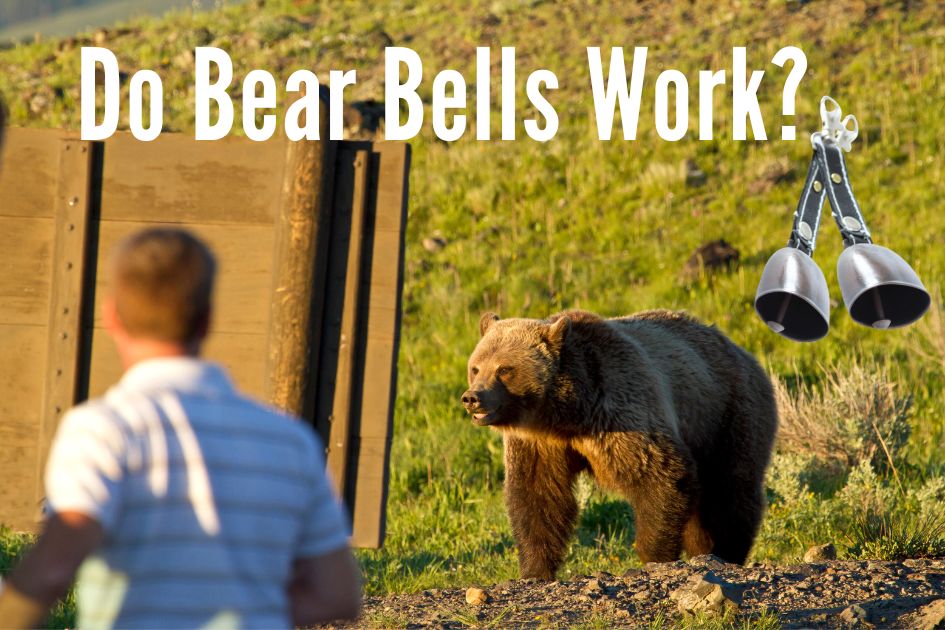
The Truth About Bear Bells For Hiking

Jetboil Zip vs Flash: Battle of the Boilers

The 12 Best Double Sleeping Bags

Black Friday Sales- Holiday Sales are ON!!!
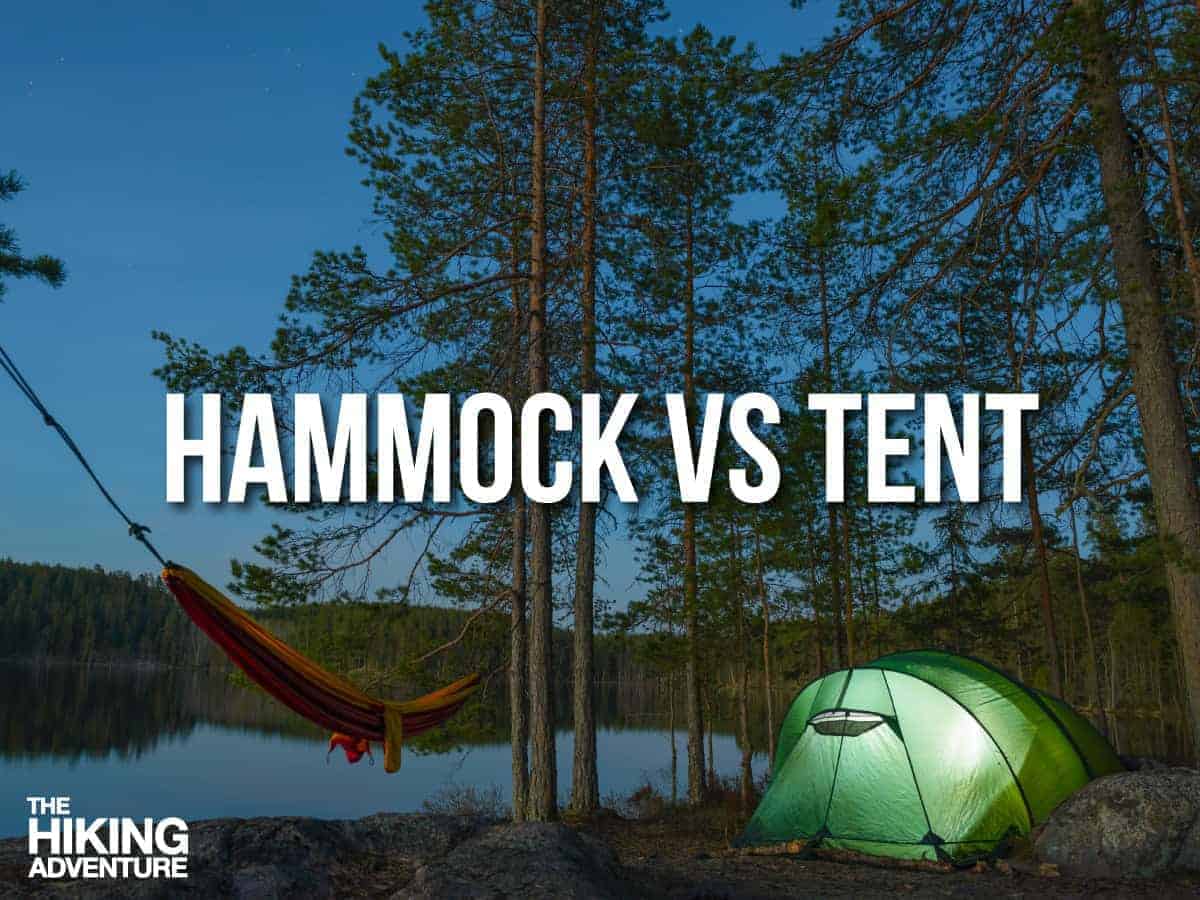
Hammock vs Tent: Battle for the Best Night’s Sleep

How to Stay Warm in a Tent [13 Warm Tent Hacks]

How to Choose the Best Backpacking Hammock

The Best of Outdoor and Camping Near Berlin

Conquer the Cold: Your Guide to Thrilling Camping in Cold Weather

The Best Blow Up and Inflatable Tents for Camping

Choosing the Best Backpacking Hatchet
Last update on 2024-04-16 / Affiliate links / Images from Amazon Product Advertising API
Trackbacks/Pingbacks
- Insider's Guide to Climbing Kilimanjaro in 2022 - Tips & Recommendations - […] Everest Base Camp […]
Submit a Comment Cancel reply
Your email address will not be published. Required fields are marked *
Save my name, email, and website in this browser for the next time I comment.
This site uses Akismet to reduce spam. Learn how your comment data is processed .
Best Time to Visit
Weather & Climate
Kathmandu Airport Guide
Top Destinations in Nepal
One Week in Nepal
Tipping Guide
Getting Around
Top Things to Do in Nepal
Complete Guide to Kathmandu
Top Things to Do in Kathmandu
Top Things to Do in Pokhara
Sacred Sites
Amazing Festivals
Top National Parks
Must-Try Food
Annapurna Circuit
Manaslu Circuit
Himalaya Trail
Facts About Mt. Everest
Trek to Everest Base Camp
Everything You Need to Know About Trekking to Everest Base Camp
:max_bytes(150000):strip_icc():format(webp)/greg-rodgers-adventure-ed92646b25f247049e53af6d36f6c15f.jpg)
Jason Maehl / Getty Images
Everest Camp II
Trekking to Everest Base Camp in Nepal's Sagarmatha National Park is the adventure of a lifetime. Although actually climbing Mount Everest is out of reach for many of us, anyone with enough grit and good enough fitness can reach EBC and the Khumbu Icefall, the starting point for climbing Mount Everest. (You’ll need an $11,000 permit and some serious equipment to go any higher from there!)
The Himalayan scenery here is unrivaled on earth. Snowy sentinels will witness your struggle toward the top of the world , while stupas, prayer flags, and Sanskrit tablets will remind you of the spiritual significance of the area. Sadly, the numerous memorials to hikers who perished along the trail underscore the seriousness of your undertaking.
You’ll battle freezing cold, thin air, weather changes, and your own body as you ascend. Once at Everest Base Camp, you won’t even get to see the famous mountain itself unless you take a day to climb Kala Patthar (18,519 feet), an adjacent prominence that affords views of the “Holy Mother” when weather permits.
Read on for our complete guide to the Everest Base Camp trek, with information on what to pack, when to go, EBC tours, and more. Note that we’ll only cover getting to South Base Camp in Nepal, not North Base Camp in Tibet .
What to Expect
Trekking to Everest Base Camp involves hiking between lodges (or “teahouses”) found in villages along the trail. Some days may only consist of four hours or so of uphill trekking, depending on how much elevation is gained that day. Sometimes, you’ll have the option of pushing on to another village higher up—but no matter what, you will never gain more than 1,312 feet (500 meters) in a day.
Once above the tree line, the common rooms in your lodges will invariably be heated by yak dung-burning stoves. Weary hikers will hang around these stoves, warming themselves and socializing before retiring early to their unheated rooms. The shared toilets are sometimes located in snowy outhouses.
The village of Namche Bazaar (11,290 feet) is considered the last fully “civilized” stop on the trek to Everest Base Camp. Here, trekkers can enjoy treats from a German bakery while watching screened documentaries. You’ll find last-minute gear and souvenirs for sale along with the last ATM on the trail. You can even indulge at the “highest Irish pub in the world” on your way down after a successful trek!
When's the Best Time to Trek to Everest Base Camp?
The best time for trekking to Everest Base Camp is in either spring (March to May) or fall (September to November). If you want to see the camp in full form with climbers, support teams, and film crews, you’ll need to time your trip with spring climbing season, usually late April or early May. This is also the busiest time to be in Nepal .
For less traffic on the trails, consider making your trek to Everest Base Camp in September or October. Unfortunately, this means hiking in cooler weather with even less daylight than usual.
Avoid making the trek during monsoon season in summer. Humidity reduces beautiful views at lower elevations, and snowfall closes trails at higher elevation.
Adisorn Fineday Chutikunakorn / Getty Images
Should I Book a Tour or Go Independently?
There are three options for completing a trek to Everest Base Camp:
- Book a group tour and have all arrangements made for you.
- Make the trek to Everest Base Camp independently .
- Arrive in Nepal, then hire a guide and/or porter yourself.
No matter which option you choose, try to spend an additional day at Namche Bazaar. The extra time at 11,290 feet reduces some of the effects of elevation later; you’ll enjoy a better overall trekking experience and suffer less. The extra day isn’t “wasted”—many day hikes around Namche Bazaar provide beautiful views while giving your body time to adjust. Your chances of successfully reaching Base Camp vastly improve if you spend more time at Namche Bazaar.
Everest Base Camp Tours
Although the most expensive option by far, having everything organized before you arrive provides peace of mind. You’ll be taken care of all along the way, with access to better safety measures such as supplemental oxygen. Bigger companies use yaks to take your gear ahead; you’ll find it waiting for you in your teahouse room at the end of each hiking day.
You can book an Everest Base Camp tour online from home, or if time permits, do so after arriving in Kathmandu . Booking on the ground through a Nepalese agency saves money and better helps the local economy. You’ll find trekking agencies on every corner in Thamel, but unfortunately, not all are reliable. Choose a reputable agency that’s a member of the Trekking Agencies’ Association of Nepal . You can see in the member directory how long an agency has been in operation, and hopefully, make a better informed decision.
Independent Trekking
First, independently trekking to Everest Base Camp doesn’t necessarily mean solo trekking. Trekking alone in the Himalayas is dangerous no matter your experience level. A simple slip or unexpected weather change could keep you from reaching the next teahouse before temperatures plummet at night.
Independent trekkers can save a lot of money by foregoing organized tours and simply teaming up with other trekkers they meet along the way. (Everyone you meet in the lodges is going in one of two directions: up or down!) The well-marked trail to Everest Base Camp is busy during peak trekking seasons, giving you the best chance of meeting new friends who match your speed and fitness level.
Going independently does carry some risk, of course. You’ll be responsible for your own well-being and making important decisions. On the other hand, you’ll be able to set your own pace and make adjustments based on how well your body acclimatizes. A majority of hiker deaths on the trail each year occur when people in group excursions are suffering from Acute Mountain Sickness (AMS) but don’t speak up. They fear slowing everyone down, or don’t want to forfeit reaching Everest Base Camp.
If guiding yourself, pick up a good trail map in Kathmandu. Don’t rely solely on electronic devices for making survival decisions! You’ll also need to store your luggage at a trustworthy guesthouse or hotel in Kathmandu. Locking duffel bags and padlocks can be purchased in local shops; some owners will buy them back once you return from your trek.
Hiking Guides and Porters
Rest assured: Your pack is going to feel heavier at 15,000 feet than it does at home! Even as an independent trekker, hiring a local guide and/or porter are options. Hiring directly ensures money goes to the Sherpas instead of a Western tour agency that managed to rank well online. Expect to pay between $15 to $20 a day for a porter or $25 to $30 a day for a guide.
You’ll need to negotiate terms and contingencies before hitting the trail. Paying up to half of the porter’s fee up front is common, and you will also be expected to tip guides and porters after the trip. Finalize details and other expenses to avoid a potential disagreement. The agreed daily rate should include their meals, drinks, and accommodation so you aren’t asked for money later.
Guides will approach you on the street in Thamel, however, you should hire only a credible and licensed guide through either a trekking company or your accommodation. You may still be able to hire a porter later on the trail by speaking to the staff at your lodge.
How Much Does It Cost to Trek to Everest Base Camp?
The cost of trekking to Everest Base Camp depends entirely upon your needed level of comfort. One indelible rule holds on the trail: Prices rise as elevation rises. That 50-cent candy bar from Kathmandu is worth $7 at 17,000 feet!
Extremely basic accommodation in teahouses can be found for as low as $5 per night. You’ll be expected to have your meals where you stay. A hearty Nepalese meal of dal bhat can be enjoyed for $6 or less, but expect to pay much more for Western food. A can of Coke can cost up to $5; remember, it’s heavy and had to be carried up by a porter.
Other luxuries add to the cost of life on the trail. A (somewhat) warm shower can cost $5. Charging electronic devices and accessing the internet, if available, cost several dollars an hour, and the solar charging systems are often slow and provide only a weak charge. Depending on your food and drink indulgences, plan to spend $20 to $30 a day living on the trail. This excludes any fees you pay to porters and guides.
If not already covered, your greatest expense will be the short flight to and from Lukla. The 30-minute flight can cost around $180 each way.
Do You Need a Permit for Everest Base Camp?
You’ll need at least two permits for trekking to Everest Base Camp. Your tour organizer will probably provide these, but you’ll need to arrange them yourself if trekking independently.
- Sagarmatha National Park Permit: Get this at the Nepal Tourism Board office in Kathmandu (approximately $25).
- Khumbu Pasang Lhamu Rural Municipality Permit: You will get this permit from a checkpoint in Lukla; it isn’t available in Kathmandu (approximately $17).
- Gaurishankar Conservation Area Permit: You only need this permit from the Tourism Board if doing the longer trek to Everest Base Camp from Jiri instead of flying to Lukla (approximately $17).
The permit system changed in 2018. Disregard any information you read elsewhere about needing a TIMS card for the trek to Everest Base Camp.
Greg Rodgers
What to Pack
Kathmandu, particularly in Thamel, has more than enough outfitting shops for gearing up. Unfortunately, those same shops are stacked with counterfeit gear that probably won’t survive the hardships of the trek. Sifting through the piles of used gear in dark shops requires patience. Prices are inflated, so put your game face on and start haggling !
If you booked a guided tour, find out what your tour company plans to provide (e.g., hiking poles, down jackets, etc) before shopping. Consider bringing mission-critical items from home so that equipment failure doesn’t affect your experience. For instance, you’ll need quality sunglasses to prevent eye injury. Sunglasses for sale locally may have “UV Protection” stickers on them but don’t offer much actual protection.
- Good hiking boots. You should invest in high-quality, waterproof hiking boots and break them in properly before you leave home; painful blisters can ruin an otherwise-excellent trek.
- Lightweight sleeping bag. Rooms along the trek are unheated. Lodges provide weighty blankets for the freezing nights, but you'll appreciate having a layer between you and the unwashed bedding. Even a lightweight silk “sleep sheet” will do the trick.
- Alternate footwear. After removing your muddy hiking boots, a pair of lightweight shoes or sandals comes in handy for wearing around lodges and shared bathrooms.
- Water purification: As elevation increases, so does the cost of bottled water and need to reduce plastic waste. You’ll be drinking more than ever to counter dehydration in the dry air. Although there are many options, the two-bottle, chlorine dioxide system from Aquamira is a reliable solution.
- Trail snacks: Candy bars and nuts provide a much-needed boost to energy and morale while on the trail or in the lodge.
- USB power bank: Keeping batteries charged in the extreme cold is a challenge. If you plan to use a phone for photos or communication, you’ll want to bring along a rugged power bank.
- Diamox tablets: Diamox (acetazolamide) is medication for countering the dangerous effects of AMS. Guides should have some on hand, but independent trekkers will want to buy Diamox to carry. Beware of fake tablets for sale in Kathmandu. Purchase only from legitimate pharmacies—not from shops—and discuss how to use them.
If you won’t be taking your poles and other gear home after the trek, consider giving it directly to the Sherpas you meet in Lukla.
John Elk III / Getty Images
How to Get There
Fly into Kathmandu's Tribhuvan International Airport (KTM) and plan to spend a few days resting and preparing for the trek. Unless you’ll be starting the trek in Jiri—which requires a seven-hour bus ride and an additional five to seven days of trekking—you’ll need to book a flight to Lukla.
Taking the small prop plane from Kathmandu to Lukla (LUA) is one of the scariest and most scenic aviation experiences many travelers will have. Although not the highest airport in the world , weather and visibility changes have caused enough crashes at Tenzig-Hillary Airport in Lukla to earn it the title of “most dangerous airport in the world.”
The trek to Everest Base Camp begins in Lukla and finishes at the infamous Khumbu Icefall!
How Dangerous Is Everest Base Camp?
Although frostbite and rock slides are hazards along the trail, the biggest danger—by far—comes from the high elevation. Once symptoms of AMS begin (severe headache and nausea), you need to descend as soon as possible. Ideally, you’ll ascend slowly enough to minimize altitude sickness in the first place.
The CDC recommends never gaining more than 500 meters in one day and taking a rest day for every 1,000 meters gained. Whenever possible, you should descend to sleep at a lower elevation than the highest point reached during the day. Track and do the elevation math as though your life depends on it.
The high elevation and thinner air introduces additional risks. For one, your body will increase its production of red blood cells, causing excessive urination; be sure to drink plenty of water to avoid dehydration. Many trekkers will also experience the dry, hacking "Khumbu cough" from panting heavily in the thin air and breathing in the dust of the region. You can cover your face with a bandanna or balaclava for some protection. The cough usually goes away after time. Ultraviolet rays, too, are more damaging in the thinner air, so protect your skin, lips, and eyes by applying high SPF sunscreen and lip balm, wearing long sleeves, and donning sunglasses.
Finally, yak trains always get the right of way! Never share a bridge crossing with one, and always pass them on the “inside” of the trail. Startled yaks are unpredictable and sometimes knock trekkers off the trail.
Additional Tips
- Take your stocking up on snacks seriously. Pack candy bars, even if you wouldn’t ordinarily indulge at home. You’ll experience strong cravings at higher elevation. Hikers are willing to spend $7 or more for Snickers bars near Everest Base Camp!
- The weather in the Himalayas changes quickly and unpredictably. Flights to and from Lukla frequently become delayed by a day or two, maybe longer if a winter storm system sets in. Add some buffer days to your Kathmandu itinerary just in case this happens.
- Before retiring to bed, ask your teahouse staff to pour boiling water into your bottles and use them as bed warmers. Fair warning: They’ll probably be frozen next to you in the morning!
- Sleep with your phone and any batteries in the bed with you. Your body heat will protect battery life a little.
- Weight limitations imposed by airlines that fly to Lukla are strictly enforced. If an airline says 33 pounds (15 kilograms), that includes all baggage , stowed or carried. Don’t risk having to forfeit gear in Kathmandu Airport because you’re a pound or two over the allowance. You can stuff some items into your pockets, within reason.
Solo Trekking in Nepal's Everest National Park
How to Choose and Prepare for a Hiking Trip
Independent Trekking in Nepal
The Best 12 Hikes in Nepal
Five Amazing Hiking Routes Among the High Mountains of the Himalayas
The World's Highest Places and Attractions That You Can Visit
How to Go Teahouse Trekking in Nepal
How to Trek Nepal's Manaslu Circuit
A Guide to Tipping in Nepal
Nepal's Great Himalaya Trail: The Complete Guide
Where Is Mount Everest?
The Top 15 Destinations in Nepal
How to Trek Nepal's Annapurna Circuit
The Different Types of Adventure Travel
The Best Time to Visit Nepal
How to trek to Everest Base Camp

Jun 20, 2023 • 10 min read
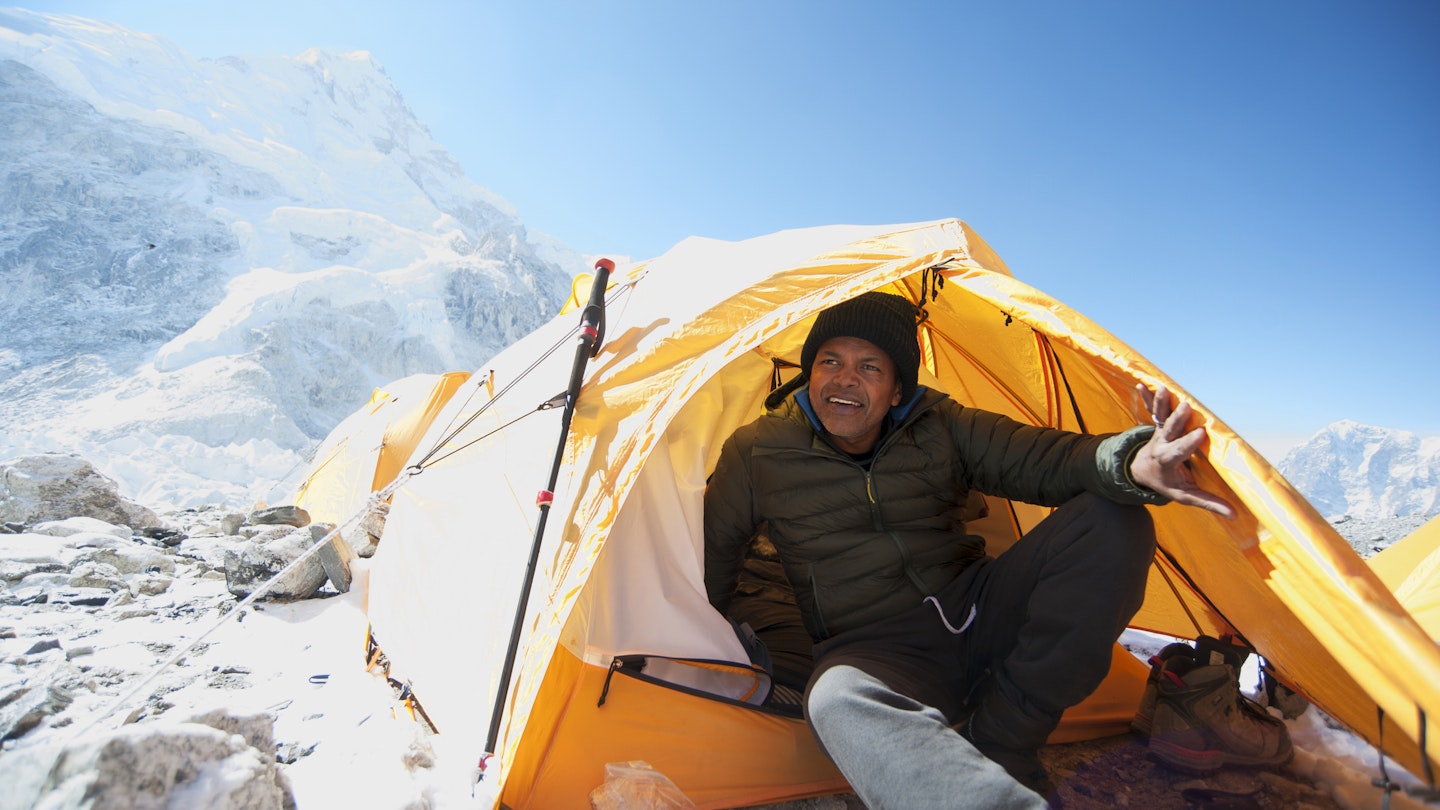
From permits to teahouses, here's everything you need to know about trekking to Everest Base Camp © Mint Images / Getty Images
Top of many people's travel bucket lists, the trek to Everest Base Camp is often the first thing people think about when they start dreaming of a trip to Nepal .
The walk takes trekkers past Sherpa villages and Tibetan-style monasteries, right up into the heart of the high Himalaya, into a breathtaking world (literally) of iconic glaciers, lakes and the tallest peaks on earth. It's probably the world's most famous trek.
But what is it actually like to trek to Base Camp? Is it something within your capabilities or budget? What should you bring? And, most importantly, can you get a proper coffee en route?
I just returned from trekking to Everest Base Camp for Lonely Planet's Nepal guide . Here’s what I think you need to know.
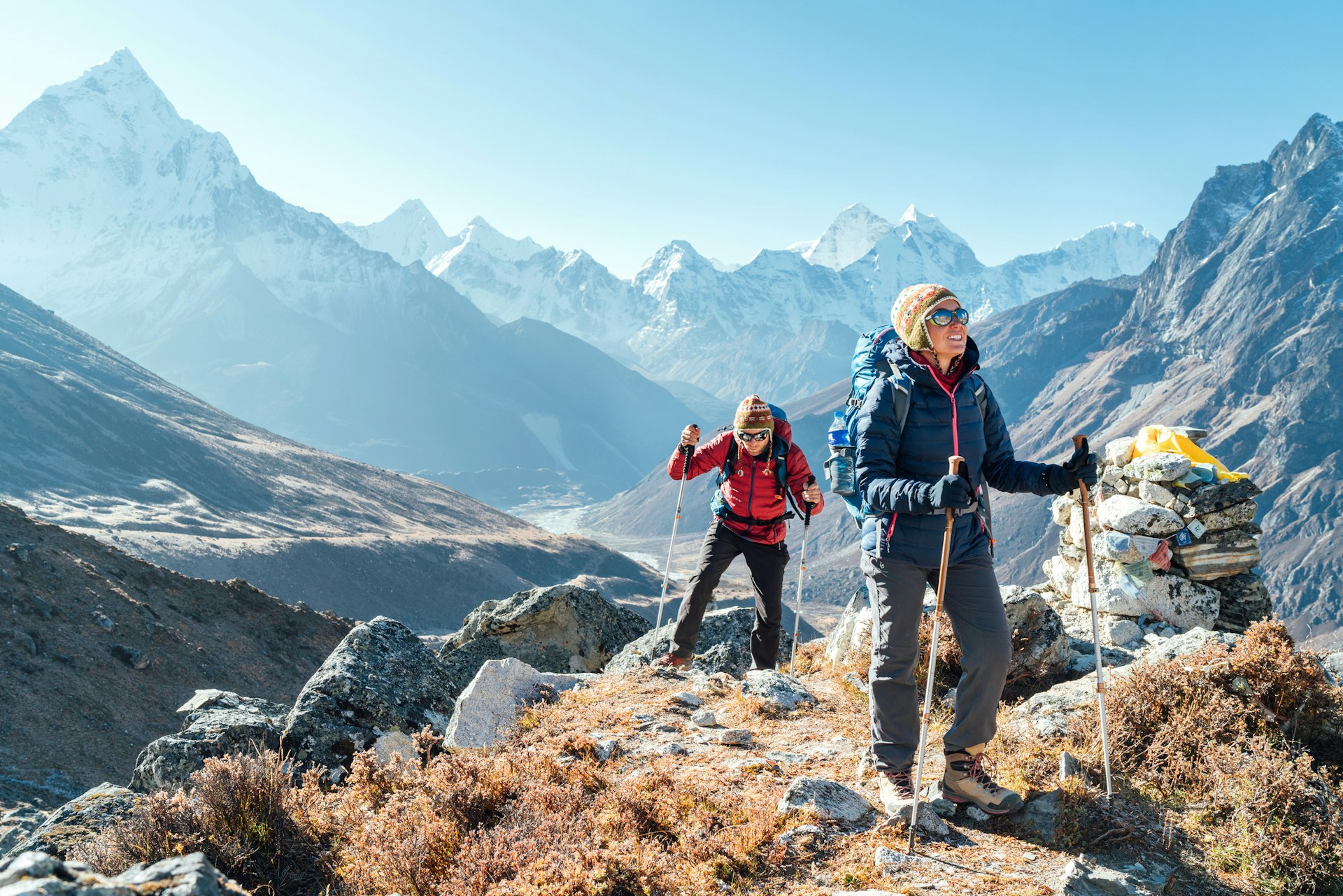
What's so great about the Everest Base Camp (EBC) trek anyway?
Firstly, the mountain scenery surrounding the world's highest peak is truly spectacular. The sublime views of Ama Dablam, Pumori, Nuptse and Thamserku peaks are unbeatable and constantly change as you progress along the walk. The Sherpa villages and monasteries are fascinating places to visit and the lodges (called teahouses) are the best in the world.
The knowledge that you are walking in the expedition footsteps of Hillary, Tenzing, Messner and others is a thrill. Anyone who has read Into Thin Air will be moved by the memorial stupas of Rob Hall, Scott Fischer and others who have lost their lives on the mountain. And then there's the fact that you will have reached the base of the world's highest peak; whether you call it Chomolongma (Tibetan), Sagarmatha (Nepali) or Everest, it’s a rush all the same.
And what’s not so great about the Everest Base Camp trek?
Well, if you force us to play devil's advocate… EBC is one of the busiest trails in Nepal. In the high season months of October and November you'll be walking with thousands of other trekkers, competing with them to get a bed, a lunch order or an airplane seat. There will be lines at checkpoints and even at moments on the trail itself. In bad weather you might be stranded at Lukla airport with hundreds of other trekkers, all trying to get on the first flight out. It's not quite the Zen-like wilderness experience you may have been imagining.
Bear in mind also that even after a solid week of walking, your view of Everest will be partial at best (for infinitely more dramatic Everest views visit the northern Everest Base Camp in Tibet ). If you trek outside of May's expedition weather window you won’t actually find much to see at Base Camp beyond a boulder hastily spray-painted with "Everest Base Camp".
If this has put you off, don’t worry; there are dozens of other fantastic treks in Nepal .
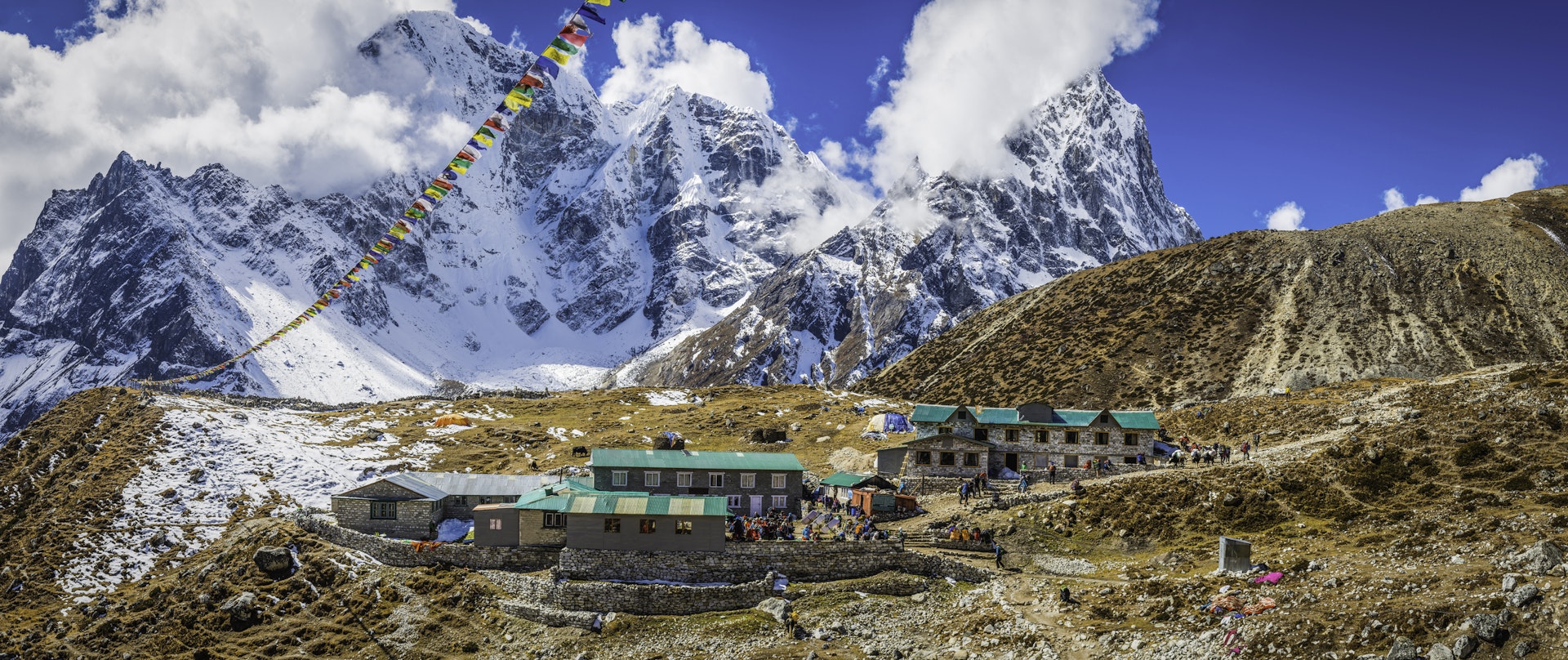
How long does it take to trek to Everest Base Camp?
The walk from the airport at Lukla to Everest Base Camp and back takes a minimum of 15 days. Several of the days are surprisingly short, but this is because you have to figure in time to acclimatize to the high altitudes.
If you can, it's definitely worth adding on a couple of extra days to this basic itinerary. Some of the most dramatic (and least visited) views are from detours off the main trail. I always add two days to visit Thame, two days to visit Chhukung and, if possible, three or four days to visit the lakes of the Gokyo Valley – probably the most beautiful scenery in the Everest region.
Be sure to also budget an extra day or two as a transport buffer. Weather-related flight delays in and out of Lukla are not uncommon (I had to wait six days for a flight to Lukla on my recent trip) so you need some buffer time if heading back for an international flight home.
How challenging is the trek to EBC?
In terms of physical effort, the EBC trek itself is not especially tough. There are only a couple of steep climbs, lasting about an hour each, and most days involve less than four hours of walking.
The thing that makes the EBC trek tough is the altitude. Base Camp is at 5600m (18,373ft) and you will need to spend one or two nights above 5000m (16,404ft). Above 4000m (13,123ft) you are going to feel increasingly lethargic and out of breath as the amount of oxygen in the air decreases. Combine this with the cold, the discomfort of being at altitude and the compounded tiredness from walking for two weeks straight, and you can see why the whole trek experience is definitely a physical challenge.
While you don't need to be an athlete to walk to EBC it is still a good idea to start a fitness regime in the weeks leading up to your trek. You'll enjoy the walk so much more if you are in decent shape.
When is the best time to trek to Everest Base Camp?
October and November bring the best weather and the clearest skies but these are also the most popular months. The second most popular season is April to early May, when spring blooms and expedition traffic bring extra interest to the trail. To avoid the crowds but still enjoy clear views, pack an extra thermal layer and come in December or March.
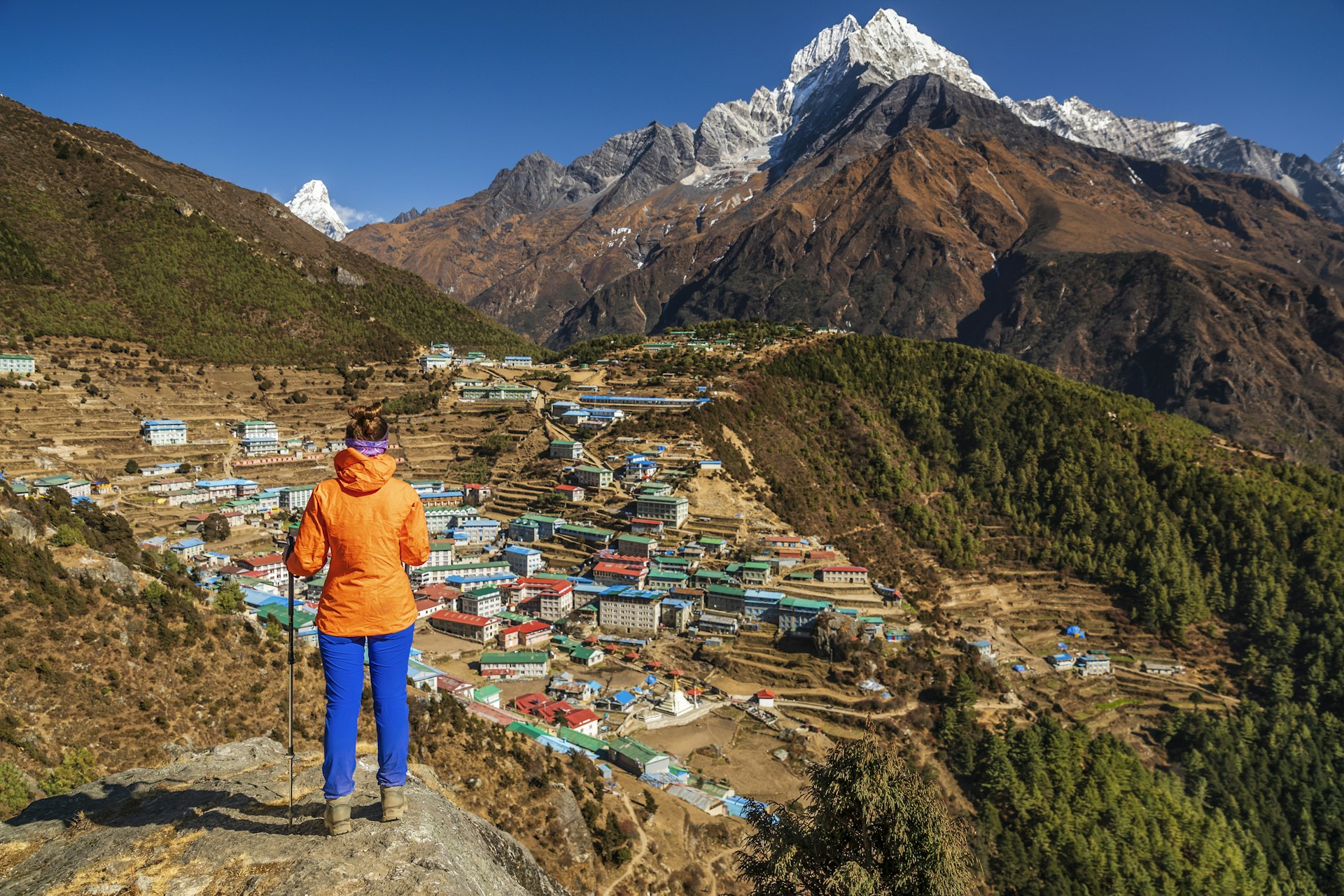
What can I do to avoid altitude sickness?
The majority of people who fail to reach Base Camp do so because they failed to acclimatize properly to the altitude. It's essential not to gain altitude too quickly by following the recommended overnight stops and limiting your daily altitude gain to a maximum of 400m (1312ft) when above 3000m (9843ft).
Be sure to add in acclimatization days at both Namche Bazaar and Dingboche, during which it's a good idea to hike to higher altitudes during the day, returning to sleep lower at night.
What are the teahouses like?
At lower altitudes the Everest lodges are the most comfortable in Nepal. Private rooms are the norm, many of which have private bathrooms. Showers are available at most places, though the hot water supply can be patchy. All have cozy dining rooms with tables arranged around a central dung-fueled stove. There are even a few luxury lodges along the trail.
In budget lodges, or when you get above Dingboche, things get simpler, with rooms offering little more than a collection of plywood walls, a solar light and a foam mattress. Toilets are a mixture of seats and squatters; sometimes outdoors, always freezing. A blanket is normally supplied but be sure to bring a four-season sleeping bag rated to well below 0°C (32°F).
What's the food like?
Menus in teahouses range from pasta and pizza to spring rolls, fried potatoes and soups, though the most popular meal is a daal bhaat , a set Nepali meal of rice, lentil soup and fried vegetables, normally served with a papad and pickle, and with a refill included. It's the most filling and environmentally sustainable meal you can order.
In villages such as Namche Bazaar and Dingboche you will also find bakery-cafes serving espresso and slices of delicious apple pie, plus shops selling everything from Snickers bars to bottles of beer. This is one trek where you might actually gain weight!
Can I get wi-fi or phone coverage?
Most lodges offer wi-fi, either free of charge or for a few dollars per day (at higher elevations). Above Namche Bazaar you will likely have to buy a scratch card, giving you unlimited data for twelve hours (AirCell) or a specific amount of data over a month (Everestlink). Depending on your network provider you'll likely get data and a phone signal at lower elevations, and possibly even at Everest Base Camp, but not at other high altitudes. So yes, in theory, you can Skype all your friends from Base Camp!
What should I bring?
Warm clothes are a must, and you should pack thermal underwear, a down jacket and fleece hat. Comfortable hiking boots and good, padded socks are also essential. Sun block, a sun hat with a brim and good sunglasses are important against the strong high-altitude light.
Morale-boosting snacks like chocolate and salami are always helpful, as is a book and smartphone with mapping software like Maps.me. Bring water purification of some sort. If you forget something, don’t worry, you can buy almost anything you might want in Namche Bazaar these days (from ice axes to cans of Pringles), though at prices higher than in Kathmandu .
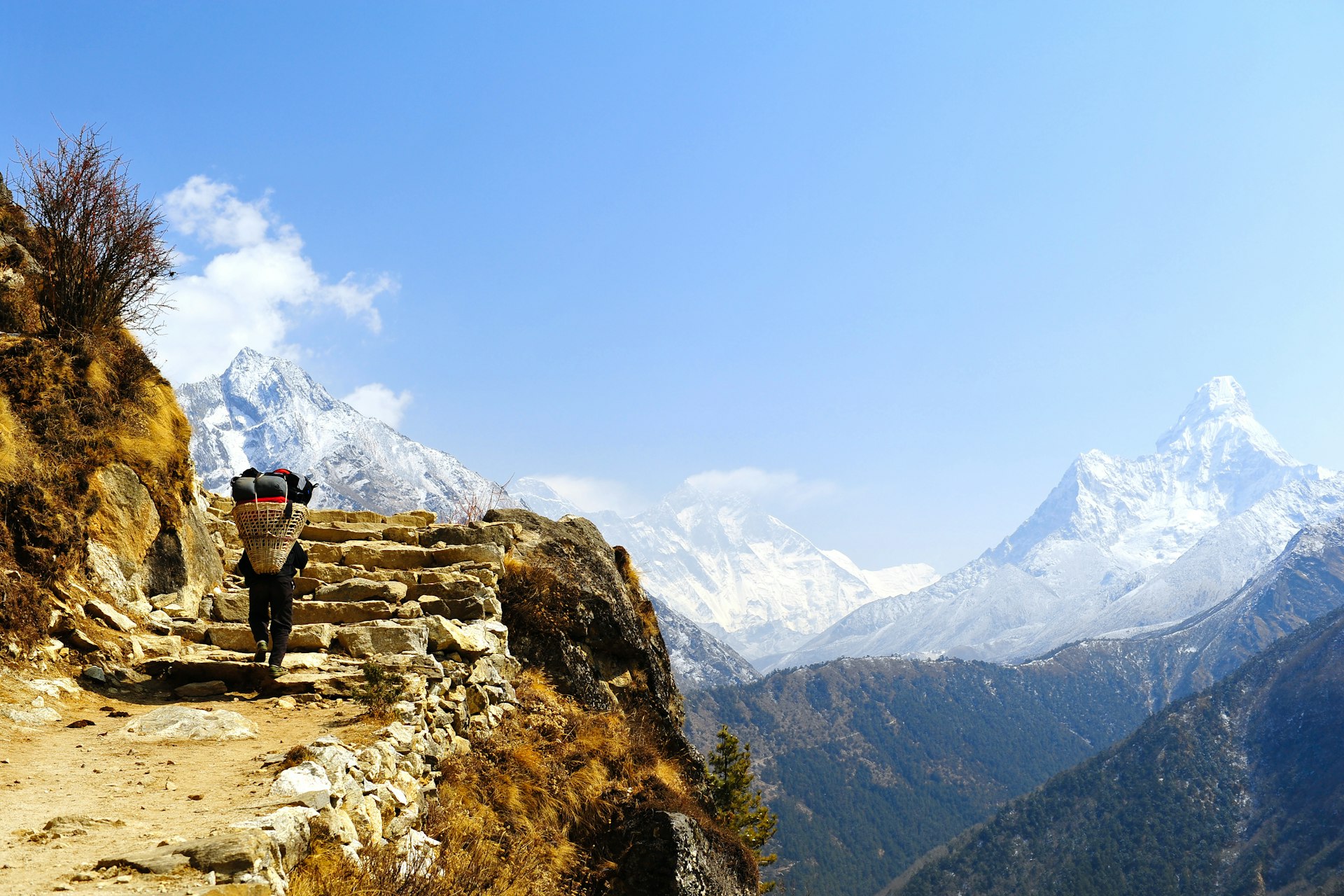
Do I need a porter and guide?
In terms of finding your way you don't need a guide if you are an experienced walker, as the route is clearly marked and well-trod. A guide can be useful for smoothing your way at teahouses, making sure you get your food on time and helping you pay your bill. It's important not to trek alone, so solo trekkers should find a companion or take a guide or porter.
A porter will carry a bag of around 15kg, freeing you up to pack a few extra chocolate bars and enjoy the walk with little more than a day pack. Not having the strain of carrying a full pack is worth its weight in gold for anyone over the age of 50. Trust me.
How much does the Everest Base Camp trek cost?
For a room in a lodge and three meals a day, figure on US$20–25 per person per day, a bit more if you want a room with a private bathroom and the occasional slice of apple pie. Add on another US$5 every time you want a shower. Figure on an additional US$20 per day for a porter, and US$25–30 for a guide, and budget 10–15% of that fee for an end-of-trip tip.
You'll pay a bit more to have a Kathmandu-based trekking company arrange your entire trek, and a lot more for the convenience and backup of an international trekking tour.
Do I need any permits?
You will need to buy an Everest region permit (US$20) at Lukla, as well as a Sagarmatha National Park entry ticket (US$30) at Monjo. Currently that's all you need.
How can I trek more sustainably?
With 60,000 trekkers and guides headed to the Everest region, it’s important to minimize your impact on the region. Firstly, don't buy bottled water on the trek, as the bottles are nonrecyclable and are a huge problem throughout the region. Bring a system of water purification, like a Lifestraw or Sawyer filter, a Steripen or chemical purification.
Secondly, carry all your trash out (especially batteries), and sign up for the Carry Me Back program, whereby you carry a 1kg bag of trash from Namche Bazaar to Lukla, for it to be recycled in Kathmandu.
Finally, be polite to the Sherpas and porters you meet en route, as well as your fellow trekkers. Walk clockwise around stupas and be respectful at monasteries and shrines.
How do I get to Lukla to start the trek?
Flights run multiple times daily between Kathmandu and Lukla, taking around 30 minutes. During high season however you may have to drive five hours from Kathmandu to Ramechhap airport to catch your Lukla flight there.
It's also possible to fly or drive to Phaplu and walk two days to Lukla from there, or walk from Shivalaya to Lukla in seven days as an excellent pre-trek warm-up.
This article was first published January 2013 and updated June 2023
Explore related stories
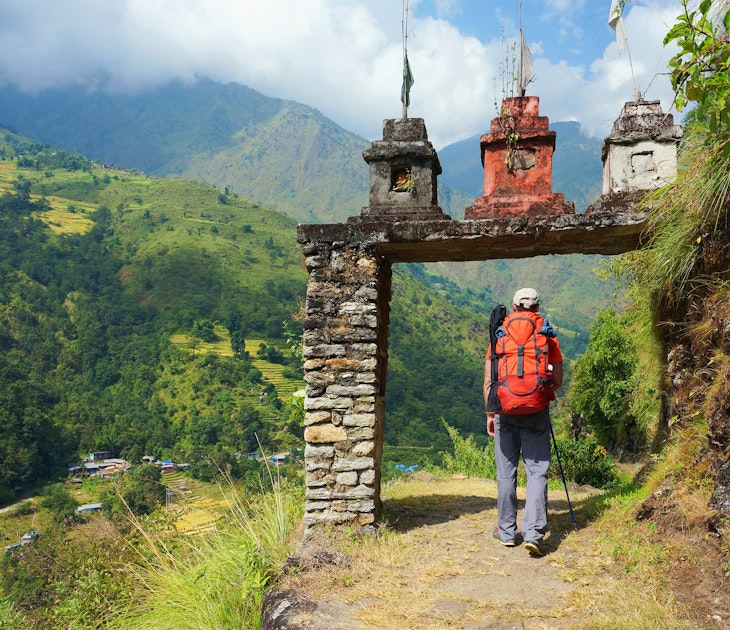
Mar 14, 2023 • 4 min read
To reduce accidents and promote jobs, Nepalese authorities recently announced a ban on solo trekking in national parks and conservation areas.

Jul 13, 2022 • 8 min read

Jan 31, 2022 • 6 min read
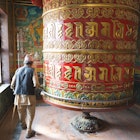
Jan 9, 2022 • 8 min read

Sep 14, 2021 • 11 min read

Jan 28, 2021 • 5 min read
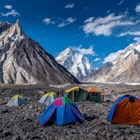
Jan 12, 2021 • 7 min read
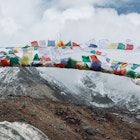
Dec 10, 2020 • 6 min read
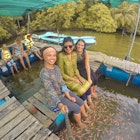
Jan 7, 2020 • 6 min read
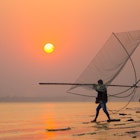
Oct 10, 2019 • 9 min read

EVEREST BASE CAMP TREK

EVEREST BASE CAMP

Pin Tweet Share WhatsApp
THE ESSENTIAL GUIDE
In this guide we cover everything you need to know about the Everest Base Camp Trek in Nepal. This includes suggested itineraries and practical information about accommodation, costs, what to pack, independent vs. guided treks, transport, and more. We also offer a route map with GPX download for use on the trek. And along with this written guide, we also share ‘silent hiking’ films that work well as a visual guide to the trail.
A chance for an adventurous and exciting journey, the Everest Base Camp Trek serves up spectacular scenery and gets you close to the world’s highest mountains, and as one of Nepal’s best known treks, it attracts people of all ages and experience levels. The trek ascends to high altitude (5000 m +) and is challenging, but it is achievable with a sensible itinerary that includes proper acclimatisation. Read on to discover more and start planning your own EBC trek.
Use the drop down menu below to jump to each section of this guide
TABLE OF CONTENTS
EVEREST BASE CAMP TREK OVERVIEW
EBC TREK FILMS
EVEREST BASE CAMP MAP & GPX DOWNLOAD
ELEVATION PROFILE & 3D ROUTE MAP
EVEREST BASE CAMP ITINERARIES
- THE CLASSIC EBC TREK
- EBC TREK VIA KHUMJUNG & PHORTSE
- EBC VIA KONGMA LA (5514 m)
- EBC AND GOKYO LAKES TREK
- BUFFER DAYS
EVEREST BASE CAMP TREK SUMMARY
- LULKA TO NAMCHE BAZAAR
- NAMCHE ACCLIMATISATION DAY
NAMCHE BAZAAR TO DINGBOCHE
- ALT. ROUTE VIA KHUMJUNG & PHORTSE
DINGBOCHE ACCLIMATISATION DAY
Dingboche to everest base camp.
- ALT. ROUTE VIA KONGMA LA
EVEREST BASE CAMP TO LUKLA
- ALT. ROUTE VIA CHO LA & GOKYO LAKES
BEST TREKKING SEASONS
HOW TO GET TO LUKLA
HOW TO GET TO LUKLA WITHOUT FLYING
EVEREST BASE CAMP TREK PERMITS & FEES
TREKKING INDEPENDENTLY
TREKKING WITH A GUIDE (& PORTER)
RECOMMENDED TREKKING AGENCY
ACCOMMODATION ON THE EBC TREK
FOOD ON THE EVEREST BASE CAMP TREK
SAFE DRINKING WATER
WIFI, PHONE SIGNAL & CHARGING
EVEREST BASE CAMP TREK COST & BUDGET
MONEY & ATMs ON THE EBC TREK
WHAT TO PACK FOR THE EBC TREK
ALTITUDE AWARENESS & AMS
TRAVEL INSURANCE
GETTING TO NEPAL
NEPAL TOURIST VISAS
Nepal visa on arrival process.
WHERE TO STAY IN KATHMANDU
BUDGET KATHMANDU ACCOMMODATION
Mid-range kathmandu accommodation, high-end kathmandu accommodation.
MAPS, GUIDEBOOKS & APPS
*Some of the links in this post are affiliate links – if you purchase a product or service via these links, we may earn a small commission at no extra cost to you . This helps offset the cost of running this blog and keeps us travelling so that we can continue to produce great content for you. As an Amazon Associate, we earn from qualifying purchases. We greatly appreciate your support!*
- DISTANCE | 120 -143 km depending on route taken (incl. acclimatisation/day hikes)
- DURATION | 12 – 15 days depending on route (incl. flying to/from Lukla)
- START/END | Lukla
- PERMITS REQUIRED | Khumbu Trek Card 2000 NPR; Sagarmatha National Park Fee 3000 NPR (SAARC nationals 1500 NPR / Nepali nationals 100 NPR)
- TREKKING SEASON | Best Seasons: April to Mid-May , October to Mid-November ; Shoulder Seasons: March, Late May, September, Mid-November to December ; Avoid: June to August, January to February
- TREK DIFFICULTY | Moderate (challenging if including Kongma La or Gokyo Lakes)
- ELEVATION GAIN/LOSS | +/- approx 7600 metres (Classic EBC Trek incl. acclimatisation/day hikes)
- MAX ALTITUDE | 5611 m (Kala Patthar)
- GUIDE MANDATORY? | Khumbu Pasanglhamu Rural Municipality has stated that it is NOT mandatory to trek with a guide in the Khumbu region
- ACCOMMODATION | Teahouses/Guesthouses in villages along the trail
- TREK COST | $35 – $144 USD per person, per day (budget independent trekker to fully inclusive package)
- RECOMMENDED TREKKING AGENCY | Himalayan Masters , Quote HOGG5 for 5% discount
DISTANCE 120 -143 km depending on route taken (incl. acclimatisation/day hikes)
DURATION 12 – 15 days depending on route taken (incl. flying to/from Lukla)
START/END Lukla
PERMITS REQUIRED Khumbu Trek Card 2000 NPR Sagarmatha National Park Fee 3000 NPR (SAARC nationals 1500 NPR, Nepali nationals 100 NPR)
TREKKING SEASON Best Season April to Mid-May October to Mid-November Shoulder Seasons March, Late May, September Mid-November to December Months To Avoid June, July, August January and February
TREK DIFFICULTY Moderate (challenging if including Kongma La or Gokyo Lakes)
ELEVATION GAIN/LOSS +/- approx 7600 metres (Classic EBC Trek incl. acclimatisation/day hikes)
MAX ALTITUDE 5611 m (Kala Patthar)
GUIDE MANDATORY? Khumbu Pasanglhamu Rural Municipality has stated that it is NOT mandatory to trek with a guide in the Khumbu region
ACCOMMODATION Teahouses/Guesthouses in villages along the trail
TREK COST $35 – $145 USD per person, per day (budget independent trekker to fully inclusive package)
OUR RECOMMENDED TREKKING AGENCY Himalayan Masters , Quote HOGG5 for 5% discount
EVEREST BASE CAMP TREKKING FILMS
Get a sense of the Everest Base Camp trekking route in our ‘silent hiking’ style ambient films.
EVEREST BASE CAMP TREK MAP & GPX DOWNLOAD
MAP & GPX DOWNLOAD
We have created a detailed Everest Base Camp trekking map to accompany this guide. It shows the Classic Everest Base Camp trekking route along with the alternative routes outlined in this guide, going via Khumjung and Phorste, Kongma La, and Cho La and Gokyo Lakes. The main side/acclimatisation hike options are included too, and the overland route between Salleri and Lukla is also marked.
Detailed stats and an elevation profile are included for each route section. Guesthouse settlements and tea shops are also marked, as well as key sights and practical info such as checkpoints, hospitals, and transport hubs. Guesthouses as per our own trek itinerary are marked, including info about prices and services, phone numbers (where possible), and a copy of the menu. Photos are included with almost every pin.
You can use the digital map online, or download it for offline use with a mapping app such as Organic Maps, Maps.me or Gaia GPS. This is very helpful for navigation assistance on the trail. It allows you to quickly pinpoint key places and services along the way and calculate distances and elevation differences between destinations.
Note that while we’ve tried to be as accurate as possible when recording and mapping the route, changes on the ground are inevitable (especially on routes crossing glaciers) and this map should not be solely relied upon for navigation.
EVEREST BASE CAMP TREK ELEVATION PROFILE
ELEVATION PROFILE
The image below shows the elevation profile of the Classic Everest Base Camp trek, starting and ending in Lukla. The route shown here includes the various acclimatisation and side hikes as outlined in the suggested itinerary below. Elevation is displayed in metres and distance in kilometres.

3D ROUTE MAP
Watch our 3D relief map video to visualise the landscape and get a sense of the Everest Base Camp trek.
EVEREST BASE CAMP TREK ITINERARY
ITINERARY OPTIONS
There is more than one trekking route to Everest Base Camp . In this section we outline the Classic EBC trek itinerary, but also include three alternative itineraries which enable you to vary your route on the way to and from Base Camp and see much more of the Khumbu region.
We have created an overview table for each of the Everest Base Camp trek itinerary options. These include trekking distances and approximate trekking times for each day (excluding lunch stops, breaks, etc), as well as stats on elevation gain/loss and sleeping altitude. For each itinerary the assumption is that you will fly into Lukla on the morning of Day 1 and start trekking. You will need to add 3 – 5 days if you plan to travel overland from Kathmandu to Lukla or vice versa.
It is also possible to combine the following itineraries to create your own alternative EBC trek. For example, you could trek via Khumjung, Phortse and Kongma La on the way to EBC, or you could include both Kongma La and Gokyo Lakes. A few minor possible alternatives along the way are noted below each itinerary, such as alternate overnight stops.
If viewing the itinerary tables on a mobile device or tablet, scroll to the right to see the full table or flip your screen to landscape mode
CLASSIC EVEREST BASE CAMP TREK ITINERARY
A classic Everest Base Camp trek itinerary is 11 nights/12 days, following the exact same route on the way to and from EBC. If you have limited time, this is the shortest itinerary you can follow while sticking to safe altitude ascent rates.
DAY 1 ALT. INFO*
*Alternatively, continue to Monjo (2830 m) where fewer people stay overnight (a further 5.1 km, approx 2 hours trekking time) . Doing this means the trail will be less busy for both your Phakding to Monjo section, and the Monjo to Namche section the following morning.
DAY 4 ALT. INFO**
**Alternatively, continue to Pangboche (3950 m) where fewer people stay overnight (a further 4.2 km, approx 1.5 hours trekking time). Pangboche is a lovely village with fantastic views of Ama Dablam, and there are many guesthouses. Tengboche, on the other hand, only has two guesthouses and it can be difficult to get a room here in peak season. Continuing to Pangboche also means the trail will be less busy for both your Tengboche to Pangboche section, and the Pangboche to Dingboche section the following morning.
DAYS 8 & 9 ALT. INFO***
***On days 8 and 9 the classic itinerary that most people follow is to visit EBC after lunch at Gorak Shep, then hike up Kala Patthar in the dark for sunrise the next morning (when it is bitterly cold). If you swap these two around as per the above suggested itinerary, you are guaranteed to have a less busy experience at both EBC and on the trail up Kala Patthar. As the skies are usually clearer in the morning you are also likely to have better views at EBC, however it is possible that the views from Kala Patthar will be obscured by afternoon clouds. If you’re lucky and have clear afternoon skies, then you will be treated to a fiery sunset glow on Everest and the surrounding mountains. If you hike up Kala Patthar in the morning, your mountain views will be brief as the sun rises directly behind Everest and you’ll soon be looking directly into the sun.
ALTERNATIVE EVEREST BASE CAMP TREK ITINERARY VIA KHUMJUNG AND PHORTSE
Our first alternative Everest Base Camp trek itinerary is 12 nights/13 days. This itinerary follows a different route between Namche Bazaar and Pangboche on the way to EBC, by trekking via Khumjung and Phortse. The overall difficulty of this route remains moderate, and the additional day allows you to explore more of the region and gives more time for acclimatisation. It’s also a great option for avoiding crowds during the peak trekking seasons, as far fewer people trek this alternative route.
DAYS 9 & 10 ALT. INFO**
**On days 8 and 9 the classic itinerary that most people follow is to visit EBC after lunch at Gorak Shep, then hike up Kala Patthar in the dark for sunrise the next morning (when it is bitterly cold). If you swap these two around as per the above suggested itinerary, you are guaranteed to have a less busy experience at both EBC and on the trail up Kala Patthar. As the skies are usually clearer in the morning you are also likely to have better views at EBC, however it is possible that the views from Kala Patthar will be obscured by afternoon clouds. If you’re lucky and have clear afternoon skies, then you will be treated to a fiery sunset glow on Everest and the surrounding mountains. If you hike up Kala Patthar in the morning, your mountain views will be brief as the sun rises directly behind Everest and you’ll soon be looking directly into the sun.
EVEREST BASE CAMP VIA KONGMA LA TREK ITINERARY
Our second alternative Everest Base Camp trek itinerary is 13 nights/14 days. This changes the route taken between Dingboche and Lobuche on the way to EBC by crossing a high pass called Kongma La (5514 m). This section is more challenging than the rest of the route, but it offers incredible scenery and the chance to explore much quieter sections of trail than you’ll experience on the classic EBC route.
DAY 8 ALT. INFO**
***There are two viewpoints on the Chukhung Ri acclimatisation hike, the lower one (5380 m) which most people visit and the higher one (5516 m) which involves a tough and steep climb towards the end.
DAYS 10 & 11 ALT. INFO****
****On days 8 and 9 the classic itinerary that most people follow is to visit EBC after lunch at Gorak Shep, then hike up Kala Patthar in the dark for sunrise the next morning (when it is bitterly cold). If you swap these two around as per the above suggested itinerary, you are guaranteed to have a less busy experience at both EBC and on the trail up Kala Patthar. As the skies are usually clearer in the morning you are also likely to have better views at EBC, however it is possible that the views from Kala Patthar will be obscured by afternoon clouds. If you’re lucky and have clear afternoon skies, then you will be treated to a fiery sunset glow on Everest and the surrounding mountains. If you hike up Kala Patthar in the morning, your mountain views will be brief as the sun rises directly behind Everest and you’ll soon be looking directly into the sun.
EVEREST BASE CAMP AND GOKYO LAKES TREK ITINERARY
Our third alternative Everest Base Camp trek itinerary is 14 nights/15 days. This varies the route taken between Lobuche and Namche Bazaar on the way back from EBC, by crossing a high pass called Cho La (5368 m) and descending via the spectacular Gokyo Lakes. Again, this route is more challenging than the classic or first alternative EBC itineraries we suggest, due to the extra distance and overall elevation gain. However, it is a highly rewarding trek which includes some of the most spectacular locations in the Khumbu region. The sections of trail that you must repeat on the way to and from EBC are kept to an absolute minimum on this itinerary.
IMPORTANCE OF BUFFER DAYS
Building in buffer days to your Everest Base Camp itinerary is highly recommended, especially if you plan on flying to/from Lukla. Flights are regularly cancelled due to poor weather conditions, sometimes for a number of days. If everything runs smoothly, it takes half a day or less to get to/from Lukla at the start/end of your trek. However, if flights are not operating, it can take up to 3 days to travel overland from Kathmandu to Lukla, using a mixture of buses and jeeps, and by trekking too. Therefore, it’s wise to have at least 3 or 4 days between the end of your planned trek itinerary and any international flight. This would allow you time to get from Lukla to Kathmandu overland if necessary.
Of course, a delay could also happen at the start of your trek while trying to get to Lukla, and this might leave you struggling to catch up with your original itinerary. Having a couple of buffer days built in will mean you don’t have to drastically alter your itinerary, avoiding the need to walk extra long distances to save a day or skipping places because you don’t have time.
Buffer days also allow you to alter your itinerary on the go more easily. For example, if you get sick and need to spend an extra night somewhere, or the weather is bad and you want to wait it out before continuing your trek, then you have the extra days on hand.
It’s worth knowing that should everything go to plan and you don’t need to use any buffer days during your trek, it’s straightforward for a trekking agency to change the date of your flight, bringing it forward a few days for example. However, this is not so easy if you have booked your flight online, independently.
OUR RECOMMENDED TREKKING AGENCY
We partnered with Himalayan Masters for our Langtang Valley, Gosainkunda, EBC and Everest Three Passes treks, and found them to be professional and committed to a high level of service
To enquire about booking your own trek, get in touch via email at [email protected] and mention the code HOGG5 to get a 5% discount off the cost of your trip
ROUTE SUMMARY
LUKLA TO NAMCHE BAZAAR
The first two days of the Everest Base Camp trek are repeated in reverse on the final day of the trek. With only one route connecting Lukla and Namche Bazaar, unfortunately there’s no avoiding this.
This section of the trek passes through numerous villages and teahouse settlements, the last of which is Jorsale, shortly beyond the entrance to Sagarmatha National Park. There are five suspension bridges to cross, including the 125 metre high Hillary Bridge, and numerous smaller fixed metal bridges. The Khumbu Trek Card Registration desk (where you get your Khumbu Trek Card and pay your Sagarmatha NP entrance fee) is shortly beyond Lukla, and there are further checkpoints at Toc Toc, Monjo, and just before Namche Bazaar.
The route follows a mixture of wide stone paths, riverside paths, and forest trail, with plenty of up and down along the way. There is one notable ascent, a 700 metre climb immediately after crossing the Hillary Suspension Bridge, on the last stretch before Namche. This section is a pleasant couple of days and a good introduction to the trek, with greenery and the chance to see colourful rhododendrons and blossoms in spring, plenty of scenic river views, and a definite buzz thanks to all the people coming and going and the numerous villages dotting the trail.
With only one route up and down to Namche, traffic jams are common along this section, with trekkers, porters, and pack mules, yaks and their handlers all sharing the same trail. Bottlenecks are particularly common at suspension bridges and on the steep climb up to Namche. Be sure to wait on the side of the trail without a drop-off when letting pack animals pass, and don’t start crossing a bridge if you can see them coming in the opposite direction – let them cross first. Finally, stick to the left side when walking by any mani stones, mani walls and prayer wheels, as it’s both common practice and culturally appropriate.
For more detail about this section of the route, see Days 1 and 2 of our Everest Three Passes Route Guide .

The Hillary Suspension Bridge as seen from the valley floor, with the old bridge still in place below

NAMCHE BAZAAR ACCLIMATISATION DAY
It’s important to acclimatise properly throughout your Everest Base Camp trek. This allows your body time to get used to the ever-increasing altitude as you ascend to 5000 metres and above. Building in rest days, staying well hydrated, and going on acclimatisation hikes (where you climb higher during the day but sleep lower at night) are all good ways of helping your body acclimatise.
Unless you are already acclimatised (for example you have been at altitudes of 4000 metres and higher within the previous week), spending a second night at Namche Bazaar is highly recommended and this is standard on virtually all Everest Base Camp trek itineraries. You should do this even if it seems like you feel physically fine.
The most common destination for an acclimatisation hike from Namche Bazaar is the Hotel Everest View (3880 m) , where you can get lunch or a drink and enjoy fantastic views from the terrace. It takes around 3 hours to hike up to the hotel and back down again. A must-visit on the way is Sagarmatha Next , a learning / experience / visitor centre and gallery championing waste management solutions for the Khumbu region.

Morning view over Namche Bazaar from the northeast

Morning view of Namche Bazaar from the northeast
For a longer hike and the chance to see more of the local area, doing a loop via Khumjung is a great option. Khumjung is the largest Sherpa village in the region, with an impressive monastery and a school founded by Edmund Hillary in 1960. The original classroom is now the Sir Edmund Hillary Visitor Centre , another great place to visit and learn about the Khumbu region. The loop hike (including Hotel Everest View) is around 7.5 km, and you should allow up to 5 hours for the hike. It’s also possible to include a visit to Khunde village, home to another monastery. This would extend the loop route to around 9.1 km and you should allow up to 6 hours.
If you plan to overnight at Khumjung on day 4 of your trek, following the ‘Alternative Everest Base Camp Itinerary’ outlined above, you might want to opt for a shorter Namche acclimatisation hike. Hiking 100 metres up to the helipad on the western side of the village is a good choice. There is an excellent view over Namche from here, where you can see it curving around the sloping hillside in amphitheatre-like fashion.
Various Namche acclimatisation hiking routes are marked on our EBC Trek map .
CLASSIC ROUTE VIA TENGBOCHE
This two-day section of the Everest Base Camp trek offers fantastic mountain scenery and a beautiful trekking trail, passing through forest and open hillside. There is one notable big climb between Phunki Thanga and Tengboche but otherwise the trail is mostly straightforward, with just a few short steep sections, and plenty of flat, undulating, or gentle climbs. There are a handful of small villages along the route, two suspension bridges, a checkpoint at Phunki Thanga, and an impressive monastery at Tengboche which is well worth visiting (daily 7am – 8am, 9am – 11am, and 1pm – 5:30pm, monks chanting at 3pm). After Pangboche you are more or less above the treeline, surrounded by imposing mountains and expansive views.
For more detail about this section of the route, see Days 4 and 5 of our Everest Three Passes Route Guide .

Trekkers pass through Shomare on the way to Dingboche, with the twin peaks of Ama Dablam rising behind

Trekkers pass through the village of Shomare on the way to Dingboche, with the twin peaks of Ama Dablam rising behind
ALTERNATIVE ROUTE VIA KHUMJUNG AND PHORTSE
This three-day route section follows an alternative trail between Namche and Pangboche before joining the classic Everest Base Camp trail for the final stretch to Dingboche. Opting for this itinerary allows you to vary your route on the way to and from EBC and take advantage of much quieter trails. Plus, the extra day allows for a slower ascent pace, which is a good option for anyone who knows they are slow to acclimatise or prefers to follow a more cautious itinerary.
This route climbs initially to Khumjung, the largest Sherpa village in the region, then stays above the ‘Classic EBC’ route to Pangboche, offering fantastic views throughout. There is a small guesthouse settlement at Mong La (3970 m) which is the highest point on the way to Phortse, a scenic village with a number of guesthouses, local homes, and the Khumbu Climbing Centre .
There is plenty of up and down on this section of the trek, with some notable climbs to Khumjung, Mong La, and both before and after Phortse. However, this route is not considerably more challenging than the ‘Classic EBC’ route, especially as it is split over three days instead of two.
Spending two nights at Dingboche, a sizeable village situated at 4300 m, is advisable in order to ensure you ascend to very high altitude at a safe rate. Going on an acclimatisation hike is also an important part of acclimatising to such altitudes, and Nangkartshang Peak (5039 m) is a great option. This hill rises to the north of Dingboche and there are fantastic views throughout the climb, especially of Ama Dablam. There is an obvious path all the way to the rocky top, which is festooned with prayer flags and spacious enough for plenty of people. The 766 metre climb should take around 2.5 – 3 hours, with the descent about half that. It’s advisable to start early (around 7:30am) for the best chance of clear views and calm conditions.

After a 760 metre climb, people rest and enjoy the views at the prayer flags on Nangkartshang

For a longer and less busy acclimatisation hike, a great option is the side hike up the valley to the east of Dingboche to Chukhung Village and Chukhung Ri, a viewpoint situated at 5380 m. The views from Chukhung Ri are fantastic, looking back down the valley and across to an impressive ice wall, and you’ll be surrounded by numerous majestic snowy peaks including Lhotse, Nuptse, Island Peak and Ama Dablam. Allow up to 8 hours for this return hike.

Plenty of outstanding views to appreciate while hiking up to Chukhung Ri

Plenty of outstanding views to stop and appreciate while hiking up to Chukhung Ri
Whichever acclimatisation hike you decide to do, ensure you have plenty of water, snacks, and warm layers with you.
For more detail about these hikes, see Day 6 (Nangkartshang) and Day 8 (Chukhung Ri) of our Three Passes Route Guide.
CLASSIC ROUTE
If you’re following the Classic EBC route you’ll trek from Dingboche to Base Camp over 2 – 2.5 days, spending a night at Lobuche and then at Gorak Shep. From Gorak Shep you’ll do a return hike to EBC. Most people also include a side hike to Kala Patthar, the highest point of the trek at 5611 m, where you can get a view of Mt Everest (which isn’t actually visible from Base Camp.)
The route heads up the valley to the northwest of Dingboche, climbs to Thok La pass, then heads northeast, running parallel to the Khumbu Glacier all the way to Base Camp. It’s a gradual ascent for most of the way, but at these altitudes (4300 m – 5300 m) even a gentle climb can take your breath away. The climb to Thok La on the way to Lobuche, the short but steep climb on the way to Gorak Shep, and the undulating rocky glacier section immediately before Gorak Shep are among the most challenging sections.
The views are wonderful throughout and the final sight of Everest Base Camp, encircled by soaring peaks, is a memorable one. This is especially true if you’re trekking during the peak climbing season, when a sea of tents sprawls across the glacier at the foot of the Khumbu Icefall – seen from the trail, these tiny yellow dots emphasise the enormity of the surroundings even more.

First sight of Everest Base Camp from the trail

Posing for the obligatory photo on the ‘EBC Rock’
Seen from the Kala Patthar trail about 30 minutes before sunset , the clouds part to reveal the summit of Mount Everest (8849 m)
Lobuche is a small settlement of guesthouses on the edge of the Khumbu Glacier, a very busy spot where everyone going to and from EBC stops for food and/or spends the night. Gorak Shep is even smaller, busier, and more basic with just four guesthouses and no good water supply.
For more detail about this section of the route, see Days 10 and 11 of our Everest Three Passes Route Guide .
ALTERNATIVE ROUTE VIA KONGMA LA
This alternative route to Everest Base Camp is a three day trek between Dingboche and Lobuche, via Chukhung, Chukhung Ri and Kongma La. At Lobuche you rejoin the classic route for the final section to Gorak Shep, Kala Patthar and EBC. This is part of the Everest Three Passes trek and is a challenging but very rewarding addition to the EBC trek. With far fewer people trekking this route compared to the Classic EBC route, you can expect the trail to be much quieter.
The route follows a gently ascending trail up the scenic valley to the northeast of Dingboche before reaching the small guesthouse settlement of Chukhung. It’s advisable to spend two nights here, using the extra day for an acclimatisation hike to the spectacular viewpoint of Chukhung Ri (5380 m) before crossing Kongma La the following day. The scenery around the village is very dramatic, as are the views seen throughout the hike to Chukhung Ri, with Ama Dablam rising to the south, Island Peak to the east, and Lhotse and Nuptse to the north, along with countless other peaks and the dramatic ice wall of the Chukhung Glacier.
The trek to Kongma La (5514 m) involves a long ascent but other than a couple of short steep sections, it’s mostly a steady climb, and the landscape is striking. From the pass you have incredible 360 degree views and you can see all the way down to Lobuche, a small cluster of buildings on the far side of the rocky Khumbu Glacier. The descent is somewhat steep and slippery at first due to loose dirt, shale, and small rocks, but becomes less steep as you work your way down to the eastern side of the glacier. The final section, crossing the glacier itself, involves plenty of up and down as you work your way across jumbled rocks and around small glacial lakes; on the other side, a final downhill stretch leads to Lobuche.
For more detail about this section of the route, see Days 7 – 9 of our Everest Three Passes Route Guide .

On the final approach to Kongma La

The Classic Everest Base Camp trekking route follows the same trail on the return to Namche Bazaar, covering the distance in three days with overnights at Pheriche, Namche, and Lukla. As you drop in altitude more oxygen flows through your blood and the physical strain on your body reduces. This combined with the fact that you no longer need to think about acclimatisation enables you to cover a much greater daily distance than on previous days. The return section of the trek is not all downhill however, and three 17 – 19 km days in a row can be very tiring!
ALTERNATIVE ROUTE VIA CHO LA AND GOKYO LAKES
An alternative route connects Lobuche and Namche Bazaar via Cho La and Gokyo Lakes. This turns your trek into a loop hike commonly known as the Everest Base Camp and Gokyo Lakes trek. Following this route over six days, you’ll cross Cho La (5368 m), a high pass to the west of Lobuche, descend from the pass and traverse the rocky Ngozumpa Glacier to reach Gokyo and a string of brilliant blue lakes, then follow the Gokyo Valley back to Namche where you’ll join the trail to Lukla. The route takes in some of the best scenery in the Khumbu region and is a fantastic alternative to the Classic EBC trek, although definitely more challenging with the addition of the high pass.
This route diverges from the classic trail a little south of Lobuche, working its way around a hillside to the northwest to reach the small guesthouse settlement of Dzonglha. The ascent to Cho La on the next morning is initially gradual, after which there are a couple of steep sections and the crossing of an icy glacier (microspikes recommended) just before the pass. The descent starts off steeply (aided by a fixed metal rope) before becoming more gradual as it works its way down the valley to the guesthouses at Dragnag (Thangnak). On the following morning* you have to cross the Ngozumpa Glacier, the largest glacier in Nepal, with a rocky, undulating trail passing small glacial lakes to reach Gokyo on the other side. The descent onto and climb off the glacier is quite steep.
*If you are looking to save a day it is possible to continue to Gokyo after crossing Cho La, without spending the night at Dragnag (Thangnak). It will very much depend on your energy levels and the weather conditions on the day.

Trekkers crossing the icy glacier towards Cho La (5368 m), the rocky dip ahead

Gokyo, a medium-sized teahouse village, sits on the western side of the glacier, on the shores of Dudh Pokhari, or Gokyo 3rd Lake. The setting is beautiful. You can visit the 4th Lake on a side hike to the north, and climb the steep trail to Gokyo Ri early the next morning for some of the most impressive views in the region. The return to Namche Bazaar is via the Gokyo valley, following the Dudh Koshi river. A good option is to break your journey at the small village of Dole, then continue beyond Namche to overnight at Monjo before the final stretch back to Lukla.

Early morning at Gokyo

Beyond Dole the trail descends towards Phortse Tenga, then climbs to Mong La, on the same route as outlined in the ‘Alternative Route via Khumjung and Phortse’ section. From Mong La it’s possible to descend all the way to Sanasa and take the same trail back to Namche that you followed on the way to Tengboche, or stay higher and follow a trail to the large Sherpa village of Khumjung before descending to Namche. The route between Namche and Lukla is the same as at the start of the trek.
For more detail about the Everest Base Camp to Gokyo section of the route, see Days 11 – 15 of our Everest Three Passes Route Guide .
SEE MORE FROM NEPAL

Everest Base Camp Trek: The Essential Guide

Everest Three Passes Trekking Route Guide

Everest Three Passes Trek: The Essential Guide

Gosainkunda Helambu Trekking Route Guide

Gosainkunda Trek: The Essential Guide

Langtang Valley Trekking Route Guide

Langtang Valley Trek: The Essential Guide

What To Pack For Trekking In Nepal

Upper Mustang Trek: The Essential Guide

Upper Mustang Trek Itinerary: A Day By Day Account

Annapurna Circuit Trek: The Essential Guide

Annapurna Circuit Trek Itinerary: A Day By Day Account

Manaslu Circuit Trek: The Essential Guide

Manaslu Circuit Trek Itinerary: A Day By Day Account
Everest base camp trekking season.
TREKKING SEASON
Like many treks in Nepal , the peak seasons for trekking the Everest Base Camp route are April to mid-May and October to mid-November . These months typically offer the best chance of both clear skies and warmer temperatures, although weather patterns are becoming increasingly unpredictable in Nepal and across the world, so you should still be prepared for snow and colder temperatures during these periods.
The spring trekking season coincides with the Everest climbing season , so the Khumbu region is very busy with helicopters and yaks transporting supplies to Everest Base Camp. If trekking at this time, you will have the chance to see base camp fully set up with all the tents, and there is a great buzz about the place. Outside of the climbing season, there are no tents or any other infrastructure at EBC.

Trekkers crossing the moraine-covered glacier between Lobuche and Gorak Shep on a clear skies spring morning

Trekkers crossing the moraine-covered glacier before Gorak Shep on a clear spring morning
In autumn, expect less wind and higher temperatures than in spring, while in late March and April, blooming rhododendrons and other spring flowers are a beautiful sight at some lower elevations.
The shoulder seasons are March, May, September and mid-November to December. During these times it can be much quieter on the trail. There is typically cold weather in March and December. In March there is a high chance of lingering or fresh snow. December typically has sunny weather and clear skies throughout the day. In late May and early September there is a higher chance of early or lingering monsoon rains and cloudy skies.
The summer months of June, July, and August coincide with the monsoon season . Trekking during this period means lots of walking in rain, muddy trails, leeches, and poor visibility with clouds obscuring the surrounding mountains. Many guesthouses close during this period, and it is not a good time to trek. Flights to and from Lukla are likely to be cancelled regularly and for days at a time.
The winter months of January and February are considered too cold by most to trek and many guesthouses are closed.
PLAN A TREK IN THE LANGTANG VALLEY

PLAN YOUR LANGTANG VALLEY TREK WITH OUR COMPLETE GUIDE

DETAILED TRAIL NOTES AND OTHER INFO FOR THE LANGTANG TREK
Lukla is the gateway for all treks in the Khumbu region, including Everest Base Camp, Everest Three Passes , and Gokyo Lakes. Nestled in the mountains at 2855 m, the closest dirt-road access is approximately 1 day’s walk away, with a tarmac road 3+ days’ walk away. The majority of people arrive in Lukla by air, landing at the small runway or helicopter pad at Tenzing-Hillary Airport (LUA). If you prefer not to fly, it’s possible to get to Lukla overland in 3+ days, by taking a bus/jeep then trekking on foot.
FLYING TO LUKLA
Flights to Lukla operate year-round from either Kathmandu or Ramechhap/Manthali (approx 4 hours’ drive from Kathmandu), although cancellations and delays are common as flights can only run in favourable weather conditions. The flight time is 30 minutes from Kathmandu, and 15 minutes from Ramechhap/Manthali. The Lukla runway is just 527 metres long and is sloped at an 11.7% gradient, making taking off and landing challenging for pilots and a little daunting for passengers.
Flights are operated by Tara (Yeti) Air , Summit Air , and Sita Air , with each company using small 15 seater twin propeller planes . Flights usually only operate in the morning, when the skies are clearer and there is less wind. There is a weight limit of 10 kg checked baggage + 5 kg hand baggage . The cabin is not pressurised and it’s very noisy. There are no assigned seats. For the best mountain views, try to sit on the left while flying to Lukla and the right on the return flight.
During peak trekking and climbing seasons , Lukla flights operate to and from Ramechhap/Manthali in order to ease congestion at Kathmandu Airport. The dates change annually, but this is roughly April 1st – May 20th and September 20th – November 20th . See below for how to get from Kathmandu to Ramechhap/Manthali.

The runway at the Tenzing-Hillary Airport in Lukla, sloped at an 11.7% gradient and just 527 metres long

The runway at Tenzing-Hillary Airport in Lukla, on an 11.7% gradient and just 527 metres long
Flight tickets cost $180 one way from Kathmandu and $152 one way from Ramechhap/Manthali . You can book online directly with the airline, or via an agency in Kathmandu. If you are booking an inclusive trekking package, for example with our recommended local trekking agency Himalayan Masters , your flight will be organised for you. Booking the earliest possible flight time is best as clouds tend to move in and the wind picks up through the morning, with later flights more likely to be cancelled. Note that agencies sometimes have access to earlier flights than are available to book online.
It is free of charge to change your flight date (in advance by calling the airline or in person at the airport) and it’s a good idea to reconfirm the day before you fly to avoid being bumped onto a later flight. Again, if you have booked through a trekking agency, they can take care of any flight changes and reconfirmations for you. This makes the whole process much more straightforward than if you have booked independently (especially if you’re trying to make changes while trekking with limited phone service or internet connection).
Be aware that it can be a bit chaotic at the airport and being bumped onto a different flight time and/or standing around confused about what’s happening is pretty normal. The situation is certainly easier to manage if you are with a guide, who will be used to the process, speaks the local language, and will take care of everything for you.
FLYING TO PHAPLU/SALLERI
Sometimes when flights can’t depart for Lukla, there is an option to fly to Phaplu (2 km north of Salleri) instead. From Phaplu it’s possible to trek to Lukla in about 3 days, or you can take a jeep as far as Thamdada (subject to road conditions) and trek the remaining distance to Lukla in 1 day.
See stages 2 and 3 in the ‘how to get to Lukla without flying’ section below for more details.
HOW TO GET FROM KATHMANDU TO RAMECHHAP AIRPORT (MANTHALI)
You can get from Kathmandu to Ramechhap Airport (RHP) (also known as Manthali) by public bus, shuttle bus, or private car. The journey takes around 4 hours.
Public buses depart between approx 0600 – 1100 from Ratna Park (also known as Old Bus Park) near Thamel, costing approx 600 NPR ($4.50 USD). The journey takes around 4 – 5 hours. You will need to spend one night at a guesthouse in Manthali before flying to Lukla the following morning. There are guesthouses within walking distance of Ramechhap Airport. You can just show up and buy a bus ticket on the day. Buses arrive at the Manthali Bus Park .
Shuttle buses depart from the Thamel area of Kathmandu at 0130 and 0200, allowing you to fly to Lukla the same morning. They also depart at 1100, if you prefer to travel during the day and spend one night in Manthali before flying to Lukla. The journey takes about 4 hours. You must make a reservation in advance. You can do this via a local agency, ask staff at your accommodation to help, or book online via Viator or Get Your Guide . Tickets cost up to $30 USD.
A private car costs approx 14000 NPR ($100 USD), which can be shared by up to 4 passengers. The road condition does not require a jeep/4×4 vehicle. The journey takes about 4 hours, with door-to-door service. You can book a private car via a local agency or ask staff at your accommodation to help organise it.
For the return journey from Ramechhap/Manthali to Kathmandu you must pre-arrange your shuttle transfer or private car transfer. If travelling back to Kathmandu by public bus, you should be able to get one from the Manthali Bus Park after arriving on the flight from Lukla.
HELICOPTER TO LUKLA
It is also possible to fly from Kathmandu to Lukla by helicopter. Helicopters can often fly in weather conditions that would ground twin propellor planes, they are generally considered safer, and they operate out of Kathmandu Airport year-round (unlike planes which only depart from Ramechhap/Manthali during peak season). Flying by helicopter is considerably more expensive though, costing around $500 USD one way per person (assuming there are enough people to fill five seats). You can book via a local travel or trekking agency, or book online in advance via Viator .

Morning mountain views on the helicopter ride to Lukla

Morning mountain views on the helicopter ride
It’s possible to get to Lukla without flying by using a combination of bus and/or jeep and trekking. This takes 3 – 5 days. Eventually there will be a road built all the way to Lukla, but for now the closest you can possibly get by jeep on a dirt road is Thamdada (1 day walk to Lukla), and by bus or jeep on a sealed road is Salleri/Phaplu (3 – 4 days’ walk to Lukla). Buses and jeeps stop for food and toilet breaks along the way. As the road between Salleri/Phaplu and Thamdada is unsealed, its condition can vary greatly depending on how much rain there has been. Sometimes it’s not possible to drive all the way to Thamdada, and you may only be able to reach Bupsa, Kharikhola, or Adderi.
Although it may be possible to get all the way from Kathmandu to Thamdada in one day, we do not recommend this as it means travelling on a dirt road with challenging hairpin bends and steep sections in the dark. Instead, it’s advisable to spend one night in Salleri where there are lots of guesthouses and travel to Thamdada the following day. At Thamdada, there is a guesthouse (Kare Hotel) at the jeep stop and two more approximately 25 minutes’ walk from the jeep stop. Additionally, there are many more guesthouses at Paiyu, which is around 2 hours’ walk away. It’s also possible to stop shortly before Thamdada to stay at a guesthouse in Kare (approx 1 hours’ walk to Thamdada).
The trekking route from Salleri to Lukla goes via Ringmu, Nunthala, Kharikhola, Bupsa, Kari La (Thamdada), Paiyu and Surke. Common overnight stops are at Nunthala, Bupsa, and Surke, after which you join the classic Lukla (or Cheplung) to Namche Bazaar route. There is a lot of elevation gain and loss on the Salleri to Lukla trekking route, so expect plenty of tiring up and down. The driving route from Salleri to Thamdada goes via Adderi and joins the trekking route shortly before Kharikhola.
KATHMANDU TO LUKLA OVERLAND STAGES
Step 1 // drive kathmandu to salleri/phaplu.
9 – 12 hours travel time (mostly sealed road); Phaplu is about 2 km north of Salleri
B us is approx 1700 NPR ($13 USD); departs from Chabahil Chowk (approx 0430) or from Koteshwor Chowk (approx 0500); no advance booking required
Shared Jeep is approx 2600 NPR ($20 USD) per person; d eparts from Chabahil Chowk and Koteshwor Chowk ( approx 0500); b est to reserve seat in advance (ask local travel agency or accommodation staff)
Private Jeep is approx $280 (can be shared between up to 7 people); d oor-to-door service, depart any time in morning; b ook via a local travel/trekking agency
STEP 2 // DRIVE SALLERI/PHAPLU TO THAMDADA (or Bupsa, Kharikhola, Adderi or elsewhere depending on road condition)
6 – 7 hours travel time (unsealed road)
Shared Jeep is approx 2600 NPR ($20 USD) per person; d eparts approx 0600; b est to reserve seat in advance; (ask your accommodation owner to book when you arrive in Salleri)
Private Jeep is approx $235 (can be shared between up to 7 people); d oor-to-door service, depart any time in the morning; b ook in advance in Kathmandu via a local travel/trekking agency
STEP 3 // TREK THAMDADA TO LUKLA OR CHEPLUNG
You can bypass Lukla itself and join the trail to Namche at Cheplung instead (you can get your Khumbu Trek Card from the checkpoint at Toc Toc as you will not pass the checkpoint at Lukla). There is a lot of up and down on this section. It is possible to cover the distance over two days if you prefer, staying at a guesthouse along the way (for example at Chheubas or Surke). The route and villages/guesthouses along the way are marked on our map .
To Lukla: 13.3 km | approx 7 hours trekking time | +1870 m / – 1744 m
To Cheplung: 13.9 km | approx 7 hours trekking time | +1785 m / – 1825 m
EVEREST BASE CAMP TREK PERMIT AND FEES
PERMIT AND FEES
You need two permits for the Everest Base Camp trek. Both are issued locally in the Khumbu region so you don’t need to organise permits in advance in Kathmandu. You will need your passport and the fee in cash in Nepalese rupees.
Keep your permits in a safe place as you will need to show them at various checkpoints during the trek.
KHUMBU TREK CARD
Issued at checkpoint (Lukla or Toc Toc)
C an register in advance online (not mandatory)
SAGARMATHA NATIONAL PARK FEE
(1500 NPR SAARC nationals/ 100 NPR Nepali nationals)
Pay at checkpoint in Lukla or NP entrance beyond Monjo
TREKKING EVEREST BASE CAMP INDEPENDENTLY
The Nepal Tourism Board announced on March 9th 2023 that as of April 1st 2023, all international trekkers in Nepal are required to hire a licenced trekking guide and obtain the TIMS card through an authorised trekking agency registered with the government of Nepal.
However, the Khumbu Pasanglhamu Rural Municipality has confirmed that it is NOT mandatory to trek with a guide in the Khumbu region. This means that you do not need to have a guide for the Everest Base Camp trek , or indeed for any other trek in the region such as the Gokyo Lakes or Three Passes treks. We have included copies of the official press release from April 2nd 2023 and an info card from September 2023 stating that a guide is not mandatory in the Khumbu region. You can check the Khumbu Pasanglhamu Rural Municipality Facebook page for any further updates.

PROS AND CONS OF INDEPENDENT TREKKING IN NEPAL
While having a guide in the Khumbu region is not mandatory, this does not mean that trekking to EBC independently is the right decision for you, especially if you are an inexperienced high altitude trekker. If you are thinking about doing the Everest Base camp trek without a guide, here are a few thoughts on the pros and cons of independent trekking in Nepal.
This is the cheapest way to trek to Everest Base Camp. You won’t have to pay for anything extra beyond your daily food and accommodation costs, permit fee, and transport to/from the trailhead.
You have complete freedom and flexibility. You can choose how long to trek for each day, what route to take and where to stay. If you like somewhere, you can choose to stay an extra day without having to consult anyone else or consider their needs.
It is easier to enjoy a bit of ‘alone time’ on the trail. If you are trekking with a guide or group it can be harder or more awkward to branch out and enjoy walking alone with your thoughts.
You’ll likely have more interaction with locals. If you are trekking with a guide it is common practice for them to deal with everything at your guesthouse and act as a go-between. It’s normal for your guide to take your order, bring out your food, and settle up the bill on your behalf, which means you may have little interaction with the owner or staff yourself. But, you’ll be doing all that by yourself if you trek independently.
With freedom and flexibility comes more responsibility and the need to do more research, preparation and daily planning. You will need to spend time organising things both on and off the trail. You will need to sort out all the logistics like your permit, transport, and accommodation by yourself, and be confident in your route planning and navigation.
You are more vulnerable in an emergency situation or if you get sick. This is especially true if you are trekking solo. You should prepare as best you can with a comprehensive medical kit, emergency contact numbers at the ready, and ideally an emergency communication device like the Garmin inReach .
In peak trekking season you may find it harder to get a room. Many guesthouses prefer bigger groups with organised companies and will give preference to them over independent solo trekkers or those in small groups. Guides with existing local contacts often call ahead to book rooms, something which isn’t as easy for independent trekkers with no personal contacts. Tengboche, Lobuche, and Gorak Shep all have limited accommodation options and it’s not uncommon for guesthouses here to be full during the peak seasons.
You miss out on all the insights a knowledgeable, English speaking guide can offer. Your understanding of the region, and Nepal in general, is likely to be much broader after spending two weeks in the company of a Nepali guide rather than going it alone.
This is the cheapest way to trek the Everest Base Camp. You won’t have to pay for anything extra beyond your daily food and accommodation costs, permit fee, and transport to/from the trailhead.
You have complete freedom and flexibility. You can choose how long to trek for each day, what route to take and where to stay. If you like somewhere, you can choose to stay an extra day without having to consult anyone else or consider their needs.
It is easier to enjoy a bit of ‘alone time’ on the trail. If you are trekking with a guide or group it can be harder or more awkward to branch out and enjoy walking alone with your thoughts.
In peak trekking season you may find it harder to get a room. Many guesthouses prefer bigger groups with organised companies and will give preference to them over independent solo trekkers or those in small groups. Guides with existing local contacts often call ahead to book rooms, something which isn’t as easy for independent trekkers with no personal contacts. Tengboche, Lobuche, and Gorak Shep all have limited accommodation options and it’s not uncommon for guesthouses here to be full during the peak seasons.
TREKKING EVEREST BASE CAMP WITH A GUIDE (AND PORTER)
TREKKING WITH A GUIDE (AND PORTER)
Although not mandatory, many people choose to do the Everest Base Camp trek with a guide, and often with a porter too. If you are an inexperienced high altitude trekker we would absolutely recommend hiring a guide for this trek, but even if you are experienced, trekking with a guide is a great option. Not only can a guide be invaluable when it comes to your safety, a guide can also enrich your experience on the trail, giving you the opportunity to learn more about the history, culture, and geography of the land. Hiring a porter to carry your bag will put less strain on your body, making your trek much easier and perhaps allowing you to better enjoy the surroundings. Hiring a guide and/or porter also provides jobs and supports the trekking tourism economy.
One guide can accompany a maximum of five trekkers. A porter shouldn’t be asked to carry more than 25 kg, ideally no more than 20 kg. If you pack appropriately, one porter can carry two trekkers’ bags. Ensure that your guide and porter have appropriate clothing and equipment for the trail, including warm clothing for high altitudes (a down jacket, hat, gloves), boots, sunglasses, and waterproofs.
WHAT TO EXPECT WHEN TREKKING WITH A GUIDE
If you are doing the Everest Base Camp trek with a guide you may meet them in either Kathmandu or Lukla. If you meet in Kathmandu, you will travel to the trailhead together and return to Kathmandu together at the end. Professional guides in Nepal are both licenced and insured, and will speak English (sometimes other languages too).
During your trek a guide will walk with you on the trail, suggest the best spots to stop for lunch, and take you to their recommended overnight accommodation. At busy times, they may call ahead and pre-book a room for you. They will act as your go-between at each guesthouse, arranging your room, taking your food orders, and settling the bill. It’s normal for a guide to run through the following day’s itinerary each evening, giving you an overview of the trail, trekking time, and any other relevant information.

A guide can help with many practical things, provide insight into local culture, and be a good companion on the trail

Your guide will always be around at your guesthouse, but they won’t stick by you constantly. You will have plenty of freedom to hang out in your room or the dining room, read your book, chat with other guests, play cards, etc. Guides sleep and eat in the same guesthouse as you, always in a separate room. A guide’s meals and accommodation are usually provided free of charge by guesthouses in exchange for their trekking clients’ custom. If a guesthouse is busy, your guide may share a room with other guides or be obliged to sleep in the dining room.
WHAT TO EXPECT WHEN TREKKING WITH A PORTER
If you’re doing the Everest Base Camp trek with a porter, you will usually meet them locally at the start of your trek. It is not common for porters to travel with you from Kathmandu due to the expense of getting to/from the Khumbu region. Trekking agencies usually have a pool of porters that they work with regularly and can arrange a porter as part of any trekking package. As porters usually do not speak English, your guide will communicate and organise the day-to-day logistics with your porter during the trek.
Porters often go at their own pace so you won’t always trek with them. It’s common to pack your bag and have it ready for them before breakfast, and for your bag to already be in your room when you arrive at your guesthouse for the evening.

A porter putting in the hard work on the Everest Base Camp Trek

CONDITIONS FOR PORTERS IN THE KHUMBU REGION
Conditions for trekking porters across Nepal are far from ideal, however they are particularly poor in the Khumbu region. Unlike in other trekking regions, guesthouse owners in the Khumbu do not permit porters to sleep or eat in their guesthouses alongside trekkers and guides (with the exception of a rare few based on our own experience). Instead, porters sleep and eat at designated Nepali hotels or porter shelters in each village or teahouse settlement in the Khumbu region. Also, unlike in other regions, porters in the Khumbu must pay for their meals, with a large proportion of their daily wage being spent on food.
The conditions in which porters sleep, often in one dormitory-style room with up to 100 or more porters, are much more basic than those experienced by trekkers and guides in guesthouses. Sometimes porter accommodation is full, and porters must walk to a different village to find available accommodation, returning to meet their trekking clients in the morning. This is especially common at Lobuche and Gorak Shep, where limited accommodation means that porters often have to walk for hours, back to Thukla or Pheriche to spend the night before returning early the next morning.
You can read more in the informative paper ‘ Uphill Struggle: Impediments and Facilitators to Porter Health in the Khumbu Region ’ by Nate Barott (2018).

Porters stop for a break at Lawi Schyasa, between Namche Bazaar and Tengboche on the Everest Base Camp trail

HOW TO ORGANISE AN EVEREST BASE CAMP TREKKING GUIDE (AND PORTER)
The easiest way to arrange a trekking guide is via a trekking agency . You can book an inclusive Everest Base Camp trekking package which covers your transport, entrance fees, guide (and porter), accommodation costs, and three meals a day. Alternatively, you can pay for a guide (and porter) only, and then pay-as-you-go for your accommodation, food, transport, and entrance fees (although this involves more day-to-day hassle than opting for an inclusive package).
Choosing a trekking agency is often the trickiest part as there are thousands of registered agencies in Nepal and the quality of service can vary greatly between them. Many trekkers will choose a guide or agency based on a trusted recommendation from a friend or fellow trekker, and this is a good approach. An alternative option is to visit a number of trekking agencies in person when you arrive in Thamel (Kathmandu) to get a feel for a company that you like, or to contact agencies online in advance.
Having trekked with three different agencies and three different guides on three visits to Nepal, our best experience has been with Himalayan Masters . We partnered with them for our Langtang , Gosainkunda Helambu , and Everest Base Camp and Three Passes treks, and found them to be very professional, committed to a high level of service, and competitively priced.
We really appreciate the fact that Sandip, the agency owner, is super flexible when it comes to itinerary amendments that don’t just follow the norm. He’s also a problem solver and what we’d call a real ‘go-getter’, a trait that’s highly valuable to his clients, whether he’s retrieving a swallowed bank card from a Thamel ATM in record time, or fixing logistical issues when things go wrong last minute at 2am (both real life examples experienced by us or fellow Himalayan Masters clients we met on the trail!).
We’d also highly recommend our Himalayan Masters guide, Govinda Rai, who we spent over a month trekking with in Nepal. He is very professional, taking care of everything you would expect from a guide, but also tailoring his suggestions and advice specifically to his clients, resulting in a more enjoyable trekking experience overall. We quickly came to trust his choices for lunch stops and accommodation as we felt they were always among the best options available. His knowledge of the trail was excellent, and his advice on trekking times for each day (based on our own pace) was spot-on, making it easier for us to plan our itinerary and make on-the-go changes as we saw fit. And on a personal level, we found Govinda to be easy-going, friendly, and an all-round great person to spend time with.

Govinda, o ur Himalayan Masters guide

Govinda, our Himalayan Masters guide
We also met a number of other Himalayan Masters guides while out on the trail, including Dipak who we chatted with lots, as our Langtang Valley trek itinerary coincided for three nights at the same guesthouses. From our interactions with Dipak, and positive feedback shared over dining room chats with his two trekking clients, we’re confident that Himalayan Masters are working with great guides across the board.
In addition to our guide, Govinda, we’d also highly recommend our porter, Prakas Tamang, organised last minute for us by Himalayan Masters. He knows the trail inside out, portering on the Everest Base Camp route, along with various others in the Khumbu region, multiple times a season. We felt he went above and beyond his role as a trekking porter, especially when breaking trail for us in snowy conditions while crossing Ngozumpa Glacier and Renjo La.
To discuss planning your Everest Base Camp trek you can get in touch with Himalayan Masters at [email protected] and you’ll get a 5% discount off your trip cost by using our code HOGG5 .
HOW ABOUT TACKLING THE MANASLU CIRCUIT?

DAY BY DAY ACCOUNT
ACCOMMODATION ON THE EVEREST BASE CAMP TREK
Accommodation.
Accommodation on the Everest Base Camp trek is in the form of guesthouses, also known as teahouses or lodges. These can be found regularly along the trail in local villages (such as Namche Bazaar and Dingboche) or in guesthouse-only settlements (such as Lobuche and Gorak Shep). In general, the standard of accommodation is decent on the EBC trek, but it becomes more basic at higher altitude, with accommodation at Gorak Shep (5160 m) the most basic (and the toilets the most unpleasant) of the whole trek.

The accommodation at Gorak Shep (5160 m) is the most basic on the Everest Base Camp Trek, but the mountain views are spectacular

Guesthouses provide both accommodation and meals, and you are expected to eat dinner and breakfast at the guesthouse you sleep at. Lunch is usually at a different guesthouse along the trail, unless you arrive early at your destination for the day.
Rooms are basic, but comfortable. They usually have two single beds, although some places will have rooms sleeping three, or just one. Beds always have a sheet-covered mattress, a pillow with a pillowcase, and a blanket. We have seen plenty of bedding hanging out to dry which would suggest sheets, pillowcases, and blankets do get washed, however there is no guarantee that they will be freshly laundered for each guest. Personally, we always trek with our own sleeping bag and silk liner, using the blanket over our sleeping bag for extra warmth at higher altitudes.
There is always a light in the room, powered by mains electricity or solar. Often there is a small table, some hooks on the wall, and a bin, and there is almost always a window with curtains. Some guesthouses will have charging sockets in the room, but this is not always the case. There is no heating in guesthouse rooms, only ever in the main dining room.
DINING ROOM
Every guesthouse has a dining room where you can eat your meals, drink tea, and hang out. There are usually tables and benches around the perimeter of the room, with plenty of plastic chairs for huddling around the central stove. Expect to see a display cabinet of snacks and sundries for sale (eg. chocolate bars, biscuits, Pringles, toilet paper, soft drinks), and often a Buddhist prayer altar, too. The dining room is the only room with a stove. This is usually lit in the late afternoon or early evening as the sun goes down and it starts to get cold, making it nice and cosy.

The dining room of Mountain Paradise Lodge in Dragnag/Thangnak on the Everest Base Camp and Gokyo Lakes Trek

The dining room of Mountain Paradise Lodge in Dragnag/Thangnak, a small teahouse settlement on the Everest Base Camp and Gokyo Lakes Trek
TOILETS AND SHOWERS
There are usually rooms with attached bathrooms (ensuite) available as far as Dingboche. After Dingboche, rooms with shared (common) bathrooms are generally all that is available. If you have an attached bathroom this will usually have a toilet, sink (not always), and shower. Shared bathroom facilities normally consist of separate toilets and shower rooms, with a sink outside, although sometimes there is no dedicated sink and you’ll need to wash your hands/brush your teeth at an outdoor tap.
Toilets may be sit-down or squat style. Toilet paper is never provided , so you’ll need to pack your own and buy more as you go. Do not flush toilet paper down the toilet, always put it in the bin next to the toilet (this may be an old tin can, a cardboard box, a plastic container, or such like.) Sit-down toilets will likely have an automatic flush, although at higher altitudes in cold weather, the pipes can freeze and you may need to flush the toilet using a bucket of water. Squat toilets never have an automatic flush; you always need to flush using the scoop and bucket of water provided.
A gas shower is usually available although sometimes the water is solar heated. If neither are available, guesthouses can provide a bucket of hot water which you can use to wash. You can expect to pay up to 800 NPR for any kind of hot water shower at guesthouses between Namche Bazaar and Lobuche. There are no shower facilities at Gorak Shep.
COME JOIN US ON INSTAGRAM

FOOD AND DRINK
Every guesthouse serves meals and you are expected to eat dinner and breakfast at the guesthouse you are sleeping at, otherwise the cost of the room will be much higher. There are also a few bakeries, coffee shops, and tea shops along the route where you can pop in for treats.
Every guesthouse has a menu, and the options for breakfast, lunch, and dinner are similar at each. Prices increase the higher you go as food and fuel needs to be transported further via porters or pack animals, resulting in additional costs. Meat is on the menu at most guesthouses (usually buffalo, yak, or chicken), but it’s advisable to stick to vegetarian food; meat is not usually fresh or kept refrigerated and the chance of getting an upset stomach is much greater if you eat it.
EVEREST BASE CAMP TREK MENU
Click into the slider to see a typical example of a menu on the Everest Base Camp trek. This menu is from Dingboche, where prices are more expensive than at lower altitudes but fairly representative of prices above 4000 m.
We have included photos of the menu from every guesthouse that we stayed at on the Everest Base Camp trek in our accompanying map .

Breakfast dishes include porridge, muesli, eggs, Tibetan bread (a kind of fried dough), chapati (flat, unleavened bread), and pancakes . Honey, jam, peanut butter, apples, chocolate sauce, and yak cheese are common accompaniments on offer.
Breakfast options are generally priced between 300 – 1200 NPR (approx $2 – $9 USD), depending on location and item.
LUNCH AND DINNER
Dal Bhat is a ubiquitous Nepali meal , eaten twice a day by many locals. It consists of plain rice, a lentil soup, veggie curry, papad (poppadom), and some sort of pickle. Depending on the veggies available, you may also get saag (spinach) or something similar. Everything is served on a big plate, and you can get free refills of each item (apart from the papad!).

There are always free refills of rice, dal and curry with Dal Bhat , giving rise to the familiar catchphrase ‘Dal Bhat power 24 hour’

With Dal Bhat , t here are always free refills of at least the rice, dal and curry, giving rise to the familiar catchphrase, ‘Dal Bhat power 24 hour’
Other options include various soups (some fresh, some from a packet), basic pasta dishes (usually fried), fried rice, fried noodles, boiled or fried potatoes, and momos (steamed or fried dumplings). Ingredients more or less revolve around eggs, cheese, potatoes, carrots, cabbage, onion, garlic, and tinned tuna.
Lunch and dinner options are generally priced between 350 – 1200 NPR (approx $2.5 – $9 USD), depending on location and item.
Various hot drinks include black/green/milk/masala/mint/ginger lemon honey tea, instant coffee, and hot chocolate . You can order a single cup or a small/medium/large thermos (called ‘pots’). Cups or pots of hot water are also available.
Soft drinks like Coke, Fanta, and Sprite are available to buy at each guesthouse shop, along with bottled water (although we recommend purifying tap water to drink instead of buying bottled water). You can also buy beer (bottles/cans) and small bottles of Khukuri rum , however it’s best to avoid alcohol at higher altitudes as this dehydrates you and makes acclimatisation more difficult.
Hot drinks are on average about 80 – 350 NPR per cup ($0.60 – $2.60 USD), or up to 800 – 3000 NPR per large pot ($6 – $22 USD). Soft drinks are about 300 – 600 NPR ($2.30 – $4.50 USD), bottled water is about 100 – 500 NPR ($0.75 – $3.80 USD), and beer is about 800 – 1200 NPR ($6 – $9 USD).
SNACKS AND DESSERTS
You can buy chocolate bars, biscuits, and Pringles at most guesthouse shops. Other snacks like popcorn, papad, prawn crackers, yak cheese, or french fries are often available on the menu, and you can usually get desserts like apple, Snickers, or Mars spring rolls/fritters/pies/momos.

A typical example of what’s on sale in guesthouses

A fairly typical example of what’s on sale
Prices for Snickers/Mars start from 300 NPR ($2.30 USD), packets of biscuits start from 100 NPR ($.75 USD), and Pringles start from 600 NPR ($4.5 USD). Desserts range from 350 – 900 NPR ($2.70 – $6.80 USD).
BAKERIES AND COFFEE SHOPS
You’ll find bakeries and coffee shops (some with even proper coffee machines!) in various villages along the Everest Base Camp trekking route. These include Namche Bazaar, Tengboche and Dingboche. Common bakery treats include brownies, cinnamon buns, and apple pie. A few bakeries in Dingboche also show mountain-related films every afternoon.
Coffee costs around 300 – 400 NPR ($2.20 – $3 USD); bakery treats are usually around 400 – 600 NPR ($3 – $4.5 USD).
FANCY THE BIGGEST TREKKING CHALLENGE IN THE KHUMBU REGION?

PLAN YOUR TREK WITH OUR GUIDE

TRAIL NOTES AND OTHER INFO
SAFE DRINKING WATER ON THE EVEREST BASE CAMP TREK
Bottled water is available to buy along the trail, however a much better option (environmentally and economically!) is to treat tap water and drink this instead. Come prepared with a refillable water bottle and/or water bladder , and a method of treating the water to make it safe for drinking.
The cheapest option is to use water purification tablets . You drop these into the water, wait about 30 minutes, then your water is safe to drink (although it can have a strange taste due to the active chemical in the tablets, ie. iodine or chlorine). You can buy these easily in supermarkets and outdoor shops in Kathmandu.
Our preferred method of water sterilisation is to use a Steripen Ultra in conjunction with a filter . The filter screws onto the top of our Nalgene water bottle and ensures any weird floaty bits or particulates are filtered out. Then we stick the Steripen into 1 litre of water for 90 seconds and the UV light sterilises the water, making it safe to drink immediately and with no change to the taste. The Steripen Ultra model is rechargeable via USB, so we can charge it using our solar panel, power bank, or an electrical socket. We always carry water purification tablets as an emergency backup, although we’ve never had to use them during 6+ years of using the Steripen.
Other common sterilisation methods include a Lifestraw , Grayl , Water-To Go , or a squeeze filter system .
As pipes can freeze overnight at higher altitudes, be sure to fill water for the following day before going to bed . There is usually a tap where you can fill your water bottle, but if not your guesthouse owner/staff can fill it for you from their water storage container.
The only place on the Everest Base Camp trek where it is not possible/advisable to drink the local water is at Gorak Shep . There is no good water supply here. The local guesthouses have to fill water from a questionable spring and store it in containers for use in the kitchen. Given the scarcity of water and the effort involved to carry it to the guesthouse, staff will not fill your bottle for you. The only option is to buy bottled water (500 NPR) or do as we did and carry enough water with you from Lobuche. Given the poor water supply and likely less than ideal hygiene standards at high altitude Gorak Shep (5160 m), it is not uncommon for people to get sick here. We would advise caution with what you order, perhaps avoiding hot drinks (which may not have been properly boiled).

WIFI, PHONE SIGNAL, AND CHARGING ON THE EVEREST BASE CAMP TREK
WIFI, PHONE SIGNAL, AND CHARGING
Nepal Telecom SIM cards work best on the Everest Base Camp trek. With NTC you’ll have a phone signal and usually a data connection for most of the trek between Lukla and Pangboche . You’re unlikely to get much of a signal beyond here.
WiFi is available at most guesthouses and bakeries along the trail. Between Lukla and Pangboche the usual WiFi cost for unlimited use at a guesthouse is around 300 NPR ($2.30 USD), although sometimes it’s free. Beyond Pangboche you can connect to the internet via Airlink . To do so you buy a card with an individual access code and this costs 600 – 700 NPR for 24 hours. Poor weather conditions can affect WiFi connectivity so there are no guarantees it will be working 24/7.
Most guesthouses run off solar power, and free in-room charging isn’t usually available. Instead you pay per device , charging in the dining room. Prices increase the higher you go, with one phone battery full charge costing between 200 – 800 NPR ($1.50 – $6 USD), and a power bank full charge costing between 1000 – 2000 NPR ($7.60 – $15 USD). Some guesthouses do offer free in-room charging (and a hot shower) if you are paying for a more expensive room with an attached bathroom. Depending on how many devices/batteries you need to charge, paying for the more expensive room can sometimes work out better value overall. Some coffee shops (notably in Dingboche) offer free phone charging with the purchase of food or drink.

One of the cafes in Dingboche offering free phone/battery charging for customers

It’s definitely a good idea to pack a power bank (or two, depending on your usage), enabling you to charge your phone and batteries on-the-go. A portable solar panel allows you to charge your devices for free in sunny conditions, and may be worth buying if you’ll continue to use it on future trips.
EVEREST BASE CAMP TREK COST AND BUDGET
COSTS AND BUDGET
The cost of your Everest Base Camp trek will very much depend on how you choose to trek (independently or with a guide), how many people you share the costs with, how much you eat and drink, and how often you want to have a hot shower, connect to the internet, or charge your devices.
EVEREST BASE CAMP TREK BUDGET SUMMARY
An inclusive Everest Base Camp trekking package with a local agency such as Himalayan Masters (quote HOGG5 for a 5% discount! ) usually works out at around $125 per day . This normally covers your accommodation during the trek in a mixture of rooms with attached and shared bathrooms, three meals and three hot drinks per trekking day, a guide and porter, internal flights, all airport transfers, all permits, and a couple of nights accommodation in Kathmandu. You will need to pay for any extras during your trek such as hot showers, charging devices, WiFi, and snacks – budget about $20 per day to cover all of this. You should also budget for a tip for your guide and porter.
An independent trekker with a mid-range budget (travelling without a guide or porter) could expect to pay around $50 – $55 per day on the EBC trek. This would cover flights to and from Lukla, your permits, accommodation in a mixture of rooms with attached and shared bathrooms, three meals and three hot drinks plus one treat a day (such as a Coke, Snickers, or real coffee), connecting to WiFi, charging a power bank, and having a hot shower every other day, and charging a phone or camera battery every day.
The minimum that we estimate a budget independent trekker could spend on the Everest Base Camp trek is about $35 per day . This would mean trekking without a guide or porter, opting to travel overland by public transport (minimum 16 days required Kathmandu to Kathmandu), sharing a twin room and using shared bathroom facilities every night, eating three simple meals a day with no snacks or treats, and not paying for any WiFi, hot showers, or device charging.
DETAILED EVEREST BASE CAMP TREK BUDGET
Below is a complete breakdown of the average costs for an Everest Base Camp trek. This should allow you to plan your budget according to your own style of trekking. We have calculated these costs based on the actual prices charged at each guesthouse we stayed at, averaged out over an 11 night/12 day itinerary as outlined in our Classic Everest Base Camp Itinerary table above .
TRANSPORT COSTS
Flight: Kathmandu < > Lukla; $180 (one way)
Flight: Ramechhap < > Lukla; $152 (one way)
Helicopter: Kathmandu < > Lukla; $500 (one way)
Kathmandu to Ramechhap
Local Bus: Kathmandu < > Ramechhap; 600 NPR ($4.50) (one way)
Shuttle Bus: Kathmandu < > Ramechhap; $30 (one way)
Private Car: Kathmandu < > Ramechhap; 14000 NPR ($100) (one way) (cost can be shared among 4 people)
Kathmandu to Salleri
Local Bus: Kathmandu < > Salleri; 1700 NPR ($13) (one way)
Shared Jeep: Kathmandu < > Salleri; 2600 NPR ($20) (one way)
Private Jeep: Kathmandu < > Salleri; $250 (one way) (cost can be shared among 7 people)
Salleri to Thamdada
Shared Jeep: Salleri < > Thamdada; 2600 NPR ($20) (one way)
Private Jeep: Salleri < > Thamdada; $235 (one way) (cost can be shared among 7 people)
PERMITS/ENTRANCE FEES
2000 NPR ($15) Khumbu Trek Card
3000 NPR ($23) Sagarmatha National Park Fee (1500 NPR SAARC nationals / 100 NPR Nepali nationals)
Twin Room with attached bathroom: 1000 – 1500 NPR ($7.50 – $11) per night (cost can be shared between 2 people)
Twin Room with shared bathroom: 500 – 1000 NPR ($3.80 – $7.50) per night (cost can be shared between 2 people)
11 nights twin room with shared bathroom average cost 750 NPR ($5.70) per night (cost can be shared between 2 people)
11 nights twin room with attached bathroom where possible average cost 1200 NPR ($9) per night (cost can be shared between 2 people)
3 x meals with hot drinks, average 3150 NPR ($24 USD) per person, per day
Costs based on 1 x chapati with omelette (breakfast) + 2 x dal bhat (lunch and dinner) + 3 x masala tea per day
It will cost extra if you want to have soft drinks, snacks, desserts, etc.
For a detailed look at food prices, check out the menus for each guesthouse we stayed at in our Everest Base Camp map
Average 500 NPR ($3.80) per day (if using wifi every day)
PHONE/CAMERA BATTERY CHARGING COSTS
Average 400 NPR ($3) per day (if charging one phone or camera battery every day)
POWER BANK CHARGING COSTS
Average 550 NPR ($4) per day (if charging one power bank every day)
HOT SHOWER COSTS
Average 550 NPR ($4) per day (if taking a hot shower every day)
TREKKING GUIDE
$20 – $30 USD per day (cost can be shared with up to 5 people)
$18 – $25 USD per day (max weight carried 25 kg, cost can be shared between 2-3 people)
GUIDE AND PORTER TIPS
Guides and porters rely on tips to supplement their daily wage and it is expected that you tip at the end of your trek
Recommended minimum amount is:
500 NPR ($4 USD) per person, per day for guides
400 NPR ($3 USD) per person, per day for porters
For larger groups, tip 10% of total tour cost to be split between all trekking staff
Average 500 NPR ($3.80) per day (if using wifi every day)
PHONE/CAMERA BATTERY CHARGING
Power bank charging, money and atms on the everest base camp trek.
MONEY AND ATMs
You will pay for everything in cash on your Everest Base Camp trek. It is best to bring all the cash you need from Kathmandu , in Nepalese rupees . There are ATMs in Lukla and Namche Bazaar, but we advise you to think of these as emergency ATMs only and not to rely upon them. It’s a good idea to have a mixture of large and small bills, as guesthouses, shops, and bakeries don’t always have change.
ATMs in Nepal have maximum withdrawal limits (usually 35,000 NPR) and your bank card is also likely to have a max daily withdrawal limit . Be sure to plan ahead and start withdrawing cash a few days in advance. If this is not possible, for example you plan to depart for Lukla soon after arriving in Nepal, you will need to have enough foreign currency (USD is best) to exchange for Nepalese rupees.
If you are trekking independently you will need to carry quite a lot of cash. You will need less cash if you choose an inclusive trekking package as your guide will pay for accommodation and food during the trek, but you will still need enough to cover daily expenses such as hot showers, snacks, and device charging. You should also ensure you have enough cash to tip your guide and porter at the end of the trek, as one or both may not be returning with you to Kathmandu.
PLAN YOUR JOURNEY ON THIS CLASSIC NEPAL TREK

WHAT TO PACK FOR THE EVEREST BASE CAMP TREK
WHAT TO PACK
Everything you need for your Everest Base Camp trek is covered in our dedicated packing guide, What To Pack For Trekking in Nepal , so be sure to check this out for a complete rundown. You can also download our Nepal Packing List , a useful online or printable checklist for your trek.
In a nutshell, you will need layers suitable for trekking in warm and cold conditions and dry clothes for the evening, gear which you will use on the trail and at your guesthouse, any relevant electronics , hygiene and first aid items, and a few essentials such as cash , emergency contact details , your travel insurance documents, and your passport . We would highly recommend carrying microspikes (crampons) for crossing the icy glacier at Cho La, and in case you encounter any other snow or ice during the trek.
If you arrive in Nepal without the appropriate gear for trekking, you can buy and/or rent everything you need in Kathmandu (either fake or genuine items). Some trekking agencies provide gear free of charge to clients. Himalayan Masters , for example, provide sleeping bags, down jackets, trekking poles, water bottles, purification tablets, caps, T-Shirts, and a duffel bag if you’re trekking with a porter.
There are also lots of trekking shops in both Lukla and Namche Bazaar , with others dotted along the trail in various smaller villages. You can buy genuine gear from the likes of Icebreaker, Osprey, and Black Diamond at Sherpa Adventure Gear stores in Namche. There is also a branch of The North Face in Namche. Most other shops sell counterfeit/cheap gear.
You can leave any excess luggage at your hotel in Kathmandu and pick it up when you return from your trek.

WHAT TO PACK FOR YOUR TREK

Download our handy Nepal packing list to print or fill in digitally using a PDF reader
ALTITUDE AWARENESS AND AMS
Acute Mountain Sickness (AMS) , also commonly referred to as Altitude Sickness, can affect people at heights of around 2500 m and above . It can affect anyone regardless of age, physical fitness, or other factors. The higher you go the less oxygen there is, and it takes time for your body to adjust. Symptoms of AMS, such as headaches, nausea, vomiting, dizziness, fatigue or loss of appetite, can occur when your body is not properly acclimatised to being at a particular altitude.
The highest sleeping altitude on the Everest Base Camp trek is at Gorak Shep (5160 m). The highest point you are likely to trek to is Kala Patthar (5611 m) . These altitudes are considered ‘ very high altitude ’ in trekking terms.
AMS can develop into the life-threatening conditions of HACE or HAPE, therefore symptoms of AMS should never be ignored. Read up on the causes, symptoms, and treatments for AMS prior to your trek – it could save your life or that of a fellow trekker! We have found the altitude.org website helpful, along with the PDF booklet about Travel at High Altitude (available in a number of languages) produced by Medex . A number of other medical websites, such as the NHS , are also good resources.
In a nutshell, the best way to avoid developing AMS (or the life-threatening conditions of HACE or HAPE) is to follow medically advised best-practices . This includes ascending slowly, sleeping no more than 300 – 500 metres higher than the previous night, taking a rest day for every 1000 metres ascended above 2500 m, staying well hydrated by drinking lots of water, and going on acclimatisation hikes where you can climb high but return to sleep at a lower altitude.

Ascending at the correct rate and doing acclimatisation hikes like this one (Nangkartshang) will help your body adjust to high altitude properly

Ascending slowly and doing acclimatisation day hikes like this one (Nangkartshang) will help your body adjust to high altitude properly
If you develop AMS symptoms, do not ascend any higher. Rest, drink water, eat something, take paracetamol and ibuprofen to help with the pain, and assess whether your condition is worsening or improving. If it is worsening, you should descend to a lower altitude immediately. If it is improving or staying the same, rest at the same altitude for a night and allow your body more time to acclimatise before ascending.
Acetazolamide (Diamox) is a tablet that can be taken as a preventative to AMS, or as a treatment to help reduce the symptoms. It helps to speed up the acclimatisation process by causing you to breathe deeper and faster, resulting in higher oxygen concentrations in the body. It usually comes in tablets of 250 mg and the dosage is 125 mg twice a day. You can speak to a medical professional prior to your trip about taking Acetazolamide (Diamox). It is available to purchase over the counter at pharmacies in Kathmandu and trekking guides will often carry it in their first aid kit. Common side effects of taking Acetazolamide (Diamox) are tingling fingers, lips, and/or feet.
Note that many guides and locals will advise you to eat garlic soup as a remedy to AMS, but there is no medical evidence to support this notion.
TRAVEL INSURANCE FOR TREKKING IN NEPAL
You will have the chance to trek up to 5611 m on the Everest Base Camp trek. Trekking to this altitude is NOT automatically covered by most travel insurance providers , but you should be able to pay extra for an add-on ‘activity pack’ or such like which will cover you for trekking at such heights. When choosing your travel insurance policy, it’s also wise to ensure you have Search and Rescue cover and Medical Evacuation cover included.
Always check the inclusions and exclusions of your policy carefully. Some travel insurance providers have specific exclusions or conditions when it comes to trekking in Nepal. For example, the excess for helicopter evacuation may be considerably higher for Nepal than elsewhere. This is due in part to a scam in recent years whereby trekkers who become ill are pressured or encouraged to fly out of the mountains by helicopter for medical attention, with unscrupulous guides, helicopter companies, doctors, and even some trekkers themselves, profiting from the scam.
You should also make a note of the correct procedure for medical emergencies and the insurance company emergency contact number. Add this information to your phone, and keep a written copy with you while trekking.
Whether you are currently in your home country or are already travelling, two travel insurance policy providers that can cover you for trekking in Nepal are World Nomads (for residents of 140+ countries) and True Traveller (for UK and EEA residents only). We have purchased travel insurance policies from both of these companies on numerous occasions and have found their policies to be comprehensive, and their online claims and extension processes straightforward.
If you still need to organise your travel insurance, we’d suggest getting a quote from each to see which suits you best.
Click the links below to get a quote
Click the links to get a quote.
It’s possible to travel overland from India to Nepal, crossing the border at Sunauli. The route and details are described in this post on Seat 61 .
The easiest way to get to Nepal is by flying and this is how the vast majority of people arrive. A number of different airlines operate flights to Nepal’s only international airport, Tribhuvan International Airport, on the outskirts of Kathmandu. There are very few long distance direct flights to Nepal, so you can expect to transfer somewhere in Asia or the Middle East, depending on your direction of travel.
It’s best to book your flights at the earliest possible opportunity . During busy times, such as the peak trekking seasons in spring and autumn, flights are often fully booked.
CHECK FLIGHT OPTIONS HERE
Arriving at kathmandu airport.
There is a money exchange booth next to the visa payment counter , prior to passing through immigration. There is an ATM next to the visa payment counter too, however it is unreliable. More ATMs are available after passing through immigration, but it’s best to have some cash with you just in case.
You can arrange a SIM from NCell or Nepal Telecom at arrivals , and SIM cards are also available from many small shops in Thamel.
AIRPORT TAXI
A taxi from the airport to Thamel costs approximately 800 – 1000 NPR ($6 – $7.50 USD) and takes between 15 – 30 minutes depending on traffic and the time of day. There are prepaid taxi counters at arrivals, or you can negotiate a fare with a taxi driver outside (there are no metered taxis). You need to pay cash .
PLAN YOUR TREK TO UPPER MUSTANG

Tourist visas are available on arrival at Tribhuvan International Airport and at all land border crossings that are open to foreign travellers .
While tourist visas on arrival are available for many foreign passport holders, citizens of some countries are required to get a visa prior to arrival, while those from SAARC countries can get their visa free of charge.
See the Nepal Immigration website for more details.
NEPAL VISA ON ARRIVAL
There are three Nepal tourist visas available and three things you must have to get one on arrival:
- 15 Days – 30 USD
- 30 Days – 50 USD
- 90 Days – 125 USD
WHAT YOU NEED
- A passport valid for at least six months
- At least one blank page in your passport
- The visa fee in cash (US Dollars is best)
The Nepal tourist visa on arrival process is as follows:
- Go to the machines to the right as you enter the arrivals hall. You’ll need your passport details and hotel address . After filling in the required details on the screen, take a photo of the confirmation page on your phone (the printer doesn’t work).
- Next, you need to pay for your visa at the desk on the left as you enter the arrivals hall. You can show the confirmation on your phone. They want a cash payment for the visa. A sign indicates that a number of currencies are acceptable, including EUR, GBP, CAD, USD, AUD, JPY, KRW, AED, SGD, THB, MYR, CHF, DKK, QAD, SAR, CNY, HKD, KWD, and BHD. Note that they will NOT accept Bank of Scotland GBP notes, only Bank of England notes. You cannot pay in NPR. The sign says they accept card payments, but they will refuse and advise you that you must pay cash. If you insist hard enough, then they’ll send you to the desk on the far left to pay at a card machine with a $1 surcharge. The machine can be temperamental and the payment may fail to go through a few times. Also, it’s treated as a cash advance from your credit card, not a transaction, so you’ll probably be charged a cash withdrawal fee by your credit card company. After paying for your visa you’ll get a receipt .
- Take the receipt of visa payment, your passport , and boarding pass for your flight into Kathmandu to the immigration desk and get stamped through.
RECOMMENDED KATHMANDU ACCOMMODATION
Thamel is the main tourist hub in Kathmandu , with plenty of restaurants, bars, shops, and services aimed at trekkers. Here are some recommendations for accommodation before and after your Everest Base Camp trek, with something to suit all budgets.
Flock Hostel | Dorm and Private rooms, modern design, close to Thamel, rooftop bar and terrace, restaurant
Zostel Kathmandu | Dorm and Private rooms, terrace, bar, restaurant, close to Thamel
Flying Yak | Dorm and Private rooms, modern design, central Thamel, bar, terrace
Yakety Yak | Dorm and Private rooms, sleek modern design, rooftop terrace, bar, restaurant, central Thamel
Bag Packer’s Lodge | Budget private rooms with shared or private bathroom, rooftop terrace, restaurant, central Thamel location
9ine Thamel | Sleek minimalist design, central Thamel, excellent restaurant
Nomad Hotel | Tasteful modern design, short walk from Thamel, restaurant and terrace
Oasis Kathmandu Hotel | Good location in Thamel, restaurant, generically ‘nice’ decor
Kathmandu Aagantuk Hotel | Good location in Thamel, restaurant, generically ‘nice’ decor, some rooms with balconies
Hotel Roadhouse | Stylish Modern design with heritage feel, central Thamel, popular restaurant on ground floor
Dalai-La | Central Thamel, courtyard restaurant, artistic Nepali design
Hotel Thamel House | Classic heritage style with lots of brick and wood, leafy courtyard restaurant, central Thamel
Kathmandu Marriott Hotel | Sleek and minimal design, walking distance to Thamel, Nimsdai store on-site
Aloft Kathmandu | Modern design, Thamel location
Baber Mahal Vilas – The Heritage Hotel | Heritage boutique hotel invoking a range of historic styles
The Dwarika’s Hotel | 5* luxury heritage style hotel, half-way between airport and Thamel
SEE MORE KATHMANDU ACCOMMODATION HERE
Everest base camp trek maps, guidebooks and apps.
MAPS, GUIDEBOOKS AND APPS
You can easily pick up trekking maps of the Khumbu region in Thamel, Kathmandu, with many shops selling them. Check that your map covers the full Everest Base Camp route, plus the section to the south as far as Salleri if you’re planning to travel overland to Lukla (or plans change at the last minute and you need to trek instead of fly!).
Good guidebooks for the Everest Base Camp trek specifically, and the Khumbu region and Nepal in general, include A Trekking Guide to Everest: Everest Base Camp, Gokyo Lakes, Thame Valley, Three High Passes, Classic Everest, Arun Valley by Sian Pritchard-Jones and Bob Gibbons (available in paperback or kindle), Cicerone’s Trekking Everest: Base Camp, Kala Patar and Other Trekking Routes in Nepal and Tibet , Lonely Planet’s Nepal Guide , the Lonely Planet Trekking in the Nepal Himalaya guide, and The Rough Guide to Nepal .
We would also suggest having a mapping app on your phone that can be used offline . Our favourite is Organic Maps ( iOS / Android ) (very similar to Maps.me, but with less ads) which is easy to use and has a straightforward interface. You can download maps for the area beforehand and use it offline with the GPS on your phone. Our Everest Base Camp Trekking E-Map includes a KML file with the various routes and all relevant places pinned, which can be imported to Organic Maps or Maps.Me for easy navigation and planning.
We also use the Gaia GPS app ( iOS / Android ) when we want more detailed topographical info, ensuring that we’ve downloaded the relevant map region online in advance. Again, our Everest Base Camp Trekking E-Map includes a GPX file download of the routes and key places, which can be imported directly into your app.
THANKS FOR READING!
If you’ve found this guide helpful, please consider leaving us a small tip. Your support is greatly appreciated and helps cover the costs of running this blog.
Kim and Del Hogg
If you’ve found this guide helpful, please consider leaving us a small tip.
Your support is greatly appreciated and helps cover the costs of running this blog.
That’s it for our guide to the Everest Base Camp trek. We hope you found it useful. If you’ve any thoughts or experiences to share, or any questions about this trek, drop them in the comments below.
ORGANISE YOUR TRIP
Still not sorted your travel insurance it’s not too late get a quote now, liked this guide pin it for later, 3 leave a reply.
Wow, there is nobody ever who even talks about the Sherpa Porters in the region. Exactly, the porters have difficulty in getting the right accommodation and good food. I really love the way it has been explained in this guide. They should be paid more and they should have as good facilities as the guides. They are superhumans.
Thanks Naresh, we were happy to highlight this issue. Ultimately, porters do a valuable job and we believe that both they and trekking guides should be well treated and provided for.
This guide is truly the most comprehensive and accurate I have come across in over 30 years! Still I would like to make a few comments: – about guides and trek packages: some guides want to have total control and not just act as helpers and fixers. Getting a trek package which does not include food and lodgings helps in this regard, as you as the paying client are responsible to pick the lodge to the stay at and also can eat anything from the menu, or nothing in some cases, without the guide having anything to say about it. … Read more »

WORK WITH US
We use cookies to ensure we give you the best possible user experience on Going the Whole Hogg. By continuing to browse this site, we assume you're happy with this.
Cookie and Privacy Settings
We may request cookies to be set on your device. We use cookies to let us know when you visit our websites, how you interact with us, to enrich your user experience, and to customize your relationship with our website.
Click on the different category headings to find out more. You can also change some of your preferences. Note that blocking some types of cookies may impact your experience on our websites and the services we are able to offer.
These cookies are strictly necessary to provide you with services available through our website and to use some of its features.
Because these cookies are strictly necessary to deliver the website, refusing them will have impact how our site functions. You always can block or delete cookies by changing your browser settings and force blocking all cookies on this website. But this will always prompt you to accept/refuse cookies when revisiting our site.
We fully respect if you want to refuse cookies but to avoid asking you again and again kindly allow us to store a cookie for that. You are free to opt out any time or opt in for other cookies to get a better experience. If you refuse cookies we will remove all set cookies in our domain.
We provide you with a list of stored cookies on your computer in our domain so you can check what we stored. Due to security reasons we are not able to show or modify cookies from other domains. You can check these in your browser security settings.
We also use different external services like Google Webfonts, Google Maps, and external Video providers. Since these providers may collect personal data like your IP address we allow you to block them here. Please be aware that this might heavily reduce the functionality and appearance of our site. Changes will take effect once you reload the page.
Google Webfont Settings:
Google Map Settings:
Google reCaptcha Settings:
Vimeo and Youtube video embeds:
You can read about our cookies and privacy settings in detail on our Privacy Policy Page.

Everest Base Camp Trek: The Ultimate Guide
Jackson Groves
Posted on Last updated: August 10, 2023
Categories NEPAL , HIKING
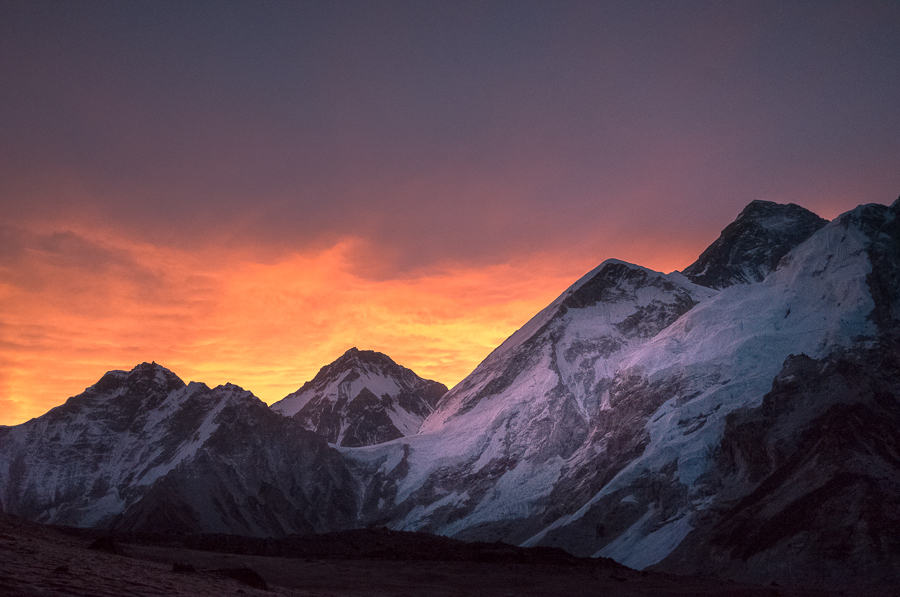
Mt. Everest is the highest mountain in the world and trekking to the base camp is no easy feat either. It’s a journey through some of the most spectacular mountain views but also through a number of beautiful villages along the way. The Everest Base Camp Trek takes anywhere from 9 to 15 days depending on your route and itinerary but also how well you acclimatize.
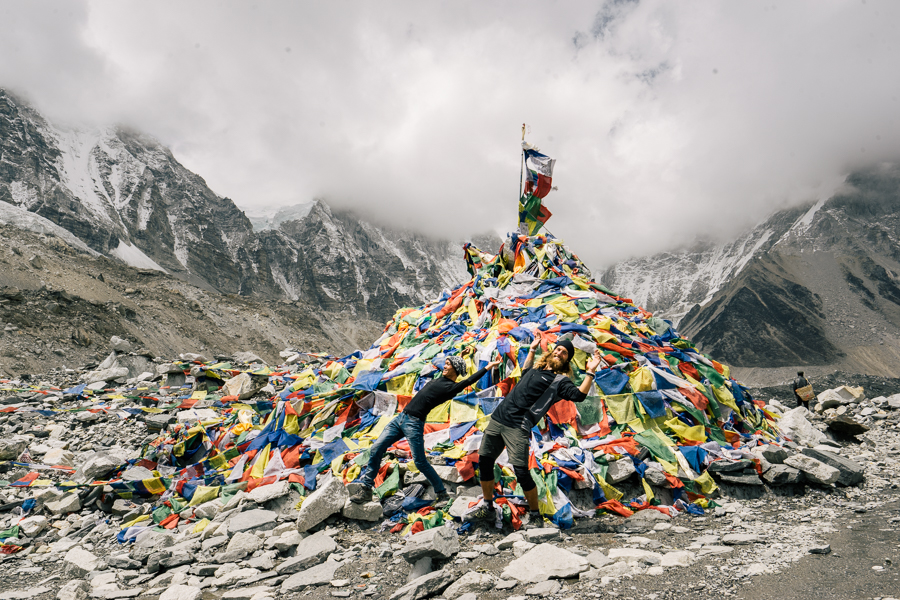
In this article, I will cover everything you need to know about the logistics of the Everest Base Camp (EBC) trek but I will also share with you my experience on each day of the trek. A short journal entry with a vlog from my experiences from each day will give you an idea of what to expect and you can see how the journey went for me. After sharing my experience, I will then include all of the information you need to know in this complete guide about trekking to Everest Base Camp.
BEST TREKKING COMPANY IN NEPAL
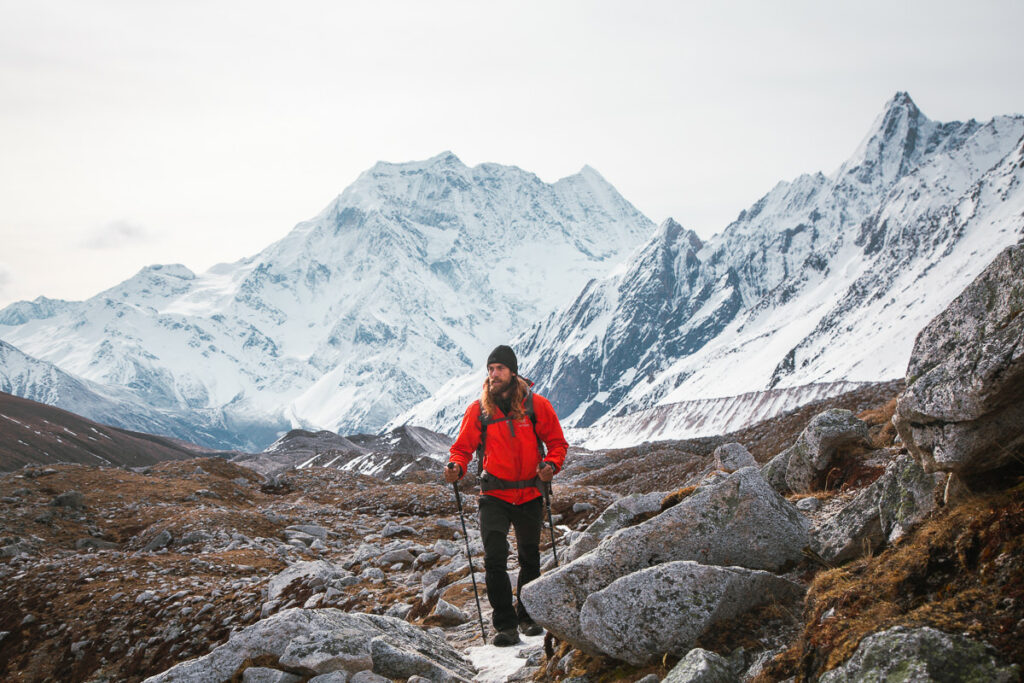
Interested in trekking in Nepal or doing the Everest Base Camp Trek? I recommend booking your trek with Himalayan Masters , which is the company I use for all of my treks in Nepal. Use my code JACKSON5 when you book to receive a 5% DISCOUNT .
Table of Contents
EVEREST BASE CAMP TREK DETAILS
- Distance : 120 km round-trip from Lukla to Base Camp and back to Lukla (You will fly to Lukla from Kathmandu)
- Days required : 12 -14 days
- Total Incline : (Undulation) – 6015 m
- Total Decline :(Undulation) – 5821 m
- The highest point on the trek : 5640 m/18 500 ft, this is actually at Kala Patthar, which you will hike to in the morning after reaching Everest Base Camp. This is where you get the best views of Mount Everest.
- Difficulty : It’s hard for an average hiker but the altitude is definitely more difficult to manage than the distance with several rest days and acclimatization days.
- Permits : Your tour operator will take care of these but in case you do the trek independently it’s good to know that you will pay a Local Government fee and Sagarmatha National Park permit, which totaled together cost about $40-$50
- Cost per day : This will depend on your tour price and whether you do the trek with a group, a porter, a guide, or independently. Somewhere between USD $40 (without flights) $60 per person per day with all meals, transport, and guides included.
- Guide : It isn’t required but highly recommended. You can do the Everest Base Camp Trek in a few different ways such as by yourself with no guide, with an experienced guide or in a group with a guide.
- Accommodation : Guest Houses, also known as Tea Houses along the way where you will sleep in a comfortable bed and have access to showers (extra charge) and restaurant facilities. Very comfortable accommodation and great after a long day of hiking.
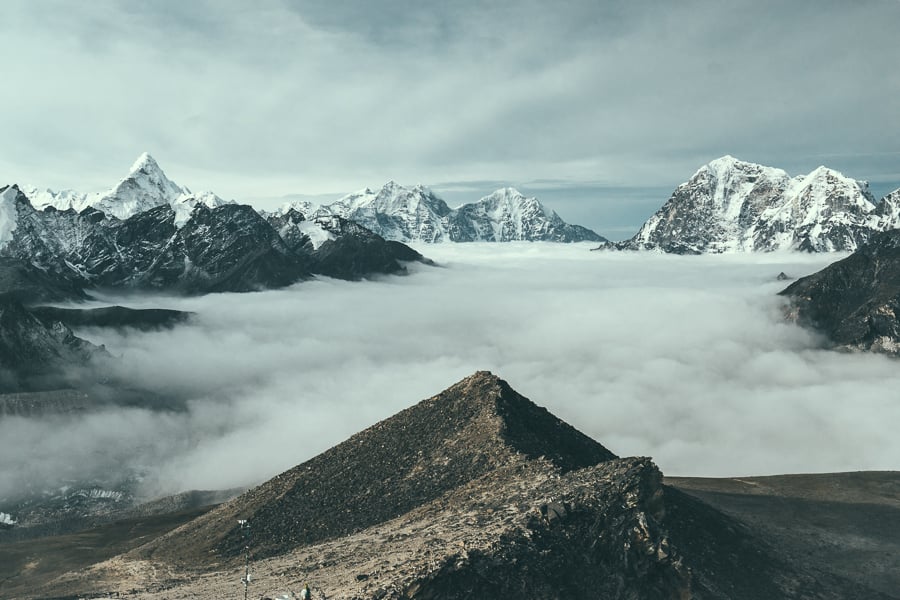
TRY THE 3 BEST TREKS IN NEPAL

Manaslu Circuit : My personal favorite 2-week trek through Tibetan villages and stunning scenery. Less crowded and more authentic.
Annapurna Circuit : The most beautiful & scenic 2-week trek in Nepal although can be crowded at times.
Everest Base Camp Trek : The most iconic 2-week route reaching the famous (EBC) Everest Base Camp at 5,300m.
BOOKING A GUIDE FOR THE EVEREST BASE CAMP TREK
The Everest Base Camp Trek doesn’t require a guide but it’s great to have a guide managing the logistics such as directions, tea-houses, distances, medical issues, and the overall organization. I’d say 90% of trekkers go with a guide. I highly recommend booking with Himalayan Masters which is one of the top trekking companies when it comes to the Everest Base Camp Trek. I’ve trekked many different routes in Nepal with them and I’m a big fan of their attention to detail.
The trek costs around $1500 USD with Himalayan Masters as of 2022 and includes all transfers, accommodation, meals, drinks, permits, and even the hotel stay before and after the trek at a high-quality hotel. I honestly had a great time on this trek and I can wholeheartedly recommend Himalayan Masters.
You can use my discount code ‘ JACKSON5 ‘ for 5% off the total price of your trek with Himalayan Masters which is a pretty handy saving.
Email: [email protected]
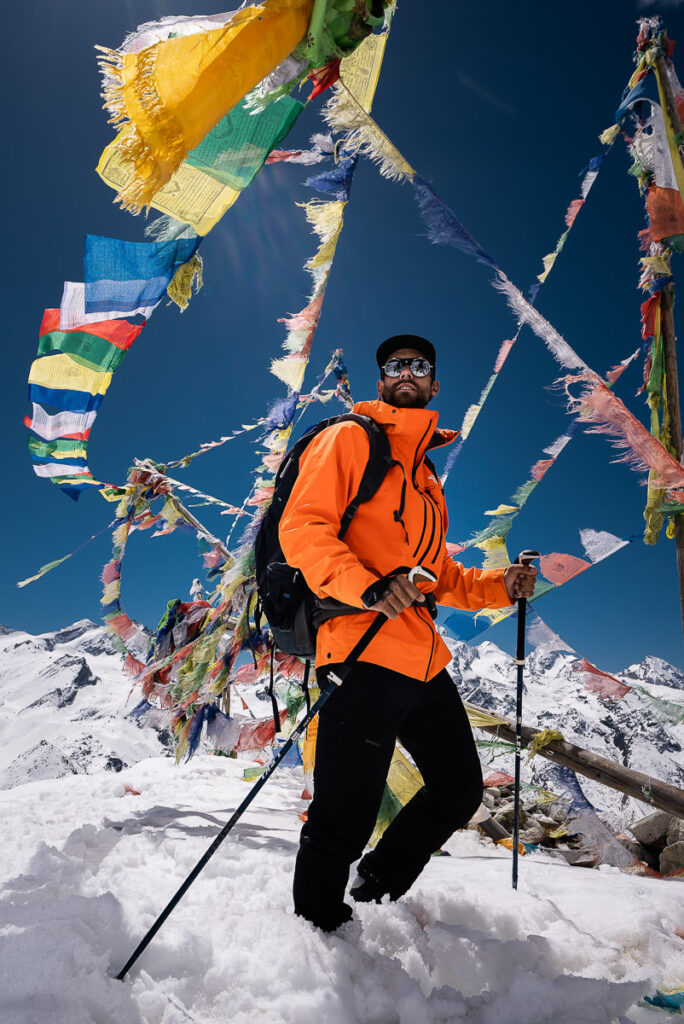
TOP 3 PLACES TO STAY IN KATHMANDU

- Ultimate Luxury: The Dwarika’s Hotel – Luxury, Spa-service, Pool
- Best Value : Aloft Kathmandu Thamel – Swimming Pool, Gym & Great Restuarant
- Budget Choice: Hotel Jampa is easily the top cheap hotel in Kathmandu
MY EXPERIENCE ON THE EVEREST BASE CAMP TREK
I’d like to share with you my experience and photos from my two weeks of trekking to Everest Base Camp. I hope you enjoy recounting the journey as much as I did.
Day One, Two & Three: Kathmandu to Lukla to Phak Ding to Namche
Day one began with an incredible flight from Kathmandu to Lukla. Unfortunately for me, I had come down with food poisoning the night before the trek so it was a rough start for me but I decided to battle on. The flight gives you incredible views of the Himalayas before you touch down at Lukla Airport, one of the most famous and scariest airports in the world. The landing strip is on a downwards slope and gives passengers a heart-in-mouth moment on take-off and landing.
After landing, we had a quick coffee and look around Lukla before making the short and relatively flat trek through the villages and forest to reach Phak Ding. Day one is a short trek but you have made your way up pretty high even just by landing at Lukla Airport so it is not a bad idea to take the first day easy, given that your biggest battle on this trek will be the altitude, not the distance or speed.
Day Two for me was actually a day of recovery in Phak Ding where I spent the entire day sick in the guesthouse. There is usually one day scheduled on your itinerary for sickness or rest day so I had used mine early!
Day three was a tough day as I was still recovering but we made the climb up to Namche, which is a winding climb through the forest and out above the tree line. Namche Bazaar is located at an altitude of 3450m inside the Sagarmatha national park, a UNESCO world heritage site and it is actually known as the last frontier for trekkers and climbers before the trek to Everest Base Camp starts to get serious.
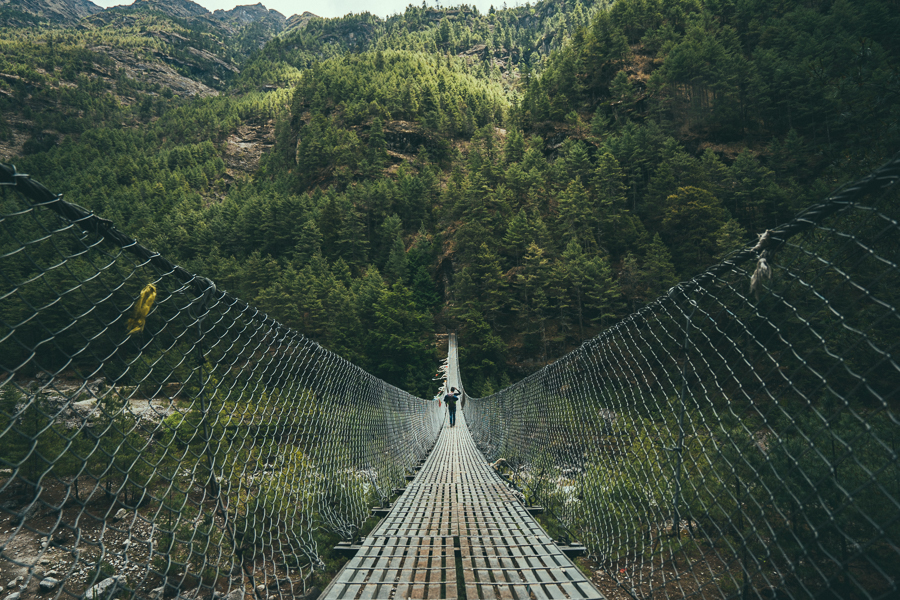
Day Four & Five: Namche to Tengboche to Dingboche
Day four is a big day of climbing. Namche Bazaar is 3,440 meters and Tengboche is 3,860 meters but the constant undulation on the trail means you will climb almost 900 meters of incline throughout the day.
The day begins by following the valley wall as you get some great views of the Everest mountain range out in front. The path then heads down into the valley floor as you lose a lot of elevation. However, you will then cross over the river and gain all the elevation back as you approach Tengboche where you will stay for the night.
Expect to have views of the mighty mountain Ama Dablam as well as Lhotse, Nupste, and even the peak of Mount Everest. Interestingly this will be one of the best views you have of Mount Everest until you reach Kala Patthar in a few days’ time.
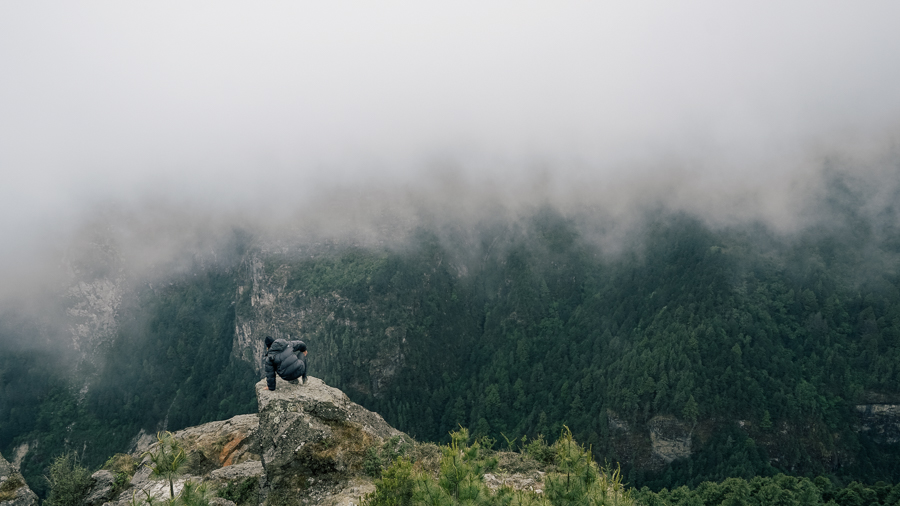
On day five of the Everest Base Camp trek, you say goodbye to the village of Tengboche and head towards Dingboche. It is a stunninng day as you voyage through the valley as the glacier river flows down below while snow-capped peaks loom in the distance. Along the trek, you will stop for tea in the village of Pangboche with lots of views of Ama Dablam mountain .
The elevation gain on day five is 700 meters and the entire journey will take about 5-6 hours at a moderate pace. Dingboche is 4,400 meters above sea level so it’s common to start to have a couple of symptoms of altitude sickness at this stage of the trek.
When you leave Tengboche, you begin a descent into the beautiful forest and can enjoy the shade as you pass through the village of Deboche. After you pass through Deboche, the trail gains some elevation and you will cross a suspension bridge, which guides you to the left side of the valley. Ama Dablam is still in view as you navigate the steep sections of the incline.
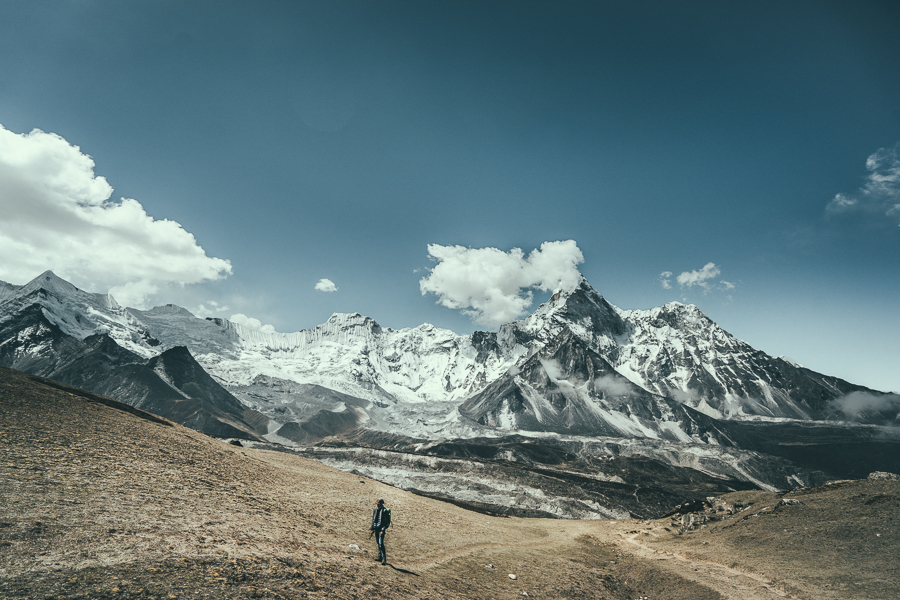
Day Six & Seven: Chuukhung Ri Acclimitization and Dingboche to Lobuche
Day six was an acclimatization day up to Chukhung Ri viewpoint, which was actually one of my favorite days. Because we would stay a second night in Dingboche, we left our bags in the tea house and did the climb up and down Chukhung Ri to help our bodies adjust to the altitude. The idea is to hike high and sleep low, which helps the body adapt.
Chukhung Ri is actually at 5500 meters, which is more than 1000 meters above Dingboche. This is a steep climb and you don’t need to go all the way to the summit. However, with spectacular views, isolation from other hikers, and a good chance to help your body adapt to the altitude, it’s a great day excursion with incredible scenery.
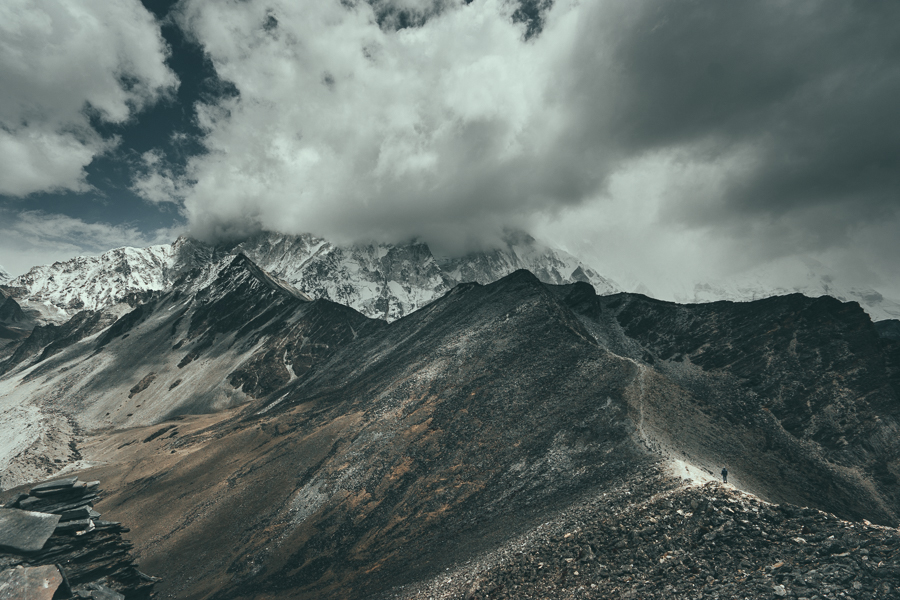
On day seven of the Everest Base Camp trek, we hiked from Dingboche to Lobuche, which is actually the second-highest village on the entire trail. Today is also the first time we will see the Khumba Glacier, which is one of the highlights of the trip.
The total elevation change for day seven is 500 meters in altitude but you will climb 600m in total for the day taking into account a few downhill sections on the trail. It’s a shorter day taking just four hours to reach Lobuche from Dingboche.
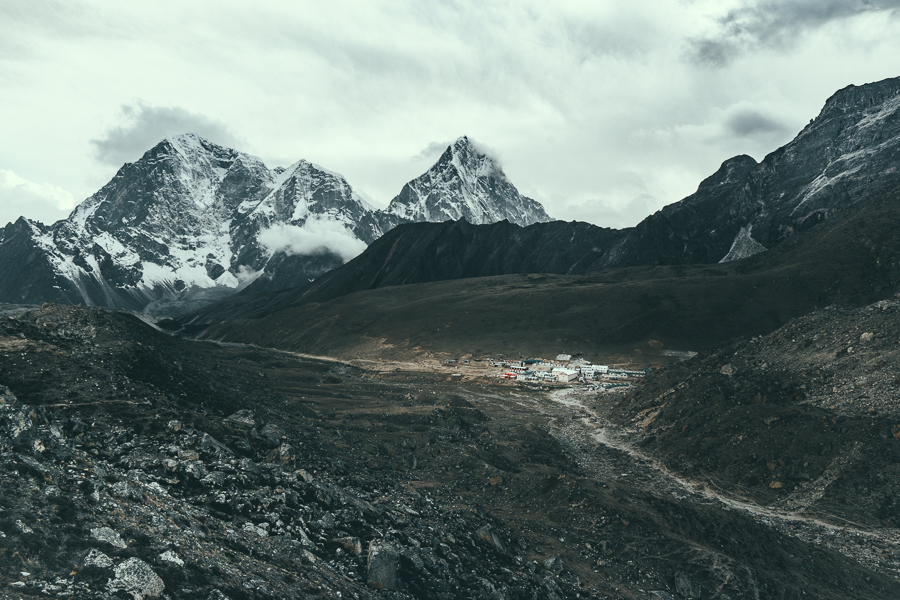
Day Eight: Lobuche to Gorak Shep to Everest Base Camp
On day eight of the Everest Base Camp trek, it is finally time to reach Everest Base Camp. From Lobuche your first trek to Gorak Shep, which is the highest village you sleep at throughout the trek.
Gorak Shep is a small village, and it’s the closest to Everest Base Camp is also the closest village to Everest Base Camp. Basically, you will trek to Gorak Shep, have an early lunch, and drop off your bag before doing the round-trip trek to explore Everest Base Camp. Then you will return to Gorak Shep where you will stay the night before heading to the nearby Kala Patthar in the morning.
The journey from Lobuche to Gorak Shep is along a rocky path, which slowly gains elevation as you walk next to the Khumbu Glacier. From Gorak Shep to Base camp, you will reach an altitude of 5,364m, which won’t be the highest on the trek as you will go higher the next morning at Kala Patthar.
When you leave Gorak Shep you walk next to the Khumbu Glacier with the Everest Mountain Range looming behind. The glacier is covered in dust and rocks due to the sediments, which have been falling from the surrounding peaks over the last years.
The trail continues alongside the glacier until you reach Everest Base Camp. It’s interesting because you actually can’t see Mount Everest from the base camp, which surprised me but the surrounding peaks are still very impressive and dramatic. Depending on if you come during the climbing season or off-season will alter how the base camp looks. I visited in the low season so there were no tents set up and it was pretty barren.
The trail continues past some Sherpa prayer flags as the rocky terrain leads you towards the famous Everest Base Camp rock, which is covered in hundreds of prayer flags. We’ve made it!
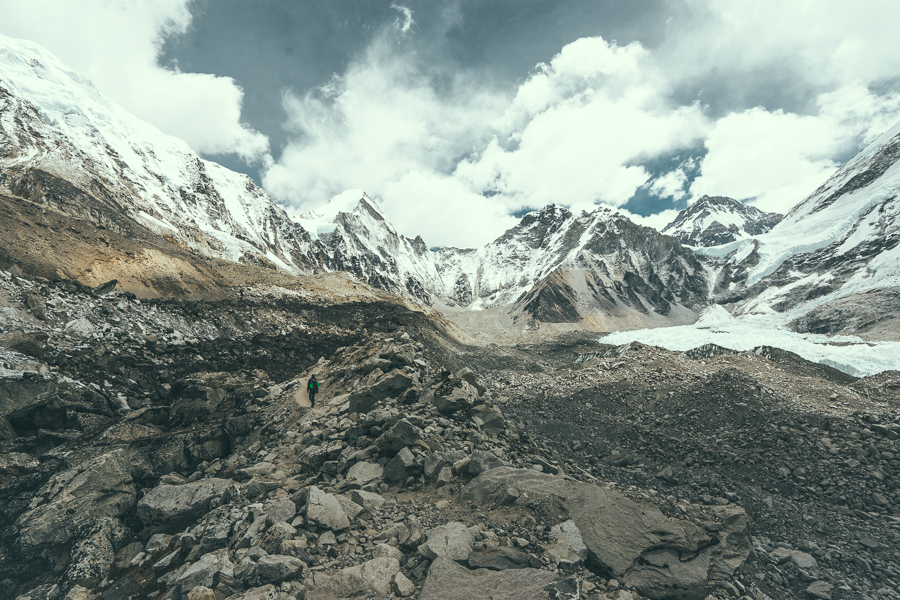
Day Nine: Kala Patthar
The highlight of the Everest Base Camp trek was the climb up to Kalapathar (also spelled out as Kala Patthar). It’s a 5,540-meter peak, which looms over the small village of Gorak Shep where you have just spent the night. It’s worth the freezing wake-up call in the morning as it is one of the best spots in Sagarmatha National Park to take in the views of Mount Everest.
It’s only a 3-kilometer round-trip trek from Gorak Shep with 300 meters of incline but at such high altitude, it can be quite difficult. I suggest starting 1.5-2 hours before sunrise so you are at the summit when the morning glow begins. After enjoying the sunrise with epic views of the cloud-filled valley and Mount Everest, we began the trek back down to Lukla.
It would take us another two days to reach Lukla, which is less than normal but going down is much easier.

Day Ten & Eleven: Heading back down
Heading back down is now at the pace of your choosing. We were keen to get back to Kathmandu so we took just two days to head back down the mountain. With altitude sickness no longer an issue, you can really make some good time.
If you are ahead of schedule you can keep going to the next village as there are no pre-made bookings. Heading down is a great feeling as you have accomplished reaching the base camp and you can now just breathe in the mountain air and enjoy the descent.
EVEREST BASE CAMP TREK: THE ULTIMATE GUIDE
In this section of the blog post, I will share with you the logistics and everything you need to know about trekking to Everest Base Camp.
HOW TO TREK TO EVEREST BASE CAMP
You have a few different options depending on your experience and requirements:
- Book a package through an agency to join a tour group
- Do the trek independently (not with an agency) but still hire a guide and/or porter
- Do the Everest Base Camp Trek entirely independently
If you are alone and don’t want to do the trek independently then it is a great idea to join a group. There are lots of free time and chill moments at the teahouses to play cards and chat with your group.
Doing it entirely independently means you are in charge of all the logistics and it can be quite stressful if you aren’t experienced at managing all flights, maps, costs, negotiations, food, language barriers, first-aid and more.
BOOKING AN EVEREST BASE CAMP TREK IN ADVANCE
These are the most popular routes and are organized by the top tour companies who have a global reputation.
The Everest Base Camp Trek doesn’t require a guide but it’s great to have a guide managing the logistics such as directions, tea-houses, distances, medical issues, and the overall organization. I’d say 90% of trekkers go with a guide.
I highly recommend booking with Himalayan Masters which is one of the top trekking companies when it comes to the Everest Base Camp Trek. I’ve trekked many different routes in Nepal with them and I’m a big fan of their attention to detail.
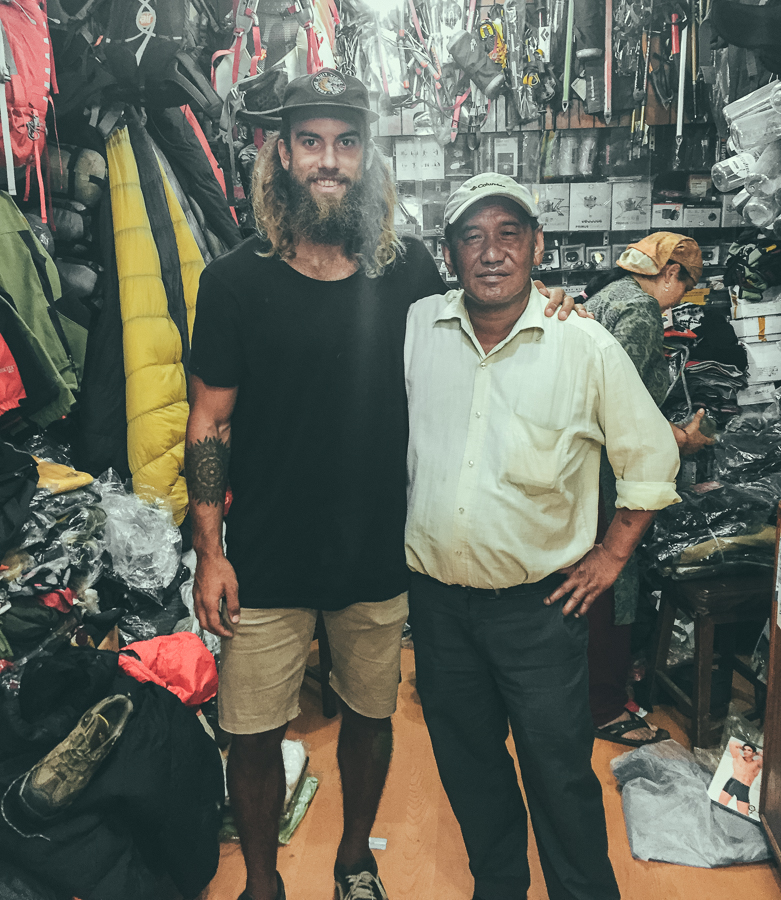
CHOOSING THE RIGHT TOUR AND A GUIDE
Trekking to Everest Base Camp can be done without a guide although I suggest hiring one. Here are 3 reasons why:
- Directions : The route isn’t incredibly hard to follow but there are many twists and turns I would have missed had I not had a guide. The route is available on many maps and map applications but it isn’t a clear trail throughout and some previous experience following a trail in a foreign country would be necessary.
- A guide is relatively cheap to hire : Included in your trekking package will be a qualified guide. However, in your package is also meals, accommodation, flights, etc. The guide him or herself will only cost $10-15 per day.
- When things go wrong : My guide helped me through food poisoning, altitude sickness and was as much a nurse as a guide. I rarely get sick at normal heights but altitude sickness is uncontrollable. I am pretty fit and it still smashed me hard. You can go it alone and be fine but it’s comforting to have a guide there when you come into trouble, especially with altitude sickness. My guide had seen it all before so his calm made me feel better about feeling sick for four days straight.
If you think you will get a guide like the majority of people on the Everest Base Camp, you have a lot of options and things to consider. Pictured below is my guide, Lapsang, who was a legend and someone who became a good friend. When I left Nepal he waited at the bus stop for two hours with me and gave me a Nepali scarf as a gift.
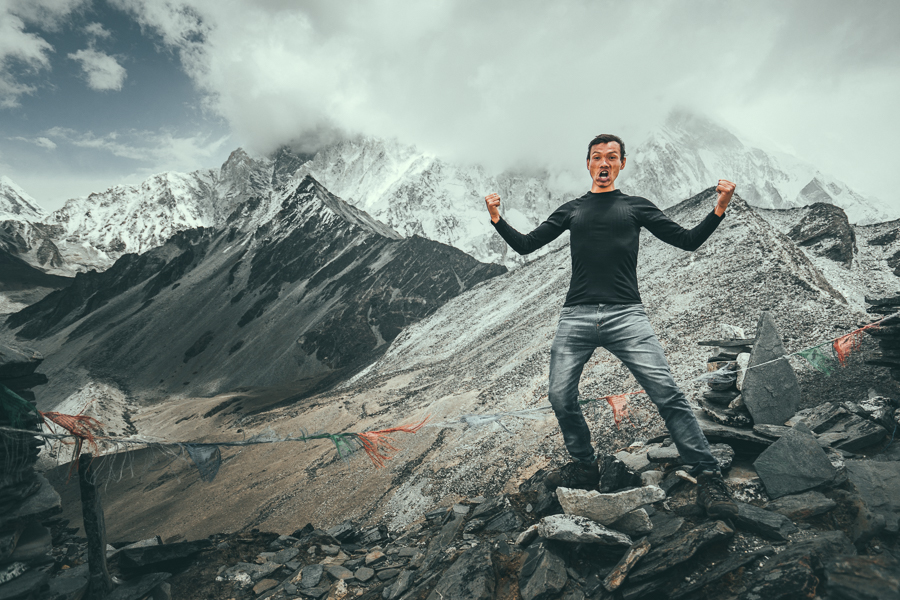
I suggest going with a small group of friends. We saw a few big groups and it looked like a Contiki tour compared to the experience I had with just myself and my guide. Only get a porter if you really need it. You should be able to carry your bag for 4-5 hours of trekking each day.
My guide, Lapsang Tamang, had done the trek multiple times as a porter and now many times a guide. He said he has lost count but somewhere over 20 times, he has been hiking the Everest Base Camp Trek. The best thing to do is to contact my guide and arrange to meet him first in Kathmandu so you can chat and decide if you want to go ahead. You will be together for 12 days after all!
You can directly contact my guide Lapsang by emailing him here: [email protected]
Lapsang is an awesome guy and I had too many chai tea hangouts with him before and after the trip. Lapsang and I became friends during the trip and afterward, we went bungee jumping, cooked Dal Bhat at his apartment, and visited Swayambunath Temple.
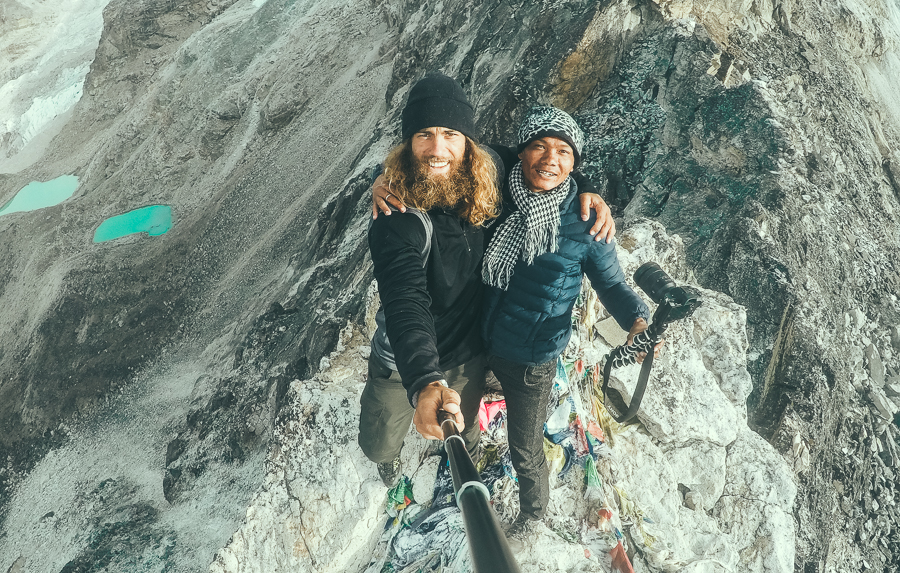
EVEREST BASE CAMP PACKING LIST
I had no winter clothes or even trekking shoes before getting to Kathmandu and bought it all for under $200 brand new (Likely fake North Face). But just as a guide you can get all the gear new for under $200. Bargaining/second hand etc. may help you get it a bit cheaper but this was one time I didn’t want to be so tight with money then freeze my ass off later on top of a mountain.
Keep in mind you won’t be doing any washing. Clothes that dry quickly and are lightweight are key. I showered once… Here is a list of what I took:
- 2 pairs of pants that rip off into shorts ($15 each in Kathmandu) (Super Safari style but actually handy in this situation.)
- 2 long sleeve quick-dry material shirts ($10 each in Kathmandu)
- 5 Pairs of Thermal North Face socks ($2-3 per pair in Kathmandu)
- 1 Fleece pants and sweater. ($25 for top and bottom in Kathmandu)
- 1 Thermal Lycra long sleeve and pants ($20 in Kathmandu)
- 5-6 pairs of quick-dry underwear
- 1 huge waterproof down jacket (Rented for $1 a day in Kathmandu)
- Beanie ($1 in Kathmandu)
- Neck Buff ($2 in Kathmandu)
- Gloves ($5 in Kathmandu)
- Water Purification pills and 1L bottle
- Camera gear and electronics (Not necessary but up to you. Obviously I carried a lot)
All of this should fit into a backpack no bigger than 50L and be less than 15kg. I used my 60L backpacking bag because I didn’t want to buy a new bag for a two-week trek. It worked out fine and weighed about 13kg including all of my lenses, chargers, and power banks.
What are my favorite pieces of trekking gear?
There are six pieces of gear that I simply never forget when I go trekking. These are five items that I using right now and this list gets updated every year! Here are my trekking essentials.
- Arcteryx BETA AR Rain Jacket : This is my go-to rain jacket. It’s super light, folds down into a tiny ball, and protects brilliantly in a storm. This one never leaves my backpack.
- Salomon X Ultra 3 Mid GTX Hiking Boots : For the best ankle support, waterproofing, and durable exterior I’m a fan of tough but light hiking boots like these Salomons for my adventures.
- Black Diamond Head Torch : I can’t tell you how many times, I’ve arrived back from a hike unexpectedly late. I always keep this lightweight but strong headtorch in my bag for the unexpected.
- Darn Tough Socks : These are the most comfortable hiking socks I’ve ever worn and last for years. They also have a lifetime warranty and you just send them in with a hole and they replace it no questions asked.
- Osprey Atmos AG 65L Backpack : I’ve never had a more comfortable 65L pack than this one. I got it in the Navy Blue and have trekked with it through many a mountain.
- Bl ack Diamond Trekking Poles : They might feel weird at first, but on a long trek with incline and decline you’ll begin to love these.
- Grayl GeoPress Water Filter Bottle : I’ve used this for three years. It filters your water with one press and you can drink directly from it. Never buy a plastic water bottle again!
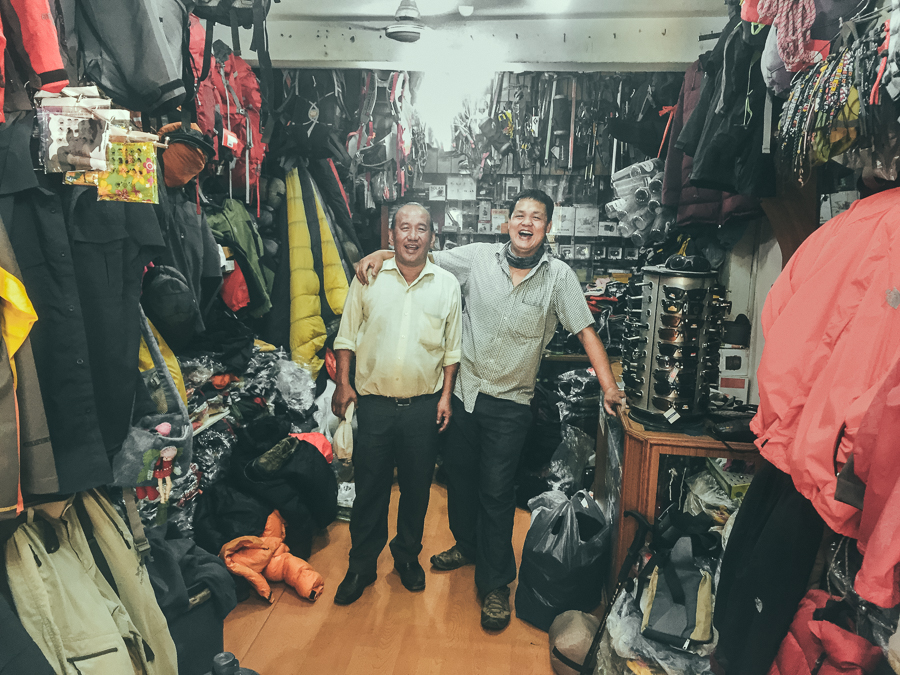
EVEREST BASE CAMP TREK COST
I paid $900 USD for my package all the way back in 2016 but you can expect to pay anywhere from $1400 to $2500 these days.
What’s included in the package for trekking to Everest Base Camp:
- Taxi from Thamel to Kathmandu Airport
- Flights from Kathmandu Airport to Lukla Airport
- Flights from Lukla Airport to Kathmandu Airport (Regular price $320 round trip)
- Breakfast, lunch, and dinner from the guesthouses you are staying at. I could pick anything on the menu, which had western options or Nepali options. You can eat pancakes, pizza, and burgers or you can go for the 24-hr Nepali Power Dal Bhat. I could also choose any hot drink with each meal.
- Your guide throughout the trip.
What’s not included:
- Water. You can buy bottled water like me if you are playing it safe. It is $1 per bottle at a lower elevation and $3 per bottle at the highest elevation. Or lots of people use purification tablets and they seemed to be fine.
- Electricity
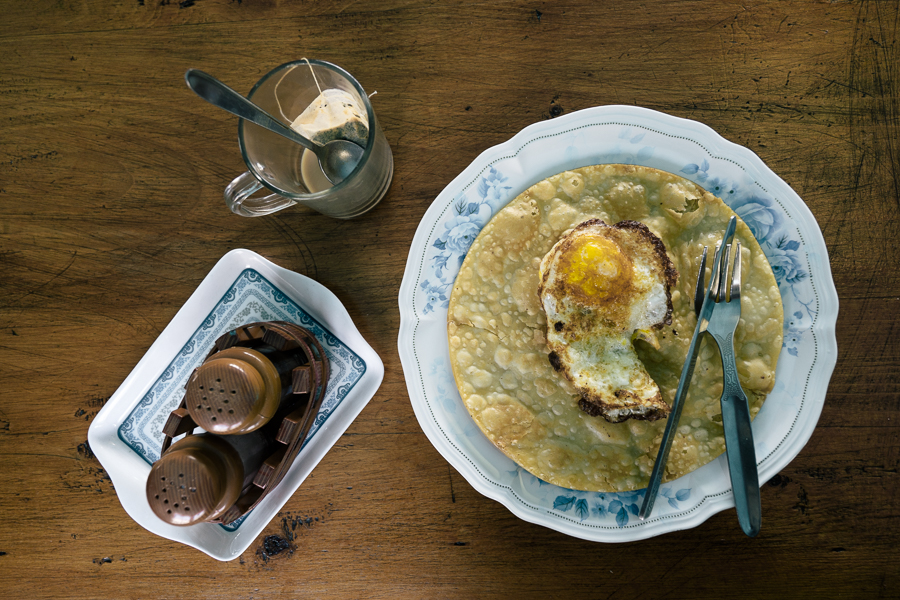
EVEREST BASE CAMP TREK: WIFI/ELECTRICITY AVAILABILITY.
Wifi: Costs anywhere from $3 to $10 to use wifi at the guesthouses. Buy a Ncell Sim before you go. Ncell works at 50% of the guesthouses. Electricity: You will have to pay anywhere from $2 at low elevation to $8 at high elevation to charge your power banks, cameras, and phones. The key is to get a fat power bank. Pay to charge that then charge everything from your power bank. My power bank lets me charge my phone and four camera batteries before it would be done.
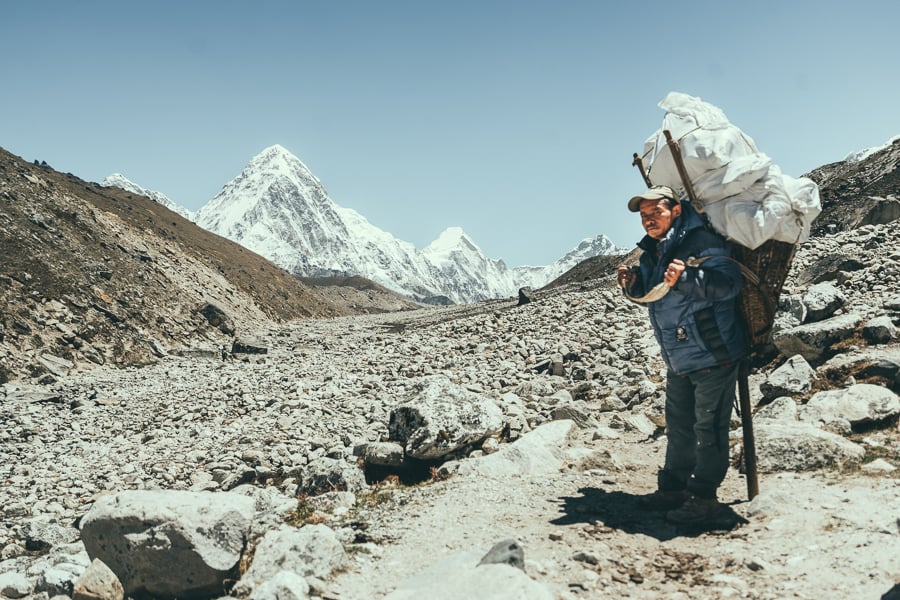
EVEREST BASE CAMP TREK: BEST TIME OF YEAR
This is an interesting question. Do you want snow, reliable weather or to get away from crazy crowds?
February to May – Peak season, clear bright days, very busy trails, lots of people attempting Everest ascent June to August – Monsoon season, no crowds and empty guesthouses September to October – Most stable and clear weather, trails are quite busy November to January – Coldest period, can reach -25, some routes closed
I trekked in the first week of June and was lucky to escape the rain. I didn’t get wet once. Normally it rained in the afternoon or at night if at all but we trekked in the morning and usually only heard the rain as we slept. The trails were open and some days we didn’t even see anyone.
My guide showed me a photo of Namche on a busy morning and I couldn’t believe it. The path looked like the start of a marathon. After seeing that I was so glad to have gone in the off-season.

EVEREST BASE CAMP TREK TEMPERATURE
During June when I trekked it was sunny in the days and I actually wore shorts every day. However as I mentioned above about when the best time to be trekking to Everest Base Camp is, it can get very cold at high elevations during November to January (-20 to-30)
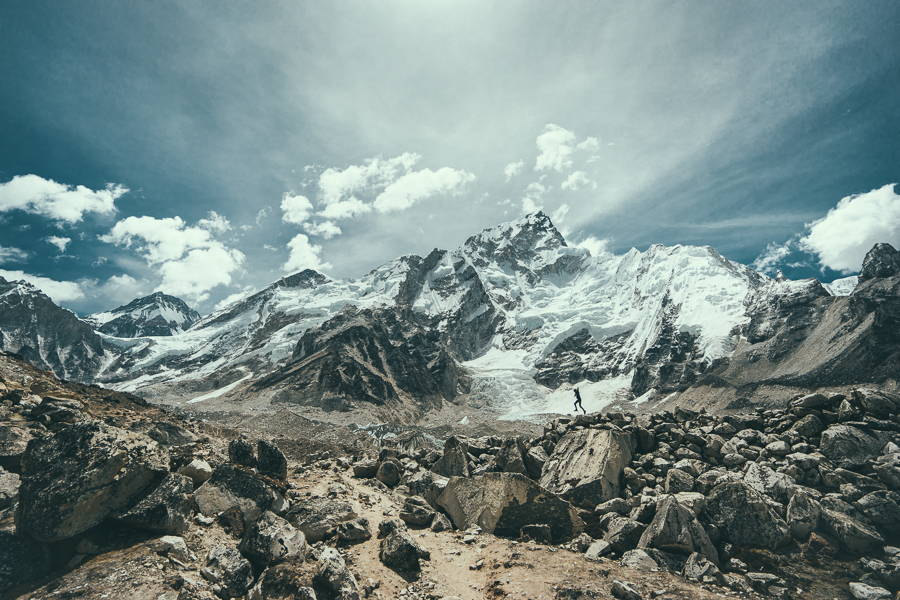
EVEREST BASE CAMP TREK DIFFICULTY
Trekking to Everest Base Camp takes some serious effort. But do you need to be in great shape to complete the journey? The simple answer is NO.
You can go at a slow pace, your own pace, and still make it to Everest Base Camp. In fact, going slow will help you to acclimatize better. I am all about speed but this is not a race. Some days we only trekked for just over three hours but we gained 500m in altitude so we rested for a day and then went again in the morning.
Having said all of that you should be able to walk 10-15 km in a day. Be able to walk up intense inclines for at least an hour. Be able to carry a bag while doing all of this unless you plan to hire a porter.
It’s hard to measure if you are ready. It isn’t like a marathon or anything else you have ever done most probably. I didn’t train at all and was fine. I’m in pretty good shape and played sport my whole life. There were people on the trail who were overweight and going incredibly slow but they were right there with us at base camp to celebrate the achievement.

EVEREST BASE CAMP ALTITUDE
The base camp is 17,600 ft or 5,380m. However, you will probably also trek to Kala Patthar, which looks over the base camp. Kala Patthara is 5,644m high.
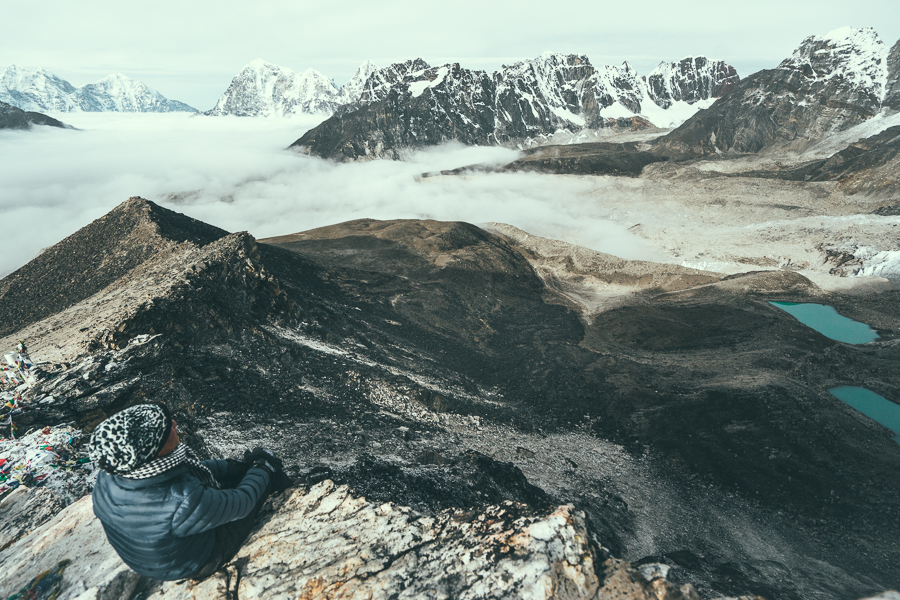
EVEREST BASE CAMP TREK DISTANCE
The distance from Lukla the first town to Everest Base Camp is 38.58 miles or 62 kilometers. Most people take 8-9 days trekking to Everest Base Camp and 3-4 days trekking back to Lukla. It took 8 days to trek to Base camp and two days to trek out.
EVEREST BASE CAMP ITINERARY
Your itinerary will vary depending on your speed and your guide. However, most people follow a somewhat similar trail and timeline. This was my timeline. Note that I spent one extra day in Phak Ding due to sickness. Most people spend that extra day in Namche.
- Day 1. Kathmandu flight to Lukla Lukla to Phak Ding (3-4 hrs)
- Day 2. Phak Ding rest day (sickness)
- Day 3. Phak Ding to Namche (5 hrs)
- Day 4. Namche to Tenboche (4 hrs)
- Day 5. Tenboche to Dinboche (3 hrs)
- Day 6. Dinboche to Chukhung Ri (2.5 hrs) Chukhung Ri back to Dinboche (1.5 hrs) (Acclimatization day)
- Day 7. Dinboche to Lobuche (3 hrs)
- Day 8. Lobuche to Gorak Shep (2 hrs) Gorak Shep to Everest Base Camp (1.5 hrs) Everest Base Camp to Gorak Shep (1.5 hrs)
- Day 9. Gorak Shep to Kala Patthara (2 hrs) Kala Patthara to Gorak Shep (1 hr) Gorak Shep to Tenboche (7hrs)
- Day 10. Tenboche to Lukla (8 hrs)
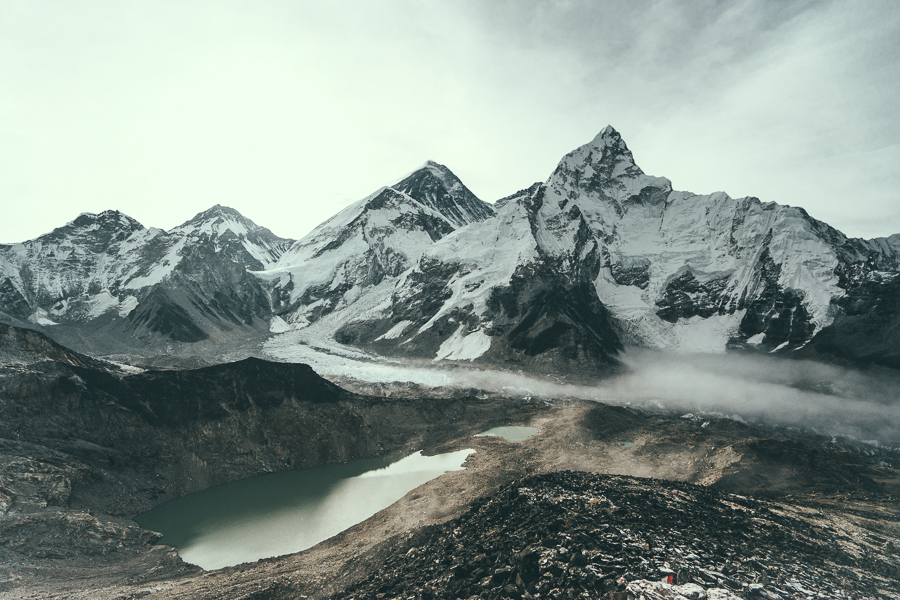
I hope you enjoyed my guide to the Everest Base Camp Trek and you have a great adventure.
HAVE YOU READ MY OTHER NEPAL BLOGS?
I’ve been lucky enough to have many awesome adventures in Nepal, which you can check out below where I’ve listed some of my favorite blog poss from Nepal.
- The Most Iconic route: Everest Base Camp Trek
- The Most Scenic Route: Annapurna Circuit Trek
- My Favorite Trek in Nepal: Manaslu Circuit Trek
- An Easy Nepal Trek: Langtang Valley Trek
- A great beginner peak: Island Peak Climb (6,165m)
- My Favorite Climb in Nepal: Climbing Ama Dablam (6,812m)
- My first 8000er: Climbing Manaslu (8,163m)
- My toughest climb in Nepal: Climbing Makalu (8,463m)
- Where to stay: 16 Best Places to Stay in Kathmandu

Tuesday 31st of October 2023
Sunday 17th of September 2023
So much informative articles which helps people to trek Everest Base Camp Trek
Inge Winkler
Saturday 3rd of June 2023
Hello, thank you for posting all the great infos, this will be very helpful for us. Could you please update me if the requirement of a Professional Guide is in place now or is there a way around it. Thank you so much in advance. Happy Trails, Inge
Sunday 18th of June 2023
I believe you need a guide now to trek anything above 3000m
Monday 21st of November 2022
Thanks for sharing such an adventurous trip experience with us. I read your blog. It feels like I was personally enjoying this trip.
Friday 12th of August 2022
Hi Jackson,
This was a helpful and informative guide. Kudos!
I had a small suggestion: You could have a small sections box right in the beginning and link each sub-section directly to the relevant content below, for ease of navigation!
- Privacy Policy
- Get To Know Me
When Is The Best Time for Your Everest Base Camp Trek: Ultimate Guide

Sharing is caring!
Are you ready to tackle one of the world’s most iconic treks? The journey to Everest Base Camp is a once-in-a-lifetime experience that requires careful planning and preparation. And one of the most crucial decisions you’ll make is choosing the best time of year to go.
Your trekking experience in the Khumbu region of Nepal can vary greatly depending on when you decide to visit. With the right timing, you’ll be rewarded with stunning views, comfortable weather, and a safe and enjoyable trek.
But if you choose the wrong time, you could face difficult trail conditions, poor weather, and crowded trails. That’s why I’ve created the ultimate guide to help you determine the best time for your Everest Base Camp Trek.
So sit back, grab a hot cup of tea, and get ready to plan the adventure of a lifetime!
Table of Contents
What Is the Everest Base Camp Trek?
The Everest Base Camp Trek is one of the most popular and rewarding hikes in the world. This iconic journey takes you to the base of the highest mountain on earth, Mount Everest! This epic journey begins in the town of Lukla, and will take you through breathtaking landscapes, local villages, and stunning high-altitude forests.
The journey typically takes between 10-14 days. During this time, you’ll have the opportunity to experience the culture and hospitality of the local Sherpa people. You’ll be walking approximately 80 miles in total (130km) during your trek, with some days covering more distance than others.

Everest Base Camp Trek Altitude
The Everest Base Camp Trek is one of the best high-altitude treks in the world. Your starting point Lukla is at 2,860 meters (9,383 feet), but from there the altitude only increases. Everest Base Camp is at a shopping altitude of 5,380 meters (17,600 feet.)
The Importance of choosing the right time of year to hike to Everest Base Camp
Choosing the right time of year for the Everest Base Camp Trek is essential for a safe, comfortable, and successful journey. The weather in the mountains can be unpredictable and challenging, and the trail conditions can change significantly depending on the time of year.
Factors such as temperature, precipitation, visibility, snow and ice coverage, and trail difficulty are all important considerations when planning your trek. Additionally, the time of year can greatly impact the crowds on the trail and the availability of accommodations and guides.

Factors to consider when choosing the right time of year
Weather conditions, temperature.
When it comes to temperature, the Himalayas can experience extreme swings from hot to cold. During the spring and fall, temperatures are generally mild and comfortable, making these seasons ideal for trekking.
However, in the winter, temperatures can plummet to well below freezing, making the trail hazardous and challenging. On the other hand, the summer months can bring hot and humid weather, making the trail more difficult for some trekkers, particularly at the lower altitudes at the start of the trek as this tends to be much warmer to begin with.
Precipitation
Precipitation is another important factor to consider when choosing the right time for your Everest Base Camp Trek. During the monsoon season (June-August), the trail can be treacherous due to heavy rain and cloud cover. On the other hand, the dry season (October-May) provides clear skies and better visibility, making it a great time to trek.
The views on the Everest Base Camp Trek are nothing short of spectacular, and choosing the right time of year will help ensure you get the best visibility possible. The clear skies of the dry season provide unobstructed views of the surrounding peaks, while the cloud cover of the monsoon season can obscure views and make navigation more difficult.
Trail conditions
Snow and ice coverage.
The trail to Everest Base Camp can be covered in snow and ice depending on the time of year you travel, which can make the trek more difficult and hazardous. During the spring and fall, snow coverage is generally minimal, making the trail easier and safer. However, in the winter, the trail can be covered in deep snow, making it challenging for even experienced trekkers.
Risk of avalanches
The risk of avalanches is another important factor to consider when choosing the right time for your trek. The snow and ice conditions of the winter months can make the trail more dangerous, while the spring and fall offer less risk.
The difficulty of the trail
The difficulty of the trail can also change depending on the time of year. During the winter, snow and ice conditions can make the trail challenging for even experienced trekkers. On the other hand, spring and fall provide relatively easy trail conditions for most trekkers.

The peak seasons for the Everest Base Camp Trek are the spring (March-May) and the fall (September-November). During these seasons, the trail is at its busiest, and trekkers should expect more crowded trails, some limited accommodation options, and higher prices than at other times.
Off-peak seasons The off-peak seasons (June-August and December-February) are generally quieter, with fewer crowds and more opportunities for solitude. However, trekkers should be prepared for challenging weather conditions and the limited availability of guides and accommodations during these times due to it being off-season.
Budget and availability
The cost of the trek can also vary depending on the time of year. During the peak seasons, prices are generally higher, while the off-peak seasons can offer some more affordable options.
Best times of year for the Everest Base Camp Trek
Everest base camp trek in pre-monsoon season, spring – from march to may:.
If you’re looking for a scenic trek with warmer temperatures and blooming rhododendrons, then spring is the way to go. The visibility can be quite good during this time of year. This is also the time of year that climbers make their summit attempts of Everest. This means that Base Camp is set up to be its own little town. If this sounds exciting, you can even camp overnight at base camp and chat with some of the guides and climbers.
If you did want to hike at a less crowded time of year, you may want to avoid spring. Spring is also the time when the trail is most crowded, so you may have to deal with lines and packed tea houses. Additionally, warmer temperatures can make the visibility hazier in the afternoons.
Everest Base Camp Trek In Post Monsoon Season, Autumn – from September to November:
If you’re looking for a trek with clear skies and less crowded trails than in spring, then autumn is the perfect time for you. You are more likely to be blessed with clear skies during this time of year. I recommend hiking in November. That is when I completed my Everest Base Camp Trek and had clear skies every day! Having amazing views of the spectacular Himalayas every day is what made my trek extra special.
I was also really lucky on Base Camp day itself and had great views of Everest. I’ve known others who have not been so lucky, and on Base Camp day was just surrounded by just thick white cloud meaning no views of Everest.
The weather traditionally begins to improve around October after the monsoon, but the seasons have started to be pushed back and October has not been as blessed with the weather as it once was. Sadly this seems to be the new normal in Nepal, so I would recommend visiting later in the season if you want more luck with the weather.

Autumn can also be a bit on the chilly side, and the trail may have some snow and ice coverage. During the day, the temperatures can be pleasant, particularly at lower altitudes. However, the higher your trek, the colder it becomes. Expect it to get to around -10C at Base Camp. Make sure you back a good down jacket, and a down sleeping bag to keep warm.

Alternative times of the year for the Everest Base Camp Trek
Everest base camp trek in winter – from december to february.
If you’re looking for a quiet and peaceful trek with fewer crowds, then winter is the way to go. The trail is much less crowded during this time, giving you the chance to experience the peace and beauty of the Himalayas in solitude.
On the downside, winter is the coldest time of year, and the trail can be covered in deep snow, making it more challenging and potentially dangerous. Trekkers should be prepared for harsh weather conditions and be prepared for the added difficulty of the trail. As this is off-season, certain tea houses may be closed, and flying to Lukla may not be possible.
Everest Base Camp Trek In Summer – from June to August
Summer is a good time to trek to Everest Base Camp if you’re looking for warm temperatures and long days. Additionally, the trail is less crowded during this time, making it easier to find a quiet spot to enjoy the views.
On the downside, summer is also the monsoon season in the region, which means that there’s a high chance of rain. This can make the trail slippery and muddy, and the visibility can be limited due to the cloud cover. It’s not a lot of fun trekking every day when soaking wet, so this may impact your overall enjoyment of the experience.
Additionally, the monsoon season can bring about flash floods, making the trek more hazardous. Some tea houses and other facilities may be closed due to inclement weather, which can impact your overall experience.

The Best Time For The Everest Base Camp Trek: Summary
The best time to trek to Everest Base Camp is a personal choice that depends on a variety of factors such as your budget, preferred trail conditions, and the type of experience you’re looking for. Whether you choose to trek in the spring, autumn, winter, or summer, each season has its own unique advantages and disadvantages.
So, if you’re looking to take on the challenge of trekking to the base camp of the world’s highest mountain, be sure to consider all of these factors and choose the time of year that works best for you. No matter what time of year you choose, the trek to Everest Base Camp will be a once-in-a-lifetime experience that you’ll never forget!
So, lace up your boots, grab your hiking gear, and prepare to embark on the adventure of a lifetime. Happy trekking!
*Disclaimer: Listen up folks, just a quick heads up before you start clicking away on all the links in this post. Some of them may be affiliate links, which means if you end up buying something, I’ll get a small commission (think of it as a digital high-five for a job well done). But don’t let that sway your decision, I only recommend products that I love and have deemed worthy of your hard-earned cash. Plus, it helps me keep the lights on and the coffee flowing so I can keep bringing you the good stuff. So, go forth and shop with confidence, knowing that your purchase supports a blogger’s caffeine addiction.
Exploring the Great Outdoors: A Beginner’s Guide to Wild Camping
How to get to isla holbox, mexico: finding paradise, leave a comment cancel reply.
Save my name, email, and website in this browser for the next time I comment.
- Visiting Every Country In The World
- Work With Me
- Work with me – looking for a writer and journalist?
This website uses cookies to improve your experience. We'll assume you're ok with this, but you can opt-out if you wish. Accept Read More

We're sorry, your browser does not support some of the features on this website.
Why not try upgrading your browser. Browse Happy
Ian Taylor Trekking PO BOX 5973 Vail Colorado 81658, USA
+1 785 9179436 +353 1 2544011 Email: [email protected]

Latest Blog Posts
20 things you need to know before climbing kilimanjaro, the real cost of climbing kilimanjaro, high altitude trekking tips for success, leave a testimonial.
- [email protected]
- +1 785 9179436
- +353 1 2544011
- +44 20 8123 2876
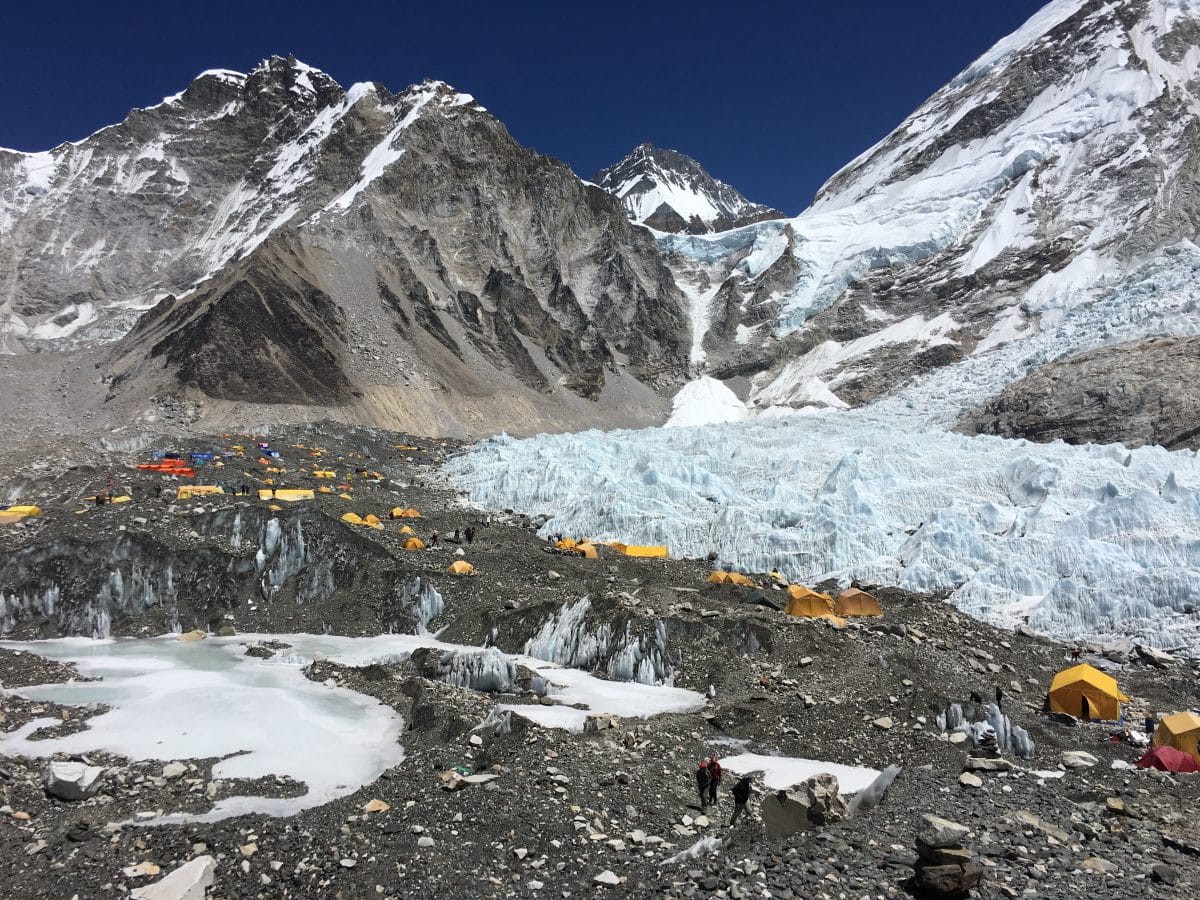
The Best months to Trek to Everest Base Camp
What are the best months of year to trek Everest Base Camp? We have led thousands of people on treks to Everest Base Camp over the last 17 years and have done so in all seasons. The information below is a culmination of what we have learned from doing this trip for over a decade. What time of year you should go to Everest Base Camp will depend on the experience you are looking to have. Check out our upcoming trips .
The Best Months for the Everest Trek
I have climbed to the top of Everest, and also led 40+ treks to Everest Base Camp. Personally, I prefer to trek to Everest in late February, March, late April, late September, October, November and December. Go to our Everest Base Camp Trek page or Sleeping at EBC trek page .
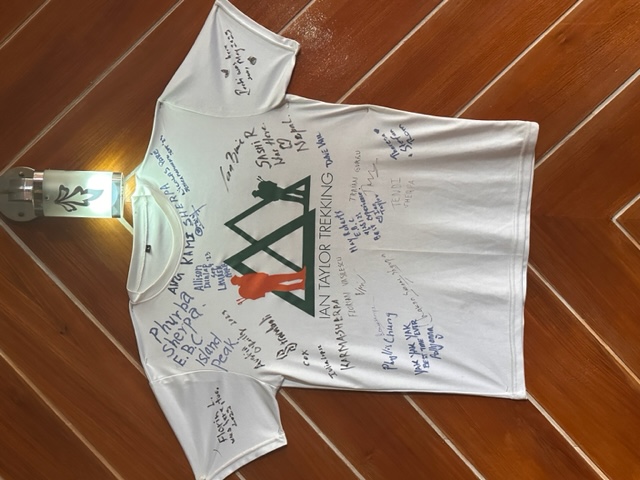
Acclimatization is Everything
The Everest region has it all; sheer beauty, dramatic massive mountains, amazing people, challenging trails and gives you an experience that will stay with you forever. The exciting expansive views will leave you mesmerized. Standing or sleeping at the base camp of the world’s highest mountain requires excellent acclimatization.
If you want to enjoy trekking up to the famous and classic view of Mount Everest from Kala Patthar 5,645m/ 18,520 feet You need more time lower down the trail. If you really want to enjoy going to Everest Base Camp you need 3 nights in Namche Bazaar on the way up and Our itinerary has this built in.

Two Main Trekking Seasons
There are two distinct trekking seasons in the Himalayas; pre-monsoon (February, March, April and May) and post monsoon (late September, October, November and December).
It is possible to make the journey in January and early September. We prefer the above for our treks into Everest base camp. My personal favorites are March, late October and November and December.
You can trek to Everest Base Camp in January and February. It can be cold higher up (-20C/-4F to – 30C/-22F). Snow can fall at anytime of the year in the region. It is more likely during this time and the summer months.
If you are planning on trekking to Everest Base Camp in these months, you are definitely going to need more time for weather delays. Weather conditions can be more challenging in the summer and winter months. Read some REVIEWS .
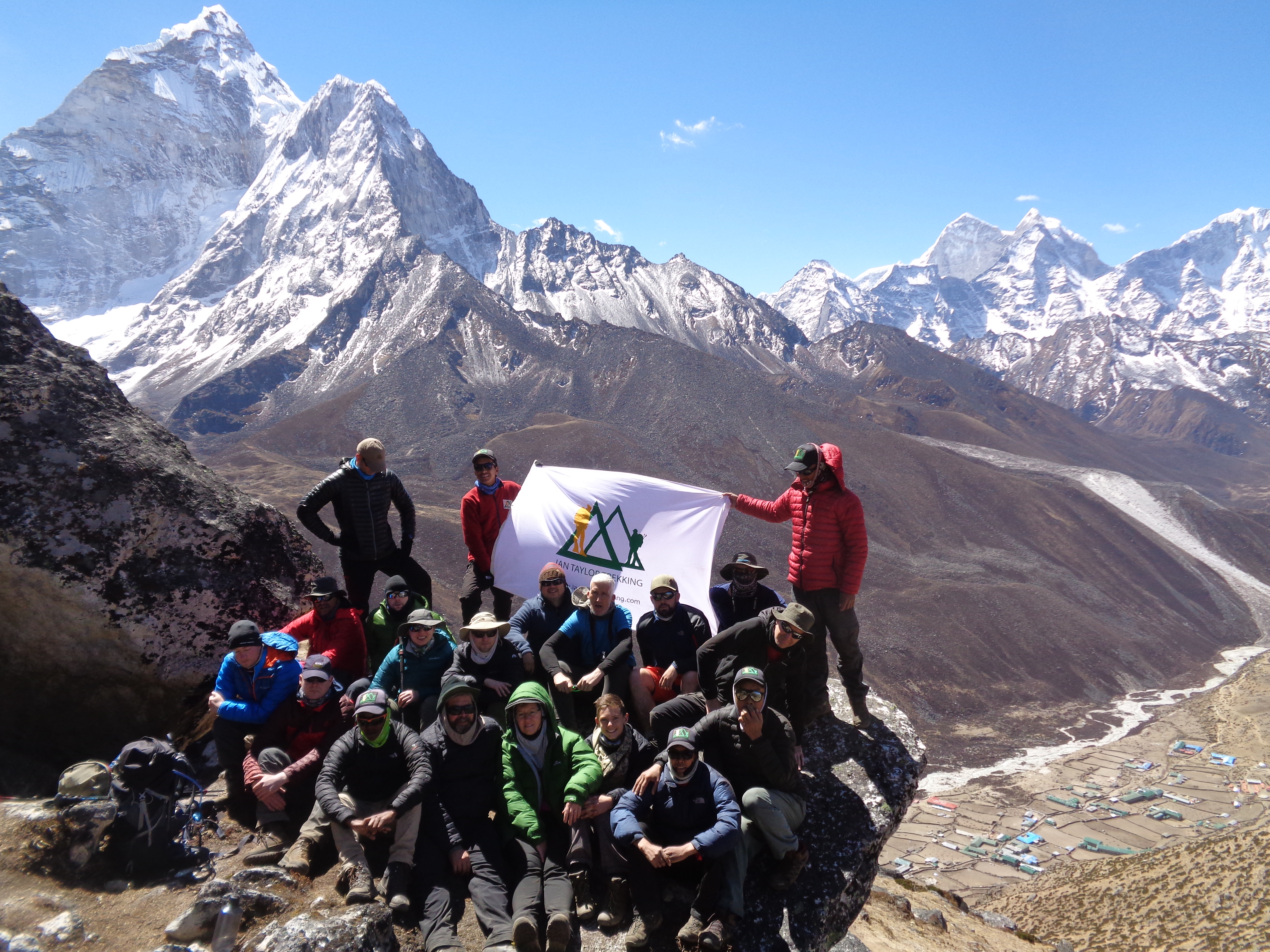
When are Climbers in Base Camp
When planning your trek into the Everest region you need to consider the months listed above and you will also need to consider the function of our trip. Do you want to be there when Base Camp is bustling with climbers, aiming for the summit? Do you want to trek to Mount Everest when there are less people?
Do you want to have clearer skies for good photography? You need to consider this in your planning. We can help you work your way through these decisions. Check out our upcoming trips . Feel free to contact us today.

The main climbing season on Mount Everest is April and May each year. This means that if you want to see Everest Base Camp with all the tents and action, then one of the trips going during the months of March, April or May would be best for you! However, if you are looking to be in Base Camp when it is quiet.
You can experience the beauty of the area with out the hustle and bustle of people and tents, then going in the Post-Monsoon season of September – December might be the better option for you.

Pre-Monsoon
January and February are generally colder months to be in the region. However these can be some of our favorite times to be there! February and March generally have less people on the trail. Colder temperatures usually bring crisper and clearer views along the way, making it a great time to be in the Everest region as long as you are prepared with the correct gear for the cold. Check out our packing video .
April is one of the busier months to be in the region, but there is a reason for that! Generally, the weather is stable and the views are clear, with less heat haze, that can impede mountain viewing.
You will be contending with a lot of other trekkers and climbers in the region in April. Many choose this to be the month they will travel. The trails can also be busy with porters/animals that are maintaining the large number of climbers in Everest Base Camp. This is the time climbers are preparing for their summit attempts.
May is traditionally the warmest month to visit Everest Base Camp. However, sometimes the warmer temperatures can also bring in more clouds, and heat haze, which obstruct your views. During this time in Nepal, the monsoon is moving north from India, bringing warmer temperatures and potentially more cloud cover.
If you are worried about the colder temperatures in the region, then going during May could be the right choice for you. With this said, we can never guarantee the weather in the region and it can change from year to year. While we normally see warmer temperatures in May, we have also seen years where it has snowed on the trail and been quite cold along the way!
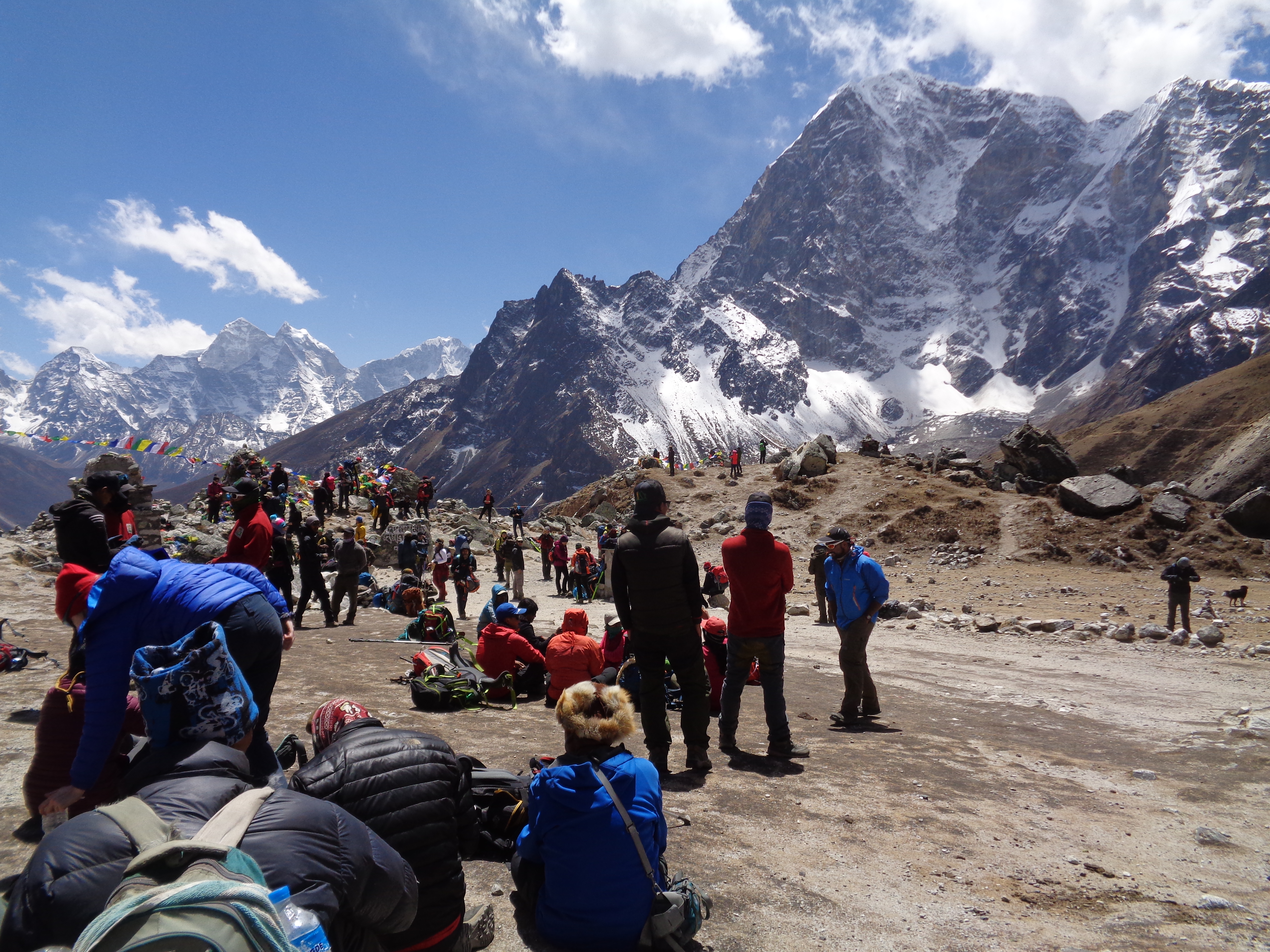
Post-Monsoon
Traditionally, you will find late September, October, November and December will provide better views of the mountains, less heat haze, less cloud cover and overall more consistent and better views of the mountains. This is not always the case but the trend usually follows this pattern.
In September the monsoon can linger a bit, causing there to be more precipitation on the trail. If there are more cloud cover, it can cause more issues with getting in/out of the mountains as well, so having some extra time built into your schedule for these possible delays are important. The temperatures are generally warmer in September and the lush and green landscapes can be quite spectacular in the lower parts of the trail.
Once you move into October, you are going to see one of the busiest months on the trail. The reason it is busier is because this months generally brings clear skies and the temperatures have not yet dropped, making it quite comfortable to trek at this time.
Another one of our favorite times to be in the region is in November, where the crowds start to dissipate and the temperatures are a bit colder, bringing the crisper and clearer views. This weather pattern will go into December as well, however the temperatures can definitely get colder as you head towards the end of the year. Trekking late November into early December is my favorite time to make this journey.

Monsoon Season
Trekking during the monsoon season of June, July and August can be quite challenging in the Himalayas. The biggest challenge is going to be getting in or out of the mountains. There may not be flights in or out of Lukla for days on end.
You could experience torrential rains lower on the trail, making it difficult and challenging terrain to trek in. If possible, we suggest avoiding this time of year as mountain views most likely will be impeded, there is more risk of land-slide and an overall more challenging time to be in the Everest region.

Join Our Award Winning Team
We hope this information on what is the best time of year to trek Everest Base Camp was useful. If you are interested in trekking to Everest Base Camp. Give us a call today . We are happy to answer any questions you may have. We have a full time office in Kathmandu and our team won the International Tourism Award in 2019.
Join the Experts
For more information about training , preparation and making a safe and enjoyable journey to Everest Base Camp feel free to CALL US or keep reading our blogs which have years of experience built into the content.
CLICK HERE for upcoming treks
CLICK HERE and watch our packing video

Related Posts

Everest Base Camp Trek
Trip details.
- Destination: Nepal
- Trip Difficulty: Moderate Strenuous
- Trip Style: Lodge to Lodge Trek
- Transport: Private Vehicle / Aeroplane
- Food: Breakfast + Lunch + Dinner
- Accommodation: Hotel + Teahouses + Lodges
- Group Size: 1-16
- Max Elevation: 5545m Kala Patthar
- Best Months: Feb, Mar, April, May spring Sept, Oct, Nov & Dec falls
- Activity Per Day: Approximately 4-6 hrs walking
- Scenic and thrilling flight to and from Tenzing Hilary airport Lukla (38th highest airport in the world!).
- Trek on one of the most popular Himalayan trails.
- Explore and overnight at various traditional Sherpa villages.
- Visit the oldest and biggest monastery at Tengboche.
- Incredible views of some of the highest mountains in the world such as Mt Everest, Mt Lhotse, Island Peak, Mt Cho Oyu, Mt Nuptse, Mt Ama Dablam, and Mt Pumori.
- Visit and explore around Everest Base Camp.
- See the mighty Khumbu Glacier and Ice Falls up close.
- Witness a stunning sunrise and sunset view from a top Kala Pathhar.
About Everest Base Camp Trek - 14 Days
Everest Base Camp trek is a journey of adventure. This Trek is not a luxury trek but it is a lifetime experience with adventure, Nature, culture, and spirituality. This popular and favorite trek in Nepal is done by many people every year all around the globe. Everest Base Camp Trek is considered one of the best treks in Nepal. Fly to the world’s 38th highest airport in Lukla, visit iconic Sherpa villages such as Namche Bazaar, trek to Everest Base Camp lying at the lap of the world’s highest mountain, and see a breathtaking sunrise view from Kala Patthar and Khumbu glacier. Discover the Everest Base Camp trek of 14 days with Beyond The Limits Treks and Expedition.
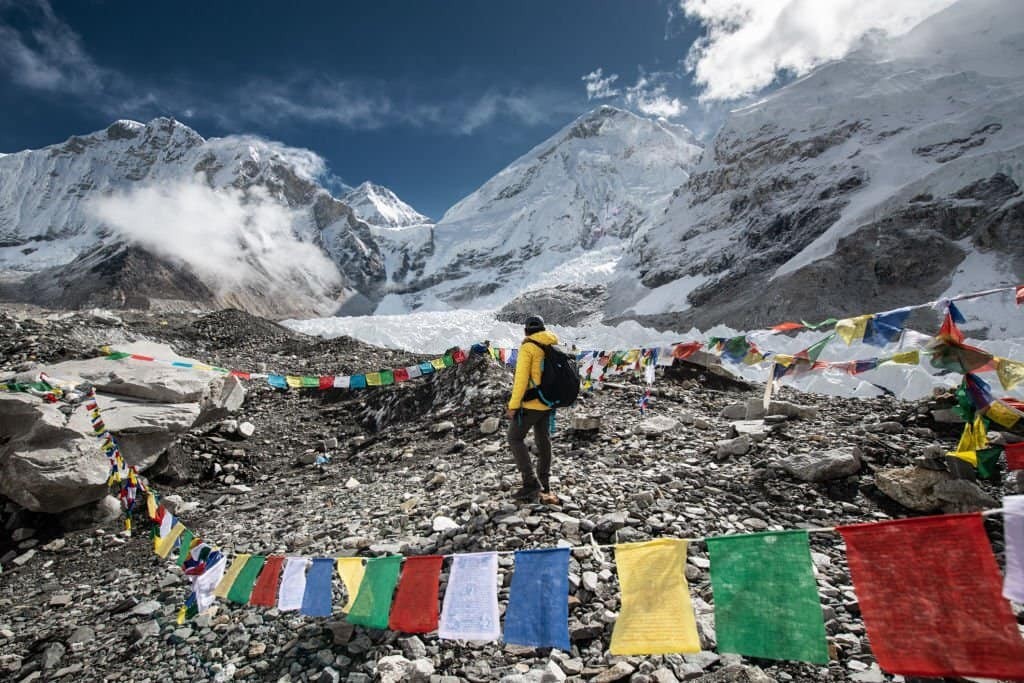
Arrival in Kathmandu
Upon your arrival at the international airport in Kathmandu, a representative of Beyond The Limits Treks and Expedition will be waiting with a Company flash board where written your Name on it, As we respect Nepal, the guest is God. Our representative welcomes you and will transfer you to your booked hotel in Kathmandu. when you check in our Booked Hotel Our Trek Leader will give you a short briefing about the Everest Base Camp trek itinerary and route. The rest of the day is free, Just take a rest. if you like to explore, we do suggest taking a stroll around Thamel. Also known as a trekker’s paradise, Thamel is just filled with restaurants, trekking gear stores, boutique and souvenir shops as well as countless hotels and guesthouses. Spend the night at your hotel and tomorrow we head out for detailed trek preparation in the morning and sightseeing.
After breakfast, we’ll meet up at the hotel and go over all essential gear during the trek to Everest Base Camp. Once we’re all set and done you’ll go on a sightseeing tour in Kathmandu to the Monkey temple, Holy Hindu temple of Pashupatinath. This famous Mandir is dedicated to the head deity Shiva and according to legend is the location of one of the tridents of Shiva. Also a popular burial ground the ancient architecture and its scenic location on both banks of the Bagmati River make this an ideal sightseeing spot. Continue on we head for the giant white Buddhist Stupa of Boudhanath. This enormous round Stupa is an important pilgrimage site for Buddhists and is visited daily by people from around the world. Last up is a stroll around the old palace squares of Kathmandu, locally named Kathmandu’s Durbar Square. While the palaces and temples are ancient and not used the entire area is like a maze of cobbling alleys filled with handicraft shops and markets. A great place to end this sightseeing tour in Kathmandu during your Everest Base Camp trek holiday package.
The Trek to EBC (Everest Base Camp):
We have an early morning flight to catch and head for Lukla. As the world’s 38th highest airport the flight is quite adventurous. Seeing the high hills transform into the Himalayas is just incredible. The landing can get thrilling but it just adds up to the adventure! Landing in Lukla we start at an altitude of 2,860m/9,380ft above sea level. After meeting up with our Beyond the Limits porter team and holding a final gear check we set out on the Everest Base Camp trek!
Our first destination is the village of Phakding at an altitude of 2,610m/8,563ft. Mostly descending we trek through lush forests along the Dudh Koshi River until reaching the suspension bridge leading to the village. This day is perfect to get accustomed to the Himalayan trails. After our first overnight, we have a long day ahead as it’s a straight climb upwards to Namche Bazaar. We need to elevate about +900m/2,953ft in a single day. The trail consists mostly of jungle trails following the Dudh Khosi Khola. At Monjo we have our first permits check post as well as a short break. This marks the entry into the Sagarmatha (Everest) National Park. The feeling just gets surreal and we head further ascending to Namche Bazaar, also known as the biggest Sherpa village in the Everest region!
Namche Bazaar is just amazing. Filled with everything trekkers might dream of it also serves as a last supply post before heading on. We’ll need to stay here a day to properly acclimatize to avoid any chances of getting acute mountain sickness. Beyond the Limits takes you on an acclimatization hike to the Everest View Hotel from where the first views of Mt Everest can be seen! The hike goes up to Syangboche and then down into the Khumjung Valley. We’ll return in the afternoon to Namche Bazaar where we can see the Everest Photo Gallery and the Sherpa Culture Museum. The next day we continue on our trek to Everest Base Camp and head for the region’s oldest and largest Buddhist Monastery in Tengboche (3,867m/12,687ft). The views get better and better with each step and from Tengboche, you’ll get to see those white Himalayas contrasting against the blue sky. Standing at Tengboche Monastery gives a spiritual feeling and we’ll be sure to explore here and see the monks performing their duties, before turning in for the night.
📌 See here for the Everest Base Camp Cost
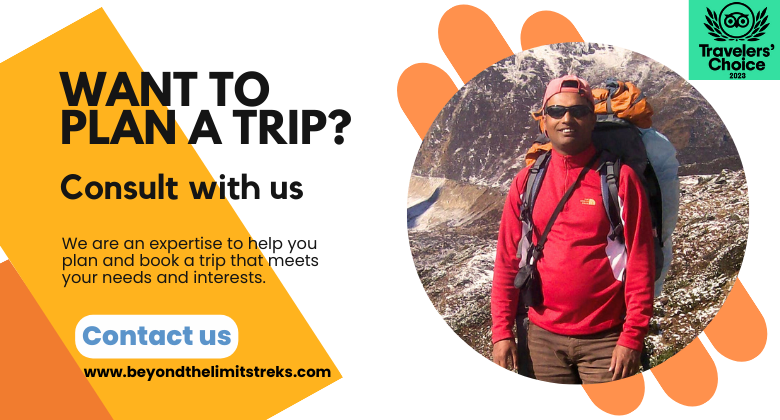
Our next destination during the Everest Base Camp trek is Dingboche at 4,410m/14,470ft. Serving as our second acclimatization destination, we’ll need to head down from Tengboche and cross the Imja Khola River to access the Imja Valley. Dingboche is also the main point for Island Peak Climbers. Views of Mt Everest, Mt Ama Dablam, and Island Peak are the day's main highlights. Having spent our first night in Dingboche we’ll hold our second acclimatization hike up to the Nagarsang Peak with a height of 5,170m/16,962ft. It’s quite the hike but the rewards are just amazing. Incredible views of Mt Lobuche (6,119m/20,076ft), Mt Thamserku (6,623m/21,729ft), Mt Kangtega (6,782m/22,251ft), Mt Ama Dablam (6,812m/22,349ft), Taboche Peak (6,542m/21,463ft), as well as others can be seen from atop Nagarsang Peak! We head back down to Dingboche overnight.
Another day of trekking takes us to Lobuche (4,940m/16,210ft). Serving as a crossroads for trekkers heading to the Gokyo Lakes it makes for the perfect place to overnight, as the next day we’ll be reaching Everest Base Camp! It’s a short trek to Gorakshep (5,164m/16,942ft). Following a part of the Khumbu moraine, we ascend gradually up until reaching the village. After checking in to the local tea house and dropping off heavier gear, we head out for EBC! The trail is quite wide and follows the Khumbu Glacier. The world’s highest and longest glacier. It’ll take about 2 hours to reach Everest Base Camp and the feeling is just incredible. A wave of accomplishment hits once you see the colored tents of the base camp come into view. We spend some time exploring around and making some memorable memories before heading back to Gorakshep. It’s important to get a quick sleep as the next day we hike up to Kala Patthar hill in the early morning.
With our head torches and flashlights, we head out in the morning. It’ll still be dark so we make our way slowly up to the blackish hill just in time to see the sunrise rising Mt Everest and its neighbors. The view is really incredible and breathtaking. Enjoy the moment! After reaching back at Gorakshep and having enjoyed breakfast we’ll be heading back down making our way slowly back to Lukla. We stop at Pheriche, and back at Namche Bazaar for overnights before reaching back at Lukla airport. It is customary to hold a celebration party in Lukla with the team but completely optional. As the next day we fly back to Kathmandu to conclude Beyond the Limits 14 days Everest Base Camp trek.
Book today this incredible trek to Everest Base Camp with Beyond the Limits , and get the Himalayan holiday that you deserve! Never compromising on service Beyond the Limits is your ideal travel partner for any Himalayan adventures!
Everest Base Camp Trek - 14 Days Itinerary
Beyond the Limits Treks offers the Everest Base Camp Trek for 14 Days Package . We also customize the package depending on your time & preferred routes. Contact us if you need customized itineraries.
Day 01 : Arrive at Nepal Transfer to your hotel
• Arrive at Tribhuvan International airport in Kathmandu
• Meet up with our team and transfer to your hotel
• Explore the streets of Thamel aka Trekkers’ Paradise
• Overnight stay at your hotel in Kathmandu
- Hotel Royal Suite Kathmandu
Day 02 : Trek preparation and Free Day in Kathmandu
• Hotel breakfast
• Meet up with your trekking guide at the hotel
• Trek preparation and gear check
• Afternoon Free and easy day.
If you like to do sightseeing tour in Kathmandu
• Visit the Hindu Temple Pashupatinath
• See the mighty Buddhist Stupa Boudhanath
• Explore around Kathmandu’s Durbar (Palace) Square
• Evening dinner with live Nepalese culture show
- Hotel Royal suite Kathmandu
Day 03 : Flight to Lukla Trek to Phakding (2,610m/8,563ft)
• Hotel breakfast + check out
• Transfer to the national airport
• Scenic flight to Lukla
• Meet up with our porter team
• Start the trek to Phakding
• Descend towards the Dudh Khosi River
• Follow the banks of the river
• Cross the suspension bridge to reach Phakding
• Dinner and overnight stay at the lodge/tea house
- Lodge/Tea House
Day 04 : Trek to Namche Bazaar (3,440m/11,286ft)
• Breakfast + start the trek
• Follow the trail through pine forests
• Head for Zam Phute and Tok Tok village
• Ascend to Benkar and cross the bridge to reach Monjo
• Short break + permits check
• Enter the Sagarmatha (Everest) National Park
• Head for Jorsalle
• Continue upwards until reaching Namche Bazaar
• Dinner and overnight stay at the lodge/ tea house
- Guest House
- Namche Bazar
Day 05 : Acclimatization hike around Namche Bazaar & Khumjung
• Breakfast
• Acclimatization hike:
• Hike up to Syangboche’s airstrip
• Continue further to the Everest View Hotel (first views of Mt Everest)
• Visit the Everest Photo Gallery & the Sherpa Culture Museum
• Optional: Hike to Khumjung and Kande Villages
• Return back to Namche Bazaar
Day 06 : Trek to Tengboche (3,867m/12,687ft)
• Head to the highest point of Namche Bazaar
• Continue on towards Kyangjuma
• Trek on through pine forests steeply ascending to Pungki Thanka
• Follow the right side of the Dudh Koshi River
• Ascend further up to Tengboche
• Explore around the region’s oldest and largest monastery
Day 07 : Trek to Dingboche (4,410m/14,470ft)
• Descend down to Deboche village
• Head for the Imja Valley by crossing the Imja Khola River
• Continue on the trail towards Pangboche
• Follow the trail right to Dingboche
• Enjoy the views of Mt Lhotse, Ama Dablam and Island Peak
Day 08 : Acclimatization hike to Nagarsang Peak (5,170m/16,962ft)
• Hike up the Nagarsang Peak
• Enjoy the views of the surrounding Himalayas
• Hike back to Dingboche
• Explore around Dingboche village
Day 09 : Trek to Lobuche (4,940m/16,210ft)
• Follow the trail to Thukla
• Head on rugged paths to Chupki Lhara
• Head up the moraine of the Khumbu Glacier
• Cross the moraine and further to Lobuche
Day 10 : Trek to Gorakshep (5,164m/16,942ft) + Hike to Everest Base Camp (5,364m/17,598ft)
• Make your way up alongside the Khumbu Glacier
• Reach at Gorakshep village and check in to the lodge/ tea house
• Hike further up to Everest Base Camp
• Congrats you made it!
• Enjoy the views and scenes from Everest Base Camp
• Start by hiking back to Gorakshep
Day 11 : Sunrise view at Kala Patthar (5,545m/18,192ft) Trek Pheriche (4,371m/14340ft)
• Early wake up call according the briefing
• Hike up to Kala Patthar hill for a stunning sunrise view
• Head back to Gorakshep for breakfast
• Start to trek following the same route up to Pheriche
• Explore around Pheriche village
Day 12 : Trek back to Namche Bazaar (3,440m/11,286ft)
• Retrace your steps back exiting the Imja Valley
• Pass by Tengboche
• Reach back at Namche Bazaar
- Namche Bazaar
Day 13 : Trek back to Lukla (2,860m/9,350ft)
• Make your way back to Monjo and Phakding
• Ascend up to Lukla
• Check in to the lodge/ tea house
• Optional celebration with the team
Day 14 : Flight back to Kathmandu Transfer to your hotel
• Breakfast + check out
• Fly back to Kathmandu
• Pick up and transfer back to your hotel
• Trip review + evening celebration dinner
• Overnight stay at your hotel as well as ending of the trip
What's Included
- Complimentary pick up from Kathmandu International Airport Terminal 01
- 3-night Hotel in Kathmandu 3 star standard if you like to stay in a Luxury Hotel in Kathmandu please let us know the price can be different price can be applicable)
- Government Registered English speaking Professional a Trekking guide
- Accommodation in Twin Sharing bed basis on trekking trails during trekking
- Daily freshly cooked meals three times a day (Breakfast, Lunch & Dinner) in the mountains
- Everest National Park Permit
- Pasang Lhamu municipality Trekking Card fees
- Trekking maps for Everest Base Camp Trek
- Applicable Domestic Airport tax
- Ground Transportation as per itinerary( note that from the 1st of October to the last of November and 1st of April to last of may Nepal Civil Aviation moved Ramechhap Manthali Airport for Lukla flight due to heavy air traffic, in this care if you like to travel by private car ,it is an extra charge by car cost RS.12000 By Jeep Rs17000, By HAice RS.2600) but sharing Transportation is including in Price
- Your round-trip flight to & from Lukla
- Round trip flight for guide and Assistance guide ( if you have an assistance guide)
- Trekking staff salary, insurance, meals, accommodation, equipment, transportation, etc.
- Emergency rescue service arrangement ( Please do Insurance from your country that covers Medical and Evacuation)
- Drop at the Airport on your departure day
- Sleeping bag on request you have to return after your Trek
- Trekking Map
- Agency service charge and government tax/VAT
- Certificate of achievement
- farewell Dinner
Not Included
- International airfare
- Nepal visa fees
- If you like to Take porter($22 USD per day ( Including salary, insurance,meals, accommodation and equipment)
- All drinks( Hot/cold/Alcoholic on the mountain)
- wifi expenses
- Personal Nature expenses
- Travel Insurance( need to cover Medical and evacuation)
- Nepal Visa Fee( Can be received on your arrival day at Kathmandu Airport. It depends on what type of visa in Nepal , you like to Take)
- If more than the 3-night hotel in Kathmandu
- if you like to Take a sightseeing package for Kathmandu Valley $50 one day with a car and driver
- Meals in Kathmandu
- Hot shower during the trek
- All chargeable batteries, camera
- Extra cost Natural or Political Disturbance which beyond our Control.
- The Extra cost of any case earlyof return from the tour. Anything beyond the included section above or an unforeseen event out of the control or beyond the limits may incur additional charges. Where possible we will negotiate with the client for alternative arrangements.
- Tips for a guide and porters
Dates & Price
Dear Trekkers, We will have Everyday departure on your request or on your Demand and we will have seats available for groups joining Everest Base camp trek, you can look at our departure dates and contact us if you like to join our Group for the trek. If you have your own group and Like to make a private trek feel free to Book with our booking firm
Contact us Email: info[a]beyondthelimitstreks.com
Useful Information
✔ Apply for Online Nepal Tourist Visa: Apply Here
Everest Base Camp trek is fully customizable. Your satisfaction is our top priority. If our standard service falls short of your expectations, we are happy to give you the choice to upgrade your accommodations and services in accordance with your unique needs.
Additionally, if you have created a personalized itinerary that perfectly matches your journey preferences, we greatly appreciate your proact i ve effort and will work to give you the greatest options possible to make the trip better. Let Us Know if you have Brig Group,
You can be confident that Beyond the Limits Treks will provide an outstanding experience as you set out on an exciting adventure through the magnificent Everest Region. Our knowledge, competence, and steadfast dedication ensure that your vacation will be full of long-lasting memories.
Everest Base Camp Trek Map:
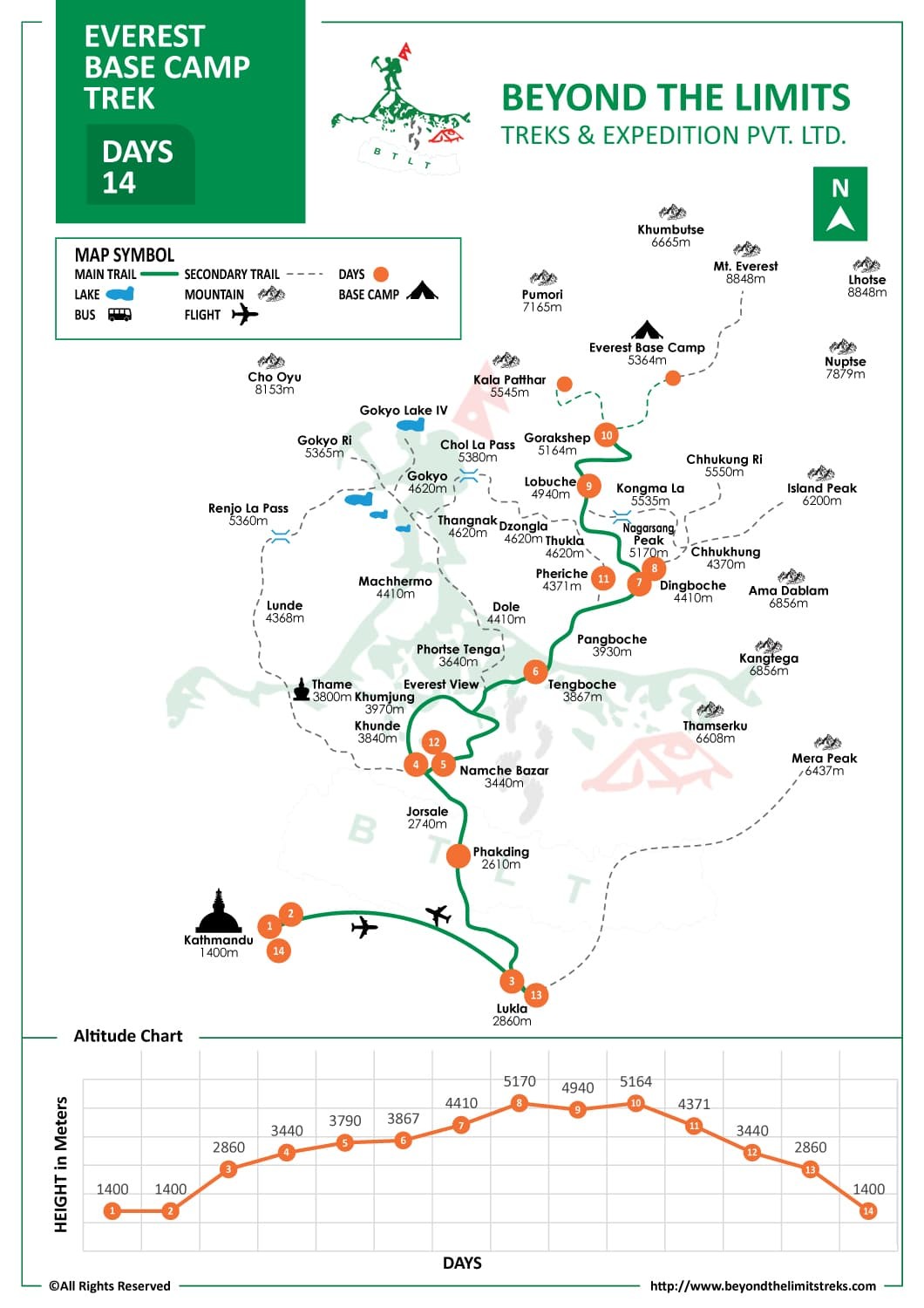
Everest Base Camp Trek Difficulty
Everest Base Camp Trek is a moderate journey in the Himalayas. The trail includes many ascents and descents on steep, rugged, and rocky paths. You will trek for approximately 4 to 7 hours per day. All of these demands sound health, good physical fitness, and strong stamina. You do not need to have prior trekking experience to go on Everest Base Camp Trekking, however, if you do have, it will help you a lot during the trek.
Accommodation and Food
Everest Base Camp Trek is a guest house/ lodge trek. The rooms will be basic with little furniture and clean washrooms. Keep in mind that washrooms will be on sharing basis.
You will get food served as per the menu of the guest house/lodge house. You will find Nepali, Indian, and Tibetan cuisines. Besides that, you can also buy bars and snack items on the trail. Make sure to carry a reusable water bottle with you and refill it every time it gets empty.
Best time to go on Everest Base Camp Trek
Spring (March to early May) and Autumn (September to November) is the best two best time to go on Everest Base Camp Trek.
Please Note : Lukla Flights are departing and returning to Ramechhap Airport instead of Kathmandu from the 1st of April to the end of May and the 1st of October until the end of November due to busy Air Traffic in Kathmandu Airport. It's about a 4-hour drive to Ramechhap from Kathmandu so we will get started for the airport around 2 am. The return drive at the end of the trek is between 4 and 6 hours depending on traffic.
Airfare from Kathmandu to Lukla $217 USD one way so Kathmandu Lukla Kathmandu $434
Airfare Ramechhap Manthali $177 one way total Airfare Ramechhap Lukla Ramechhap $354
Related Trips:
- 12 Days Everest Base Camp Bed and Breakfast
Gokyo Ri Trekking
- Everest Panorama Trek
- Three Pass Trek in Everest
Everest Circuit via Chola Pass
Related packages.
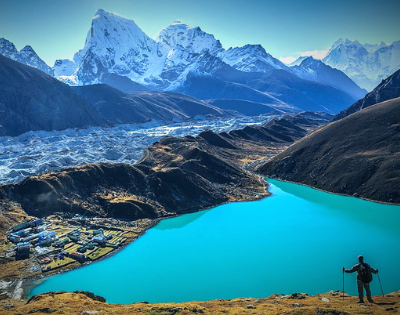
Everest three pass trek
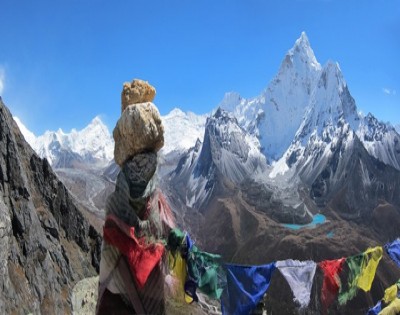
WE ARE ASSOCIATED WITH

Trek To The Clouds

The Best Time to Visit Everest Base Camp: Climb to New Heights
If you’re an adventurous soul with a passion for trekking, then there’s no better place to test your limits than the world-renowned Everest Base Camp. Located at an altitude of 5,364 meters, it’s a challenging climb that offers breathtaking views and unforgettable experiences. But when is the best time to visit Everest Base Camp? The answer to that question can make all the difference in your journey. With unpredictable weather and treacherous terrain, it’s essential to plan your trip carefully.
In this article, we’ll explore the best time to visit Everest Base Camp and the factors you need to consider before embarking on this epic adventure. Whether you’re a seasoned trekker or a first-time visitor, our expert insights will help you climb to new heights and make the most of your Everest Base Camp experience. So, get ready to pack your bags, lace up your boots, and embark on a journey of a lifetime!
Table of Contents
Weather and Climatic Conditions at Everest Base Camp
Before we dive into the best time to visit Everest Base Camp, it’s essential to understand the weather and climatic conditions at this altitude. The weather can be highly unpredictable, and conditions can change rapidly, making it challenging to predict the best time to visit. However, there are certain trends that can help you decide when to plan your trek.

The best time to visit Everest Base Camp is during the spring and autumn seasons. From March to May, the temperatures are relatively mild, and the skies are clear, making it the perfect time to enjoy the stunning views of the Himalayas. The spring season also brings with it the blossoming of rhododendrons , which are scattered throughout the trekking route, adding a touch of color to the landscape.
Similarly, from September to November, the autumn season offers excellent weather conditions, with mild temperatures and clear skies. The autumn season is also the busiest time of year, with the most significant number of trekkers. The trekking route is crowded, and the lodges along the way can be full, so it’s essential to book well in advance.
Off-Season Trekking at Everest Base Camp
If you’re looking for a more secluded and peaceful trekking experience, then visiting Everest Base Camp during the off-season might be the right choice for you. The off-season months are from December to February and June to August . During the winter months, the temperatures drop significantly, making it challenging to trek. The trekking route can be covered in snow, and the lodges may not be operational. However, if you’re an experienced trekker and looking for a new challenge, then winter trekking can be a memorable experience.

Similarly, trekking during the monsoon season from June to August can be a unique experience. The landscapes are lush and green, and the mountain views are spectacular. However, trekking during the monsoon season can be challenging due to the heavy rainfall, which can cause landslides and floods. It’s essential to check the weather forecast and plan your trek carefully if you choose to visit during the off-season.
Also, read the Everest Base Camp trek in July .
Peak Season Trekking at Everest Base Camp
As mentioned earlier, the best time to visit Everest Base Camp is during the spring and autumn seasons. However, it’s also the busiest time of the year, with the most significant number of trekkers. The peak season brings with it a flurry of activity, and the trekking route can be crowded. The lodges along the way can be full, and it’s essential to book well in advance.
Despite the crowds, peak-season trekking has its advantages. The weather conditions are excellent, and the skies are clear, providing stunning views of the Himalayas. Trekking during the peak season also means that you’ll meet more fellow trekkers, making it a social and fun experience.

Pros and Cons of Trekking during Peak Season and Off-Season
Trekking during the peak season and off-season both have their pros and cons. Peak-season trekking offers excellent weather conditions and a bustling trekking route, but the lodges can be full, and the trekking route can be crowded. Off-season trekking, on the other hand, offers a more peaceful and secluded trekking experience, but the weather conditions can be unpredictable, and the trekking route can be challenging to navigate.
It’s essential to choose the right time to visit Everest Base Camp, depending on your trekking experience, fitness level, and preferences. It’s also crucial to plan your trek carefully, regardless of the season you choose to visit. Proper planning can ensure that you have a safe and enjoyable trekking experience.
Preparing for the Everest Base Camp Trek
Trekking to Everest Base Camp is a challenging and demanding journey that requires careful preparation. Proper preparation can help you tackle the challenges of trekking at high altitudes and ensure that you have a safe and enjoyable experience.
Essential Gear and Equipment for Trekking
One of the most critical aspects of preparing for the Everest Base Camp trek is ensuring that you have the right gear and equipment. Proper gear can help you stay warm, dry, and comfortable during your trek. Some essential gear includes warm clothing, a sleeping bag, a sturdy backpack, trekking poles, and a good pair of trekking boots. It’s also essential to carry a first-aid kit, water purification tablets, and snacks. read more about Everest Base Camp Trek Packing List .

Physical and Mental Preparation for Trekking at High Altitude
Trekking to Everest Base Camp involves trekking at high altitudes, which can be physically and mentally demanding. It’s essential to prepare your body and mind for the challenges of trekking. Physical preparation can include regular exercise, cardiovascular training, and strength training. Mental preparation can include meditation, visualization, and mental toughness training.
Conclusion and Final Thoughts
In conclusion, the best time to visit Everest Base Camp is during the spring and autumn seasons. However, trekking during the peak season and off-season both have their advantages and disadvantages. It’s essential to choose the right time to visit based on your trekking experience, fitness level, and preferences. Proper preparation can ensure that you have a safe and enjoyable trekking experience. So, pack your bags, lace up your boots, and embark on a journey of a lifetime to the world-renowned Everest Base Camp!
You may also like...

Acquiring a Trekking Permit in Nepal: A Brief Guide

Unlock the Mysteries of Upper Mustang: The Best Time to Visit

Best Time for Manaslu Trek: The Seasonal Guide

5 Reasons Why Everest Base Camp Trek Should Be On Your Bucket List
- Our Reviews

International:
- +1.775.833.9700
North America:
- 1.800.231.1919
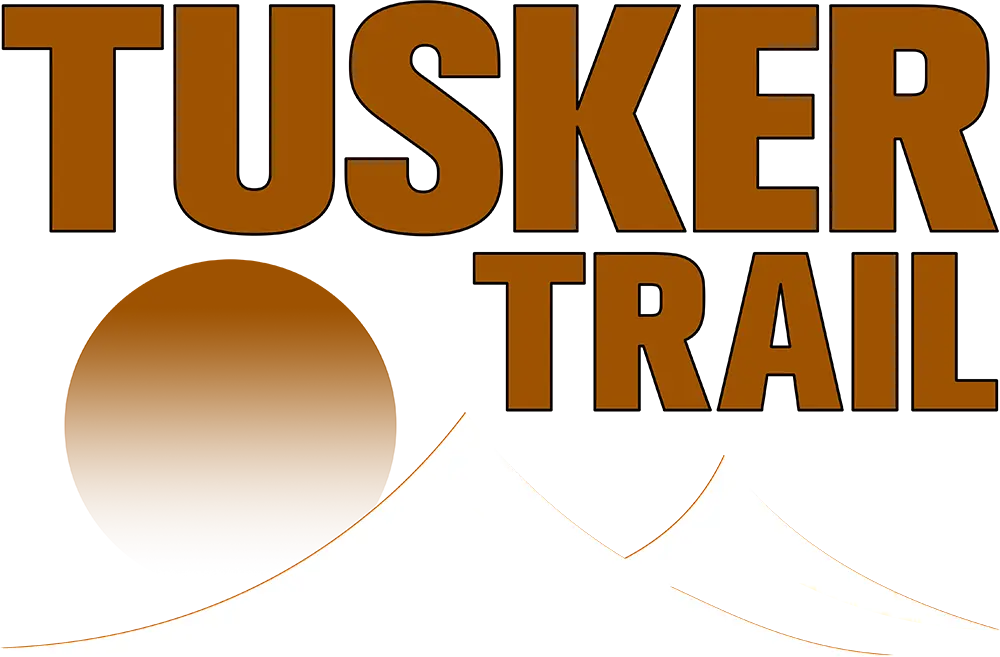
- Breathing & Acclimatizing on Kilimanjaro
- Dates & Prices
- Tusker Blog
- Patagonia Trek
Let’s be honest; you’ll probably also want a few months to prepare mentally and physically for the journey. This unforgettable 18-day trek from Nepal to Everest Base Camp spans 81 miles (or 130 km) and calls for three- to nine-hour hikes each day. So to say you’ll need to get used to extended hikes to accomplish this goal is an understatement.
Truthfully, the best time to visit Everest Base Camp is when it makes the most sense for you, which is exactly what we’re going to help you uncover in this guide.
You want to enjoy this experience to the fullest, and the time of year plays a big role in what you’re hoping to get out of your trek.
So What Is The Best Time Of Year To Trek Everest Base Camp?
As the world’s largest mountain range, the Himalayas experience a wide range of weather conditions throughout the calendar year. So timing is key when it comes to trekking to Everest Base Camp.
While heavily snow-covered mountains are a given during the winter months, unrelenting monsoons dominate the summer season. In this sense, the weather dictates when it’s best to visit Everest Base Camp at first glance.
This is why the fall and spring seasons have become so popular with adventurers.
Between the extreme conditions of winter and summer, autumn and spring on the mountainside are characterized by warm, dry weather conditions that make for comfortable trekking and picture-perfect snapshots.
The snow is either gone or hasn’t arrived yet, which is another reason why these two seasons are the best times to go to Everest Base Camp.
Now when it comes to which month is best for an Everest Base Camp trek, October and November consistently rank high in the top months, along with March and April. But that doesn’t mean these months are right for everyone.
Each season offers something unique, and the weather isn’t the only consideration to weigh when determining the best time to trek Everest Base Camp for you .
So let’s take a peek at what you may experience during the fall and spring seasons and see if you get any closer to feeling a specific one calling to your spirit.
The Fall Season at Everest Base Camp: Everything You Need to Know
The autumn or fall season at Everest Base Camp includes the months of September, October, and November. Here’s a rundown of what you can expect from a trek at this time:
Pro: Stunning Mountain Views and Natural Tranquility
The summer monsoons fill the rivers across an Everest Base Camp trek with the peaceful melody of babbling brooks and crashing waves, creating the perfect relaxing soundtrack for an autumn hike.
Thanks to the subsiding summer rains, trail dust is also much lower in the fall, making the season outstanding for hikers who experience discomfort on dustier trails.
As the clouds make their departure, you’ll be rewarded with crisp, clear, and stunning views of the mountains. The skies will open up to panoramas that feel straight out of a postcard, not reality.
These ideal weather conditions are also wonderful for bird watching. Migrating birds will be making their own trek back to Africa and lower elevations before winter sets in. And you’ll hear their songs and watch them soar by as you make your own trek up and back again.
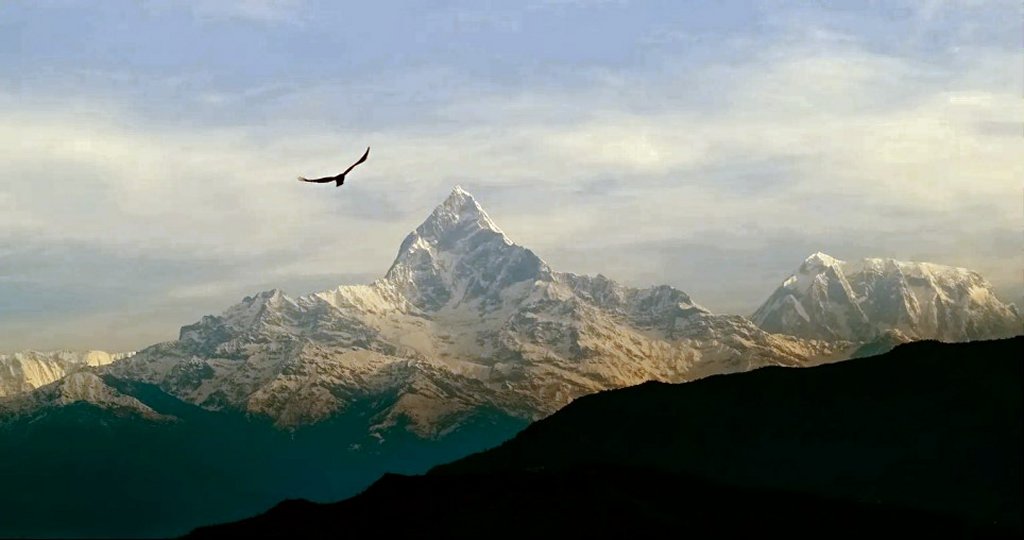
Pro: More Opportunities for Cultural Enrichment
The rich cultural communities in the surrounding area come to life with Fall Harvest Festivals.
You’ll get to experience the beauty of small towns lit up in celebrations en route to Everest Base Camp. There’s also a good chance you’ll mingle with Buddhist monks and Sherpas traveling from all over to celebrate these special occasions.
Con: More Crowds
Because of all the benefits we just highlighted, fall is considered the peak or busy season at Everest Base Camp. So those perks also become the biggest drawbacks to hiking during this time.
You’ll have to deal with much more crowded conditions during the fall season than in the spring.
If you’re hoping for social connections or traveling solo, you may enjoy meeting like-minded trekkers and delighting in their travel logs. Just be prepared to wait a bit longer for prime photo ops and make sure you’re comfortable with a few extra voices and personalities on the road with you.
However, if crowds aren’t your thing — and we don’t blame you there — spring may be a better fit for you.
The Spring Season at Everest Base Camp: Everything You Need to Know
Though October and November are the top two months for people trekking Everest Base Camp, that doesn’t mean fall automatically claims the crown for the best option.
The spring trekking season runs through March, April, and May, and it’s an extraordinary time to hike Everest Base Camp because:
Pro: You’ll Get To Witness Spring’s Rebirth As It Blooms All Around You
Hikers who choose to trek in the fall won’t get to experience the splendor of the Everest region coming back to life after a cold winter’s rest.
But if you trek during this time, you’ll have a first-hand perspective of native animals resurfacing from their cozy winter hideaways. Sharing the trail with these locals and their newborns will make it feel as if you’ve jumped into a vivid storybook or nature documentary.
You’ll also see plants emerging from the earth to begin their fresh first blooms of the season, which makes for idyllic photos you’ll treasure forever. These flowers, trees, and shrubs may be completely different from what you’re used to, and the wildlife they attract may be equally diverse and exciting.
Take a cue from nature and use your time at Everest Base Camp in the spring to start a fresh new chapter of your life — or write a new book entirely. You’ll gain a deeper perspective on life and start seeing the wondrous beauty in everything after an experience like this.
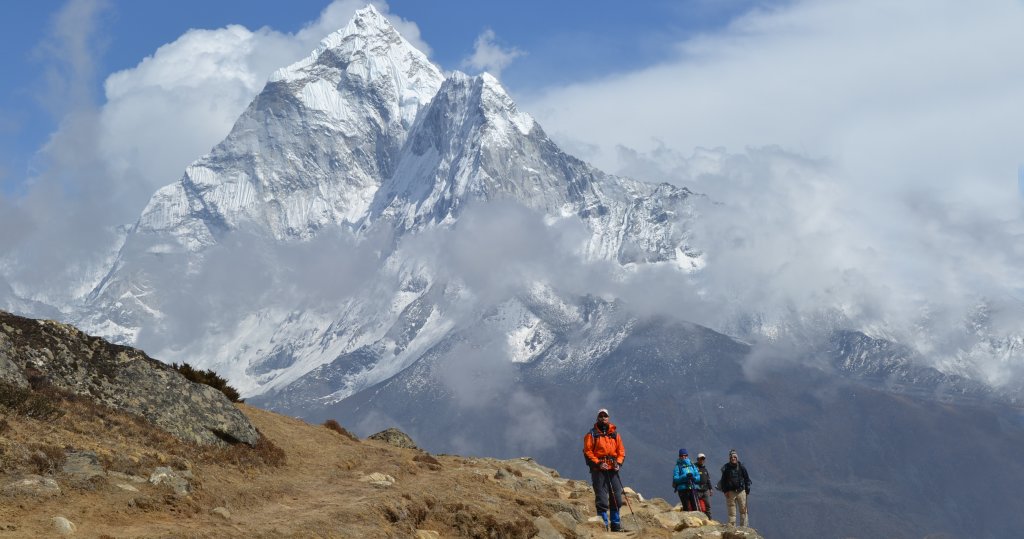
Pro: Less Crowds Equal More Meaningful Connections In Nature
The trails are often less crowded in the spring than in the peak fall season. So if you’re looking for quiet moments of solitude in nature, you should take advantage of this ebb. You’ll be able to soak up everything around you while recharging in peace.
If you do encounter Everest climbers, they’ll typically be descending from the most incredible adventure of their lives. You can feel the palpable energy in their elevated “runner’s high,” which is both invigorating and inspiring.
Con: Potentially Less-Than-Perfect Weather
While all those perks sound great, there is one potential drawback to consider when thinking about trekking to Everest Base Camp in the spring: unpredictable weather.
Though average temperatures hover comfortably in the 70’s with mainly dry conditions — aka absolute perfection for hiking — afternoon clouds in the area could lead to some rain.
So it’s best to plan on mostly dry conditions with a slight chance of rain later in the day.
It’s also not uncommon for haze to surface in the spring, which can affect visibility and cloud the astonishing views, especially below 10,000 feet.
These conditions don’t always happen, but you should know it’s possible. We can’t control Mother Nature, nor would we want to.
On the other hand, mostly clear, richly blue skies in the spring mean fewer flight cancellations and travel interruptions. This fact may be ideal if you can only squeeze in your trip during a specified time frame.
So What’s The Best Time to Visit Everest Base Camp? Choose the Right Season For You
Now that you know more about each season, you can start to narrow down which is right for you.
Should you go in October, when you’ll be surrounded by lots of other trekkers and experience the delights of the fall festival season? Or is May a better choice to match your inward journey and spiritual growth with the rebirth of the earth?
Only your heart knows these answers.
So we suggest starting with a basic pros and cons list of what draws you to each season. Let the information in this guide be your jumping-off points to consider, and think on the decision from there.
Need some sage advice from someone who’s been there before?
Get in touch with one of our experts today and let us help you find the trek that matches your goals and schedule needs. We’ll help you create an unforgettable, once-in-a-lifetime experience from start to finish.
In the end, whether you choose a spring or fall trek from Nepal to Everest Base Camp, you won’t regret the decision. You may just wish you did it sooner.
Take a peek inside our Everest Base Camp trek itinerary to learn more now!
Ready to Explore?
Tusker Trail was founded in 1977 with Eddie Frank’s first trans-Africa expedition. Today, 46 years later, Tusker Trail is recognized across the globe as a world class, expedition company with an incredible track record and reputation for training the finest guides on the planet. On Kilimanjaro, Tusker’s mountain guides have earned the nickname “The Lions of the Mountain” by guides from other companies.
Take a look at Tusker’s treks, each a unique experience of some of the most amazing journeys that will challenge you and change your life forever. If you have a question about our treks give us a call +1.775.833.9700 or 1.800.231.1919 and if you talk to Eddie Frank be sure to ask him about the bet he made 46 years ago that sent him on that first expedition across Africa.
TUSKER TRAIL TREKS
Kilimanjaro Climb – (Tanzania)
Kilimanjaro Climb Routes
Everest Base Camp Trek – (Nepal)
Iceland Hike & Trekking – (Iceland)
Mongolia Nomad Trek – (Mongolia) – “Trip of the Year Award: Outside Magazine”
Patagonia Trek – (Chile and Argentina)
Latest Posts
Medically Trained Kilimanjaro Guides
Kilimanjaro a journey of mind & body, a rollercoaster of emotions, kilimanjaro is a favorite of the seven summits, everest base camp vs kilimanjaro: which is harder.
- Everest Base Camp Trek
- Iceland Highlands
- Kilimanjaro Climb
- Mongolia Nomad Trek
- Tusker Treks

@tuskertrail
- 1.800.231.1919 (North America) +1.775.833.9700 (International)
- 924 Incline Way Suite H Incline Village Lake Tahoe, Nevada 89451-9423, USA
- 1.775.833.9704

Username or E-Mail
Forget Password?
Do not have an account?
After creating an account, you'll be able to track your payment status, track the confirmation and you can also rate the tour after you finished the tour.
Already a member?
- Trekking and Hiking
- Climbing and Expedition
- Cultural and Historical Tours
- Nature and Wildlife
- Religious and Spiritual Tours
- Cycling and Mountain Biking
- Multiple Activities
- Adventure Sports
- Voluntourism
- ACTIVE ADVENTURES
- EXTREME ADVENTURES
- LUXURY TOUR
- Family Holiday
- MULTIPLE COUNTRY
- SCHOOL TRAVEL
- ECO FRIENDLY
- Why Himalayan Glacier?
- Awards and Recognitions
- Latest Trip Review
- Travel Blog

- TREKKING AND HIKING
- CLIMBING AND EXPEDITION
- CULTURAL AND HISTORICAL TOURS
- NATURE AND WILDLIFE
- RELIGIOUS AND SPIRITUAL TOURS
- CYCLING AND MOUNTAIN BIKING
- MULTIPLE ACTIVITIES
- ADVENTURE SPORTS
- VOLUNTOURISM
- Nepal Travel Guide
- Nepal Travel FAQs
- Tibet Travel Guide
- Tibet Travel FAQs
- Bhutan Travel Guide
- Bhutan Travel FAQs
- India Travel Guide
- India Travel FAQs
- Tanzania Travel Guide
- Tanzania Travel FAQs
- Multiple Country
+1-410-307-0007
- Plan Your Trip
A seasonal guide on the best time to hike to Everest Base Camp
Well, this may come as a surprise, but the trail to Everest Base Camp , in Nepal has been trekked successfully in almost all the seasons. However, one of the best treks in the world obviously has a high season. The months of spring (March-May) and fall (October- November) are considered the best time to visit Everest Base Camp.
Despite the high seasons, there are different perks of trekking in one of the world’s best trek trails in other seasons as well. This blog will take you through a seasonal guide to trek to Everest Base Camp in different seasons. You can also consider the other recommendations of other popular treks in Nepal such as Annapurna Circuit Trek , Annapurna Base Camp Trek , Manaslu Circuit Trek , to name a few.
The table below gives you a general view of the weather conditions and the crowds in the Everest Region in different months.
- Spring Season (March-May)
- Monsoon Season (June- August)
- Fall Season (September- November)
- Winter Season (December- February)
How Difficult Is Everest Base Camp Trek?
How can you prepare for everest base camp trek.
- How is the weather at Everest Base Camp?
Spring Season ( March-May )
The months of spring are considered the best months for Everest Base Camp Trek . In spring, the weather is pretty favorably stable and perfect for high altitude climbing.
On top of the favorable weather conditions, alluring views with clear sky and colorful rhododendrons along the trail are definitely plus points. However, the best season with the perfect weather comes at a price. Since it’s the high season, the region gets reasonably crowded.

Moreover, the month of May is the best time to climb Mt. Everest and the surrounding mountains like Lobuche Peak and Island Peak . Naturally, the summit season brings in a lot of climbers and their support crew members. So, if you trek to Everest Base Camp in spring, let’s just say you’ll get to meet many companions along the way.
This might pique your interest: Himalayan Glacier Adventure and Travel Company has started offering sleeping experience at Everest Base Camp from 2021. Whereas, previously trekkers had to trace back to Gorak Shep for the night’s sleep.
Monsoon Season ( June- August)
Generally, trekking during the monsoon season is a challenging task. In the rainy season, the trails get muddy and even slippery at times.
However, there tends to be less rain at higher altitudes. So, if you are well prepared and the wet weather doesn’t pester you, Everest Base Camp Trek is not exactly few and far between. But, you have to be a little extra careful.

Also, in the bargain, the monsoon season is considered off-season in general, which allows you to trek more peacefully with fewer disturbances. Further, the monsoon mornings treat you with the most spectacular views of the Himalayas.
But, if you don’t fancy getting drenched in the rain and still wish to trek during the monsoon, then we have another option for you known as the rain shadow trek, in areas that receive very little rainfall. Upper Mustang Trek , Dolpo Treks , and Simikot to Mount Kailash trek in Tibet are the most rewarding rain shadow treks.
Fall Season ( September- November )
After spring, the fall season is also a good time to trek to Everest Base Camp . The months of fall from September to November also offer moderate temperatures, clear skies, and less chance of problematic rains or snowfall.
It gets a little chillier in the fall than during the springtime. But that’s a fair trade for the mesmerizing views of the surrounding peaks that you get to see during this season. Also, you may get to experience light rainfall in the early days of autumn. But the views after those unannounced rainfalls are definitely threats to keep an eye on.

Further, since fall is also one of the best seasons, you will get to interact with many fellow travelers from all around the world.
Winter Season ( December- February )
Winter season is considered an off-season for Everest Base Camp Trek. During the winter season, the region sees its coldest days with temperatures as low as -17⁰C (1.4⁰F).
Everest Base Camp Trek may seem daunting at this time of the year, but it is not precisely impossible. Many enthusiastic trekkers have trekked the trail even during winters.

As long as you are well prepared for the cold weather, winter is actually a good time for true adventure . You get to treat yourself to excellent mountain views and clear skies. All you need to do is gear up properly. Also, winter is just the right time if you want to avoid hustling for space with other travelers. Since it is considered off-season, the Everest region gets fewer visitors during the winters.
In addition to all that, Nepal’s tourism industry has introduced many winter sports in recent years. Sports like ice-skating and skiing in Gokyo lake and Mera Peak are the new attractions in Nepal’s winter wonderland.
Fun Fact: You can’t see the famous Mt. Everest from its Base Camp. To treat yourself with the view of the majestic mountain, you have to take another day to climb Kala Patthar (5, 643 m/ 18,513 ft).
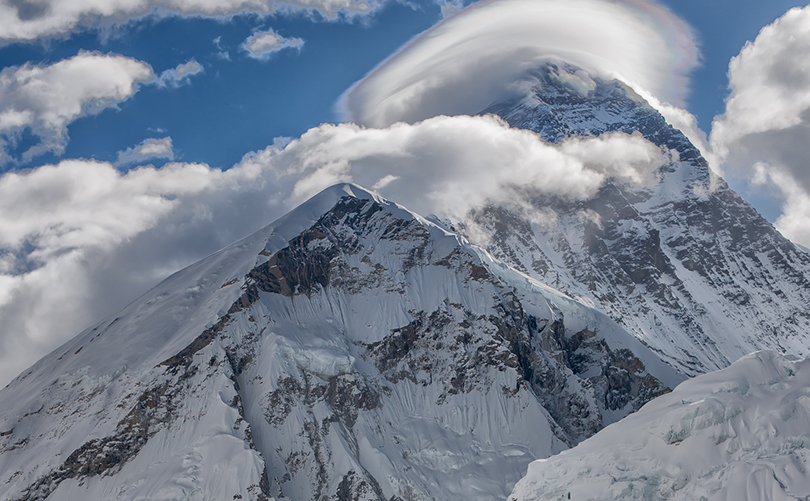
Frequently Asked Question
Naturally, Everest Base Camp Trek sounds intimidating since it is literally the feet of the tallest peak in the world. However, the difficulty level to complete the trek up to the Base Camp is fairly moderate.
Having said that, the trek is also not the easiest since the trail to the tallest peak of the world goes through the rocky paths of hills for multiple days.
Apart from that, the biggest hurdle is the altitude. The trek starts at the height of 3,000 m/ 9,842 ft from sea level and ends at Base Camp, which is 5,400 m/ 17,716 ft. A suitable itinerary is planned with proper acclimatization points to tackle the altitude problem, where you get time to adjust yourself.
Everest Base Camp Trek may seem challenging, but it is definitely not back-breaking for sure. To be more precise, the trail is more like a long hike at a high altitude.
Since the trek ends at the Base Camp, it does not really require specific mountaineering skills or technical expertise. But, the trekkers do need to be physically fit and determined.
To prepare for Everest Base Camp Trek , you can start basic physical activities a few weeks earlier. Some goods options could be hitting the gym, running tracks, or even going for short hikes.
How is the weather at Everest Base Camp?
At an altitude of 5,364m/ 17,599ft from sea level, it’s a given fact that the region sees extreme weather conditions, both in terms of winds and temperature.
The table below gives an overview of temperature and wind in the Everest region throughout the year.
During the coldest months, that is December to February, the temperature drops below freezing with an average of around -10°C/ 14°F. However, in other seasons, the temperature at Everest Base Camp rarely gets above freezing.
Apart from the temperature, what makes the region so cold is the strong winds that blow across the Himalayas. Even with strong wind and cold temperatures, the weather at the Base Camp is bearable with proper warming gears, so you need to be smart with your packing list for Everest Base Camp Trek .
This seasonal guide on the best time to trek Everest Base Camp will give you a basic idea of when to pack your bags for the Himalayas. But planning the whole trip on your own is a lot of hassle and there are many things you need to consider.
So, if you have made up your mind, and the travel preparations are getting out of your hand, you can always get in touch with our experts at Himalayan Glacier who will help plan a custom-made trip for you.
You may also be interested in:

Leave a Reply Cancel Reply
You must be logged in to post a comment.
Recent Posts
- USA to Nepal Flight: Fly to the Land of Himalayas
- Best Time to Visit Ladakh: Discover the Finest Travel Season
- 13 Best Luxury Travel Destination in 2024
- Inca Trail vs. Salkantay Trek and Lares Trek: Choose the Best Route
- A Comprehensive Guide to Kailash Mansarovar Yatra from the USA
Post by Categories
- Bhutan (38)
- Client Review (52)
- Climbing (4)
- Climbing and Expedition (46)
- Cultural and Historical Tours (60)
- Festivals (40)
- Guest Post (1)
- Health & Travel (4)
- Hotel and Tourism (7)
- Kailash (4)
- Nepal (159)
- Packing (6)
- Tanzania (31)
- Travel Blog (490)
- Travel Deals (1)
- Travel Gifts (1)
- Travel Tips (41)
- Trekking & Walking (106)
- Uncategorized (1)
- United States (4)
- Volunteering (1)

Planning a Trip?
We have a pool of travel experts working in this industry for more than a decade. Consult to get started.

- Travel Guide & Tips
Best Time to Visit Everest Base Camp - Updated for 2024
- Modified on Mar 18, 2024
The Everest Base Camp Trek is an activity that instills a gushing feeling of adventure in one's mind, leading you to the lap of one of the tallest mountains in the world. Everest Base Camp trek is the dream trek of a lot of people. Therefore you need to be well aware of the best time to trek in the Everest region so you can have the best views and experience that will last for a lifetime. It is important to understand the region’s weather patterns when planning your trek to ensure you get the most out of your time spent in the area. A few considerations must be taken into account when deciding on the best time to trek to Everest Base Camp. Broadly these are the weather conditions, the busyness of the routes, and the availability of guided tours.
The best time to visit Everest Base Camp depends on the activities you hope to do while there. For trekking, you should go in spring (March-May) or fall (October-November), while a helicopter tour can be taken any time the weather is good outside of monsoon season. Winter shouldn't be off the table, either; as long as you're prepared for cold temperatures, you'll be treated to crystal-clear mountain views. Below, you'll find some important points to consider when thinking about visiting Everest Base Camp.
Table of Content
Spring (march-may).
The spring months are probably the most popular in the region as a whole. You might be caught in the occasional snow showers in early February-late winter, but the weather should be largely stable and dry which is perfect for trekking and high altitude climbing. The Spring season provides a clear and undisturbed panoramic view of the beautiful mountains. Filled with red blooming rhododendrons amidst the dense green forest, the trail takes you along gushing rivers.
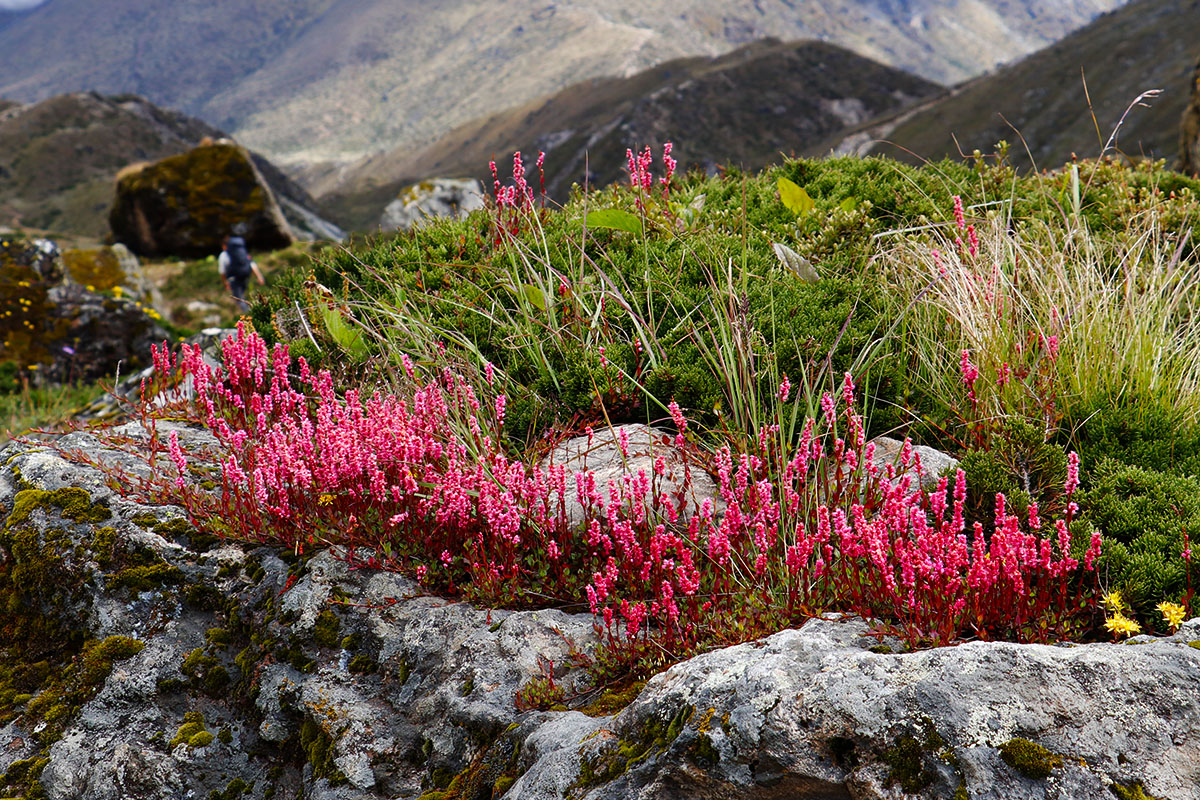
The ideal weather comes at a price as the routes during this time will be at their busiest. Most Everest summits occur during these months so you will likely come across many climbers, summiteers, and their support crews. The region is also the most vibrant at this time of the year, with many of the routes flanked by flowering rhododendrons, clear blue sky, warm sun, the colorful prayer flags moving from the breeze.
Autumn (Sept-Oct)
Another best time of the year to trek to the Everest base camp is the autumn or post-monsoon season. Generally, the autumn season starts from September to October. It is the main season where the Everest region sees a surge of trekkers and visitors trekking to the Everest base camp. Mid-September to November is one of the best times for Everest Base Camp Trek.
Clear days are characteristic of this popular trekking period. Although colder days (and colder nights) are to be expected, this is a small price to pay for the wonderful vistas and perfect views of the region's peaks. A bonus of trekking during this time is the option to choose some other, less well-known routes in the area that still offer amazing views but without the hustle and bustle of the more popular routes. The Gokyo Lakes Trek to the Everest Base Camp is a perfect example. This season is trendy among the trekkers also because it provides splendid panoramic views with less heat haze and clouds.
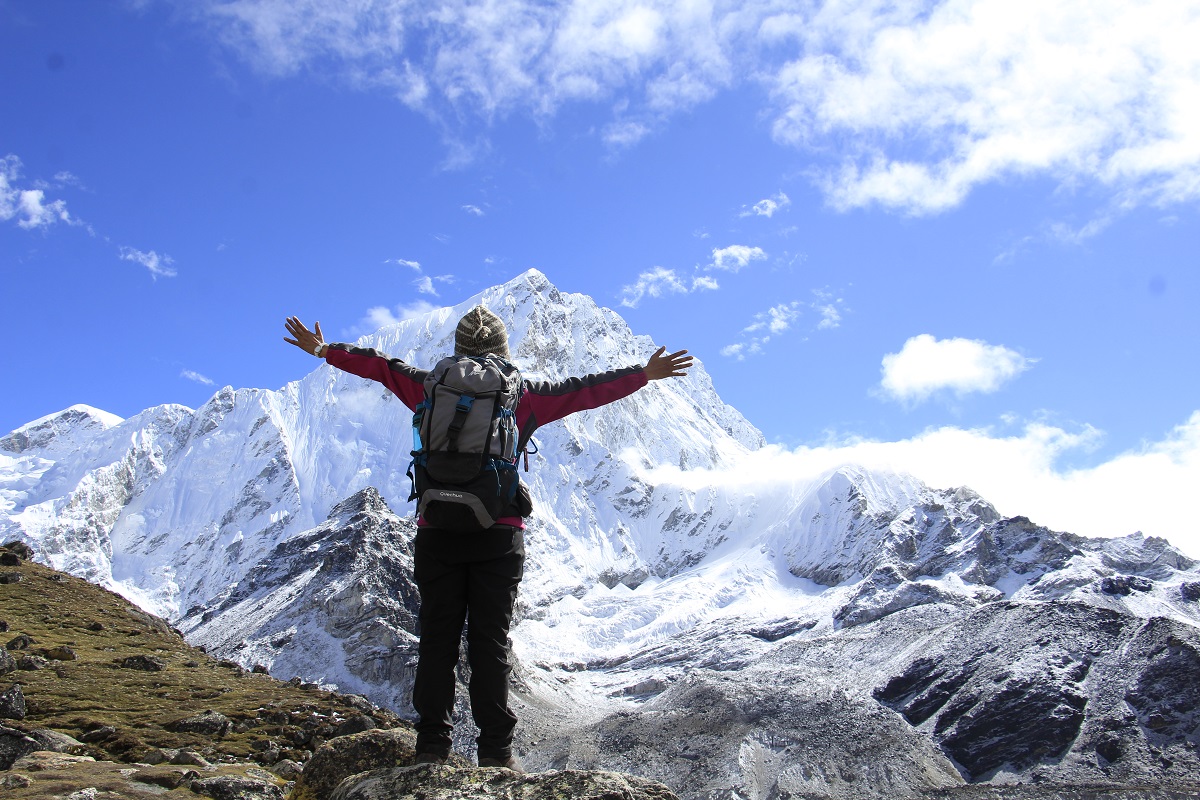
As the rainy season comes to a halt, the lush landscapes blossom with bright flowers while the river gushes out strongly and the crisp weather offers you a mesmerizing view of the Himalayas. With warm, pleasant days and chilly nights, the temperature during this season is around 15 degrees Celsius. Blessed with the unhampered views of the jewel of Nepal, Mt. Everest, you will surely get the best of the Everest region during autumn.
Monsoon (June-Aug)
The monsoon season (June to early September) is not ideal for traveling to Everest Base Camp. Aside from the wet weather which can lead to landslides on trails and muddy conditions, rainclouds can obscure the mountain views. But, temperatures are also warmer at this time, and it rains all day every day. If you're well prepared for the rain and don't mind getting a bit wet along the way though, trekking in the monsoon can be fine because the higher you go in altitude, the less rain there tends to be.
The trail conditions are not the safest, the trek will be wet and unenjoyable and you won’t even be able to get any great pictures of the beautiful mountain peaks. Even if trekking isn't on your agenda but a helicopter tour to Everest Base Camp is, these are also best when the weather is clear and predictable. It is best to avoid monsoon months for trekking to Everest Base Camp.
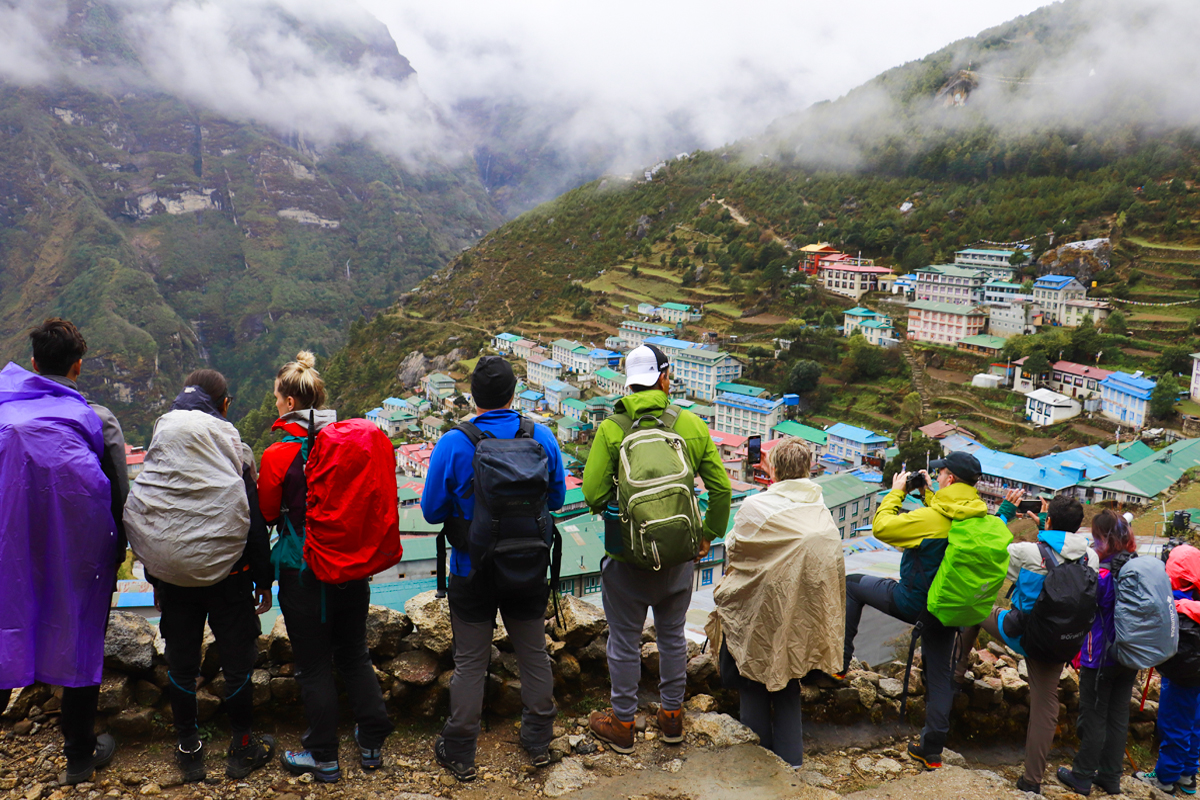
The weather won't only affect your experience in the Everest region, it also has the potential to affect flights from Kathmandu to Lukla. The most popular option for the Everest Base Camp Trek is a scenic flight to Lukla from Kathmandu and start the trek from there, but flights are frequently canceled when the weather and visibility are poor in Kathmandu, Lukla, or en route. Flights outside of the monsoon season are more likely to run as scheduled, but rain, fog, or smog can affect flights at any time of year.
Winter (Nov-Jan)
The winter (November, December, and January) isn't necessarily a 'bad time to trek to EBC, but it's certainly the off-season. Temperatures can get extremely cold, so you'd need to be well prepared for freezing conditions. This season sees a lot of snow, and the high passes remain closed. But, the skies tend to be very clear in winter, meaning excellent mountain views. And, you won't be hustling for space with other trekkers en route. As it is off-season routes would be empty and also tour prices and flight costs tend to drop a little bit now too. However, if you want to avoid the crowd and enjoy an isolated trekking experience, winter trekking to the Everest Base Camp is the perfect choice for you.
Peek Season Crowds
Spring and autumn are the peak seasons in Nepal, and as the Everest Base Camp Trek is Nepal's most popular, trails can get crowded at these times. There's no chance you'll have the main trails to yourself, and you may also struggle to get your first pick of accommodation. Trekking with a guide is always a good idea, but even more so in the peak season as they will be able to secure beds for you that might be difficult if you were traveling independently. Additionally, the Everest climbing season runs from May to early June, so even if you have no intention of climbing the mountain yourself, the area will be busy with expeditions in these months.
Flights to Lukla also sell out quite far in advance during peak season, so book these as early as possible. In the winter and monsoon, you won't encounter the same crowds. But while you may not struggle to get a bed in a good teahouse as you might in peak season, a lot of places close in the off-seasons.
Everest base camp trek is one of the best trekking destinations in the world. If you do not have Everest Base Camp on your bucket list, you are seriously missing out on the best trekking experience. You can trek to Everest base camp any time of the year, but there are some best seasons when you can experience the best of the Everest region. So, if you are planning to visit the Everest base camp, you should check out the best time for your journey. Contact us for the more information regarding the trekking and tour in Nepal.
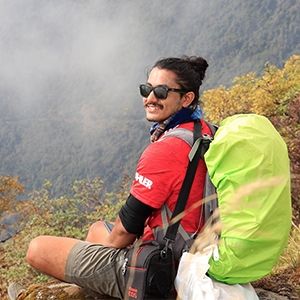
Sharan Karki
Sharna Karki, a travel blogger and passionate mountain guide working in this travel industry for the last 8 years. He is originally from the beautiful village of Dhading, Phulkharka lies in the lap of the stunning mountains and majestic hills. He spends his childhood in such an amazing place where mountains, nature, and culture was the focal subject to learn. Later, he finished his Bachelor’s degree in Business Studies from Tribhuvan University. Previously, he dreamed to study in the field of medicine however, things changed when he realized that he had no greater passion than traveling and exploring. This motivation pushed him into the travel and tourism industry.
- Information
Send an Enquiry
Recent posts.
- Dhorpatan Hunting Reserve: The only Hunting Reserve in Nepal
- Rhododendron Festival in Bhutan 2024
- "Nava Barsha 2081 in Nepal: Embracing the Nepali New Year"
- The Complete Guidebook to Tilicho Lake Trek : Everything You Need to Know
- Pokhara: The Tourism Capital of Nepal
- Paro Tshechu Festival in Bhutan 2024
Related Posts
- 15 Best Tourist Attractions and Places To Visit in Tanzania
- Popular Tourist Attractions in Bhutan
- Accommodations
- Adventure Sports
- Cultural & Historical
- Festivals & Events
- Food and Taste
- Heritage Sites
- National Parks & Conservation Areas
- News & Events
- Photography
- Places To Visit
- Temples & Monasteries
- Things To Do
- Uncategorized
We use cookies to ensure that we give you the best experience on our website.
Conquer the Everest Base Camp Trek in 12 Days – A Journey of Legends!
Nepal, the name is unfamiliar among many people of the world, but the name Everest is popular among the trekking enthusiasts. Mount Everest rests on the northern mountainous part of Nepal in the Everest region. And Everest Base Camp trek takes you to the lap of this highest peak in the world.
In general, you can do the Everest Base Camp trek in 14 days which includes 2 acclimatization days as well. However, as per your convenience, you can plan your own itinerary as well. You can plan how long you wish to spend on this trekking trail in the Everest region.
Whichever itinerary you follow all you get is to explore the diverse culture, nature, geography of the Everest region. The typical Sherpa people , their Tibet-influenced culture and traditions, their Buddhist practices will keep you accompanied in the trek.
You also get to delve into the several monasteries, and chortens and walk past the Mani walls and Prayer flags to reach your dream destination- the Everest Base Camp.
This high-altitude trek to EBC is doable all year round, but, Autumn and Spring are the peak season for the trek. You will collect the finest trekking memories during this time.
But since the mountain weather is unpredictable you must come prepared for any physical and mental problems. With enough preparation and proper packing this trek is doable and will be your lifetime memory as well.

- Full Name *
- Country * Select Country Afghanistan Åland Islands Albania Algeria American Samoa Andorra Angola Anguilla Antarctica Antigua and Barbuda Argentina Armenia Aruba Australia Austria Azerbaijan Bahamas Bahrain Bangladesh Barbados Belarus Belgium Belize Benin Bermuda Bhutan Bolivia Bonaire, Sint Eustatius and Saba Bosnia and Herzegovina Botswana Bouvet Island Brazil British Indian Ocean Territory Brunei Darrussalam Bulgaria Burkina Faso Burundi Cambodia Cameroon Canada Cape Verde Cayman Islands Central African Republic Chad Chile China Christmas Island Cocos Islands Colombia Comoros Congo, Democratic Republic of the Congo, Republic of the Cook Islands Costa Rica Côte d'Ivoire Croatia Cuba Curaçao Cyprus Czech Republic Denmark Djibouti Dominica Dominican Republic Ecuador Egypt El Salvador Equatorial Guinea Eritrea Estonia Eswatini (Swaziland) Ethiopia Falkland Islands Faroe Islands Fiji Finland France French Guiana French Polynesia French Southern Territories Gabon Gambia Georgia Germany Ghana Gibraltar Greece Greenland Grenada Guadeloupe Guam Guatemala Guernsey Guinea Guinea-Bissau Guyana Haiti Heard and McDonald Islands Holy See Honduras Hong Kong Hungary Iceland India Indonesia Iran Iraq Ireland Isle of Man Israel Italy Jamaica Japan Jersey Jordan Kazakhstan Kenya Kiribati Kuwait Kyrgyzstan Lao People's Democratic Republic Latvia Lebanon Lesotho Liberia Libya Liechtenstein Lithuania Luxembourg Macau Macedonia Madagascar Malawi Malaysia Maldives Mali Malta Marshall Islands Martinique Mauritania Mauritius Mayotte Mexico Micronesia Moldova Monaco Mongolia Montenegro Montserrat Morocco Mozambique Myanmar Namibia Nauru Nepal Netherlands New Caledonia New Zealand Nicaragua Niger Nigeria Niue Norfolk Island North Korea Northern Mariana Islands Norway Oman Pakistan Palau Palestine, State of Panama Papua New Guinea Paraguay Peru Philippines Pitcairn Poland Portugal Puerto Rico Qatar Réunion Romania Russia Rwanda Saint Barthélemy Saint Helena Saint Kitts and Nevis Saint Lucia Saint Martin Saint Pierre and Miquelon Saint Vincent and the Grenadines Samoa San Marino Sao Tome and Principe Saudi Arabia Senegal Serbia Seychelles Sierra Leone Singapore Sint Maarten Slovakia Slovenia Solomon Islands Somalia South Africa South Georgia South Korea South Sudan Spain Sri Lanka Sudan Suriname Svalbard and Jan Mayen Islands Sweden Switzerland Syria Taiwan Tajikistan Tanzania Thailand Timor-Leste Togo Tokelau Tonga Trinidad and Tobago Tunisia Turkey Turkmenistan Turks and Caicos Islands Tuvalu Uganda Ukraine United Arab Emirates United Kingdom United States Uruguay US Minor Outlying Islands Uzbekistan Vanuatu Venezuela Vietnam Virgin Islands, British Virgin Islands, U.S. Wallis and Futuna Western Sahara Yemen Zambia Zimbabwe Country
- Number of Travellers *
- Phone Number
- Travel Date Day 1 2 3 4 5 6 7 8 9 10 11 12 13 14 15 16 17 18 19 20 21 22 23 24 25 26 27 28 29 30 31 Month 1 2 3 4 5 6 7 8 9 10 11 12 Year 2025 2024 2023 2022 2021 2020 2019 2018 2017 2016 2015 2014 2013 2012 2011 2010 2009 2008 2007 2006 2005 2004 2003 2002 2001 2000 1999 1998 1997 1996 1995 1994 1993 1992 1991 1990 1989 1988 1987 1986 1985 1984 1983 1982 1981 1980 1979 1978 1977 1976 1975 1974 1973 1972 1971 1970 1969 1968 1967 1966 1965 1964 1963 1962 1961 1960 1959 1958 1957 1956 1955 1954 1953 1952 1951 1950 1949 1948 1947 1946 1945 1944 1943 1942 1941 1940 1939 1938 1937 1936 1935 1934 1933 1932 1931 1930 1929 1928 1927 1926 1925 1924 1923 1922 1921 1920
- Send us your Message *
Table of Contents
Highlights of Everest Base Camp Trek
- Walk into the base of the world’s highest peak Mt. Everest (8848 meters) at 5346 meters from sea level.
- Step into the most popular vantage point Kala Patthar (5555 meters) to catch the finest glimpse of Everest.
- Walk through the diverse flora and fauna of Sagarmatha National Park
- Collect blessings from the oldest monastery of the Khumbu region, Tengboche monastery.
- Walk past the stunning icefalls, Khumbu glacier, and icicles on the way to the base camp.
- Take an adventurous stroll around the glacial lakes and Gokyo Ri in the Gokyo valley
- Connect with the local Sherpa people of the Khumbu region.
- Do some shopping in the popular business hub of Khumbu region, Namche Bazar
- Take an electrifying flight from Kathmandu – Lukla. Lukla airport is among the world’s dangerous airport.
- Do some interaction with those mountaineers preparing for the Everest, or Island Peak, or Mera Peak, or Lobuche Peak.
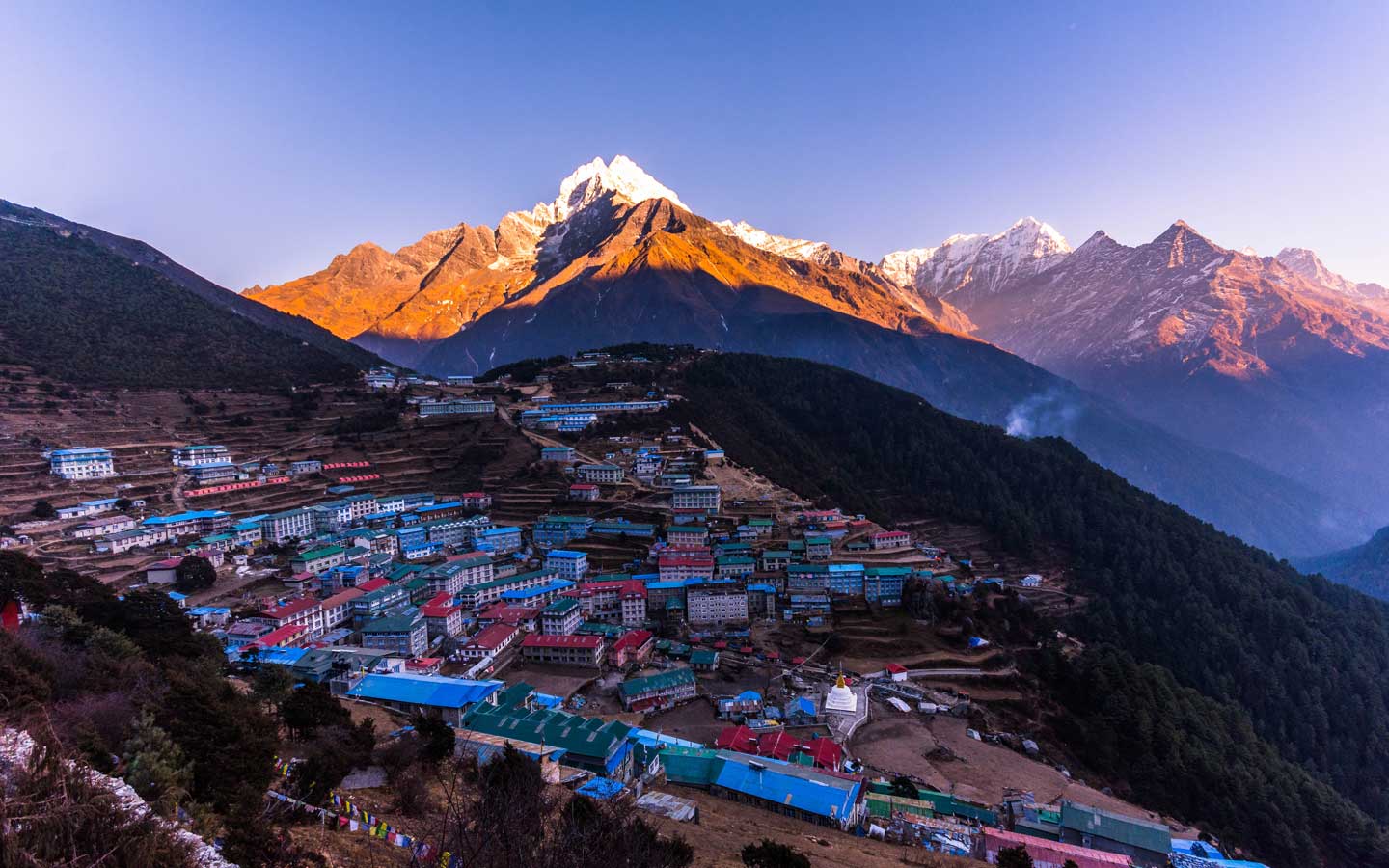
Everest Base Camp Trek Itinerary
You can go on standard Everest Base Camp trek in 14 days . But the itinerary is customizable. You can either extra days to your trek or you can cut-off trek days.
You can plan your own itinerary as per your convenience. You can also complete the trek in 11 days or extend it to even 19 days as well. The number of days you will be spending on the trek depends on your trek preference and convenience.
Despite the number of trekking days, you must get the necessary permits for EBC trek once you are here in Kathmandu. While in the city, you need to obtain the necessary permits for the trek.
If you are a solo trekker you need to arrange the permits by yourself. But if you are trekking through a travel company, they will arrange all the permits and complete the legal formalities for you.
Here’s a standard 14 days detailed itinerary for the Everest Base Camp Trek.
Day 01- Kathmandu – Lukla – Phakding
Altitude: 2804 meters, Phakding
Flight duration: 45 minutes
Trek duration: 4-5 hours
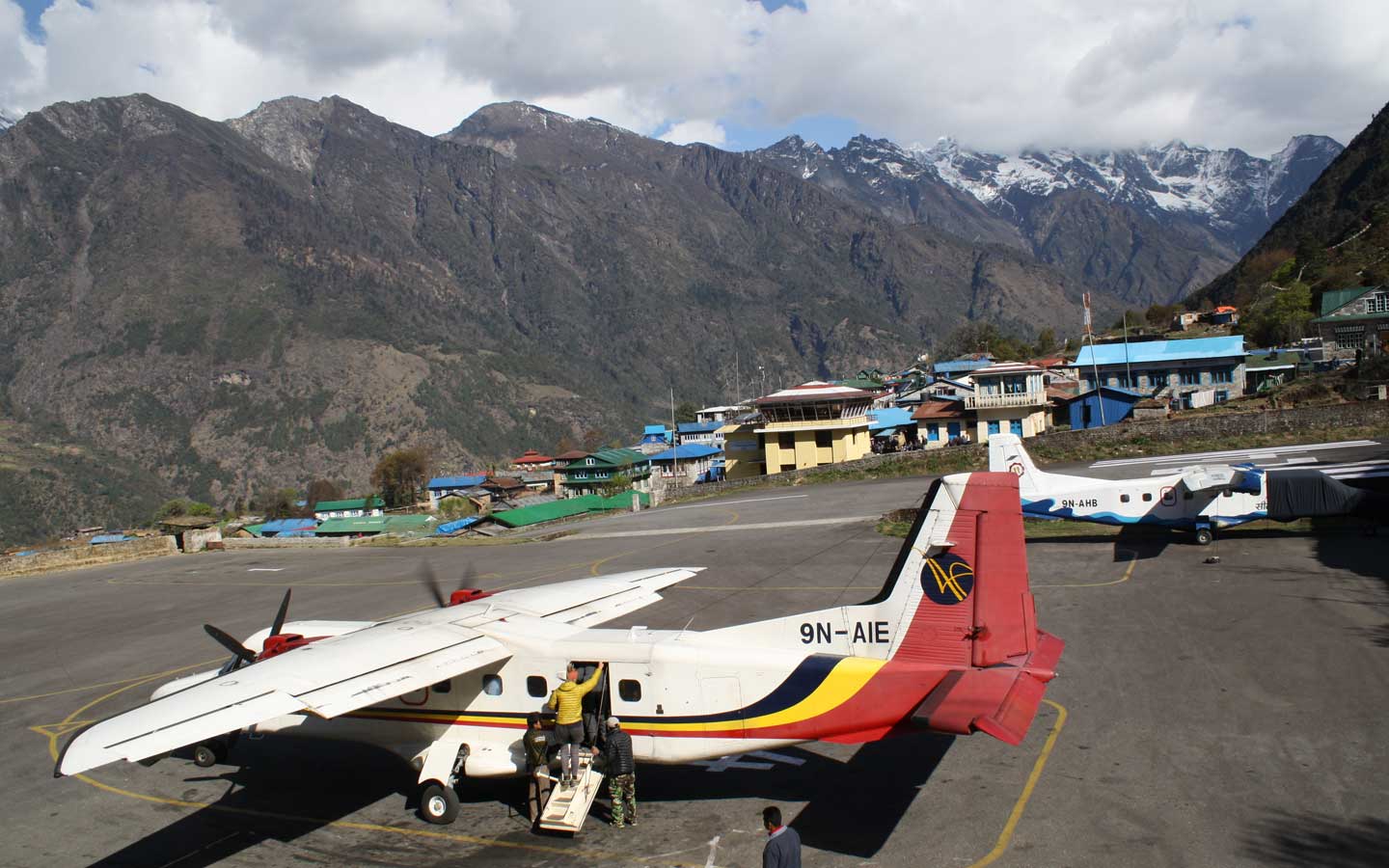
After morning breakfast, you will leave the airport to catch a 45 minutes flight to Lukla. The flight is among the electrifying flights in the world. You will get to enjoy the first view of the mountains and amazing views of the Everest region.
This scenic flight lands at Lukla from where your actual trek starts. You climb downhill to Phakding for about 4-5 hours for an overnight stay.
Day 02- Phakding – Namche Bazaar
Altitude: 3441 meters, Namche Bazar
Trek Duration: 6-7 hours
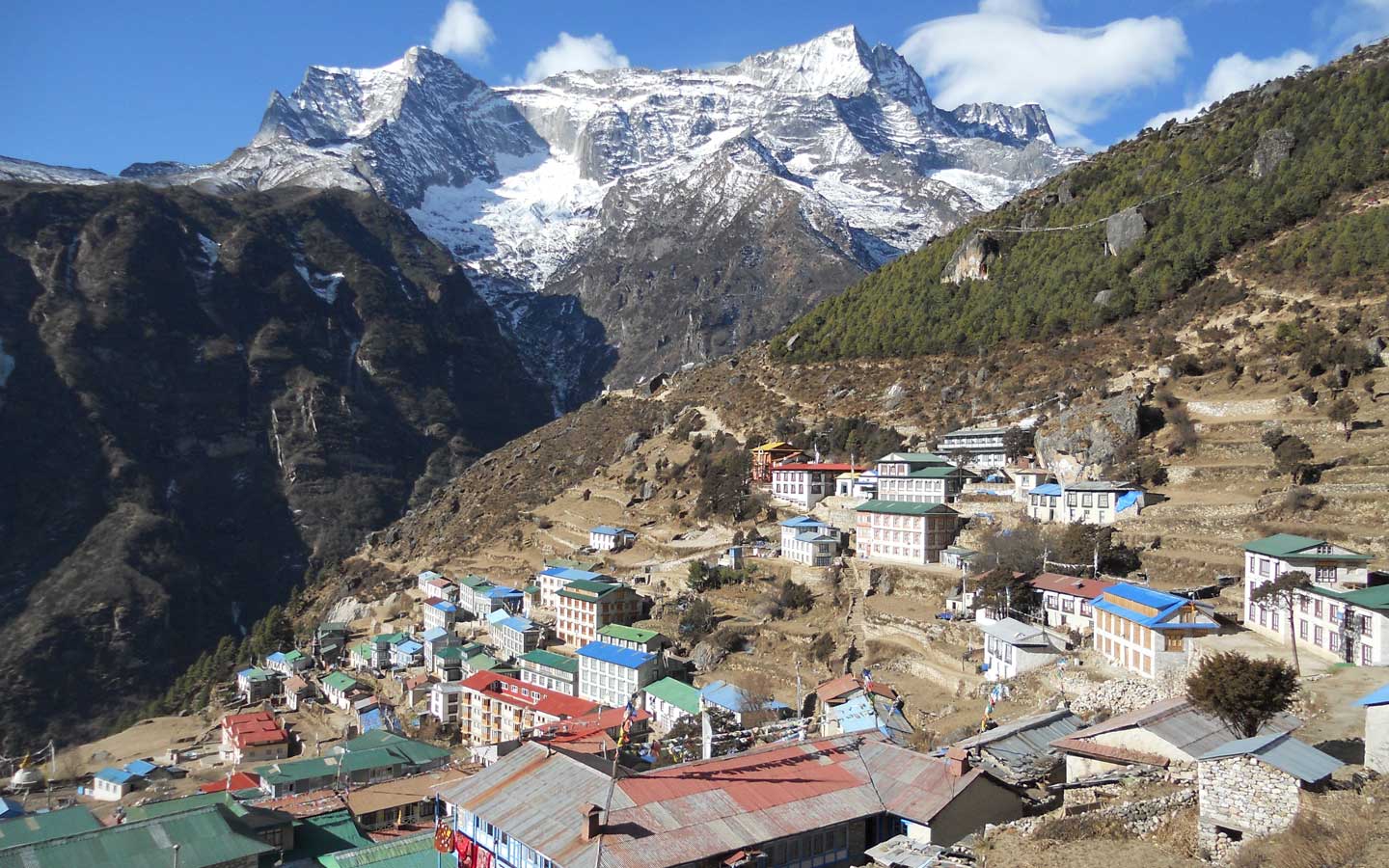
The next morning you will enjoy a warm meal at Phakding and leave for Namche Bazaar . On walking across the bank of Dudh Koshi river and crossing several suspension bridges you will reach Namche in around 6-7 hours.
On this day you will enter Sagarmatha National Park where you need to verify your permits to enter the region. On walking past the lush forests of rhododendrons you will finally reach this popular town of the Everest region.
There are enough hotels and lodges for your overnight stay.
Day 03- Rest Day at Namche Bazaar
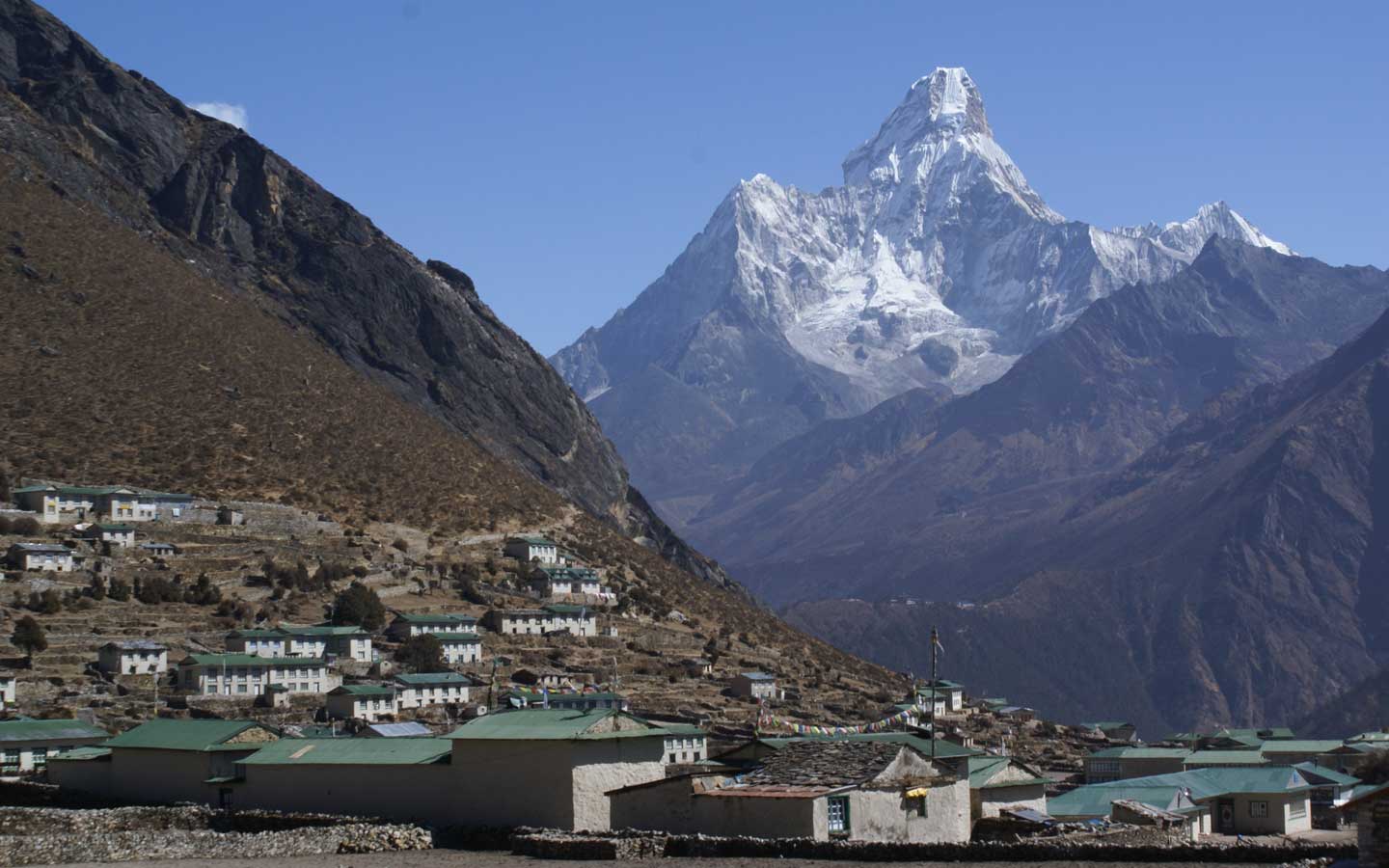
Since altitude is the major concern during this trek, you will be spending a rest day at Namche Bazaar.
If the weather is clear you will catch the first views of Mt. Everest and its neighboring peaks from Namche Bazaar. On this acclimatization day, you will be taking short strolls around the nearby villages like Khunde and Khumjung.
You will get a chance of a closer encounter with the Sherpa people of the region and their lifestyles. Plus, you can also visit a school constructed by Sir Edmund Hillary and get to know about its present conditions.
In the evening you can walk around the market of Namche Bazaar and do some shopping.
Day 04- Namche Bazar – Tengboche
Altitude: 3860 meters
Trek Duration: 5-6 hours
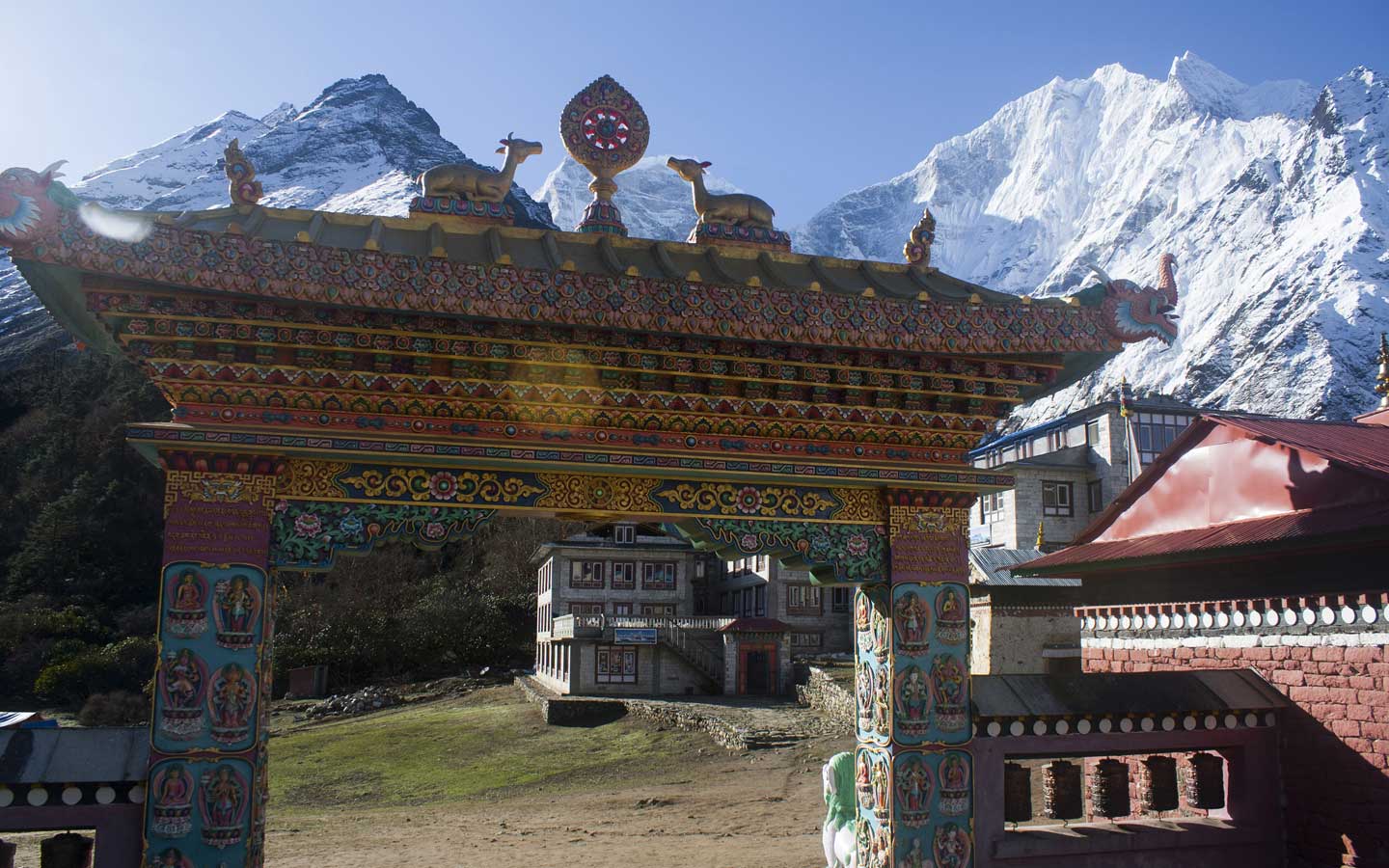
Breakfast the next day and you will start your trek of the day. Bidding farewell to the Namche Bazaar you will start ascending towards Tengboche.
On this day, you will walk to the Tengboche monastery- the oldest monastery of the region. Plus, if you trek during the expedition season, you will encounter many mountaineers. They come to take blessings in the monastery for their successful climb to the summit.
Also, on clear days the monastery offers the panoramic views of the chain of Himalayas in the Everest region. There are enough tea houses on the monastery premises for your overnight stay.
Day 05- Tengboche – Dingboche
Altitude: 4400 meters, Dingboche
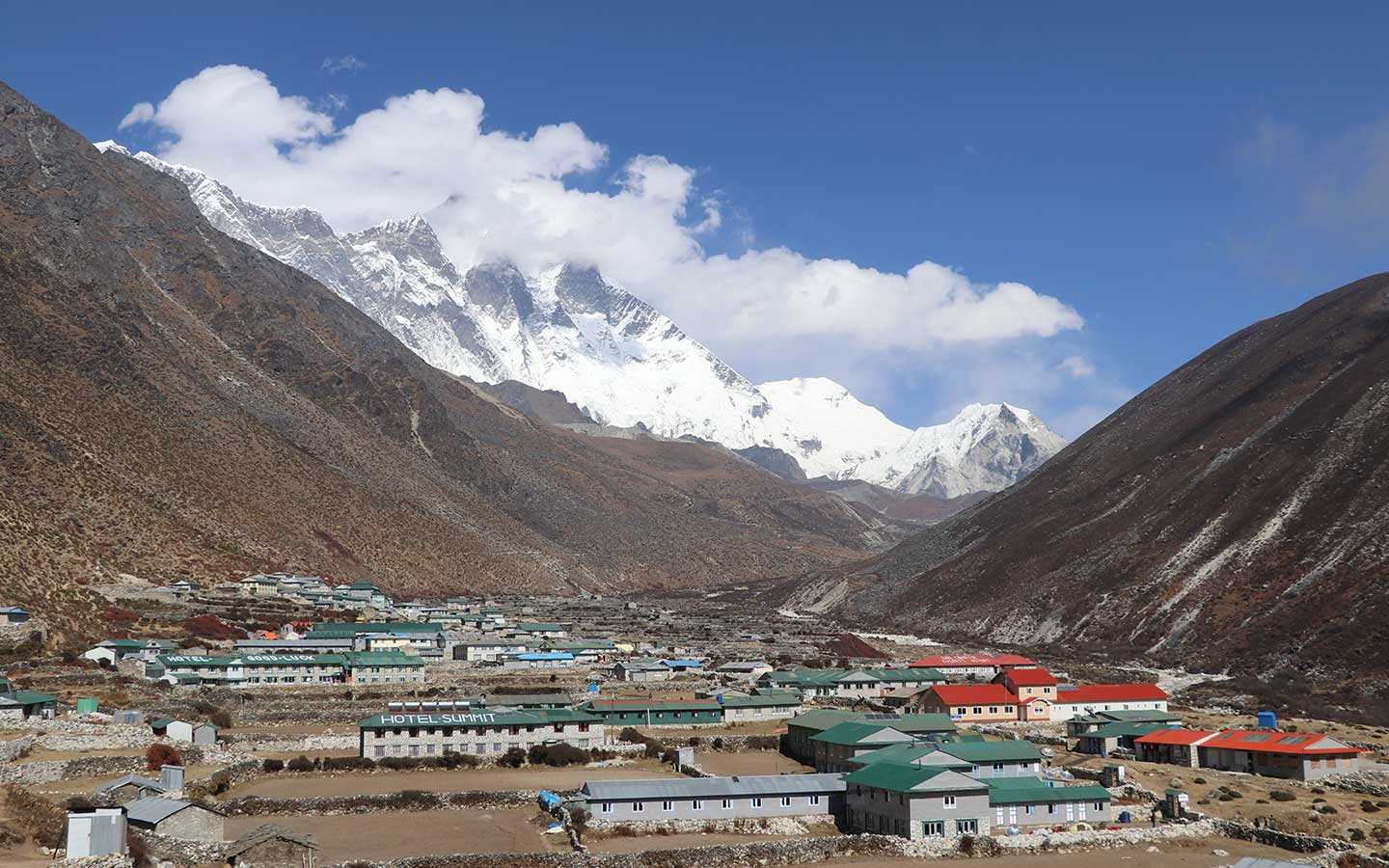
Collecting the blessings at the monastery you will leave for the next destination after breakfast on the next day. You will start to ascend to altitudes above 4000 meters so you must walk slowly and take proper rest.
You cross several rocky trails and boulders to catch a view of a small village on the lap of Ama Dablam – Dingboche village. The small village on the lap of mountains and on the neighborhood of rivulets and streams has limited teahouses for your overnight stay.
So, it is a good idea to pre-book rooms. Overnight stay at Dingboche.
Day 06- Acclimatization day
Altitude: 4710 meters, Nagarjuna Hill
Hike duration: 4-5 hours
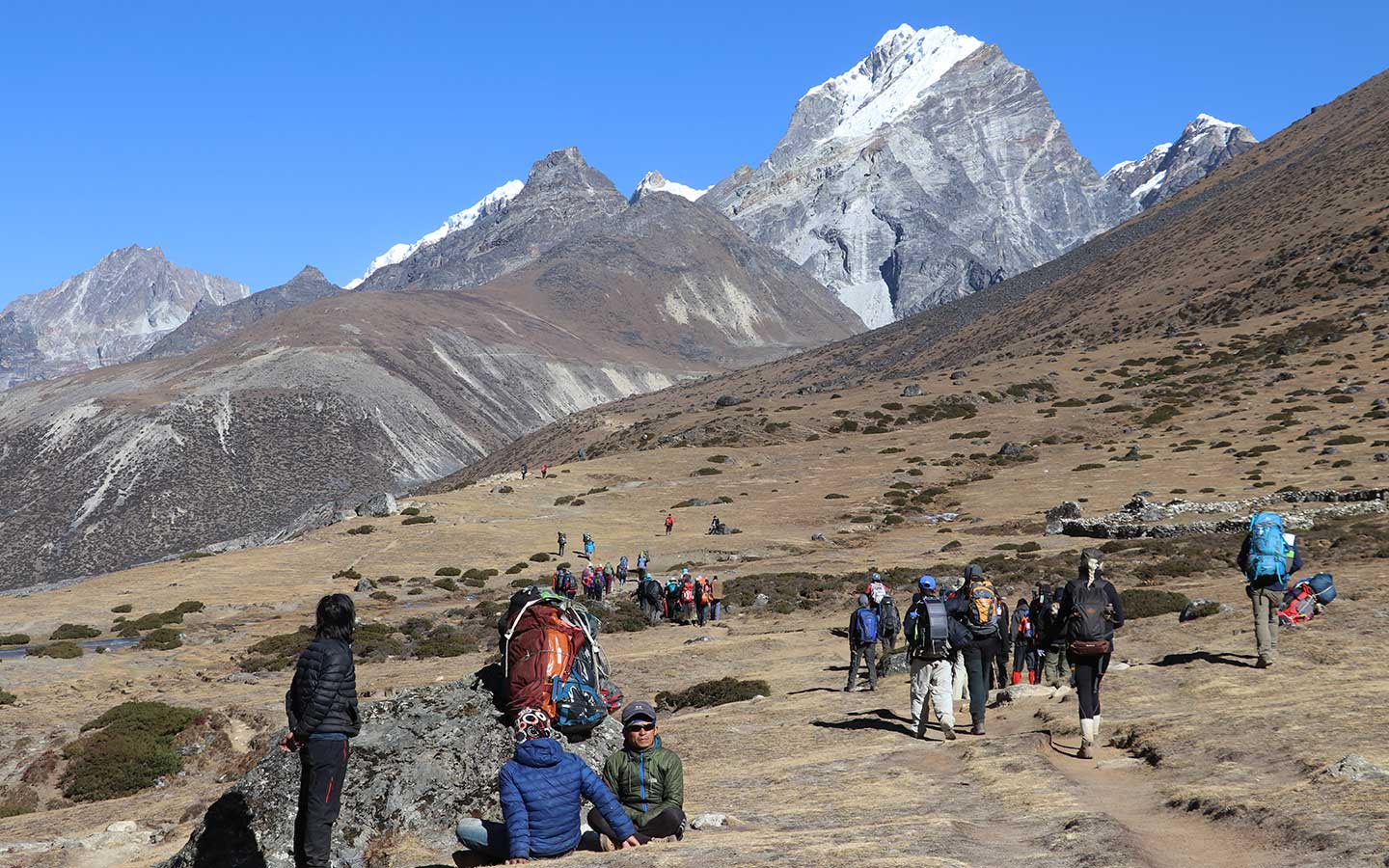
This is the second day of rest during your 14 days Everest Base Camp trek. On this day you will spend time exploring the village, hike to the nearby hillocks like Nagarjuna Hill.
This scenic hike will offer you the closest views of the Everest, Nuptse , Lhotse , Ama Dablam, and other peaks.
Or, you can hike to Chukung Ri to catch the best view of Island Peak and the mountaineers busy in climbing Island Peak. You will spend the night in the same teahouse at Dingboche.
Day 07- Dingboche – Lobuche
Altitude: 4900 meters, Lobuche
Trek Duration: 4-5 hours
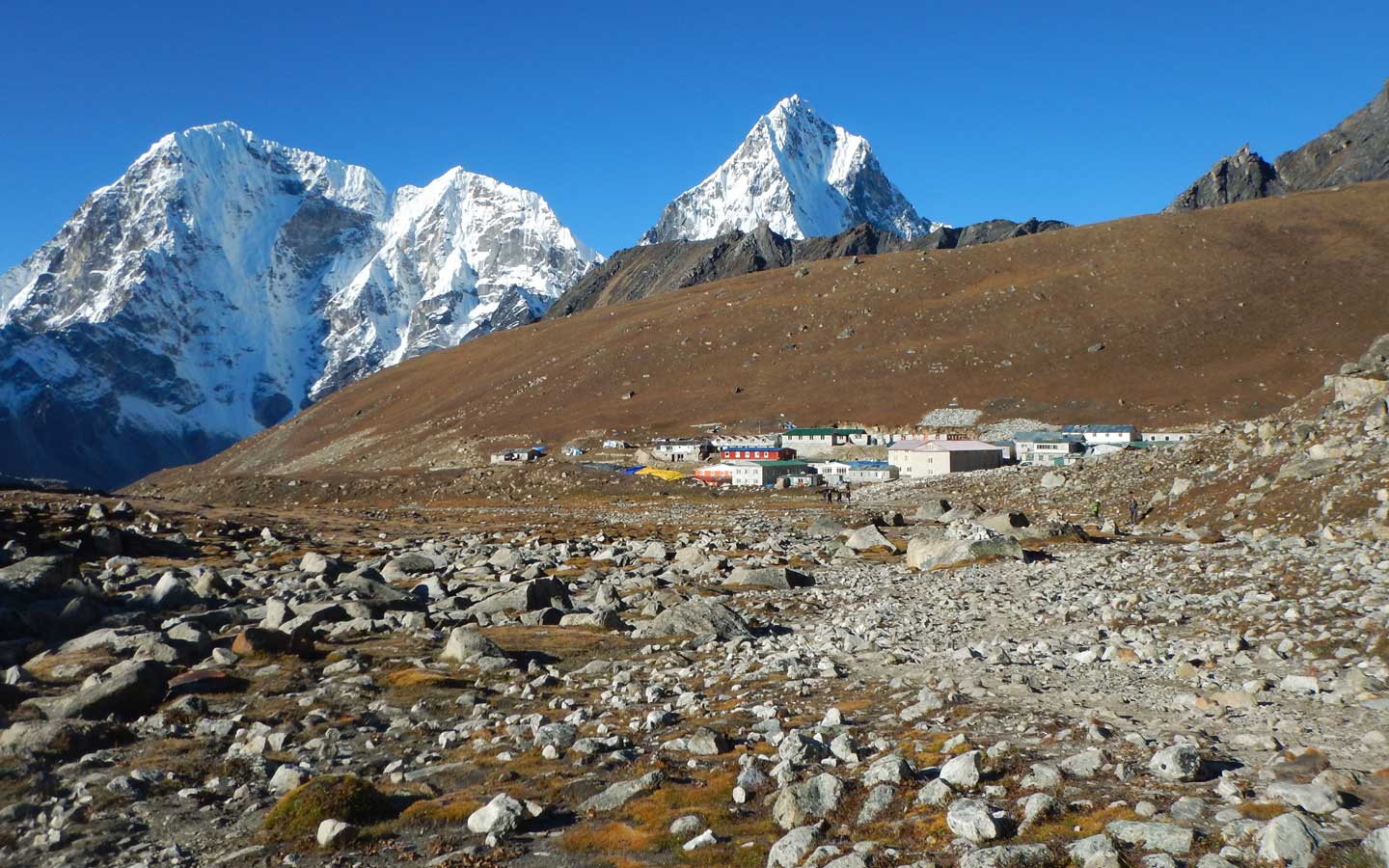
Spending 2 nights in a tea house at Dingboche you will leave for Lobuche. En route, you walk past the Khumbu glacier and icefall.
This is among the challenging part of the trek, you must be very careful to proceed forward.
En route, you walk past the memorial of the dead mountaineers where you can rest for a moment to pray for the departed soul.
Catching the finest views of Lobuche Peak on your side you walk towards the Lobuche village for an overnight stay.
Day 08- Lobuche – Gorak Shep- Everest Base Camp
Altitude: 5160 meters, EBC
Trek Duration: 7-8 hours
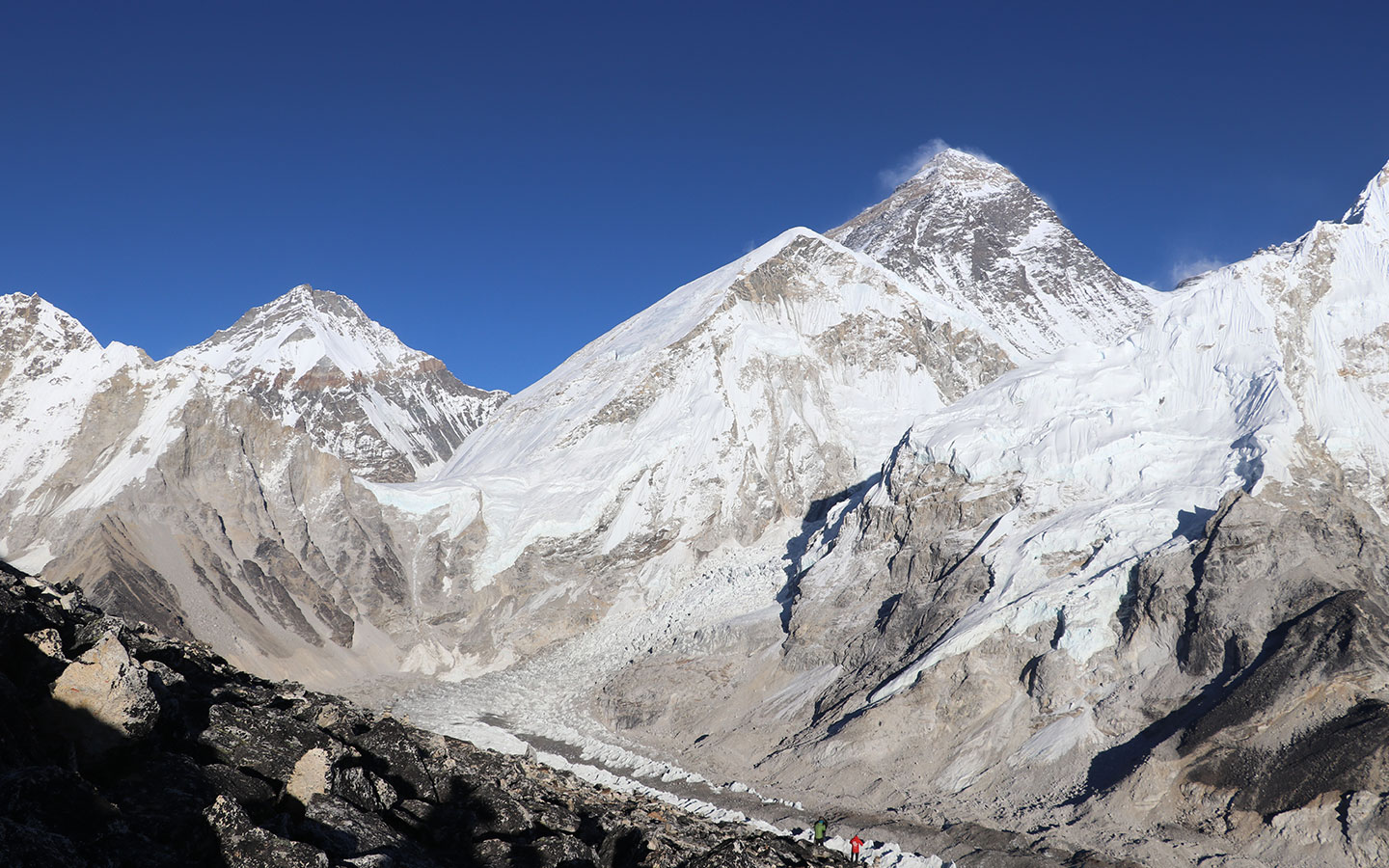
Early morning breakfast and you will leave Lobuche village to trek to Gorak Shep. Gorak Shep is the final point of the trek before you reach the Everest Base Camp.
First, you walk past the rock, adventurous terrains of the Lobuche village to reach Gorak Shep. After reaching the tea house, you will take a short rest and then hike to the base camp.
On reaching the Base Camp you will have amazing feelings. You will spend some amazing moments on the lap of Himalayas . You can click as many pictures as you like.
After enjoying the bliss of this closeness to the mountains you will return back to Gorak Shep for an overnight stay.
Day 09- Gorak Shep- Kala Patthar- Pheriche
Altitude: 5555 meters, Kala Patthar
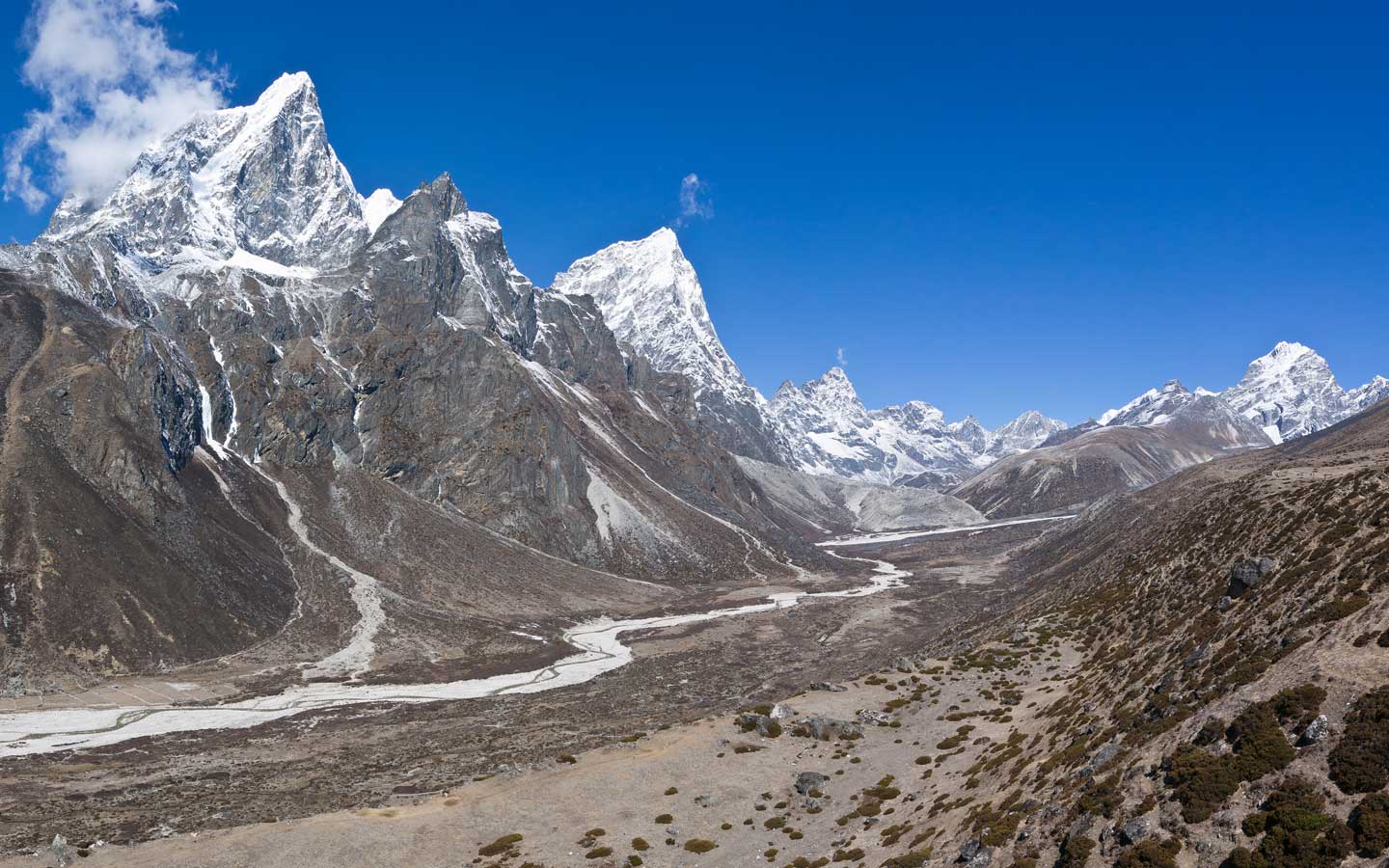
The next morning you will leave the tea house quite early in the morning and walk for 45 minutes to reach Kala Patthar . There, you can catch the best views of Mount Everest along with its neighboring peaks.
This is the vantage point for the best views of Mt Everest, Nuptse, Lhotse, and other chains of Himalayas. And, it is the final destination for your trek.
After spending some time in the vicinity of the mountains you will walk back to Gorak Shep and enjoy your lunch. Then you will descend to Pheriche village for the overnight stay.
Day 10- Pheriche – Namche Bazaar
Altitude: 3860 meters, Pheriche
On this day you will get to open your eyes with the skyrocketing peaks in front of you. After breakfast, you will descend back to the Namche Bazaar where you will be spending the night. Once in Namche, you can do some souvenirs shopping if you wish to.
Day 11- Namche Bazar- Lukla
Altitude: 3440 meters, Namche Bazar
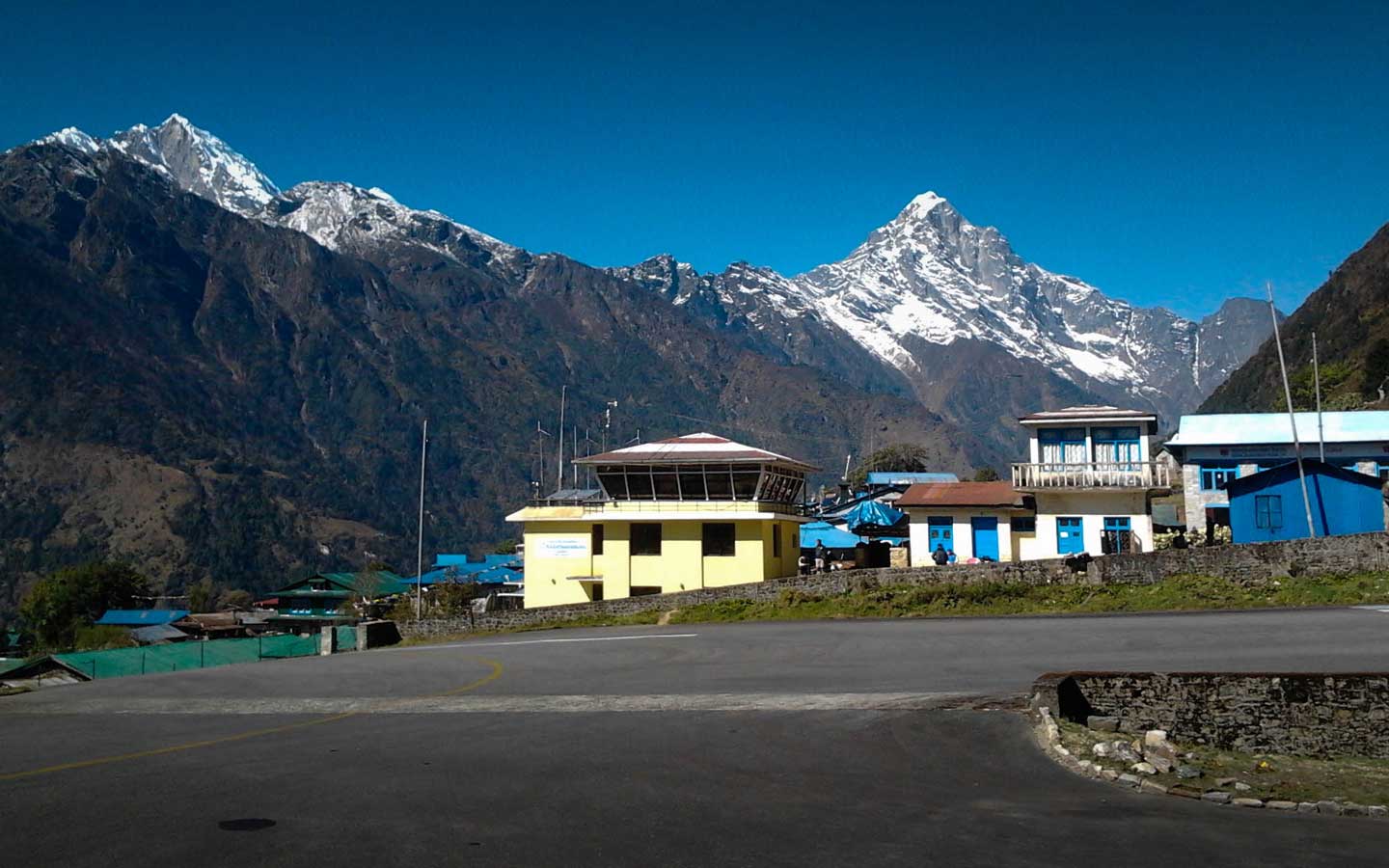
The next morning you descend past the lush forests of rhododendrons and magnolias. You will do final checking at the entry point of Sagarmatha National Park. And start trekking to Lukla, the final destination of the day.
On walking, you descend through different monasteries, temples, chortens and meet locals. Once you reach Lukla, you can book the Kathmandu flight for the next day.
Day 12- Lukla – Kathmandu
Altitude: 2,860 meters, Lukla
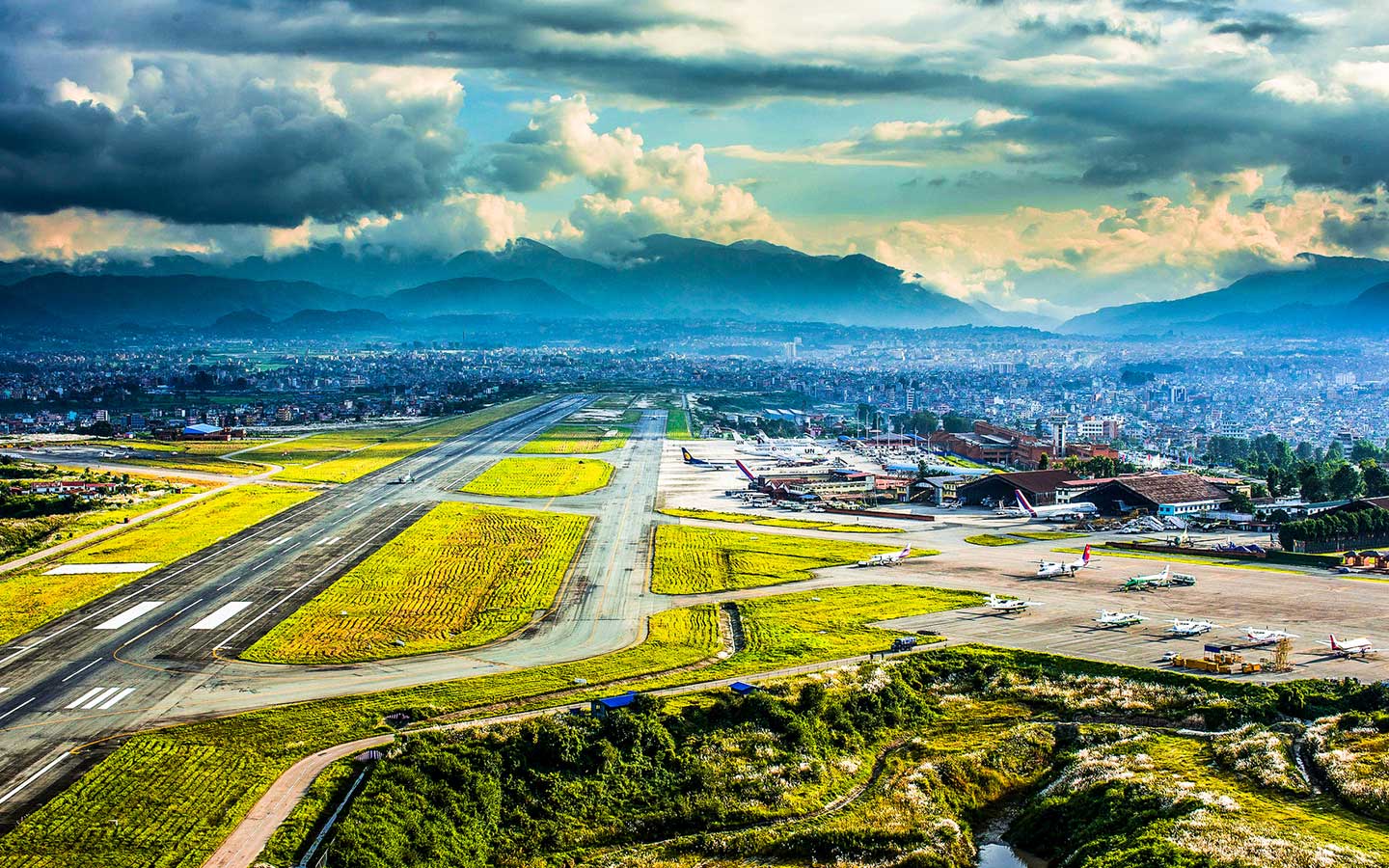
This is the final time you will review the chain of Himalayas in the Everest region. You will catch the morning flight back to Kathmandu from Lukla.
Once in Kathmandu, you can either take rest or spend your time strolling in the alleys of Thamel or Basantapur.
Note: The bad weather and wind may cause flight delays. So, you must prepare yourself for such unexpected situations as well.
Altitude Details of Everest Base Camp Trek
Trek to the Everest Base Camp is among the high-altitude treks in the world. On this trek, you will start from the low altitude and gradually ascend to the base of the highest peak in the world.
You will start the trip from Kathmandu at the elevation of 1300 meters, land at Lukla Airport at an altitude of 2860 meters. From there you slowly descend to Phakding at an altitude of 2652 meters.
Following the trail, you will ascend to the height of 3440 at Namche then 3867 at Tengboche. From there you leave for 4350 meters at Dingboche followed by 4940 meters at Lobuche.
Then to Gorak Shep, 5164 to Everest Base Camp, 5380 meters to Kala Patthar, 5555 meters. And descend back to Lukla following the trails of Pheriche 4371 meters.
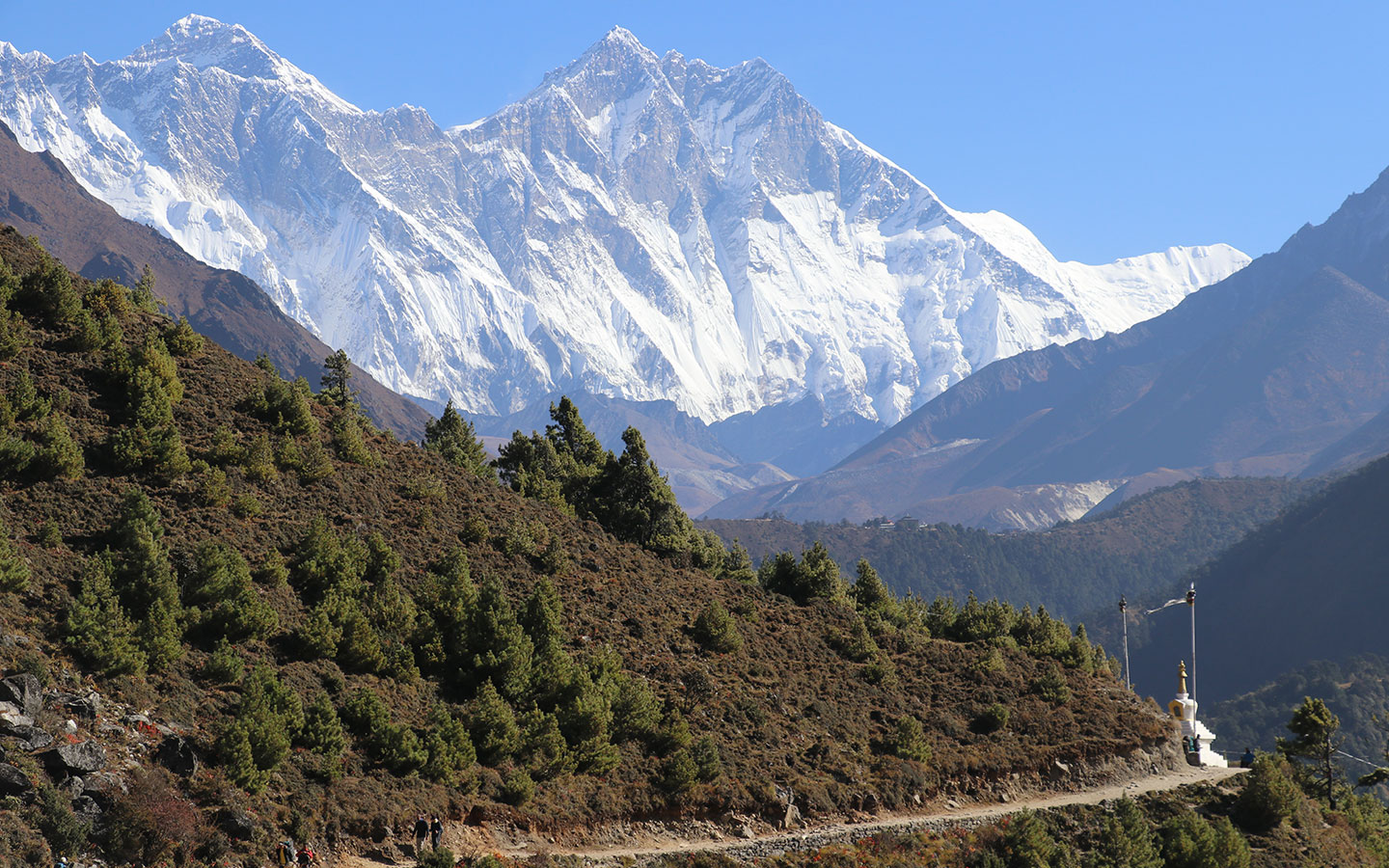
Best time for Everest Base Camp trek
Autumn (September – November ) and Spring (March-May) is the peak season for Everest Base Camp Trek. Or, say it is the best time for traveling and any other treks in Nepal .
This is the finest time to explore the nook and cranny of the Everest region. Because the weather and temperature are most favorable during this time of the year.
Besides the altitudes, you will have lesser difficulty in the trek during this time of the year. You do not have to worry either of the rain, or snow, or blizzards, or leeches on the trails. You can walk free without any worries.
The crisp surrounding, sharp views, less humidity, blue skies, and the bearable temperature make Autumn and Spring the best time for this trek.
But, with the proper preparation and appropriate packing, you can opt for this trek in summer as well as winter. You must be extra careful during this time.
Everest Base Camp Trek Difficulty
This is a moderate trek on the exotic terrains of the Everest region. On this Everest region trek, you walk past several boulders and cross the stone stairs. You walk past the ice falls, cross many rivers and suspension bridges.
In the process, you climb several uphills as well as downhills. But you do not need to fear the difficulty as this trek does not demand a steep, vertical, and challenging climb.
But altitude sickness is the ultimate threat factor during the trek. The trek starts from the altitude as low as 1300, Kathmandu to Lukla at 2860 meters. And then you ascend up to the height of 5555 meters.
So, the altitude is a real challenge in this trek. So, you must not compromise on the acclimatization days you will be spending on the route.
Also, to keep yourself moving, healthy and happy you must walk slowly, take proper rest, and drink enough water. A minor muscle cramp may be threatening up in the mountains. So, be careful while walking. Have faith in yourself, pack properly this trek is completely doable.
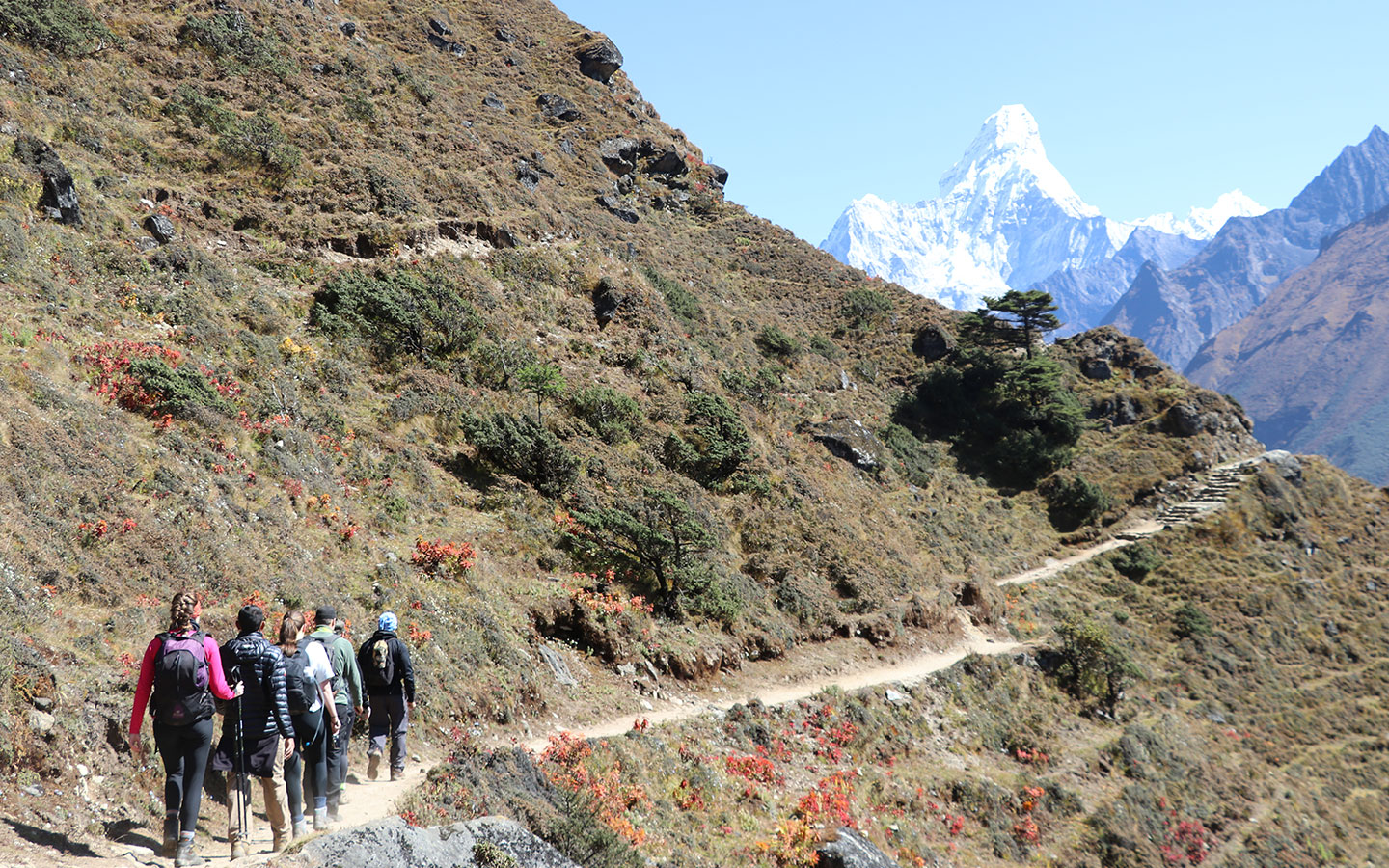
Everest Base Camp Weather and Temperature
Ebc weather and temperature in autumn.
Autumn is the best time of the year. It has the most favorable weather and temperature for travel activities as well as other activities. During this time the days are much hotter nor they are colder. So, you will enjoy the pleasantness everywhere.
During the season the average daily temperature in the Everest region ranges from the lowest 15 degrees to maximum 20 degree Celsius. Where nights are more chilling with a drop of the temperature to -10 degrees.
The weather is the most stable than other seasons. The less humid atmosphere and the monsoon-washed surrounding are the clearest and crisp during this season. You will get the clearest views of the mountains and the landscape under the serene blue sky.
Also, there is less chance of rain and the weather changes during this time of the year. Such an amazing time you will have in the Everest region.
EBC Weather and Temperature in Spring
Spring is the time of wildflowers and the soothing melodies in the forests of the Sagarmatha National Park. This is the other best time to trek in the Everest region before the arrival of monsoon in Nepal.
The time is among the hotter months of the year. But the daytime temperature remains from lowest 17 degrees to the highest 25 degrees in the Everest region. While the nights and the mornings are chilling with the temperature to -15 degrees.
This is the time when the forests bloom in rhododendron and magnolia everywhere. You get to see different flora and fauna transforming into a new life after the end of winter months in the region.
There is the least chance of rain and snow. Plus, the lowest precipitation in the season offers the sharpest views of the chain off Himalayas. Alongside with the lush vegetations, and the exotic mountainside settlements.
Also, the weather remains stable during this time so, you do not have to fear much.
EBC Weather and Temperature in Summer/ Monsoon
Summer is the season when the waterfalls and the cascading rivers come into life. With the rainfall, the trail is washed away and you get to walk in the lush vegetation.
The days are quite hot and bearable during this time in the Everest region. The average daytime temperature is 18- 25 degrees whereas nights and mornings are around -15 degrees.
You have the high chance of getting the clearest views of the mountains and the landscapes after rainfall. However, this is among the humid month so there are high chances that the fog covers the crisp views of the mountains.
Plus, you may go through leech bites and slippery trails if you trek during this time. So, you must plan your trek carefully if you are choosing summer treks.
EBC Weather and Temperature in Winter
Winter is the month of snow and the whole surrounding turns into winter wonderlands. If you love snow then you can choose Everest Base Camp Trek in winter. However, it is much colder in the region during this time.
The daytime temperature will be around 4 degrees whereas in the night the temperature may drop around -15 degrees. That means you may feel much cold in nights and mornings. So, it is a good idea to carry along a sleeping bag to warm yourself.
Plus, there is a high chance of storms, blizzards, and dense fog obstructing the surrounding and the weather. So, if you plan to trek during winter you must go prepared for such unpredictable weather conditions.
Note: The weather in mountains can often go unpredictable despite the best season you are trekking. So, before you opt for this trek you must prepare yourself physically as well as mentally for anything that may occur along the way.
Plus, it is a good idea to have some spare days if in case your flight gets delayed or canceled due to bad weather.
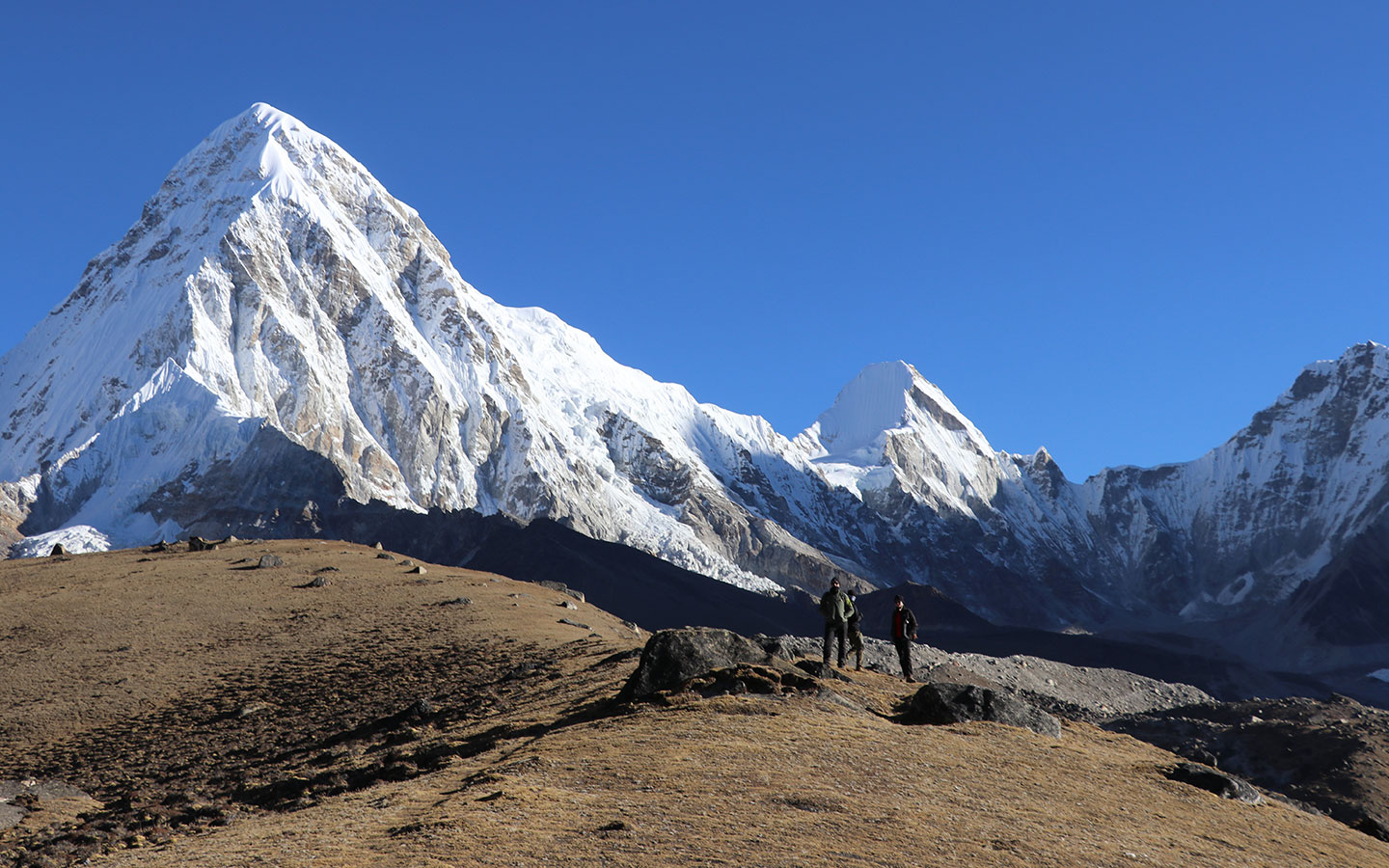
Altitude Sickness during EBC Trek
Everest Base Camp trek takes you to the foot of the highest peak in the world Mount Everest. On this trek, you will ascend to the greatest height of 5555 meters at Kala Patthar. Whereas you start the trek for the altitude as low as 1300 meters in Kathmandu. So, there is a high chance of suffering from altitude while on the trek.
As you ascend higher you may feel difficulty in breathing, feel nausea, sleeplessness, lethargy, and loss of appetite. If you notice such symptoms you must immediately stop ascending and take rest.
You should consult your guides about your problem and seek immediate treatments. In such a case, you must descend and take rest until you feel healthy and fit to ascend further. In severe cases, you can take Diamox to prevent the problem from getting worse.
To prevent the risks of altitude sickness you must spend enough acclimatization days during the trek. Plus, you must be careful while ascending to higher altitudes in a single day.
And you must check your food and drinks as well. You must keep yourself hydrated and avoid the consumption of alcohol while in higher altitudes.
Permits for Everest Base Camp Trek
Permits are a mandatory thing you must have to enter or trek in any trekking regions of Nepal. There are various checkpoints in the different parts of the trekking route. There you need to verify your permits before entering the region. So, Permits are the must-have before you start your trek.
During Everest Base Camp trek, you will walk in the Everest region and enter the Sagarmatha National Park. So, you need two different permits for this trek. It includes:
Local Area Entry Permit: USD 10
Sagarmatha National Park Entry Permit: USD 20
To receive the permit, you have to submit a photocopy of your valid passport and a passport size photo at Nepal Tourism Board, Kathmandu. Or, you can even get them at the entry point of Sagarmatha National Park, Monjo.
Also, you may wish to escape the Lukla flight and start the trek from Jiri after 7 hours drive from Kathmandu. For this, you need to get an additional permit to enter Gauri Shankar Conservation Area. You can buy it at Kathmandu or buy it at Shivalaya, Jiri.
Gauri Shankar Conservation Area Permit: USD 20 per person.
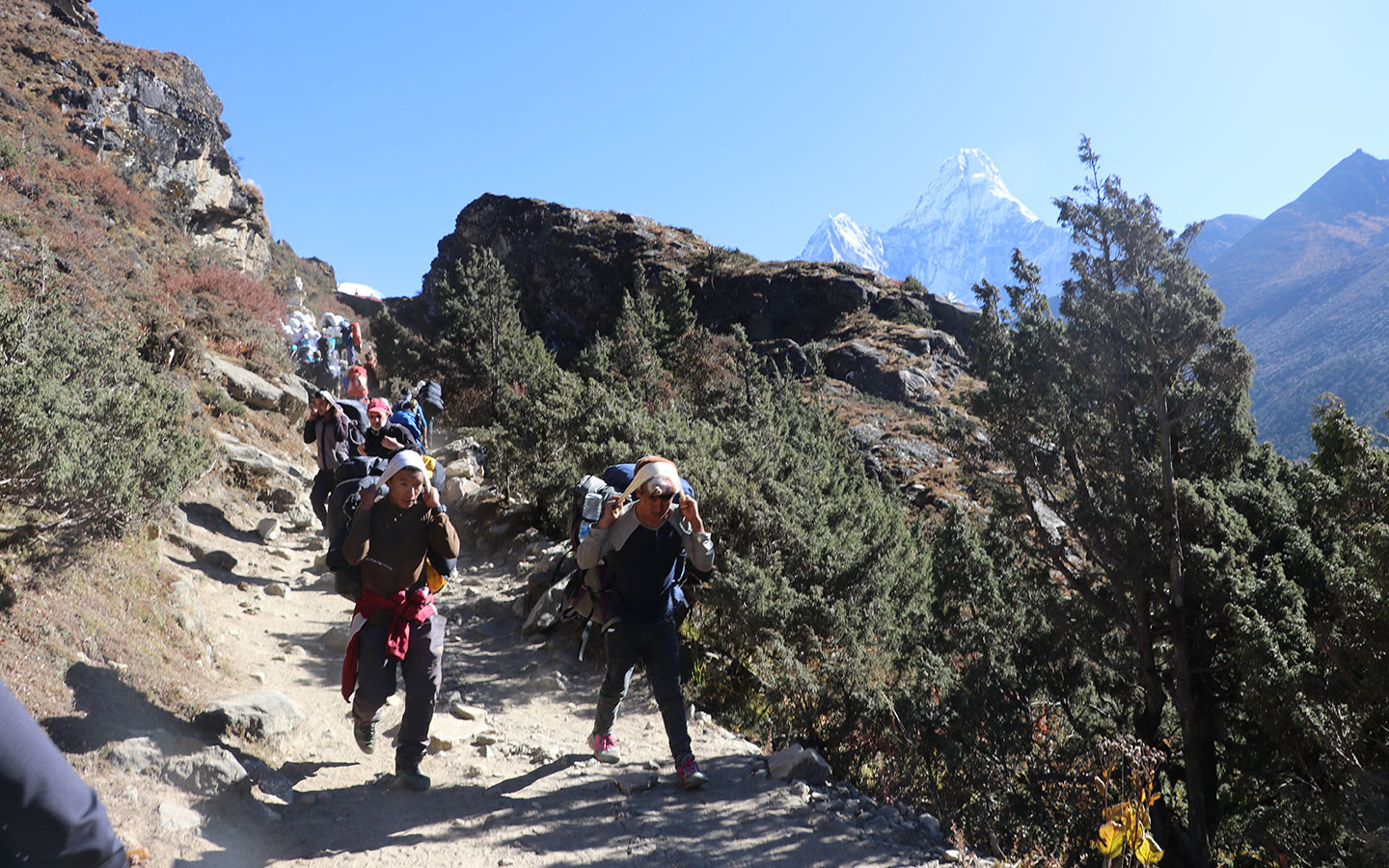
Hiring Guides and Porters
Hiring guides and porter for the trek is not compulsory. But there are different perks of walking with them.
They take care of you, guide you through the trails, notify you about the changing weather and temperature of the places you will be trekking on the day.
Porters help reduce the weight of your backpacks. So, you can walk free and enjoy everything on the trek. And they will make it easier for you to communicate with the locals and know about them.
And they are your savior if in case you face some problems on the trails or you notice the symptoms of altitude sickness. In general, you can hire a guide for USD 20- 25 per day whereas a porter costs around USD 15-20 per day.
Most importantly they help you pre-book the room and arrange your food of choice without any obstacles. They will be every time on your help during the whole trip.
To book them you can either hire them through the travel companies or hire local guides to trek with you.
Travel Insurance for EBC trek
Travel Insurance is a must for every type of treks and travels. It ensures your safety as well as the safety of your belongings. You can travel everywhere once you ensure yourself with a reliable travel insurance policy.
Everest Base Camp trek is among the high-altitude treks in the world. It is an adventurous trek in the Everest region but dangerous at the same time. There are many difficulties and risk factors during the trek to Everest Base Camp.
In such high altitude, dangerous, and adventurous treks travel insurance is a must. Sometimes you may get some health problems for which you may need medical evacuations. In such case of emergencies, your travel insurance comes handy.
So, before you come trekking in the Everest region, get a reliable insurance policy that covers up to the height of 6000 meters and offers immediate helicopter evacuations in case of emergencies.
You cannot get the insurance policy in Nepal, so before you come insure yourself with the most convenient policies. Many trekking companies do not accept if you do not have travel insurance. So, do not forget to ensure and bring policy papers while coming to Nepal.
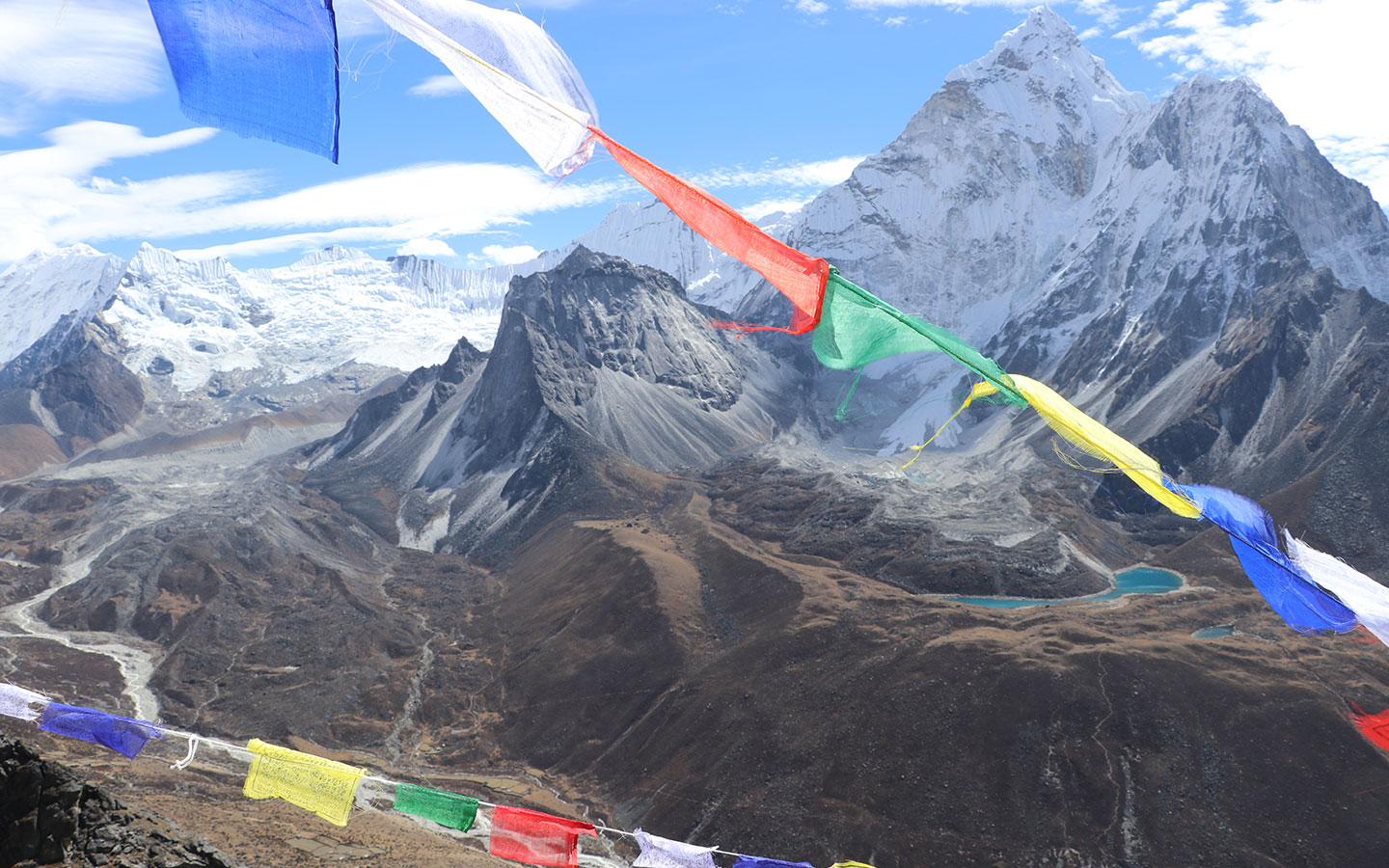
Everest Base Camp Trek Cost
The Everest Base Camp trek cost depends on various factors . It varies on whether you are traveling with a trekking company or going on solo treks.
The total cost of the EBC trek depends on the cost of permits, the cost of food/drinks and accommodations during the trek. Plus, it depends on the cost of hiring guides and porters, the routes you choose, the season of your treks, and so on.
On average the EBC trek costs around USD 1100- 1300 per person depending on these various factors.
Also, you need to pay for hot water, to charge your electronic gadgets. Or, you may like to tip your guides and porter or you may want to donate some money on the local school, temples, or monasteries. These various factors determine the cost of your trekking.
However, trekking in Nepal is quite cheap than in other treks in the world. So, you do not need to worry much about the budget you will be spending on the trek.
To reduce this cost, you can do solo treks, or you can choose to trek in off-seasons.
People and Culture during EBC trek
Everest region is the land of Sherpa. As you enter the region you will encounter different dispersed settlements of the Sherpa people. You will get to walk past the typical houses, farms and the pastures of the denizens of the mountainsides.
On knowing these people better, you will know about the great influence of Tibetan culture and Buddhism in their lives. Their food, clothing habits reflect the mountainside lifestyle.
Plus, to know more about their culture and religions you can pay a visit to their place of devotion and faith. There are many monasteries and gompas with chortens and the hanging prayer flags. It will give deeper insight into the ethnic culture of these Sherpas.
If you manage to trek to this region in October- November you can become a part of the biggest celebration of the region. The region shines in the colors of Mani Rimdu festival in the Tengboche monastery .
During your acclimatization days, you can visit villages like Khumjung, Khunde and spend time in the local school built by Sir Edmund Hillary and the local health posts. Plus, you can do some shopping in the local market of the Everest region- Namche Bazaar.
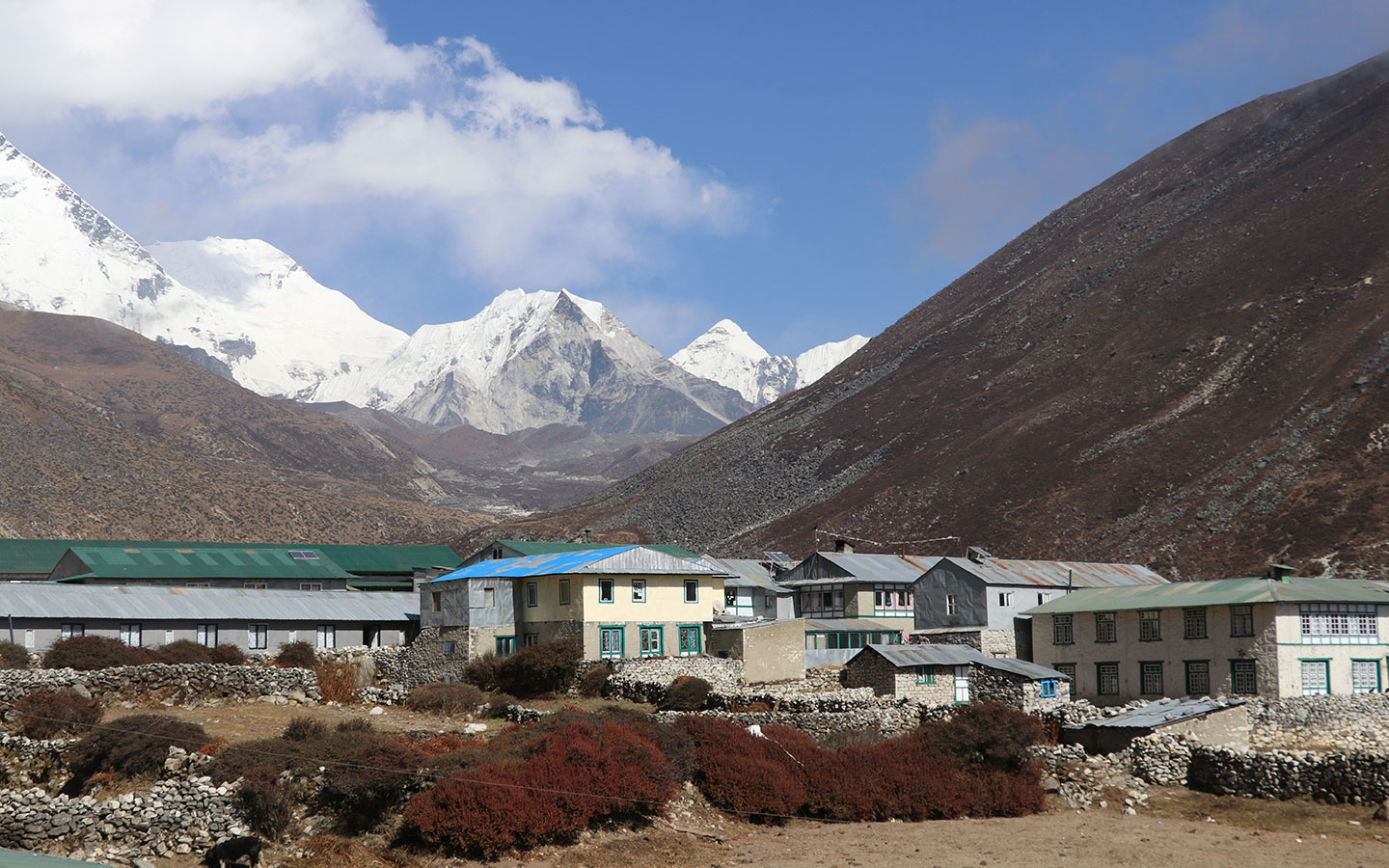
Tips for Everest Base Camp Trek
- Since altitude is the major issue in this trek, do not rush. Take proper acclimatization. Do not jump into high altitudes in a single day. Walk slowly, ascend gradually.
- Drink plenty of water and food rich in carbohydrate. You need to be fit and have good stamina to walk further. You can also drink as much garlic soup as you can. It keeps your blood thick and eases respiration.
- If you are trekking in peak season, do not forget to pre-book the room and food. You may have to compromise in the dining room if you fail to pre-book the room.
- Carry along the water purification tablets ao purifiers. Instead of buying expensive water bottles you can use the local water by making it drinkable.
- Mountain weather is quite unpredictable. It changes in every hour. A sunny morning may bring dark clouds with thunderstorms in the evening. So, before you leave it is good to pack wisely. You should go prepared for any weather changes.
- Mountains in the evening may show some unusual weather conditions. So, it is good to start early in the morning and reach your destination for the day before it gets dark.
- Whichever season you are trekking it is always a good idea to carry along the 4-season sleeping bag. And a waterproof backpack.
- If you are a solo trekker do not forget to carry along a trekking map and get necessary permits before you start the trek.
EBC Trek after 2015 Earthquake
The Gorkha earthquake of April 2015 affected the Everest Base Camp Trek route. Due to the avalanche in the mountains, many trekkers lost their lives.
Many tea houses were completely devastated. The trails blocked with the massive boulders and rocks. The route became unsafe for trekking because of various factors.
However, the place and the route are already restored . The tea houses are newly constructed following the earthquake resistant techniques. The boulders and rocks are cleared from the route. There are lesser risks of an avalanche.
The locals of the region in coordination with the government and trekking associations have already made the place and route much safer for trekking.
Plus, the number of teahouses has also increased in the region. So, you do not have to worry to trek in the Everest Base Camp. TAAN has declared and re-opened the place for trekking.
So, the Everest region is completely safe to trek despite the 2015 Gorkha earthquake.
EBC Helicopter Trek
If you are willing to do the trek but do not have enough to join the 14 days trek to Everest Base Camp then do not worry. You can opt for the Everest Base Camp Helicopter trek . On this tour, you will walk from Lukla to the Everest Base Camp/ Kala Patthar. And, on returning back you take a helicopter flight directly from Base Camp to Kathmandu.
Or, you have another option for Everest Base Camp Heli Tour where you get to explore the diverse topography and lifestyles of the Everest region in around 4 hours. On this tour, you fly in a helicopter from Kathmandu to Lukla then to Everest Base Camp. On returning you will enjoy a warm meal at the Everest View Hotel and then fly back to Kathmandu.
This tour is the best option for you if you are either short on time. Or you are unable to trek in the rugged terrains of the Everest region but still want to be at the base of the world’s highest peak.
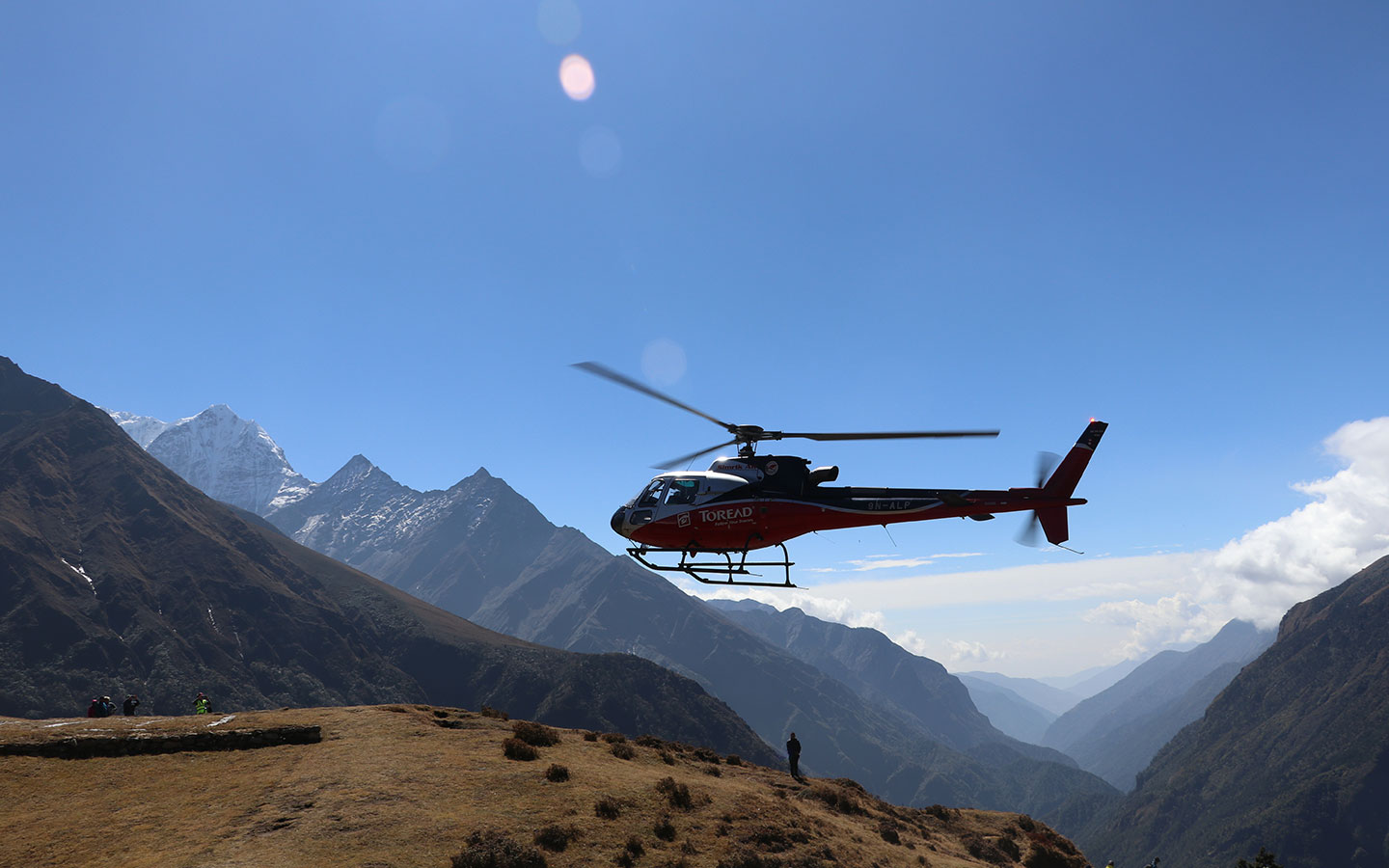
Side Trips to EBC
Besides following the classic Lukla route to the Everest Base Camp you can also use some side route. And enjoy the extra views and adventures in the trek along with your trek to the base camp.
You have two different alternate routes to reach the Base Camp.
Gokyo Valley Lake trek
On this trek, you walk towards Gokyo valley from Lukla village. This is among the less crowded and peaceful trails in the Everest region.
On this route, you get to explore five different glacial lakes of the Gokyo valley. Also, you will hike to Gokyo Ri, to catch the finest views of the Everest but, for a different perspective than from Kala Patthar.
Exploring the exotic, and off the beaten trails of the Gokyo valley , you will then trek to the Everest Base Camp.
Jiri Everest Base Camp Trek
This is a classic route to reach the base of the giant peak of the world, the Everest. The route follows a drive from Kathmandu to Jiri and then trekking throughout the trail. If you choose this route you will follow the footsteps of Sir Edmund Hillary and Tenzing Norgay Sherpa .
This is the best alternative for those who wish to escape the Lukla flight . This route takes you through different villages of Brahmins, Chhetris and other ethnicities before you reach Lukla village. From Lukla, you follow the ideal route to Everest Base Camp.
Everest Base Camp trek 14 days promises you the closest and best views of Mt. Everest along with its neighboring peaks. On this trek, you get to encounter the typical Sherpa people of the region, explore their distinct lifestyles.
You get to walk past several scattered Himalayan settlements, monasteries, and chortens. Also, cross numerous suspension bridges across the Dudh Koshi river.
With a trek of 14 days, you get to receive that amazing feeling of resting on the lap of Mount Everest, the highest peak in the world. A dream destination for many, isn’t it?
Related Articles
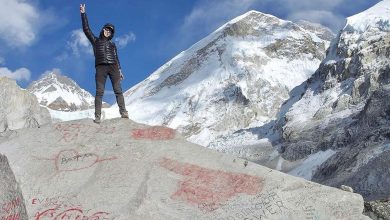
Everest Base Camp Elevation And Altitude Gain
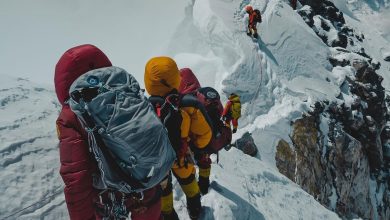
Why To Climb Mount Everest in the Fall?
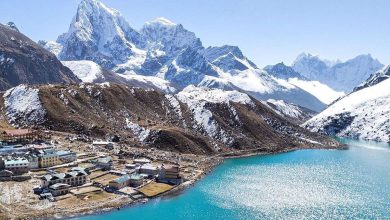
4 Scenic Trekking Routes to Reach the Pristine Gokyo Lakes
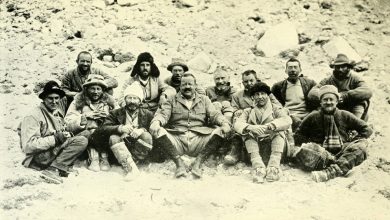
First-Ever Avalanche Death On Everest
Leave a reply cancel reply.
Your email address will not be published. Required fields are marked *
- Group Enquiry? NEW
- Best Time and Season to Visit Everest Base Camp Trek
Thinking about visiting during the best time to Everest Base Camp Trek? Well, you are in the right place! For you to witness the dramatic panoramas at the Sagarmatha National Park in the Himalayan region, we will give you an insight into all the seasons during the year so that it will be easy for you to decide when to visit the foot of the tallest mountain in the world. Steal Day: Frozen River Trek in 2020, Ladakh Even though you can expect the weather to be unpredictable on the higher regions of the trek, the primary seasons in the Himalayan region tend to be Winter, Spring, Monsoons/Summer and Autumn. Although, our tip would be to go during the spring months (February to May) and autumn months (Late September to November) These months are considered as the best season to visit Everest Base Camp. These months generally have greater visibility, longer sunny days and overall an appropriate condition for trekking to the Everest Base Camp. You will also have an advantage of exchanging compelling stories with a lot of trekkers from all over the world and some of them might even become your close companions after the exhilarating 15-day trek. All in all, the unusual and uneven yet astonishingly stunning trek is surely worth completing once in your lifetime.
Check Out Best Time to Visit Everest Base Camp Trek:
Quick navigation.
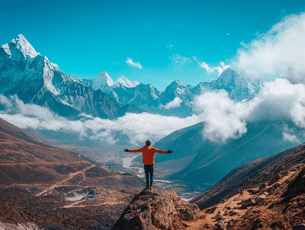
Everest Base Camp Trek in January
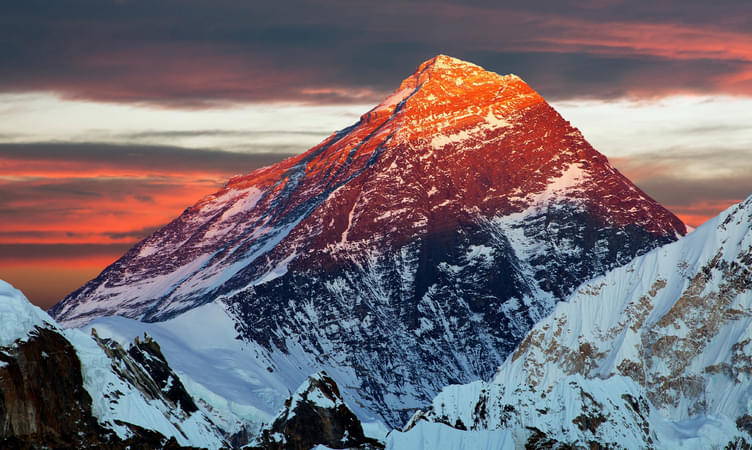
January is one of the coldest months for the Everest Base Camp Trek. Although a lot of snow will be dumped on the trail due to heavy snowfall, it is very much possible to reach the base camp. You will have to be careful and layer up properly with warm clothes as it gets pretty chilly up there. There is an advantage of trekking to EBC in January- you will witness a very less number of trekkers, which means less obstruction for viewing the stunning panoramas in the Himalayas! The average temperature during the day is 4 degrees Celcius and it may drop to - 18 degrees Celcius by night.

Best Offers on Himalayan Treks: Enquire Now
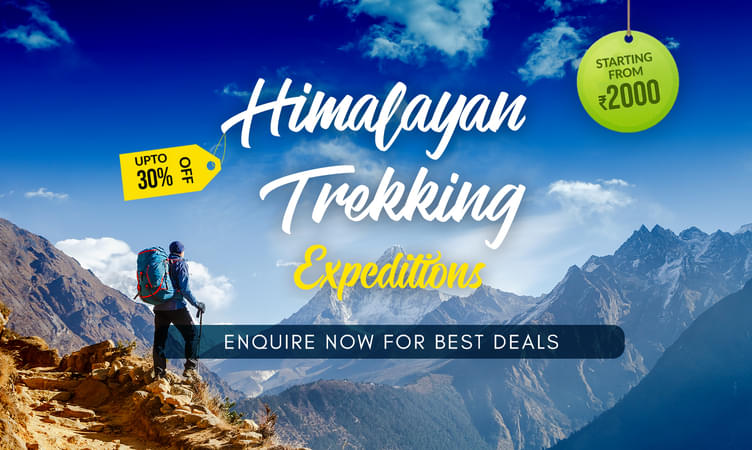
Everest Base Camp Trek in February
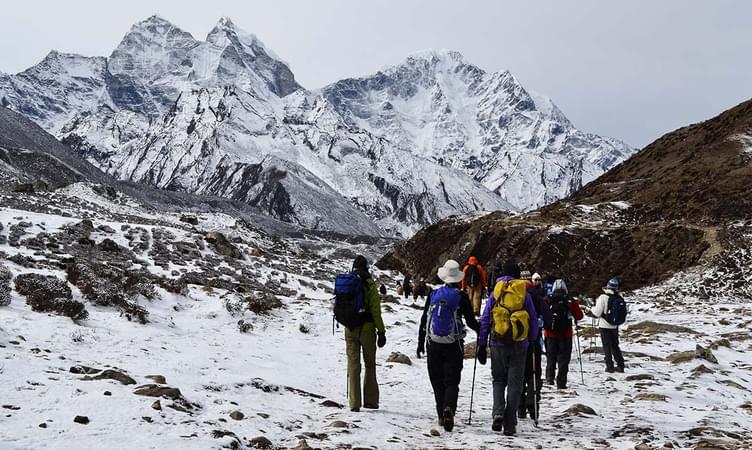
February marks as the end of winters in the Himalayas even though it is pretty chilly up there. The sky gets a clear blue colour and the trails are still less crowded. The teahouses and mountain lodges will also be emptier, quieter and more economical, which would give you a true sense of adventure in the mountains. Booking flights to Nepal during this time will surely save you some bucks. The average daytime temperature goes up to 4 degrees Celcius and during the night, it might dip down to -15 degrees Celcius. For these many reasons, you can consider this month for visiting as the best time to Everest Base Camp.

Best of Sri Lanka

Everest Base Camp Trek in March
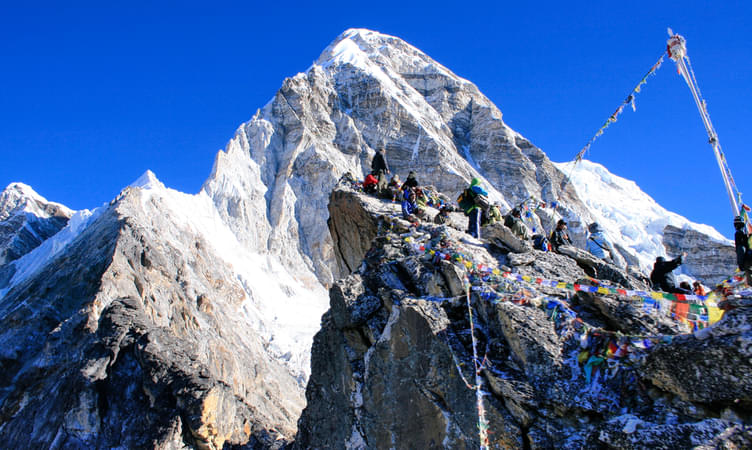
From this month, spring season commences with the celebration of Holi in the country. As the weather starts to get balmy, the ice starts to melt away and the days seem longer. You will be able to see the beautiful sights of Rhododendrons starting to bloom along the trail, with a backdrop of snow-capped Himalayan ranges. The average temperature during the day is around 7 degrees Celcius and the night temperature can be around -12 degrees Celcius making this month a favourable one to trek.
Everest Base Camp Trek in April
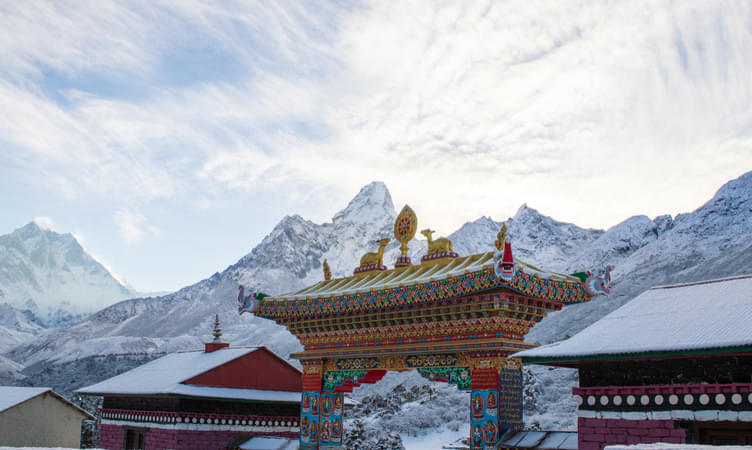
April is also a great month to plan the EBC Trek. It is warmer at the lower elevation and moderately chilly at the higher altitude. With such a fascinating spring season in the lofty mountains, the flora is also in full bloom. The days will be sunny and it will be neither too hot nor too cold. In the trails bustling with a lot of trek enthusiasts, you will be able to meet and interact with several of them see numerous tents on the way for the base camp. Although the day temperature on an average is 10 degrees Celcius, at night it drops down to -5 degrees Celcius.
Everest Base Camp Trek in May
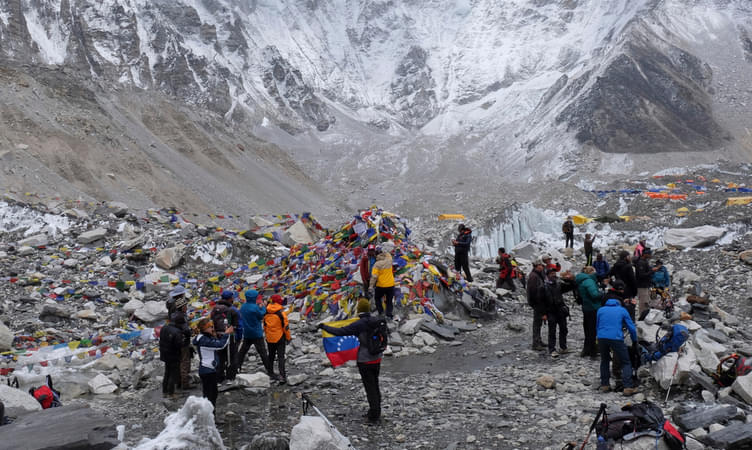
May is the time when spring ends and summer starts. By taking advantage of this favorable weather, a lot of experienced trekkers try aiming for the Everest Summit. It gets warmer day by day which makes it easier for them to attempt for the summit. As for the base camp, it is a very favorable time to easily finish the trek. It is the best season to visit Everest Base Camp Trek for those who cannot bear much cold. With longer sunny days, the average temperature goes up to 15 degrees Celcius and at night it gets cold at 0 degrees Celcius.
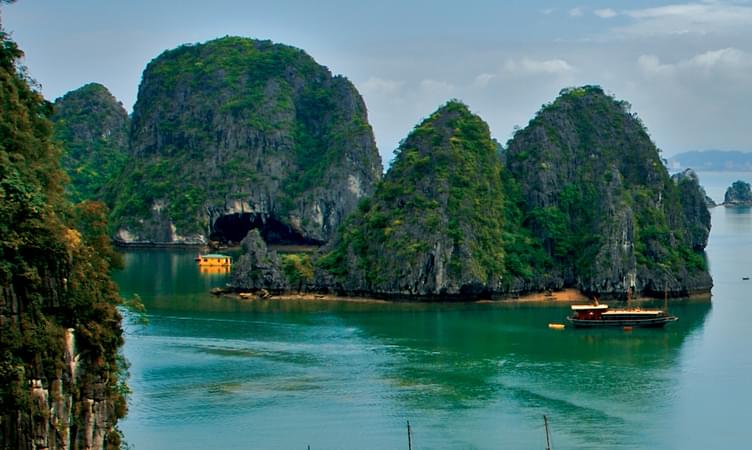
Best of Vietnam

Everest Base Camp Trek in June
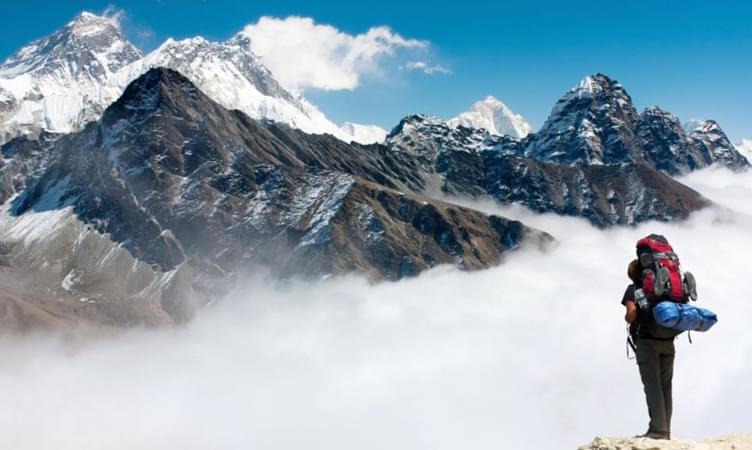
June is the month when monsoon clouds start to hover over the Himalayan region. The beginning of June is still acceptable to plan your trek but as the days move forward, frequent showers start and make the trails wet and sloppy. It is not recommended to trek for the base camp during this time of the year as the risk of slipping on the trail increases. There are even chances of avalanches, landslides, snowfall and the pesky leeches which could keep you from reaching the base camp within the stipulated timeline. The average temperature goes up to 16 to 17 degrees Celcius during the day and may reduce to 0 degrees Celcius.
Everest Base Camp Trek in July
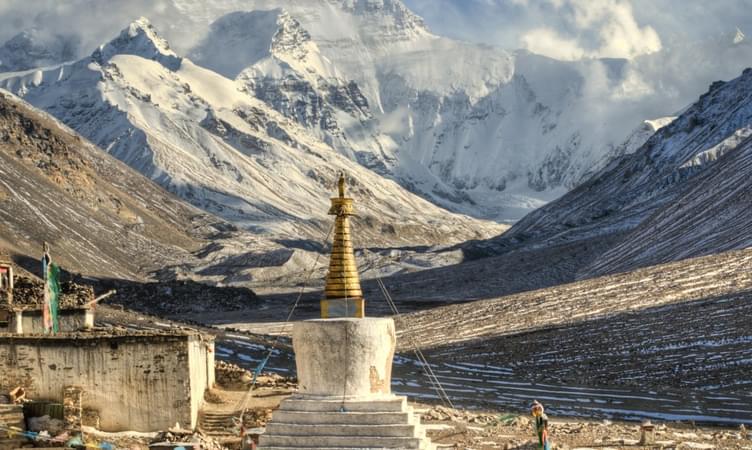
The weather in July is still heavy with rainfalls and the air is a lot more hot and humid. Although it is not impossible to go on this trek during this month, there are chances that the flights from Kathmandu to Lukla get canceled due to an overcast. Because of the everyday rains as well as humidity, the trails get muddy and you have a higher risk of slipping through the risky trails. The temperature averages around 18 degrees Celcius during the day and up to 2 degrees Celcius at night.
Everest Base Camp Trek in August
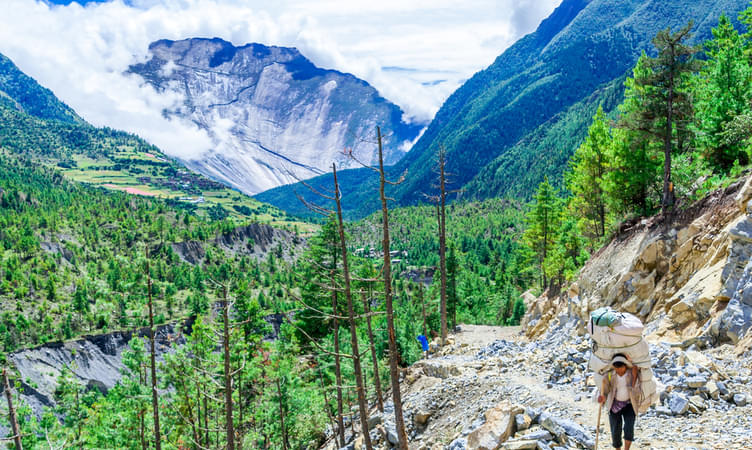
By August, the rains and humidity start to recede and the skies slowly start to clear up. Yet, we recommend not to plan your trek in this month as the trails will still be soaked with mud, slippery and risky. You will also not be able to enjoy spectacular views because of the frequent overcast. The still-surfacing landslides and leeches are at a high recurrence which would be the main reasons to disrupt your hike. The sky will be usually murky, making your excitement for the trek shrink. Just like July, the average day temperature remains at 18 degrees Celcius and around 2 degrees during the night.
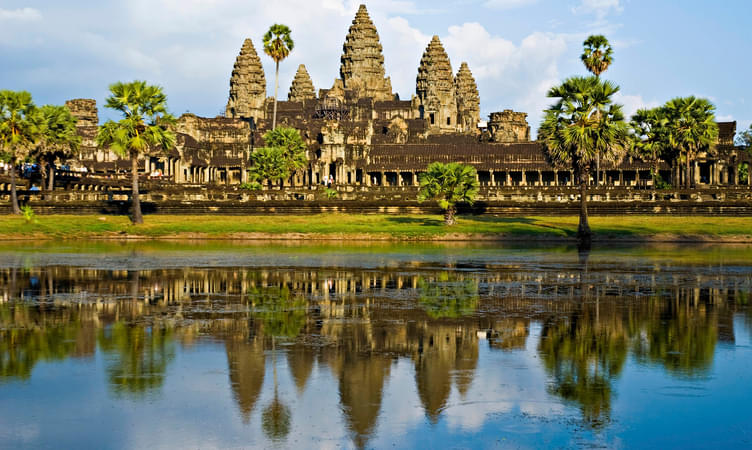
Best of Cambodia

Everest Base Camp Trek in September
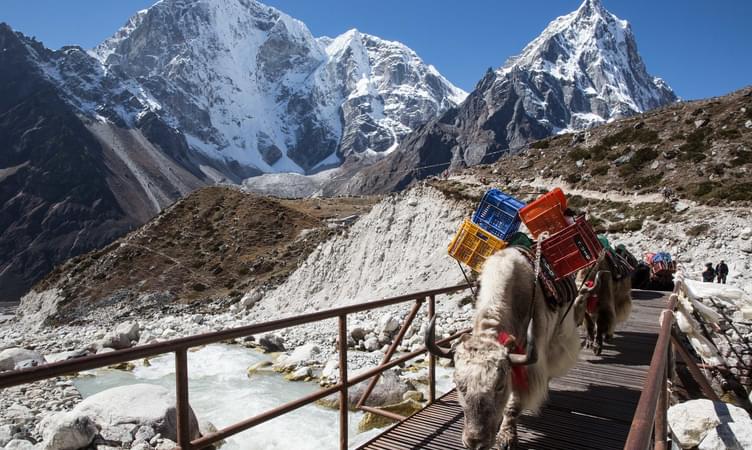
The autumn season prevails generally from mid-September. For the people who are waiting eagerly for the monsoons to end, now is the right time to plan out your Everest Base Camp Trek. The crisp air and bright blue skies along with a clear view of the lofty mountains make the scene more alluring while trekking. The average minimum temperature at night grows colder up to -10 degrees Celcius. During the day, the maximum temperature can get as high as 17 degrees Celcius.
Everest Base Camp Trek in October
.jpeg?gravity=center&width=752&height=450&crop=fill&quality=auto&fetch_format=auto&flags=strip_profile&format=jpg&sign_url=true)
This month showcases the most enjoyable scenes of the snow-capped mountains, trails surrounded by different shades of lush greens and overall pristine surroundings. There is also the most important festival in Nepal carried out during late-October and September. It is the 15-day long Dashain (similar to Dussera in India) celebration when they celebrate the victory of Goddess Durga over evil by sacrificing several animals. For these reasons, this month is visited the most for the best time to Everest Base Camp by the trekkers. So, be ready to engage with different trek enthusiasts as well as the humble locals on your way to Everest Base Camp. The average temperature generally lies at 12 degrees Celcius during the day and -10 degrees Celcius at night.
Everest Base Camp Trek in November
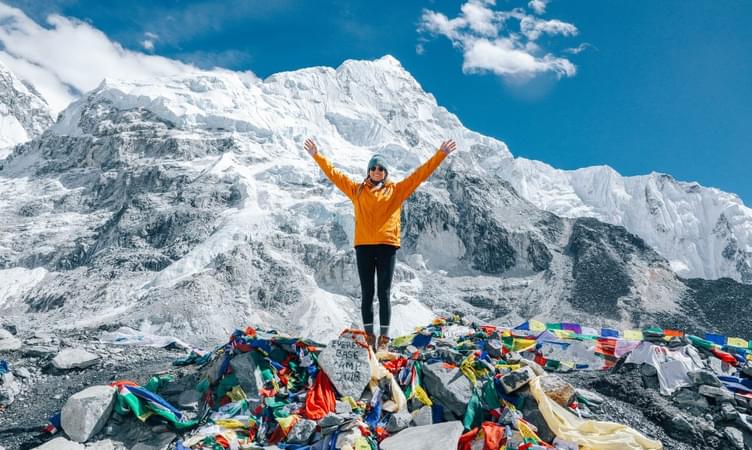
On the verge of arriving winters, the starting of November can still be an option to trek to the Everest Base Camp. Although this month won’t be as temperate as the spring or autumn season, you can still enjoy fewer crowds and the quietude during this trek. The cold winds start to cover the whole Himalayan region with temperatures dropping to 6 degrees Celcius in the daytime and -10 degrees Celcius at night.
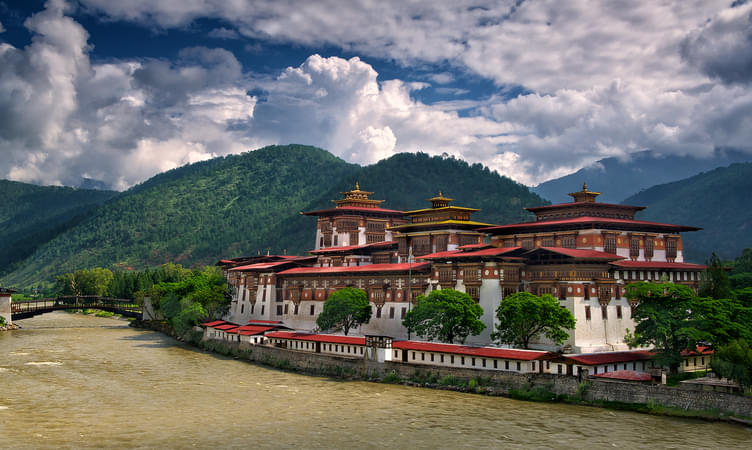
Best of Bhutan

Everest Base Camp Trek in December
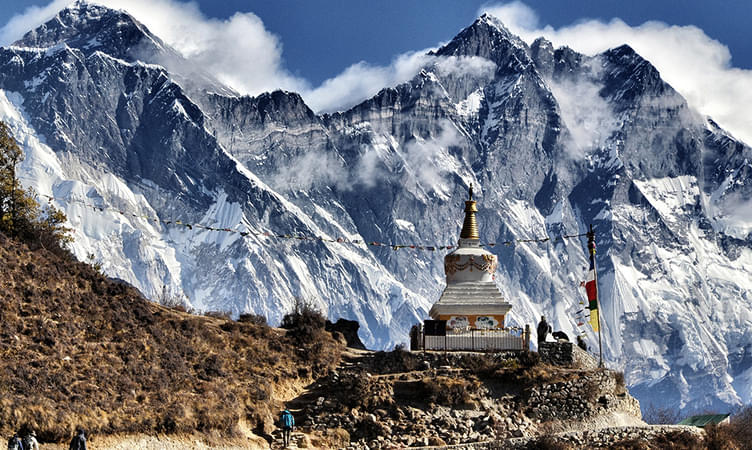
Nepal in December becomes a winter wonderland for the people who enjoy an uninhabited environ during their voyages. The trails will be usually empty with a few trekkers peppered across the thick white sheets of ice. You will have to be extra careful while trekking in this month as the sub-zero temperatures at such high altitudes can get the best of us. The temperatures drop to 4 degrees Celcius during daytime and -18 degrees Celcius during the night.
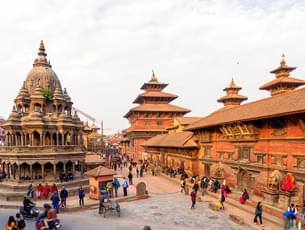
Trending in Nepal
Adventure in nepal.
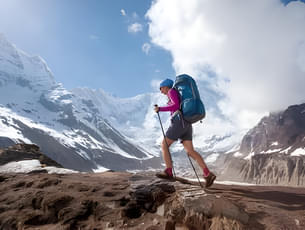
Trekking in Nepal
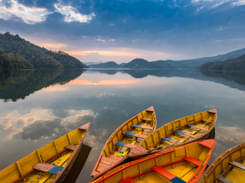
Nepal Top Attractions
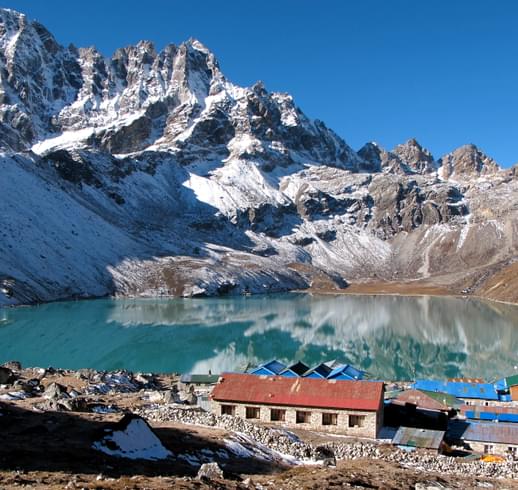
If you are a true mountaineer, you can’t miss the chance to be a part of this expedition. Due to high level of precipitation the peaks of Kanchenjunga is mostly glaciated. You can simple enjoy an epic scenery which is truly going to leave you jaw dropped. Highlights: Preservation of the rich flora and fauna is also important and you will get to witness them too during trekking. It is difficult to comprehend the scale of both valleys and mountains here. Difficulty Level – High. Best time to visit: October and November. Prices: USD$985 per person.
Nepal Travel Guides
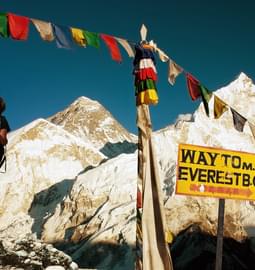
Nepal Reviews

Popular Nearby Places Around Nepal
More things to do in nepal, more on nepal tourism, popular related destinations.
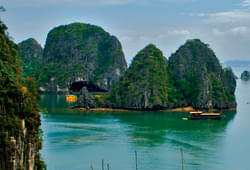
Best Domestic Packages
Best international packages, domestic honeymoon packages, international honeymoon packages, places to visit in india, international places to visit, things to do in india, international things to do, popular on thrillophilia.
- We assure the privacy of your contact data.
- This data will only be used by our team to contact you and no other purposes.
Your enquiry has been received successfully. Our destination expert will reach out to you soon!

The Blog on alanarnette.com
Climbing the World to End Alzheimer's
Everest 2024: Everyday Everest Podcast Series Part 5–Arrival At Base Camp
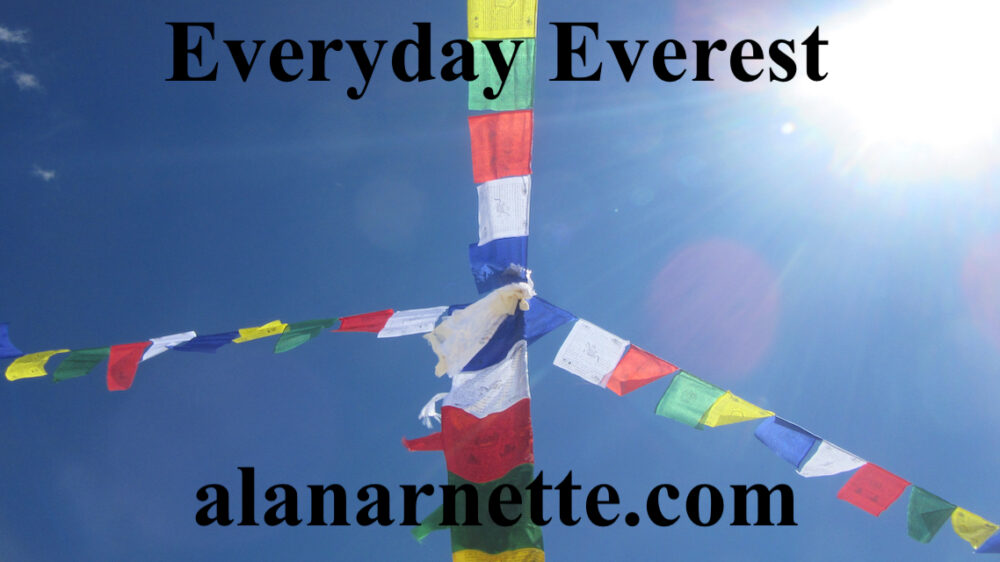
Part 5 of Everyday Everest, my new Podcast series, drops today with chapters 14, 15 and 16. I’ll continue my annual coverage as usual.
Based on my 2020 Virtual Everest series, Everyday Everest follows a fictional team of nine climbers and their personal Sherpas from leaving home to trekking to base camp, acclimatizing, and finally, on their summit push, returning home. I’ll have a twenty-minute episode a few times weekly for the next two months.
In Part 4, our protagonist, Harper, now at Everest Base Camp, is enjoying the smells from home as she unpacked her duffle when she is suddenly interrupted:
As Harper pulled her pillow out of the duffel, the scent of laundry detergent filled the tent’s confines. Harper pulled it close, pushing it against her face into it, deeply, with intention. She drew a deep breath as the smell rubbed off. Now, she smelled like home. For a moment, she was transported half a world away to those most important in her life. She saw faces, heard laughter, felt love. Harper smiled. She took out her small picture album, preferring to have printed pictures she could hold than electronic ones on her phone. With a jolt, Harper was brought back to the present, her attention shifting to the sound of footsteps. Big footsteps and a bell. Again, she leaned forward for a look-see. She made eye contact with her visitor. He was 600 pounds, covered in fur, but had gentle eyes. He could have been a she, hard to tell. The bell, a yak bell, around his/her neck, clanged with the resonance of a well-designed church bell. His job completed, his load delivered to base camp, he was meandering around camp, loose from his tether, searching for a bit of lunch. He moved on. “
The main characters are
- Harper – protagonist, strong climber, Aconcagua, Denali (Husband -Marc, Daughter – Olivia, Son – Jay)
- Dutch – solid climber, quirky
- Tony – solid climber, introvert, impatient
- Michael – Good experience, Manaslu, good friend
- Jim – Second Everest attempt, not strong
- Aaron – good climber, strong friend
- Bart – good climber, strong friend
- Pablo – weak mentally, Aconcagua, Denali
- Claudia – strong climber, Aconcagua, Denali
- Guide John Paul – highly experienced, patient, good leader
- Sidar and Guide – Dawa Sherpa
- Guide – Gyalzen Sherpa
- Guide – Tenzing Sherpa
We will go through Everest climbing each day as the team arrives in Kathmandu, flies to Luka, and treks to EBC. We’ll follow them at base camp through the acclimatization rotations and receive invaluable help from the Icefall Doctors and Climbing Sherpas. And, of course, the summit pushes starting in mid-May.
While there will be accurate historical references, this series is a work of fiction. Names, characters, and incidents are products of the author’s imagination or used fictitiously. Any resemblance to actual events, locales, or persons, living or dead, is entirely coincidental.
Now, Part 5, “Arrival At Base Camp”
Climb On! Alan Memories are Everything
Everyday Everest Part 5 Podcast
Previous everyday everest episodes.
- Everest 2024: Everyday Everest Podcast Series Part 4–Blessing in the Khumbu
- Everyday Everest Podcast Series Part 3–The Trek Begins
- Everyday Everest Podcast Series Part 2–Hello Kathmandu
- Everyday Everest Podcast Series–Welcome and Part 1
You can listen to #everest2024 podcasts on Spotify , Apple Podcast , Breaker , YouTube , Pocket Casts , RadioPublic , Anchor , and more. Just search for “alan arnette” on your favorite podcast platform.
Preparing for Everest is more than Training

If you dream of climbing mountains but are unsure how to start or reach your next level, from a Colorado 14er to Rainier, Everest, or even K2, we can help. Summit Coach is a consulting service that helps aspiring climbers worldwide achieve their goals through a personalized set of consulting services based on Alan Arnette’s 30 years of high-altitude mountain experience and 30 years as a business executive. Please see our prices and services on the Summit Coach website .
Everest Season Special through May 31, 2024: 10% discount on all plans. Mention Everest 2024.
Share this post:
You might also like:.

Everest 2024: Everyday Everest Podcast Series Part 6–Into the Icefall
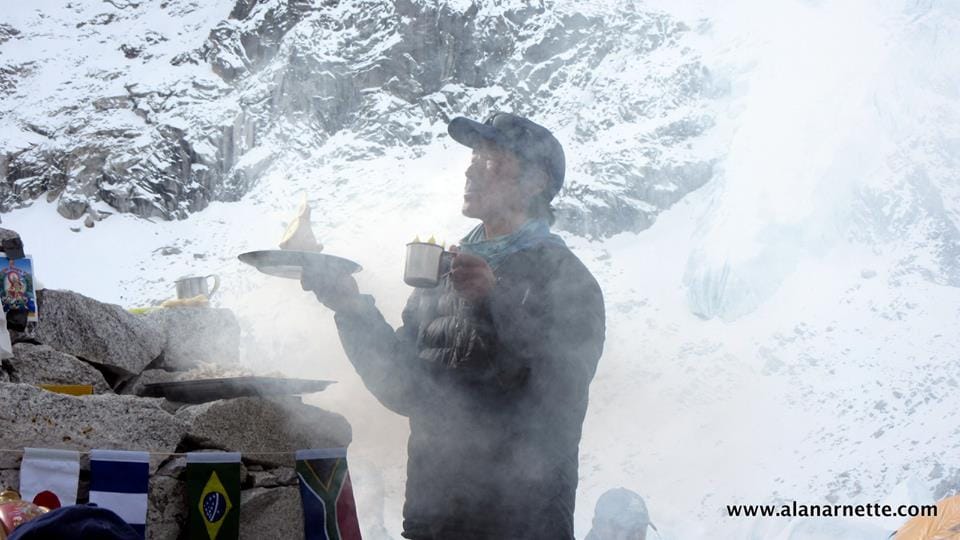
Everest 2024: Tibet Climbs in Peril
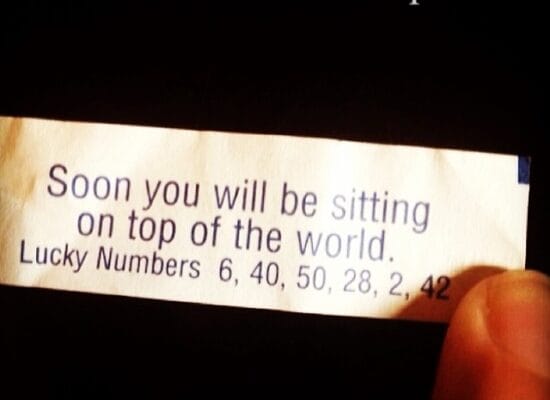
Everest 2024: Weekend Update April 14: Icefall Woes, Fewer Climbers
One thought on “ everest 2024: everyday everest podcast series part 5–arrival at base camp ”.
Love reading about Everest
Have a comment? Cancel reply

IMAGES
VIDEO
COMMENTS
Peak Season. Contrary to what you might think, the best time to trek to Everest Base Camp is not during the height of Summer. Rather, large window periods on either side of summer provide the best conditions for the trek. February - May. The spring months are probably the most popular in the region as a whole.
Alya at the Everest Base Camp sign. Best time to trek Everest Base Camp. There are two main seasons for trekking to EBC. The best months to trek to Everest base camp are in the pre-monsoon season through March, April, and May or in the post-monsoon season from late September, October, and November. It is not pleasant and can be dangerous to ...
Classic Everest Base Camp trek. The classic Everest Base Camp trek takes about 14 days, including time in Kathmandu before and after. From Kathmandu, you'll fly into Lukla Airport (2,860m/9,383ft) with its famously short runway - try to sit on the left side of the plane so you can catch your first views of Mt. Everest.
There are two distinct seasons for trekking to EBC. The best months to trek to Everest base camp are in the pre-monsoon season through March, April, and May, or in the post-monsoon season from late September, October, November. If you decide to trek on the border of the monsoon season keep in mind that sometimes the season starts earlier or ...
Best Everest Base Camp Tours. First of all, if you'd rather skip the hassle of planning your own EBC Trek, Klook has Everest Base Camp Tours starting as low as $900 USD for a full 12-day trek. You may be able to find something cheaper than this once you land in Kathmandu, but booking online with a vetted tour company has some big advantages, and the reviews on their website are very positive.
Phone +1 682-558-3926. Web Visit website. Trekking to Everest Base Camp in Nepal's Sagarmatha National Park is the adventure of a lifetime. Although actually climbing Mount Everest is out of reach for many of us, anyone with enough grit and good enough fitness can reach EBC and the Khumbu Icefall, the starting point for climbing Mount Everest.
The thing that makes the EBC trek tough is the altitude. Base Camp is at 5600m (18,373ft) and you will need to spend one or two nights above 5000m (16,404ft). Above 4000m (13,123ft) you are going to feel increasingly lethargic and out of breath as the amount of oxygen in the air decreases. Combine this with the cold, the discomfort of being at ...
The spring trekking season coincides with the Everest climbing season, so the Khumbu region is very busy with helicopters and yaks transporting supplies to Everest Base Camp. If trekking at this time, you will have the chance to see base camp fully set up with all the tents, and there is a great buzz about the place.
Days required: 12 -14 days. Total Incline: (Undulation) - 6015 m. Total Decline : (Undulation) - 5821 m. The highest point on the trek: 5640 m/18 500 ft, this is actually at Kala Patthar, which you will hike to in the morning after reaching Everest Base Camp. This is where you get the best views of Mount Everest.
The Everest Base Camp Trek is one of the best high-altitude treks in the world. Your starting point Lukla is at 2,860 meters (9,383 feet), but from there the altitude only increases. Everest Base Camp is at a shopping altitude of 5,380 meters (17,600 feet.)
It is possible to make the journey in January and early September. We prefer the above for our treks into Everest base camp. My personal favorites are March, late October and November and December. You can trek to Everest Base Camp in January and February. It can be cold higher up (-20C/-4F to - 30C/-22F).
The return drive at the end of the trek is between 4 and 6 hours depending on traffic. Airfare from Kathmandu to Lukla $217 USD one way so Kathmandu Lukla Kathmandu $434. Airfare Ramechhap Manthali $177 one way total Airfare Ramechhap Lukla Ramechhap $354. 12 Days Everest Base Camp Bed and Breakfast. Gokyo Ri Trekking.
The best time to visit Everest Base Camp is during the spring and autumn seasons. From March to May, the temperatures are relatively mild, and the skies are clear, making it the perfect time to enjoy the stunning views of the Himalayas. The spring season also brings with it the blossoming of rhododendrons, which are scattered throughout the ...
The Spring Season at Everest Base Camp: Everything You Need to Know. Though October and November are the top two months for people trekking Everest Base Camp, that doesn't mean fall automatically claims the crown for the best option. The spring trekking season runs through March, April, and May, and it's an extraordinary time to hike ...
Winter season is considered an off-season for Everest Base Camp Trek. During the winter season, the region sees its coldest days with temperatures as low as -17⁰C (1.4⁰F). Everest Base Camp Trek may seem daunting at this time of the year, but it is not precisely impossible. Many enthusiastic trekkers have trekked the trail even during winters.
Autumn (Sept-Oct) Another best time of the year to trek to the Everest base camp is the autumn or post-monsoon season. Generally, the autumn season starts from September to October. It is the main season where the Everest region sees a surge of trekkers and visitors trekking to the Everest base camp. Mid-September to November is one of the best ...
Best time for Everest Base Camp trek. Autumn (September - November) and Spring (March-May) is the peak season for Everest Base Camp Trek. Or, say it is the best time for traveling and any other treks in Nepal. This is the finest time to explore the nook and cranny of the Everest region. Because the weather and temperature are most favorable ...
The best months to trek to Everest base camp are in the pre-monsoon season through March, April, and May, or in the post-monsoon season from late September, October, November. If you decide to trek on the border of the monsoon season keep in mind that sometimes the season starts earlier or finishes later and unexpected rainfalls might influence ...
The autumn season prevails generally from mid-September. For the people who are waiting eagerly for the monsoons to end, now is the right time to plan out your Everest Base Camp Trek. The crisp air and bright blue skies along with a clear view of the lofty mountains make the scene more alluring while trekking.
Part 5 of Everyday Everest, my new Podcast series, drops today with chapters 14, 15 and 16.I'll continue my annual coverage as usual. Based on my 2020 Virtual Everest series, Everyday Everest follows a fictional team of nine climbers and their personal Sherpas from leaving home to trekking to base camp, acclimatizing, and finally, on their summit push, returning home.
What to Pack for Everest Base Camp Trek | My EBC Packing List : r/Everest. r/Everest. r/Everest. • 50 min. ago.
113 likes, 0 comments - altitudetrailsApril 7, 2023 on : "Mt. Amadablam (6812m) Cr: @ James Schomburgk Everest Base Camp Trek (2023) Best season: Spring (March to May), Autumn (September to..." Mt. Amadablam (6812m) 📷Cr: @ James Schomburgk Everest Base Camp Trek (2023) Best season: Spring (March to May), Autumn (September to... | Instagram